Schedule a call

13 KPIs to Measure the Success of Your Mobile Travel App

Alexander Ragin
November 18, 2023
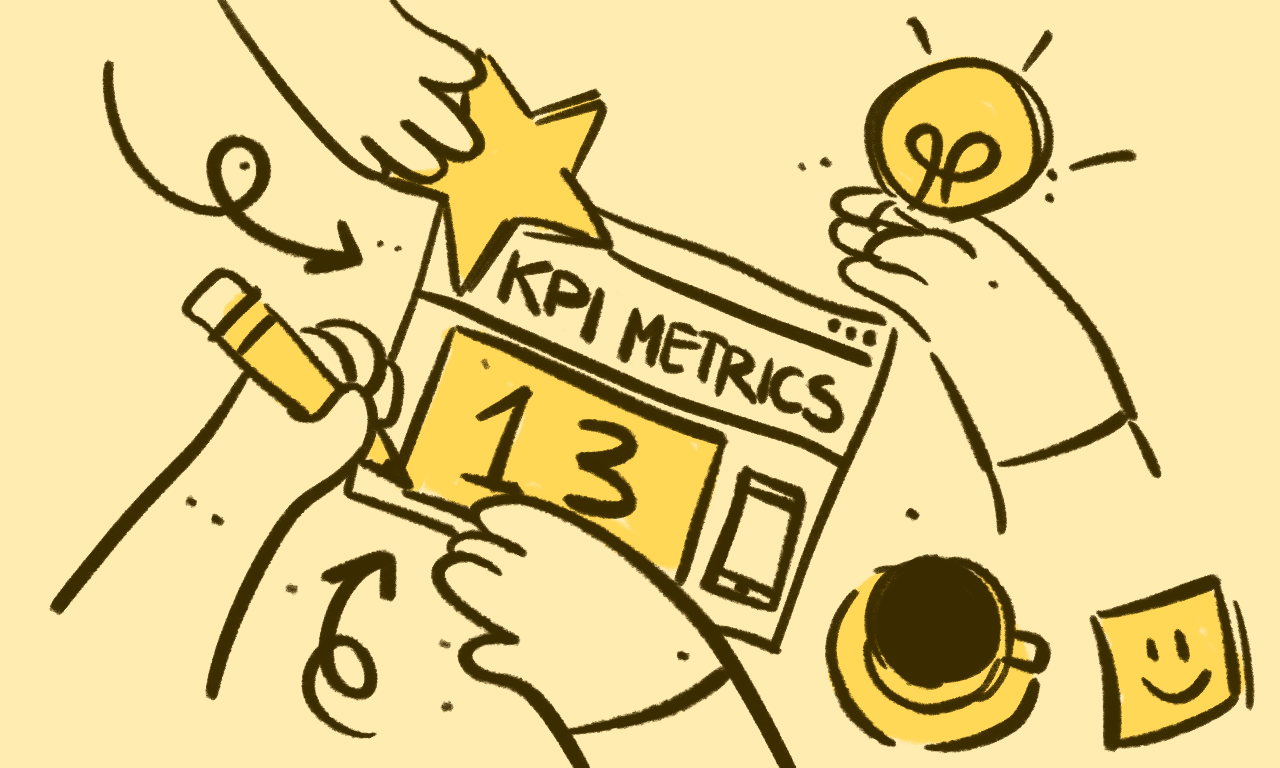
User engagement metrics
Conversion metrics, user retention metrics, marketing metrics, travel mobile app performance metrics, wrapping up.
You’ve built a travel app and launched it to the world. Now it's time to see how it's doing by tracking some metrics. As an app owner, you need to know what's working and what’s not so you can make tweaks to improve the user experience. Measuring key performance indicators (KPIs) will tell you if your app is on the road to success or needs a major detour.
In this article, we'll explore 13 of the most important metrics for mobile travel apps. Whether it's active users, retention rates or conversions, having your finger on the pulse of these metrics will help ensure your app is high-performing and delivering value.
Daily active users (DAU) / monthly active users (MAU)
Daily active users (DAU) refers to the number of unique users who engage with your app on a given day .
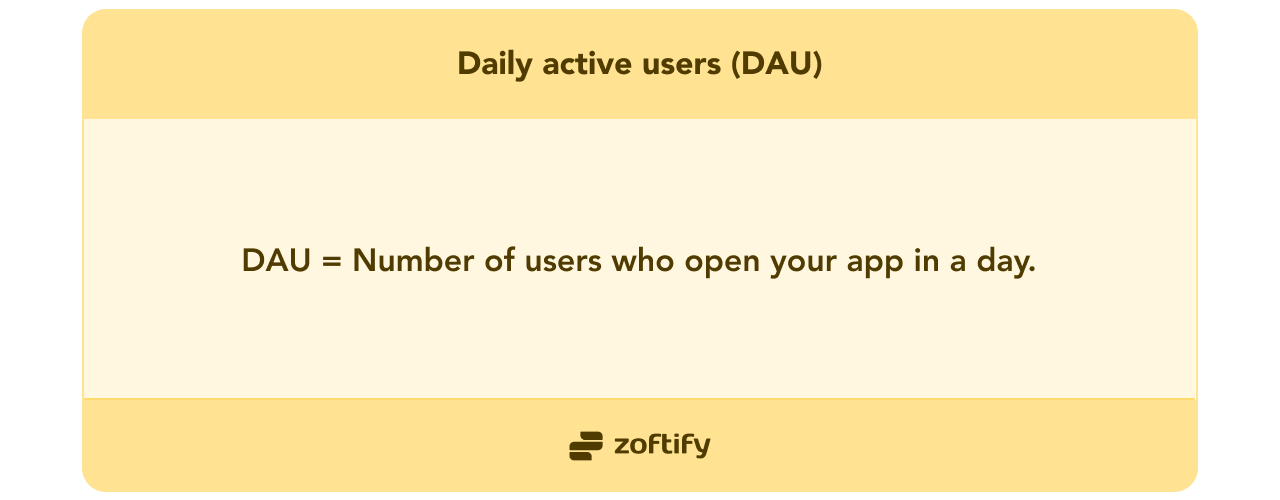
Monthly active users (MAU) tells you how many unique users opened and interacted with your app within a 30-day period .
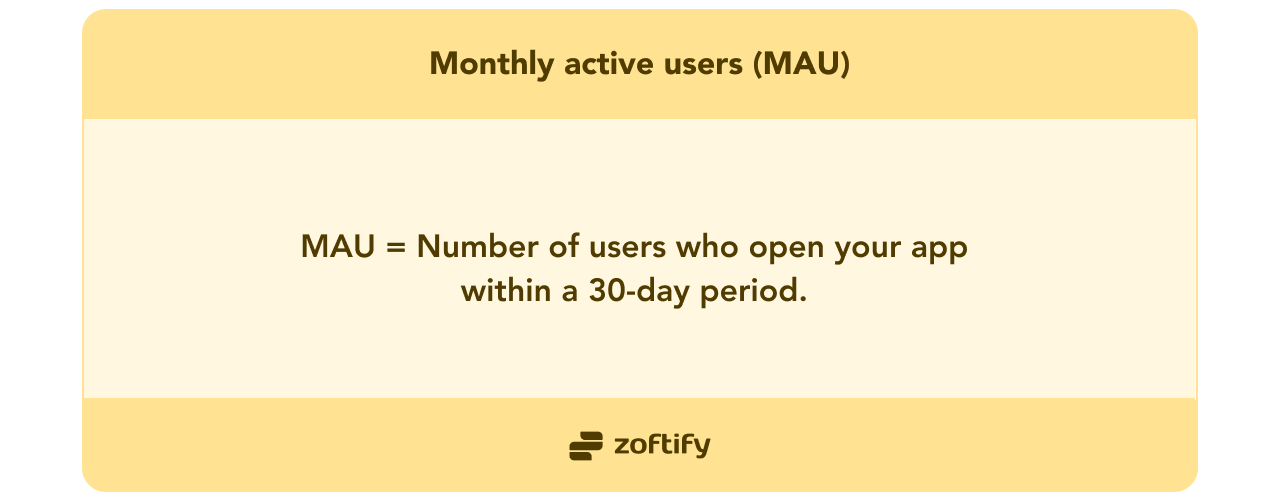
This is one of the most important metrics for travel mobile apps. Why? Because engaged, loyal users are the lifeblood of any app . They're the ones who will keep coming back time and time again, explore all your app has to offer, and are most likely to book something or make purchases.
Want to grow your active user base? There’s a few things you can do:
- Create a seamless and satisfying onboarding process to turn newcomers into regular users.
- Send personalized push notifications to regain users’ attention.
- Collect feedback to reestablish contact with inactive users and learn about their travel habits.
But remember, people don't book flights or hotels every day, even if they travel frequently. Analyze this metric based on your travel app’s purpose and your users’ expected behaviors.
Average session duration
When it comes to measuring how engaged your users are, average session duration is a key travel app metric to track. This tells you how long, on average, people spend using your app per visit .
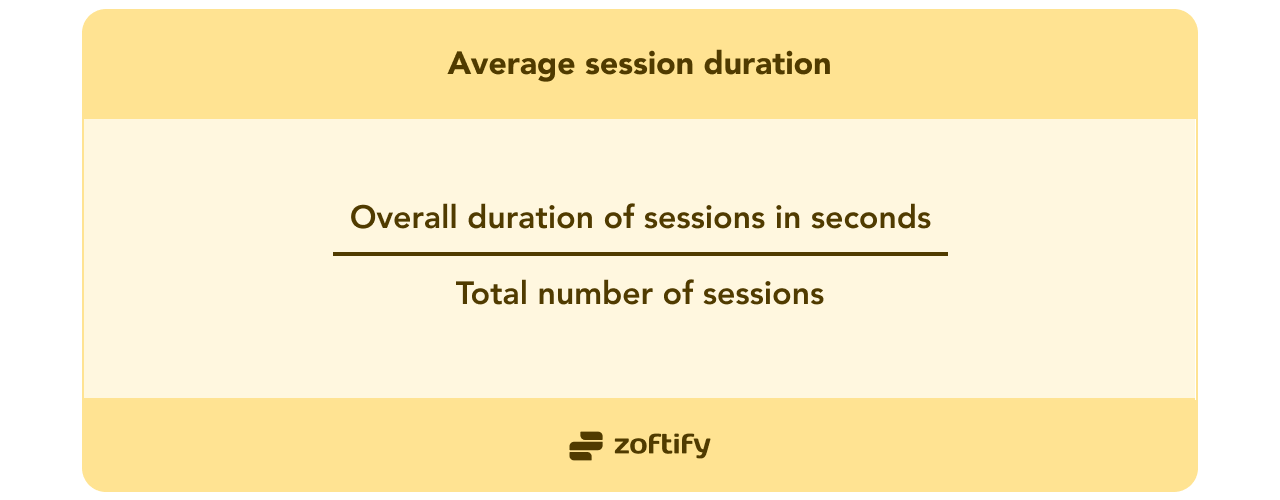
If users spend a lot of time in your app, then it means they find value in what your app offers. For mobile travel apps, the ideal average session duration ranges from 15 to 17 minutes , according to Adjust data . Let’s look how the averages have changed slightly in recent years:
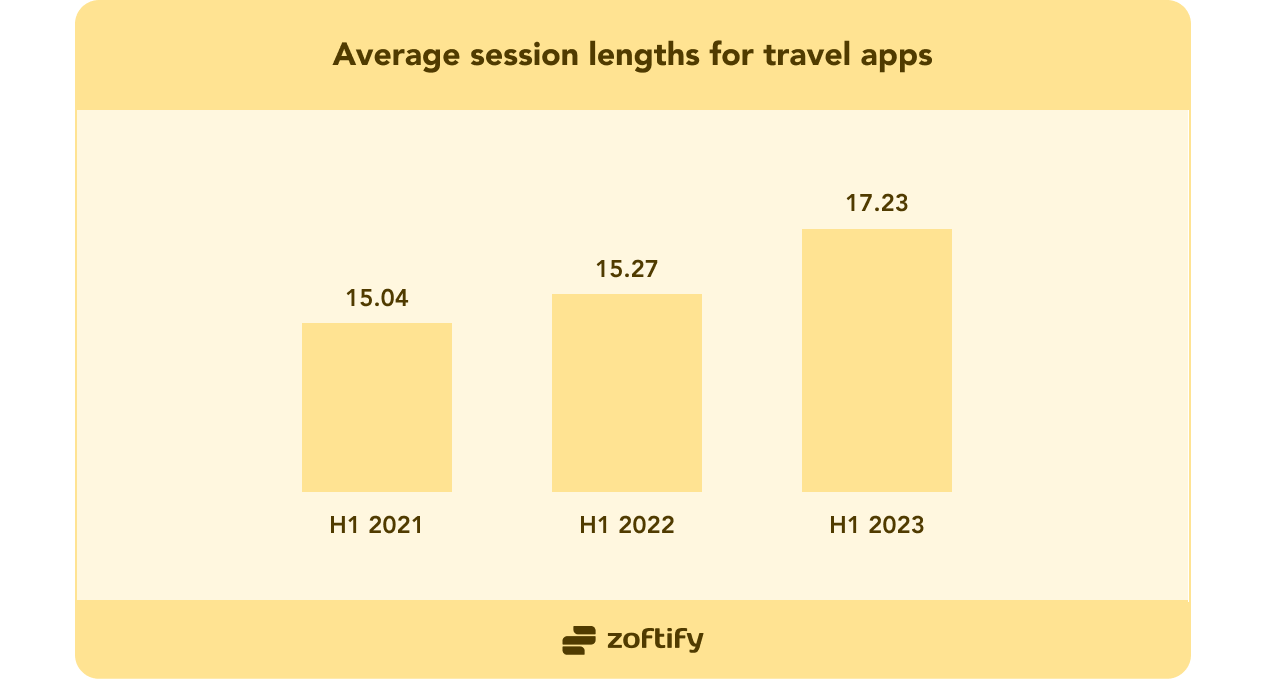
Start by aiming for an average session duration of 8 to 10 minutes, then try to make it longer. Here’s how:
Focus on enhancing features that facilitate in-depth planning and research .
Incorporate travel stories, blogs, and itineraries within your app that encourage users to read and learn .
Add simple games or challenges related to travel to entertain users and keep them exploring .
Track travel application KPIs and drive success.
Get in touch with Zoftify for expert advice.
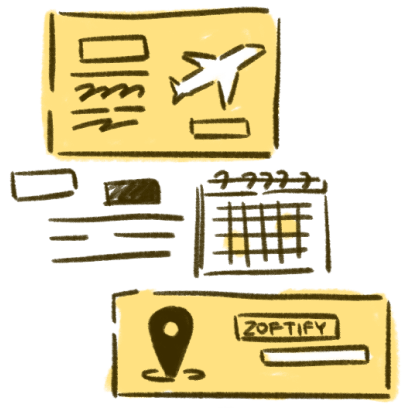
Conversion rate
To effectively measure how well your mobile travel app is performing, focus on your conversion rate. This refers to the percentage of people who take a desired action after visiting your app , like making a purchase or booking a trip.
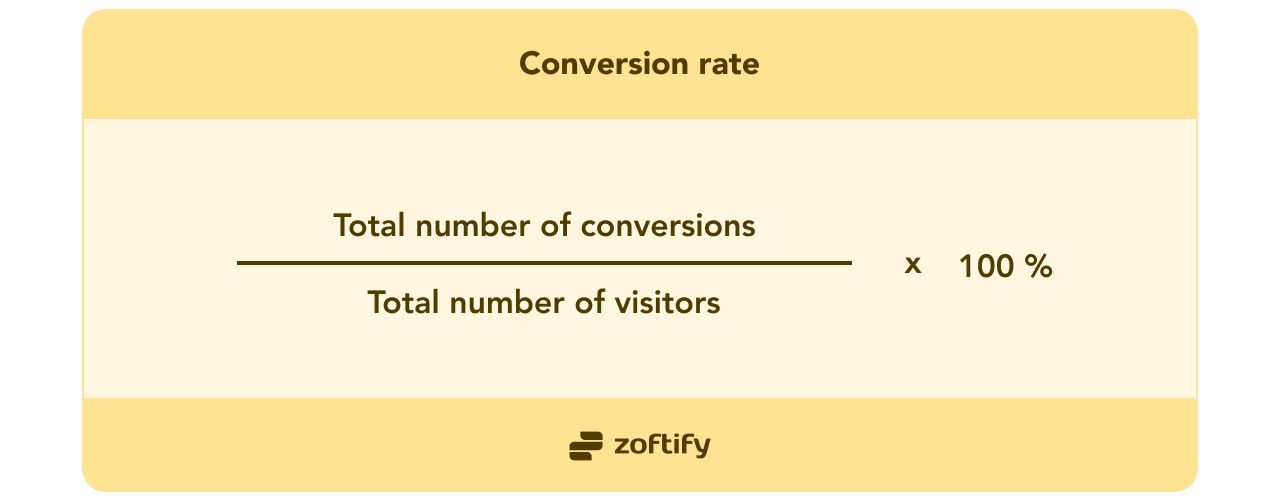
The higher your conversion rate, the better. Aim for 1-3% to start ( the industry average is 2%).
A high conversion rate means your app successfully convinces users to do what you want ; if it's low, there may be blockers stopping people from taking action. Work through these questions to improve your conversion rate:
- Is the booking process complicated or confusing? Simplify the steps required and provide clear instructions.
- Are there technical difficulties preventing bookings? Test your app thoroughly to identify and fix any bugs.
- Do you need to improve trust and credibility? Highlight security features , testimonials, and your refund policy.
- Is your content engaging and inspiring? Use enticing photos, videos, and descriptions to spark interest in destinations and deals.
- Are your prices competitive? Compare rates with other travel sites and apps to ensure you’re offering good value.
- Is your call to action persuasive enough? Place “Book Now” or “Complete Purchase” buttons prominently.
Receive travel tech insights directly in your inbox
You can choose to unsubscribe at any time

Time to first purchase
Time to first purchase is one of the most crucial travel mobile app KPIs. It shows how long it takes for new users to make their first in-app purchase or booking after downloading your app.
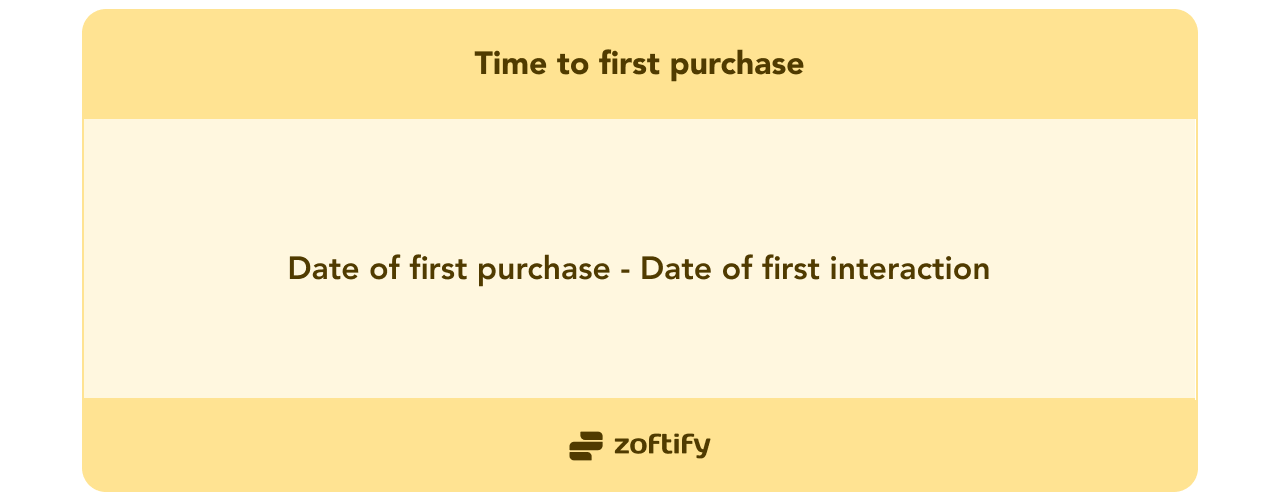
If users purchase or book something relatively quickly, like within a few days, hours, or even minutes, then it's a good sign. This means your app is providing value and keeping users engaged . If this figure is high, like a few weeks or months, you may need to re-evaluate your user experience and purchasing flow. Do note that, on average , only 42% of recently registered users complete a transaction in the first month.
To improve the time to first purchase, you can:
Offer discounts and promotions for first-time buyers on iOS or Android. Giving people an incentive to buy early can be very effective.
Suggest relevant products as soon as users launch your app. You might show deals on hotels, flights, or activities in different destinations.
The key is understanding your customers and what motivates them to buy. By optimizing your app to get people purchasing quickly, you'll see higher lifetime value and faster growth .
Booking abandonment rate
Abandonment is when a user starts the booking process in your travel app but leaves before completing the purchase . This KPI for mobile travel apps helps to highlight when there are issues in your booking flow that are frustrating users and causing them to quit.
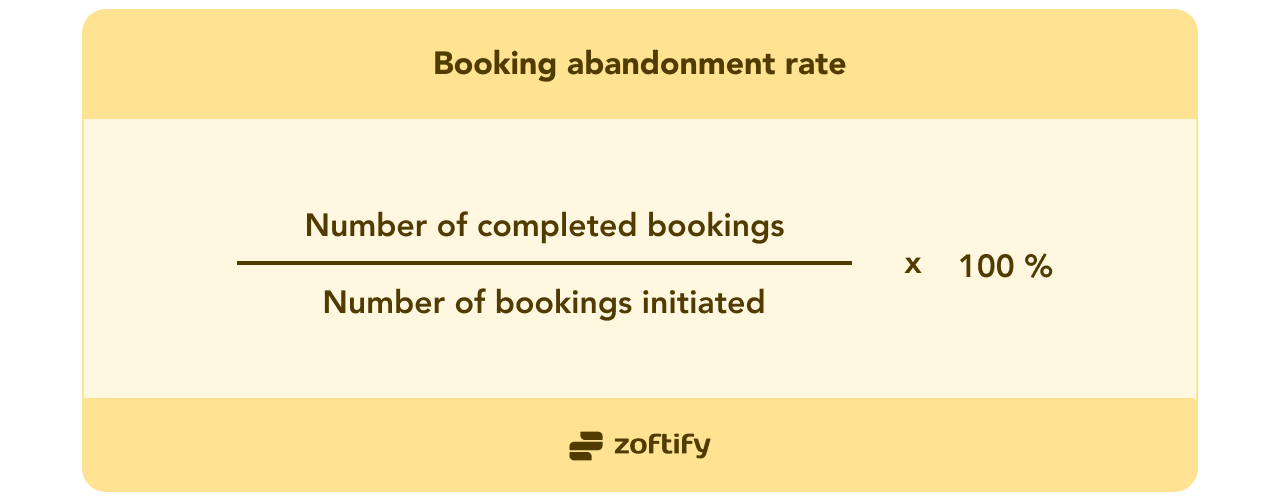
Booking abandonment rates are often high when the payment process is confusing or there are surprise fees , but sometimes people just get distracted or interrupted. Here are the averages for apps in different travel and travel-related niches, for comparison:
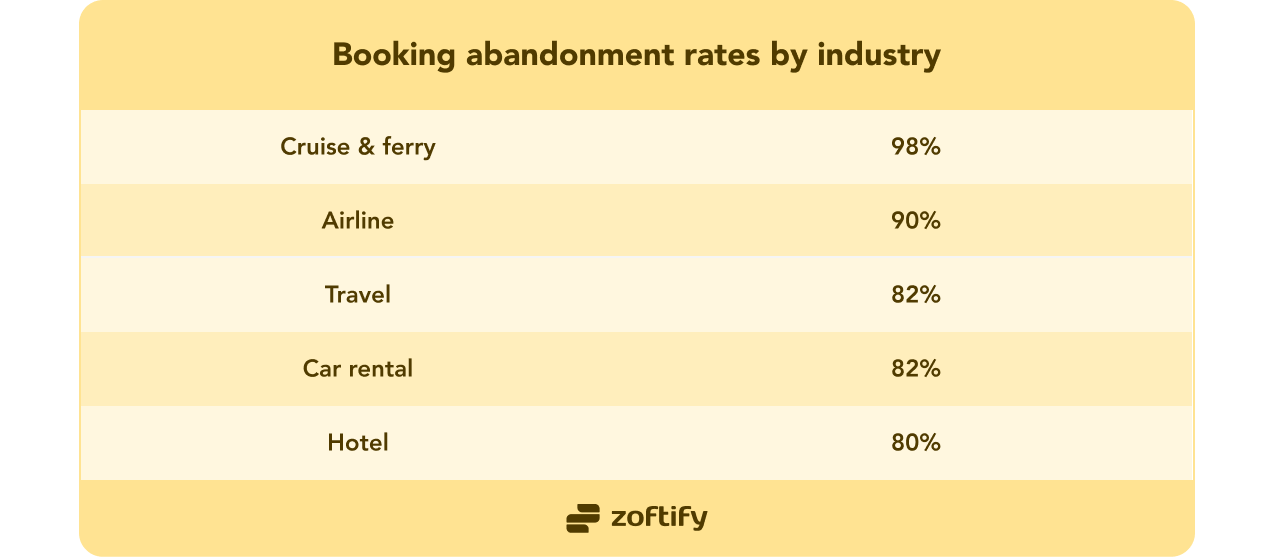
If your booking abandonment rate is higher than industry average, then something isn’t right within your app and it’s costing you sales and revenue. Ask yourself:
- Are prices or fees surprising users at the last second? Be upfront about all charges as early as possible. No one likes hidden fees.
- Is your app timing out or crashing during booking? Nothing is more frustrating than an app crashing in the middle of a transaction. Fix any technical issues immediately .
- Do you have a progress indicator to show how much of the booking process is complete? This helps set expectations and encourages users to finish.
Overall retention rate
Retention rate is one of the most important travel mobile app engagement metrics. This KPI shows the percentage of users who continue to use your app over a given period, like a week, month, or quarter.
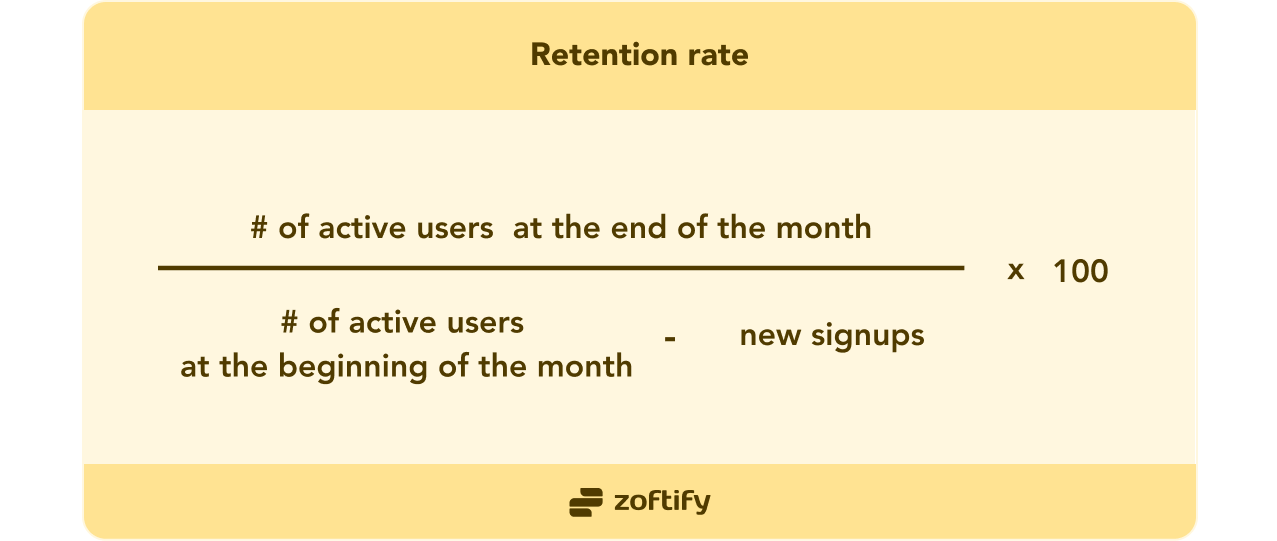
A high retention rate means users find your app useful and engaging enough to keep coming back. But be realistic with this metric — according to Adjust data , retention rates for the travel industry are not that high overall. They look like this:
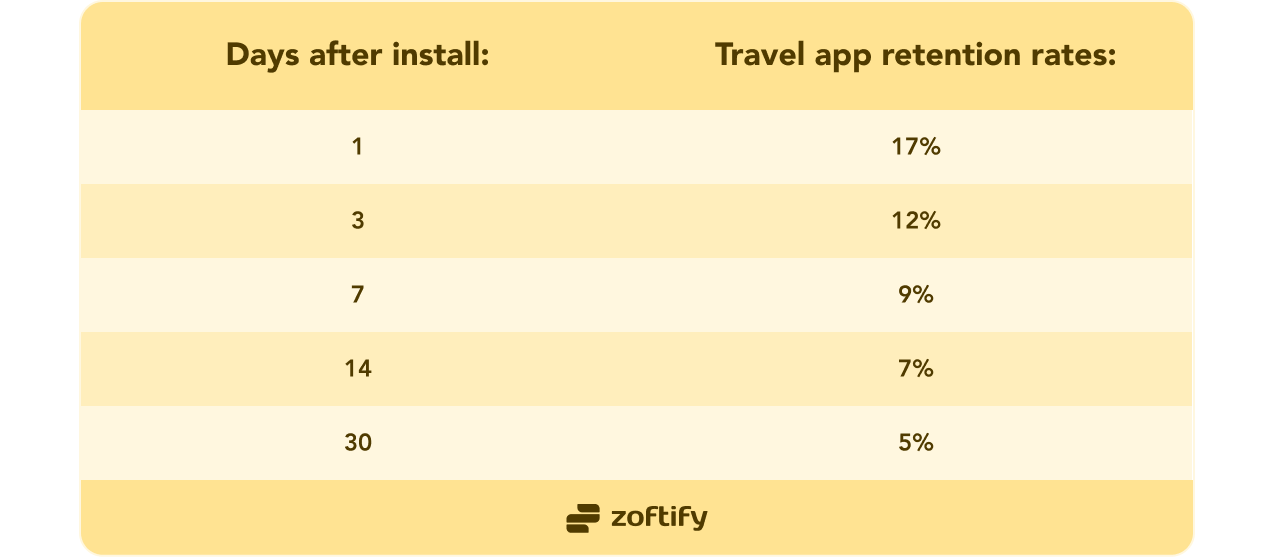
As an app owner, retaining users should be a top priority. With the right approach, you can improve travel app engagement rates quickly and easily. Here are some tips to help you:
Improve UI/UX . Use a simple design, add good quality imagery, and keep it neat. Users will come back if they enjoy using it.
Implement A/B testing . Test different app versions to find what users like. Stick with the option that gets the best feedback and keeps users interested.
Make it personal . Gather data from search histories and recently-visited destinations to show users content that they'll like.
To learn more, read our article on improving this travel mobile app performance KPI.
Seasonal retention rate
This KPI for travel applications measures how well your app retains users from one season to the next . For travel apps, seasonality plays a big role in usage and retention. People travel more during summer and holidays, so you'll likely see higher retention rates during those times. In the off-season, retention may dip.
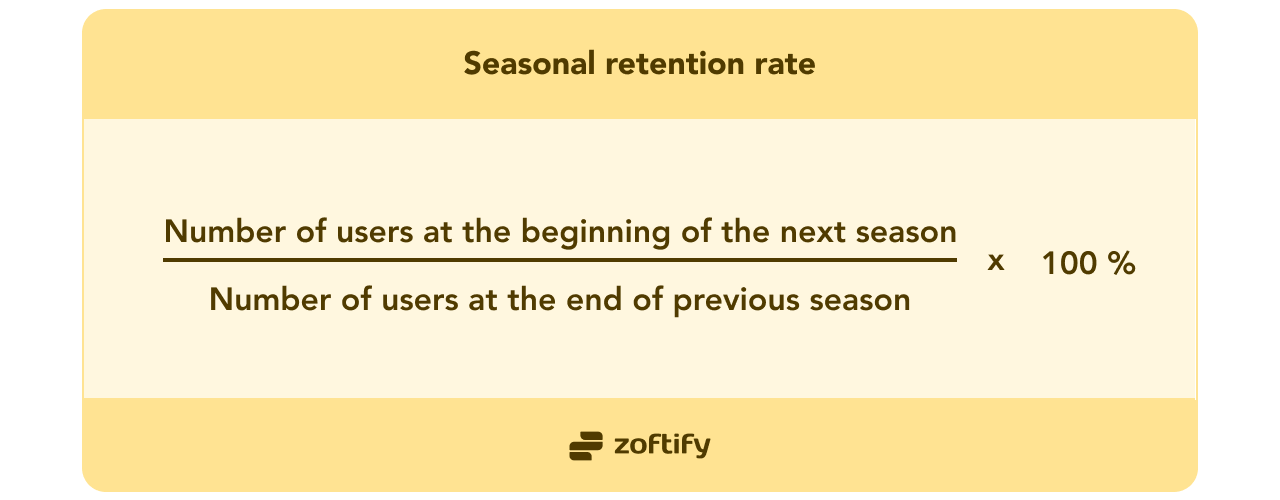
Your goal should be to keep as many users as possible engaged year-round. Some tips to boost off-season retention include:
Highlight year-round destinations . Promote places people can visit any time of year. This may spark their wanderlust even when the weather's cold.
Introduce new in-app features like a bucket list or wishlist. Encourage users to save future trips they're interested in.
Send push notifications with travel inspiration and tips. Keep your app top of mind by sharing photos of dream destinations, packing reminders, or travel hacks.
Offer discounts or promotions during off-peak times. Give users an incentive to keep using your app even when it’s not a popular time to travel.
Churn rate refers to the percentage of users who stop using your app altogether within a given period of time . Monitoring your churn rate is critical because high churn means you're losing customers.
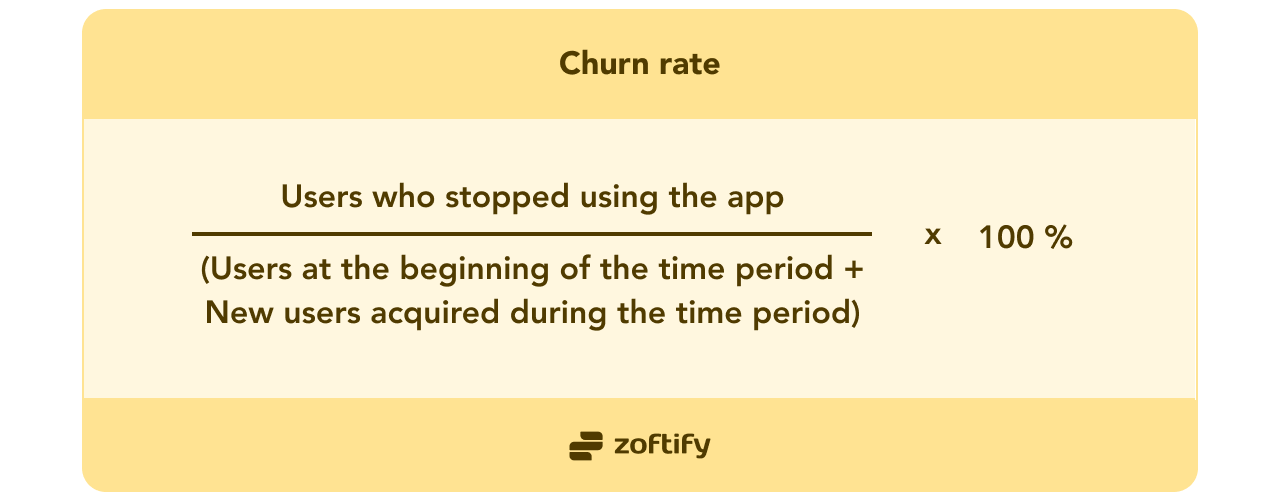
Here’s how many users the average travel app loses after different periods of time:
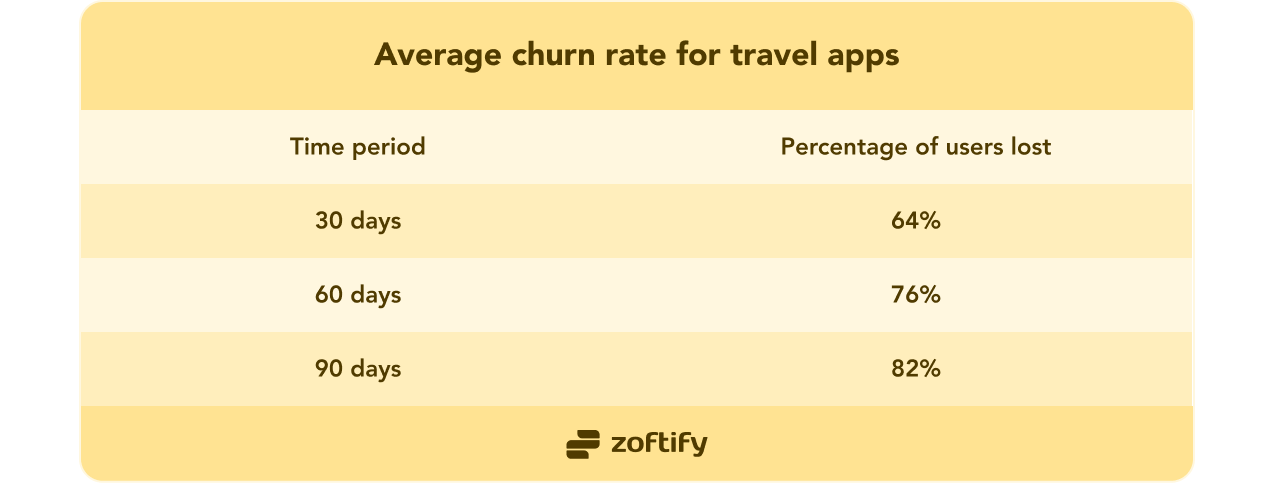
A churn rate that’s higher than average is often a sign that something needs improving in your app. Maybe the user experience is frustrating, the content is lacking, or your marketing doesn’t match what users actually get from your app. Whatever the reason, reducing churn should be a top priority . Some ways to decrease churn include:
Improve your onboarding process . Make sure new users quickly see the value in your app. Walk them through key features and set them up for success.
Offer incentives for loyalty . Provide special perks, rewards, or subscription discounts for users who have stuck with your app for 6-12 months.
Analyze usage data . See if you can spot any patterns among users who churn, like what features they used (or didn’t use), how often they logged in, and their location or device type.
Unlock the full potential of your travel app.
Contact Zoftify for professional guidance.
App store ratings and reviews
User ratings and reviews in app stores are some of the clearest ways to tell what users honestly think about their experience . Not only do good ratings attract new users, but they also improve your search ranking in the app stores.
But instead of just looking at each review in isolation, use this formula to gauge whether you receive more positive or negative feedback overall:
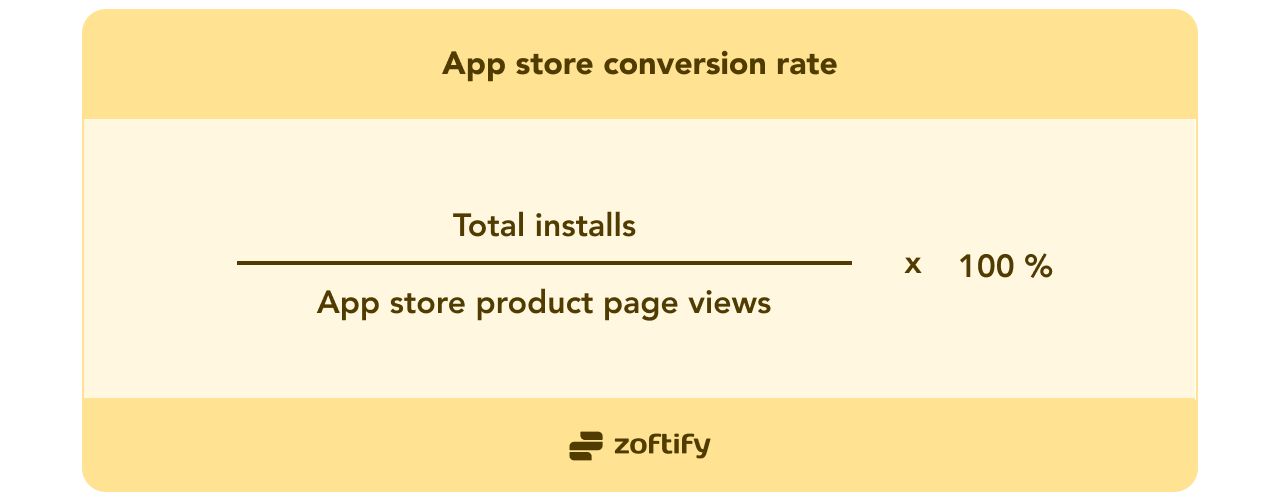
To measure review rate you need to decide for yourself what counts as a positive or negative review. Do this by looking at what the reviews say, not at their rating. Also, don’t forget to:
Reply to all reviews , especially the negative ones, in a timely manner to show that you are proactive.
Thank users for their feedback to show appreciation.
Apologize for negative experiences and ask follow-up questions to best resolve the issue.
Act on the feedback by making necessary improvements to your app.
In addition to your overall average rating, track how your ratings change over time . Are you trending up or down? Look for any major drops or spikes to determine the cause. Maybe you released an update with bugs or made an unpopular change. The sooner you identify issues, the quicker you can make fixes to get back on track.
App store conversion rate
This important KPI shows how many people who visit your app page in an app store actually download and install your app .

The average rate for travel apps is around 3% for the App Store according to AppFollow benchmarks . Rates are pretty much consistent throughout the year, but may vary in different countries. For example, let’s look at the stats for July 2023:
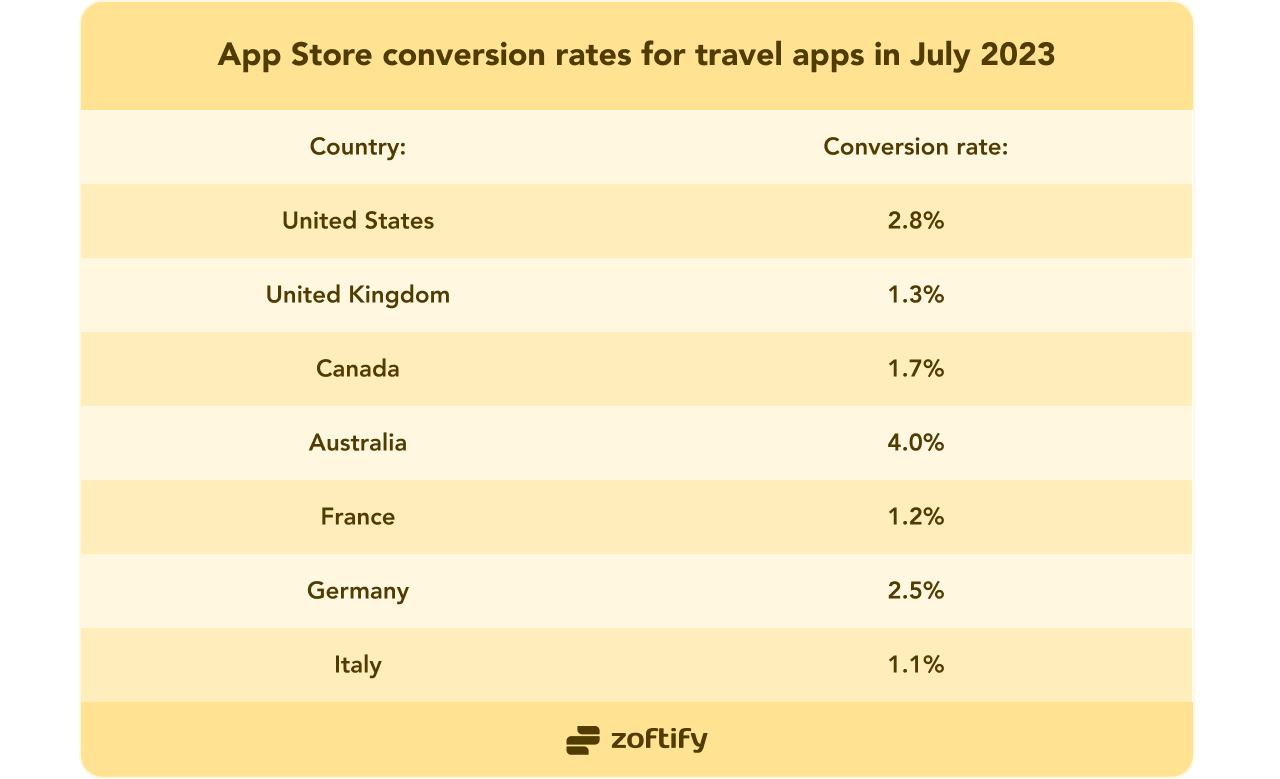
These differences might seem insignificant, but every percent is important , because it directly correlates with the number of new users. A conversion rate equal to or higher than average means your app page is compelling and inspires confidence in your app. If your conversion rate is lower than average, your app page may need some optimization. Double check that:
Your app name, description, and metadata are optimized for search .
You include eye-catching screenshots that show off your well-designed mobile app’s best features.
Your ratings and reviews make people excited to download.
Even increasing your conversion rate by 1-2% can result in many more downloads and a huge boost to your growth.
Cost per install (CPI)
Cost per install (CPI) shows you how much it costs to acquire each new user who downloads your app.

As an example, the CPI for Google Ads is $2.24 on average. The numbers vary depending on the region:
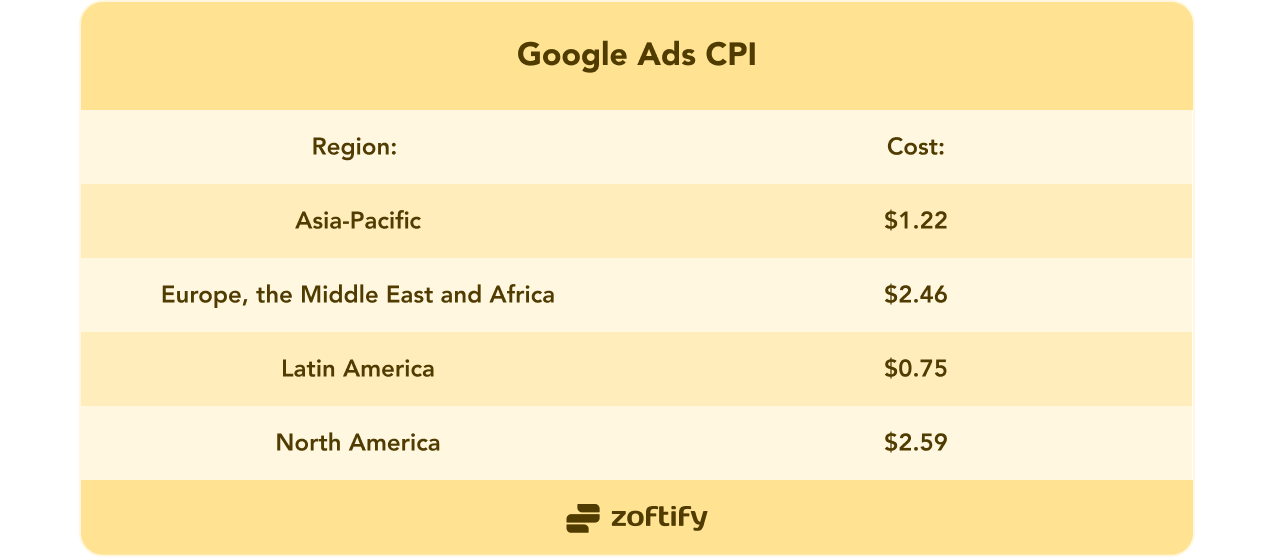
It’s really important to calculate this KPI when setting your marketing strategy. The lower your CPI, the more efficiently your marketing dollars are being spent . If your CPI starts creeping up over time, it may indicate that your marketing strategies are becoming less effective at driving new installs. In that case, try to do the following:
Explore new channels or make changes to improve your targeting and messaging.
Track the KPI over time and by channel to see which platforms and campaigns are most cost-effective for acquiring users.
Identify cost-effective platforms and focus on channels with the lowest CPI. For example, you may find social media ads have a lower CPI than search ads.
App load time
How quickly your app loads is crucial in travel app development . If it takes more than a few seconds, users will likely abandon it. Measure the time from someone tapping your app icon to when the content is interactive and functional .
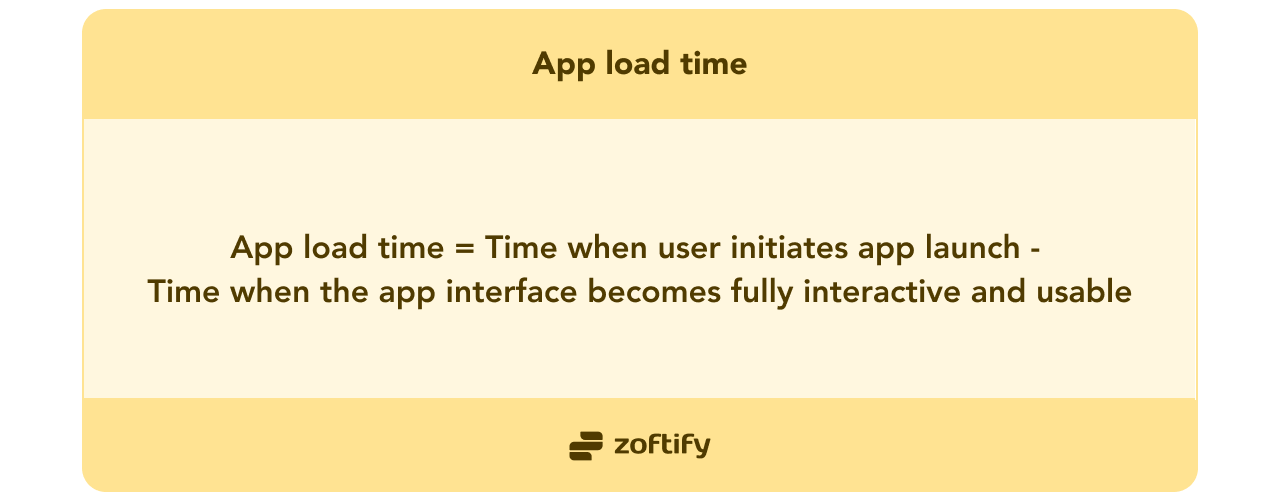
Keep in mind that there are different types of app launches — cold, hot and warm — so you’ll need to factor this into your calculation. When you launch an app from scratch (cold launch) , the system needs to start up various processes to support the app to run. In a hot launch , the app is already in the system’s memory, it just needs to be brought to the front, so it will open quickly. A warm launch is in between. Some cold start operations still happen, but the app will open quicker than if it was opening from scratch.
Your app's startup time can be considered acceptable if it falls within these thresholds:
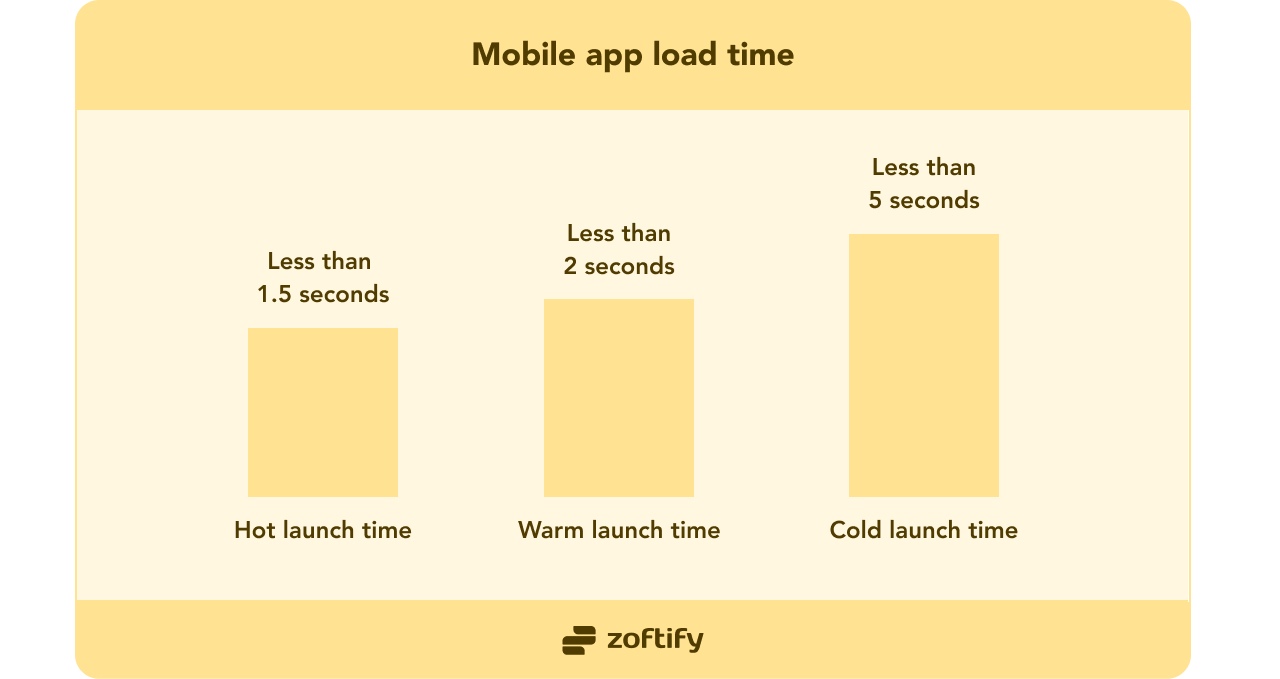
Aim for these averages — a load time of 5-10 seconds or more will frustrate your users. Here’s how you can improve load time:
Regularly check that updates or new features are not slowing down the app .
Adjust image sizes for optimal performance .
Implement caching mechanisms to enhance speed .
Focus on code optimizations to improve app responsiveness .
App crashes and errors
When an app crashes or bugs out, users get frustrated. Measure the number of app crashes and errors to determine how often this happens. If it's often, you'll lose users fast.
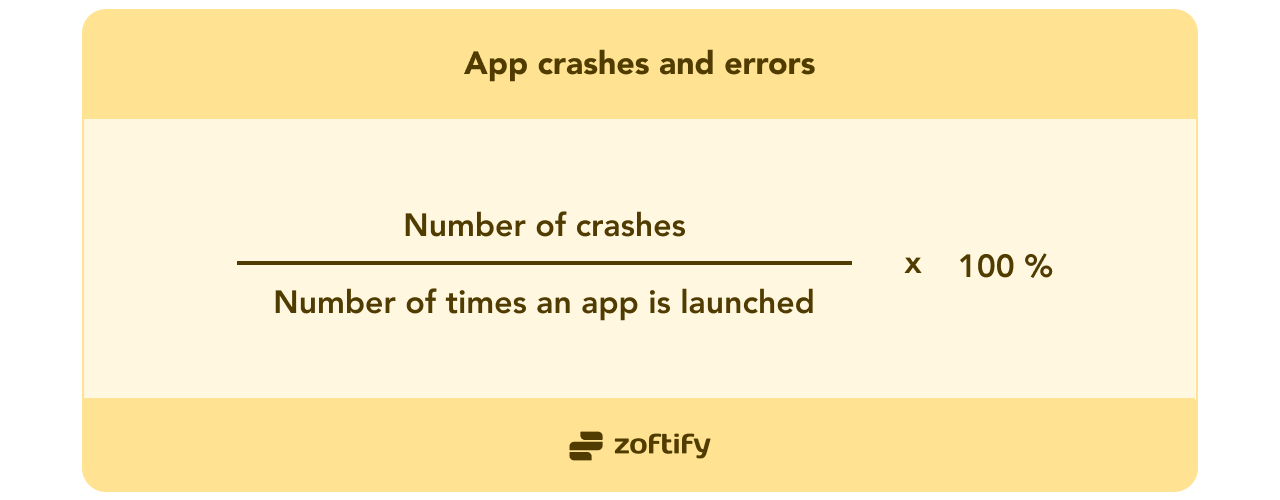
The odd crashes and errors here and there in mobile apps are okay. But use the acceptable crash rate to help you determine whether your app has a serious problem. An experienced travel app development company would integrate crash reporting tools such as Crashlytics from day one.

Follow these steps to track and fix any issues the right way:
- Look at crash reports and error logs.
- Examine what’s causing the issue and if it happens repeatedly.
- Change your code to solve the issue.
- Make sure everything works by testing thoroughly.
- Give users the new, fixed version of the app.
Once you’ve fixed the problem, let your users know . They'll appreciate your responsiveness.
Want to know more about tourism mobile app success metrics?
Get in touch with us today.
Data is only useful if you actually analyze it and take action. Review these essential KPIs regularly and make changes to your app based on what the data is telling you. With regular tracking and refining, you’ll be well on your way to travel app success. Your users will thank you for it with more time spent in-app and more travel bookings.
What are the most essential mobile travel app KPIs to track?
When it comes to mobile app KPIs, there are several important metrics you need to know. User engagement metrics include daily active users (DAU), monthly active users (MAU), and average session duration. Conversion metrics include conversion rate, time to first purchase, and booking abandonment rate. User retention metrics involve overall retention rate, seasonal retention rate, and churn rate. Marketing metrics consist of app store ratings and reviews, app store conversion rate, and cost per install (CPI). Lastly, app performance metrics include app load time and app crashes and errors.
What can you do to reduce the churn rate?
To reduce this KPI for tourism applications, focus on improving the onboarding process for new users, offering incentives for loyalty, analyzing usage data and enhancing the overall user experience, perhaps with personalized app content. You should also continuously optimize your app based on user feedback and preferences. These strategies will help keep users engaged and satisfied, and encourage long-term app usage.
How do you measure the success of a marketing funnel?
There are two very important travel mobile app metrics to consider: conversion rate and cost per install (CPI). Conversion rate measures the percentage of people who take a desired action, such as making a purchase or booking, after visiting your app. A higher conversion rate indicates a more successful marketing funnel. CPI shows how much it costs to acquire each new user who downloads your app. A lower CPI suggests that your marketing dollars are being spent efficiently.
Founder & CEO
Alex loves travel and tech and founded Zoftify to help travel companies use technology more effectively. Before this, he worked in tech consulting, where he led international mobile development teams.
Read other articles
Related articles
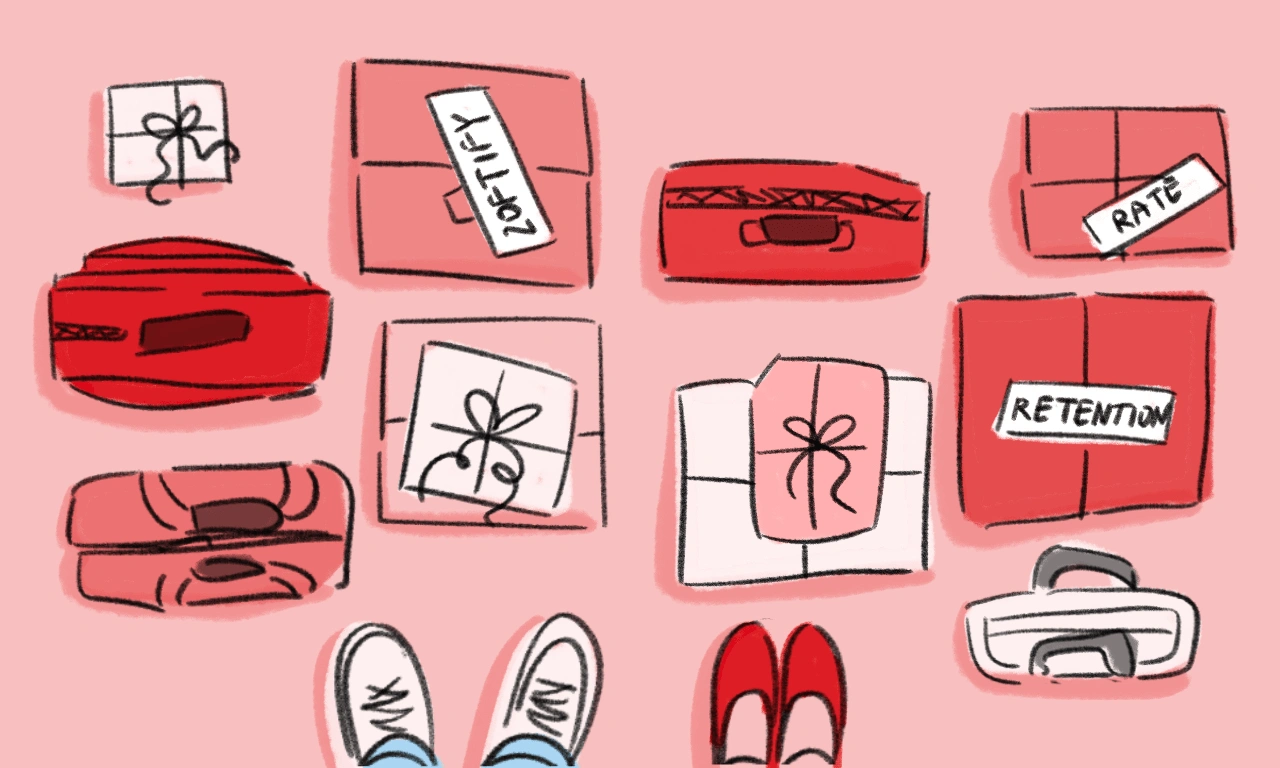
September 12, 2023
7 Ways to Improve Your Travel App Retention Rate
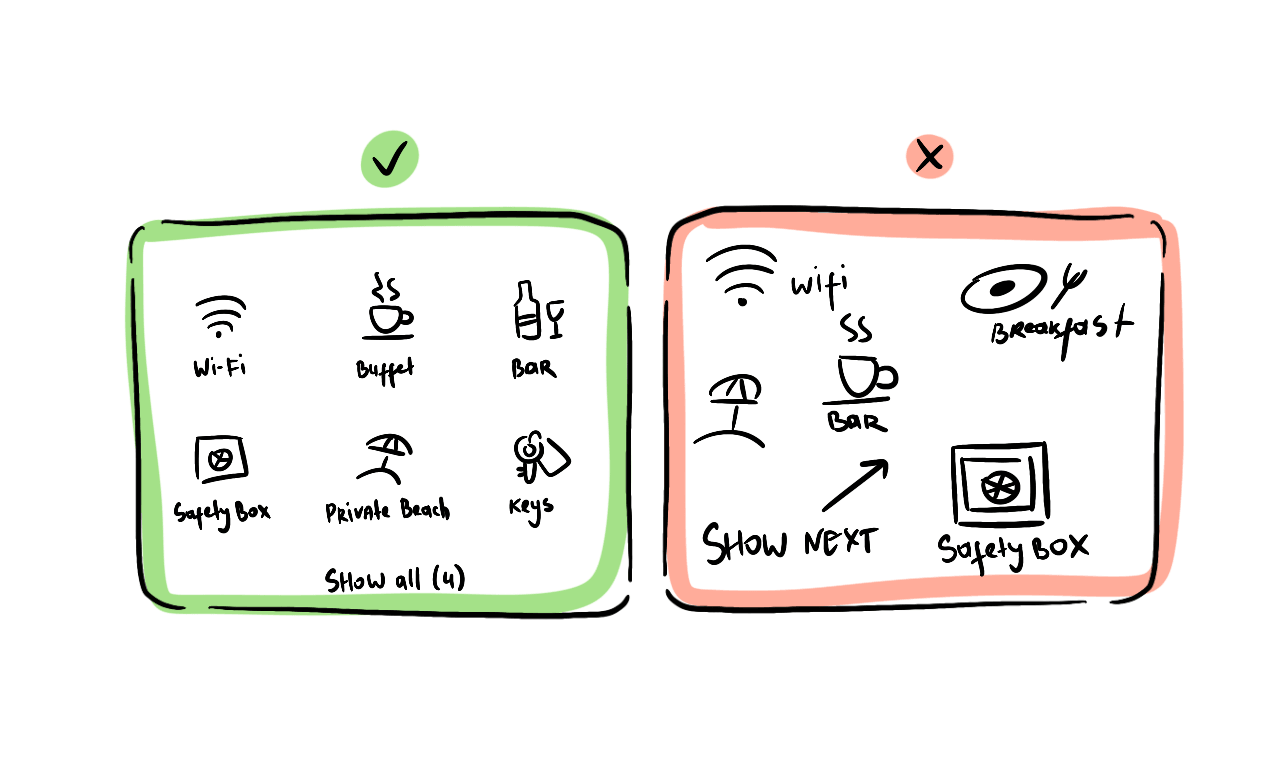
July 15, 2023
The Importance of UI / UX Design in Travel Mobile Apps
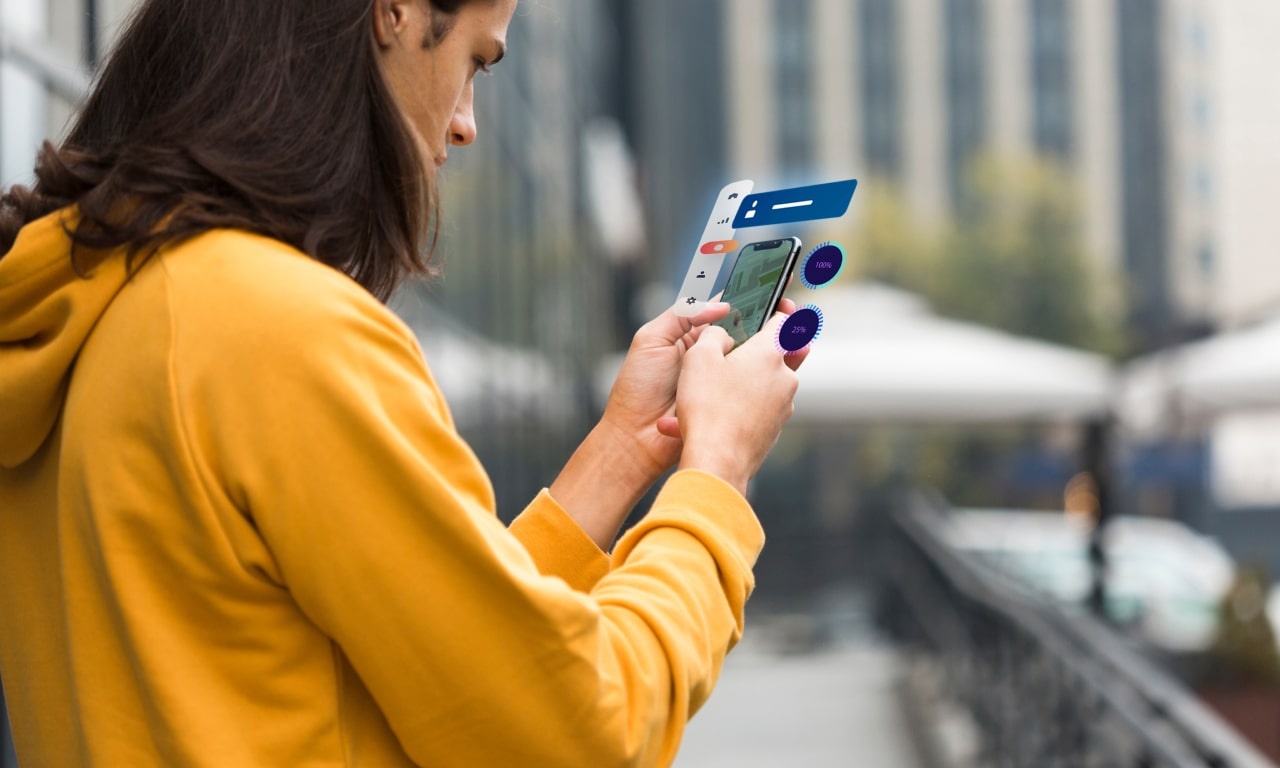
June 28, 2023
13 Must-Have Travel App Features
The Full Guide to Travel App Development: Revenue Models, Features, Cost
Updated 05 Jun 2023

When it comes to planning a trip, travelers rely on their mobiles more than ever. According to Travelport Digital , 80% of travelers used a mobile app to research trips in 2018.
So travel app development is a perspective niche to bring investments in. But if you want to build a big-time travel app, you need to carefully choose the business model, features, and decide on the budget.
In this guide, we’re sorting out travel mobile app development – from how they work to how to make a successful travel app. And how much it’s going to cost you.
Let’s get started.
How Travel Apps Work
Agencies create travel apps for much more than listing hotels and restaurants. Still, providing useful and engaging travel content remains their best lead generation channel.
The content travel companies rely on often includes:
- travel guides
- reviews and ratings from travelers
- exclusive tours
By developing a travel app, companies offer a more convenient tool to search for tickets and check their cost, rent cars, and so on.
Same with accommodation search and booking. With extensive filtering options, reviews system, and other travel app features, users won’t spend tons of time choosing the right place.
Industry giants like Expedia and TripAdvisor allow doing all that from a single app.
Finally, some platforms work with upsales – they make custom propositions to clients, according to their preferences. Like offering specific tours, insurances, and additional services.
Travel app design concept by Cleveroad
How Travel Apps Make Money
Next, we’re finding out what keeps travel apps like Expedia, TripAdvisor, Booking.com afloat.
There are three revenue models for tourism app development:
- merchant model (Expedia)
- commission fees (Booking.com)
- advertising (TripAdvisor)
Merchant Model
Expedia makes most of it's profit following the merchant model. Their gross bookings increased to $28.3 billion in the second quarter of 2019.
Here’s how it works: the platform buys hotel rooms and then resells them to guests. As Expedia rents rooms in bulk, hotels can offer the cheapest deals to it's customers.
Besides, merchants bundles often extend to airfares, car rentals, and other services.
For example
Expedia buys 100 rooms at $50 per night instead of $90 (the best available rate). Customers are happy as they get rooms cheaper than the hotel initially offers, hosts – because of the number of rooms booked and the income.
Commission Fees
Small hotels don't have advertising budgets as huge chains do. This means their best chance to attract travelers is to get listed on large resources like Booking.com.
In turn, companies that created travel apps may set commission rates from each transaction. For instance, Booking.com charges from 10% to 30% of each booking made.
Want to repeat Booking.com’s success? Check how in ' How to Create a Hotel Booking App ' guide.
Booking.com sets the rate at $100 and, if sold, the guest pays, $100 but the hotel gets only $75. The remaining $25 goes to the platform as the commission fee for customer service, marketing, and so on.
Advertising
The advertising model is the most affordable one and works best for small agents who want to build a travel app.
You can show relevant ads like hotels, tour operators, airline ads, and more. Or sell advertising space to firms in the relevant industry.
TripAdvisor is driven by it.
It earns money from flights and hotels by charging cost-per-click to the OTA and supplier sites. In plain words, they get paid for redirecting the customer to third-party websites.
Sure, the listing doesn't guarantee a boost of bookings (after all, reviews and rates remain the same). But a hotel ranked last can greatly increase it's traffic with the sponsored placement.
TripAdvisor offers sponsored listings options and allows paying hotels to show up in the top of users' search results operating on a cost-per-click basis. Clicks on these sponsored listings cost around $1-$3.
Core Features of a Travel App
How to start a travel app development ? By picking the MVP features.
Here are the must-haves most travel apps share:
- Sign-up/profile management
- Searching system
- Chat with hosts
- Notifications
Let’s take a more detailed look at each.
1. Registration and Profile Management
Sing up is the core feature of any application, including travel apps.
It would be great if you allow users to browse the app without logging in each time. But when it comes to bookings, saving payment details, or chatting with the host, registration can’t be skipped.
Most platforms use email/phone number+password combination for sign up.
But social login is also a must-have for travel app development. It allows reusing login details from social media accounts (like Google, Twitter, or Facebook) in just a few taps. The faster, the better for user experience.
Hosts should also have personal accounts in the app to list their property.
In terms of safety, they shouldn’t skip the registration step at all. Plus, becoming the platform’s partner usually takes more time than plain user registration. At least hosts need to provide documents confirming their ownership, agree to the terms, and so on.
Travel app UI: registration panel by Cleveroad
2. Search and Filters
Any travel app should help users to find a place to stay. According to their preferences, the number of people, budget, dates, and so on. The more complex filters users have, the more precise result they get.
Here are the primary filters users should have access to:
- Number of people
- Additional services (parking, Wi-Fi, and so on)
3. Listing Information
Let's imagine users have found a hotel or a restaurant according to their preferences. Naturally, they’d want to find out more about the place.
Usually, travelers get access to the following information:
- Available booking dates
- Description
- Customers' reviews
- Rules and cancelation policies
Another good idea is to show listings on a map. That's how users will see how far the hotel or restaurant is from the city center or the nearest subway station.
To create itinerary apps, developers use Apple Maps or Google Maps, depending on the platform (iOS or Android).
Next, hosts should also have an option to add their place and it's description to the list.
They need to enter:
- description
- available rooms
4. Messaging Channels
You may also think of adding a chat between customers and hotel representatives when developing a travel app. If users won't find an answer to their question in the application, they should have an option to ask staff members directly.
There’s no need for complex solutions with audio or video-calls. A plain chatbox will be a good job too.
Most travel apps allow the booking of tickets, hotels, tours, and other related services. To implement this functionality, developers use various technologies and APIs – like Booking.com, Skyscanner, and other widely popular tools.
What is a travel API, and how it works? We've spelled it out! Check out our '15 Best Travel APIs to Help You Build a Great Product' to see them.
But platforms like TripAdvisor or Booking.com rarely collect the payment from travelers; they prefer to leave it to the hosts.
Travel mobile app design sample: booking feature
6. Reviews System
The reviews system helps users to find out what travelers think and discover the pitfalls.
Here's how it works: when the users check out of the apartment (or the payment goes through, the system will show a notice asking them to rate their experience.
Recommendations from travelers will help other guests understand whether the place is what it seems.
7. Notifications
Push notifications are great for informing about updates, discounts, or sending reminders before the trip. Especially if you’re developing a travel app that is rarely used on an everyday basis.
Push notifications work for:
- showing new offers, discounts, price changes;
- reminding customers about the services left unchecked
- improving customer experience by informing about booking changes or sending reminders
That was the list of MVP features required for any travel application at the start.
But later, you can always add some sophisticated features like:
- weather forecasting
- currency converter
- in-app payments
- language translators, and so on
Weather feature concept by Cleveroad
How to Create a Travel App
Finally, let’s figure out how to make a travel app, both engaging and must-have useful.
1. Work for Your Target Audience
Ask yourself who you’re developing a travel app for.
Dealing with young travelers on a budget? They are easy to win over with discounts, assistance with finding hostels and push notifications about upcoming sales and free activities.
Aiming at big spenders? They have expensive tastes and want high-quality offers. Deliver top of the line experiences with unique offers they'll never forget.
Finally, it’s a good idea to add some personalized offers when developing a travel app. And there’s no shame in peeking at competitors and studying their offers.
Vice versa, you’ll see their week and strong points and may get a few great ideas about what their apps are missing.
2. Pick the Right Team
Done with planning? Time to start looking for a reliable travel app development company.
It may be a good idea to outsource the development abroad. Usually, software development services in Europe or Asia are cheaper than in the USA or Canada. And the quality is often the same.
We've made deep research on European pricing. Check it in our ' IT outsourcing in Europe ' guide.
To pick the company, I suggest using one of the leading review and rating platforms:
On these websites, you'll see the list of companies by countries, hourly rates, and check what their clients have to say.
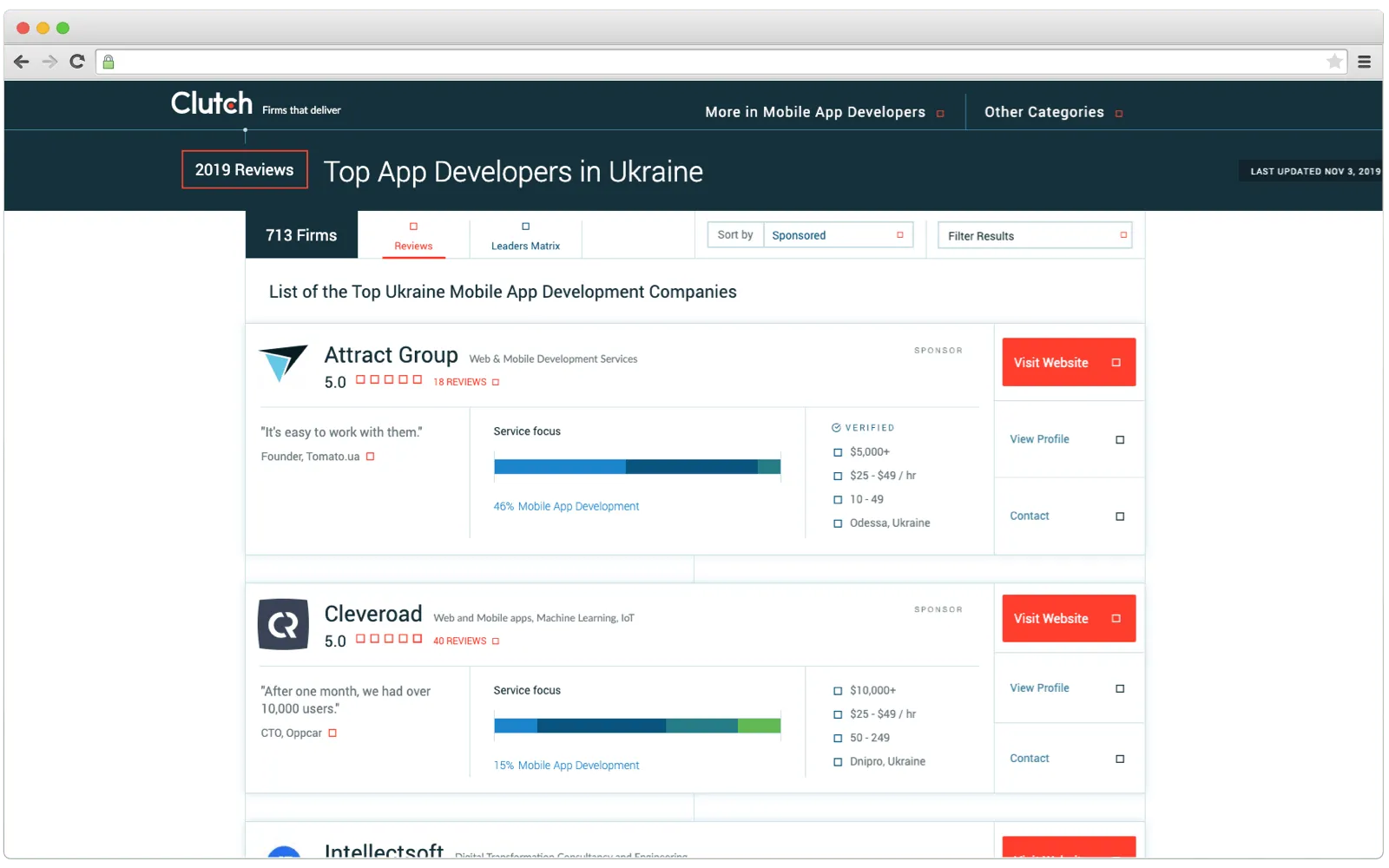
Top travel apps development companies for android and iOS
3. Collaborate with the Hosts
No fancy travel app design or smooth performance will work for customers if there are no good offers provided. So collaboration with hosts is one of the key points of travel application development.
That’s a large amount of data, and hosts are more likely to manage it from an easy-to-use app.
Appearance matters! Order top UI/UX design services for building a cunning app.
From their account, hotel managers should be able to monitor the bookings, general information, and other details.
Another point is a smooth notifications system.
Besides, customers are likely to blame the app if anything happens during their trip. Make sure you’re choosing trustworthy partners that will follow your agreement.
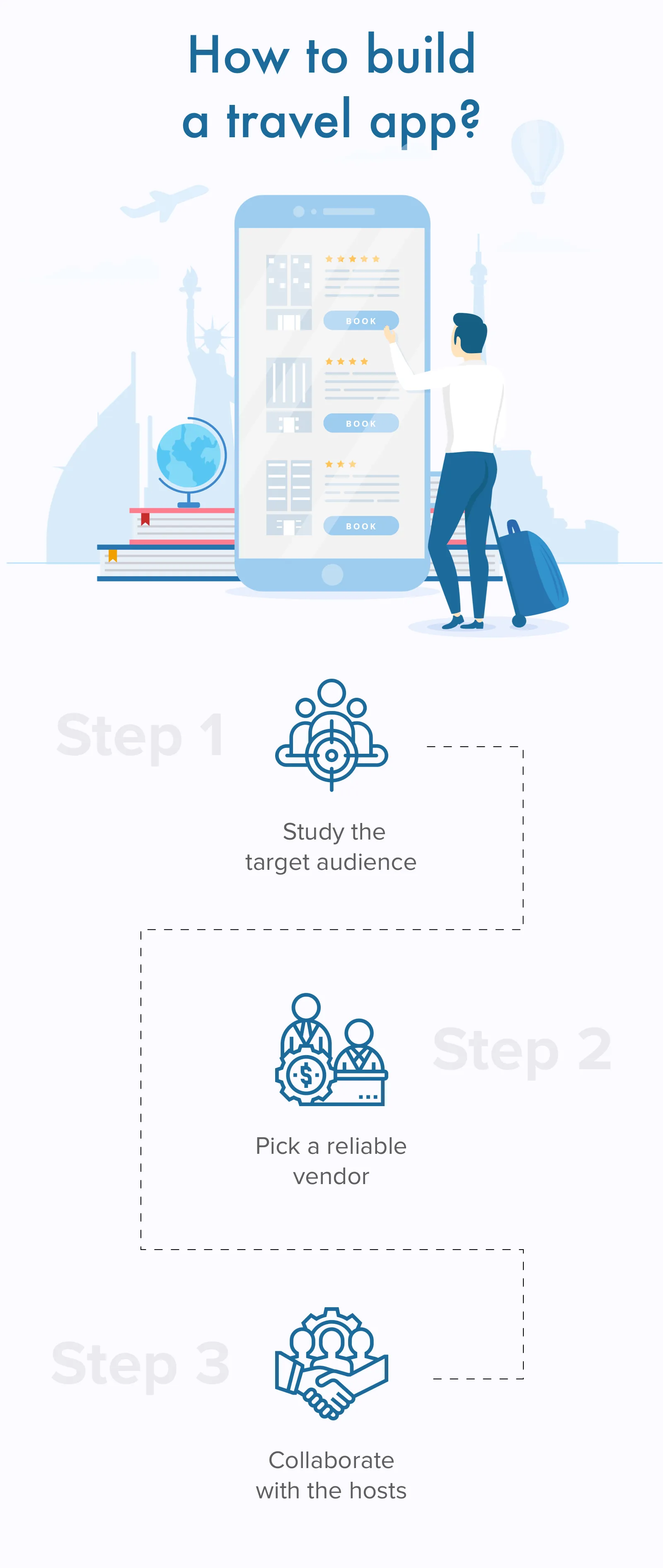
How to make travel app: main steps
Tech Stack For Travel Application Development
Modern technologies come handy for making travel apps run smoothly and load fast.
If want to build a travel app for iOS, the most popular programming languages are Swift and Objective-C . As for Android, engineers may choose Kotlin or Java .
Besides, no application can run without third-patry tools and integrations.
Here’s an example of a project development stack (iOS, Android, web):
App development
- Passport.js
- Crashlytics
3-rd party services
- Google Signin
- Google Maps API
- Google Play
Still, remember that any set of technologies always depends on your project and business requirements.
Cost of a Travel App Development
Building a travel application for two platforms (iOS and Android apps) may cost about $103,600 . It's an APPROXIMATE number based on $50/h rate (Eastern Europe, Ukraine).
The exact number fully depends on your needs and expected functionality.
How much your travel app costs?
Our business analysts at your disposal! We’ll check requirements and calculate the cost, for free.
How I got this number? It's simple: the more hours devs will spend on the mobile development services , the more it's going to cost you.
Our business analysts estimated that travel app development for both iOS and Android (including the hosts’ part, backend and admin panel), will take 2,072 hours .
Besides, the total price of travel app development depends on your vendor's country of residence.
Here are just a few examples with different regions:
- Eastern Europe . $103,600 (based on $50/h)
- Central and Western Europe . $207,200 (based on $100/h)
- USA . $310,800 (based on $150/h)
- Australia . $207,200 (based on $100/h)
Cleveroad Expertise
We are an IT outsourcing company with more than 11 years of experience in the market. Our main objective is to renovate the internal processes of our customers’ business, aiming at higher user satisfaction as well as competitive advantages obtaining. Travel software is the on-demand niche our expertise comprises.
Cleveroad software engineers will eagerly architect solutions for booking, HMS, and TMS digital products to provide the voyagers with a perfect service.
Need a travel app?
We’ll help to turn your idea into a full-scale product.
Travel apps help users to research destinations, find good flight and accommodation deals, and book services. Apps like TripAdvisor also offer travel guides and allow users to check reviews and ratings from travelers.
- Step #1. Define your target audience and come up with unique offers for them.
- Step #2. Hire qualified developers to build a travel app.
- Step #3. Collaborates with the hosts (hotels, restaurants, and so on).
About $103,600 for iOS and Android apps and admin panel. It's an APPROXIMATE number based on a $50/h rate (Eastern Europe, Ukraine). If you need an accurate estimation of your project, contact us .

Evgeniy Altynpara is a CTO and member of the Forbes Councils’ community of tech professionals. He is an expert in software development and technological entrepreneurship and has 10+years of experience in digital transformation consulting in Healthcare, FinTech, Supply Chain and Logistics
Give us your impressions about this article
Very nicely explained.
Thanks for sharing wonderful post. It Will very helpful for beginners. Keep writing.
nice and informative article
It's an interesting points you have shared. Thanks for sharing.
Great article. Thanks for sharing
Apr 08, 2024
Mar 25, 2024
Mar 12, 2024
- Telemedicine
- E-learning / LMS
- Fitness & Wellness
- Web App Development
- Android Apps
- Cross-Platform Apps
- Software Testing
- UI/UX Design
- Most Popular Articles
- How to Build a Telemedicine App: 7 Steps to Connect with Patients
- How to Develop a Healthcare App: Tested Guide from HealthTech Professionals
- Pitfalls You Should Avoid When Developing a mHealth App
- Latest Articles
- Top App Development Company In Estonia 2023 by Clutch
- 10 Benefits of AI in Healthcare: Use Cases & Adoption
- Hospital App Development: Nailing Your MVP Costs, Steps, & Features
- How To Create an Online Learning Platform Like Udemy or Coursera
- ISO 9001 vs. ISO 13485: Differences for Medical Device Compliance
This website uses cookies to ensure you get the best experience on our website.
How to Create a Travel App: Tips, Tricks, Costs

Remember the first time you have planned your trip yourself? Meaning that you have chosen destination, checked the weather forecast in this place, found out the best time to visit it, rearranged your schedule to make this happens, checked the map to find the best way to get there in terms of time and costs, did some research to find things to do there, planned day by day program… Already tried to read? Yes, planning is tiring, yet rewarding. Some people give up even before they start doing a thing and they go to the agency, pay money for someone to create the best trip for them. It’s a working approach, still, sometimes it lacks a personal touch and uniqueness. And this is where all application development becomes at hand, enabling travelers to achieve unique experience, omitting all tiresome process and long hours of searching. Those providers that have already noticed such rising demand, are already thinking about how to build a travel app. Are you one of them? Keep reading to get information about how to create a travel app.
- Travel Market: Facts, Statistics, Trends
The travel market is growing and it is estimated to hit $1,091 billion by 2022 with a CAGR of 11% during the next several years. This market is pushed by all the digitization that occurred in traveling, like online booking, payment, planning, etc. It’s not only growing but becoming better in offering quick services. To make it even more convenient and faster, travel agencies are already offering their services via mobile and web applications, as these are the most favorable mediums to reach the target audience.
According to Criteo, the branded tools, that are offered by a specific travel agency have all chances to become the driving force of online travel buying. Such tools not only help to increase the number of bookings done via mobile devices but also increase the conversion rate. This report also states that the retailers noticed a more than 17% conversion rate increase for their mobile travel apps.

Source: The Criteo Travel Flash Report – Winter 2018
Mobile is gaining momentum for those users, who prefer to travel on impulse. 89% of such bookings happen via mobile devices (split mostly evenly between mobile browsers and apps).
The mobile platform is also chosen over the web due to its speed (39%), additional functionality, that is unavailable on the web (30%) and better user experience (21%).

Source:Travelport Digital research
- Travel App Engagement
Another research revealed that travelers turn to a wide range of apps more regularly when they have a definite plan of where they need to go. Such users demand to be communicated on a regular basis via push messages, in-app chats, notifications sent before during and after the trip. These expectations present agencies with many opportunities to increase engagement.
These years users install tools not only to evaluate their choices but complete the target activity. 81.8% install-to-reserve rate supports this idea, revealing that users rely on a mobile/web solution to make a booking. Even though the value of such a transaction remains unknown, it is stated that the cost to acquire such a user is around $5.51.

Source: 2018 mobile app engagement index
Males appear to engage more at a lower price than females. However, the high cost to acquire a male user who completes a registration ($9.27) and 44.1% install-to-register conversion rate indicates marketers have to do more to remove the friction.
Females tend to be pricier to acquire, but they become more loyal to the app in the deeper funnel showing the install-to reserve conversion rate of nearly 90%.
Nonetheless, a disconnect at the Register stage forms marketing opportunity to optimize a tool for convenience closing the gender gap.

- Benefits that Travel Apps Provide
There are numerous advantages of using mobile travel apps, in fact, they are limitless. Let’s take a look at some of them.
Benefits for Customers
- Personalization
The goal of a travel tool is to convert users to complete the target action – to book a room, purchase a ticket, rent a car, etc. Personalization can help to achieve this goal. Many mobile travel apps have access to big data, that helps to customize the user experience.
For instance, it is possible to customize a trip, time and day of a flight, various bookings and dining options based on the user’s past habits. With this experience, a user will save time, money and mental health to get what he/she wants, and companies will boost customer relations and increase engagement.
Many providers have proprietary apps that help their clients to automate such operations as check-ins, check-outs, ordering room services, managing their accounts. Many big names, such as Hilton and InterContinental are already in the game. Following their route and adding such features, can give you additional advantages over the local competitors.
- One-Stop-Shop
Traveling is not only about buying tickets or booking a room. It’s more about the short term living in another, sometimes unknown place, including local commute, eating out, sightseeing, insurance, price forecasting, etc. With the right tool, that has all of that packed inside travelers can do everything in one place faster with less headache (planning a trip sounds romantic, still when you need to this often it’s a tiresome experience, and when it’s your first time – it can be a disaster). Tools like Skyscanner enable travelers to find the cheapest dates to fly, buy tickets, deal with insurance, rent cars, book hotels, etc. Such all in one solution are by all means handy.
- Better communication and organization
For those travelers, who are going on business trips a mobile travel app can be very effective for organizing trips, linking up with providers and fellow travelers. Social functions in mobile apps enable travelers to interact globally while discovering other cultures.
Benefits for Business
Mobile travel solutions proved their potential and effectiveness not only for the customer but for businesses.
- Provide customized services to suit traveler needs
The more you know about your customers, the higher the chances you have to satisfy their needs. Giving travelers what they want, enhances their experience, and increases cash flow into the business.
- Bridge the gulf between travelers and travel service providers
Such tools help travel companies build trust with their users, by building communication with a user directly and managing their needs the moment they appear without time delays.
Moreover, such apps improve the customer satisfaction rate through anticipation of their
need, resulting in customer loyalty.
- Offer exciting offers to boost agency sales
The app can be used not only to send a customer notification about their bookings and flights but is a platform for sales outreach. For instance, an operator can provide discounts, special offers or exclusive deals for their customers. You can send your customer a birthday promo his or her most favorite destination and your travel is sure to gain a permanent customer.
- Defining the Type of Your Travel App and Its Features
Before defining how to make travel guide apps, you need to outline what travel tool you want to develop. The market is already flooded with a vast variety of travel applications including, but not limited to accommodation, flight, bus, train booking, car rentals, navigation, travel guide apps. These types are defined from the features they hold. Thus, the list is huge. Not to get lost in all this ocean of apps we advise you to go from your customers’ needs and expectations.
Here is some statistics on functionality that travelers value to fuel your thoughts about your travel app.

Source: Travelport Digital research
As you can see the most expected features are search/book flights/accommodation, thus including them into your travel tool can be rather helpful for your target users. Still, don’t limit yourself. To make the list of functions your solution needs to include, define the goal of your business, pains of your users and study apps available on the market.
Is your app more about
- booking? – check Hotels.com, Airbnb Booking.com, Agoda, Expedia, Nusatrip, etc.
- search? – check Skyscanner, Kiwi, Momondo, etc.
- receiving travel information? – check Minube, TripAdviser, Gogobot, Triposo, etc.
Now when you have checked the examples, got a mere understanding what your app can look like based only on the dominant function of your app, it’s time to dive deeper and develop a business model canvas, that will help you define the exact list of functions your app should have and to develop the general business model for your tool to make money.
- Business Model Canvas
As you know business model canvas is a business tool that helps to visualize the business model. It will also help to shape the requirements for your app, as well as describe your target audience, values, ways to reach customers and communicate with them, monetization models, functions, funds, and costs. Take a look below how it was done by Booking.com.

- How Do Travel Apps Make Money?
You have already tried out some of the travel apps, and you might have noticed, that they are free. In the majority of cases, travel apps are used as a value-added factor, a platform to supplement already working business models. For instance, you have booked a flight from Wizzair and you have an app to store your boarding pass, get notifications about your flight updates and to ease boarding. The tool itself is free, but the ticket is not. Another example: you are using Airbnb for free, you have free access to all functions, still, you will need to pay in case you want to book an apartment.
We can outline 4 of the most widespread monetization models in the travel industry:
- In-app advertising, when using the tool is free, still, you will receive a bunch of ads inside.
- Commission, when an owner receives a commission on every booking made via an app.
- In-app purchases, when the tool serves as a gateway purchase something, e.g. tickets.
- Supporting app for the core business, when it facilitates using already purchased offers. For example, you have purchased an excursion, and the tool gives you access to an audio guide to support this excursion.
- How to Create a Truly Successful Travel Application?
We will be succinct here. The secret of how to make a successful travel app:
- Knowledge of your target users. The more you know about your customers, the better you can serve their needs.
- Thoroughly developed business model. Know your ins and outs and the monetization model. Have regularly updated realistic plans, that you follow.
- Trusted partners. Ensure you have trusted partners that can support your endeavor, help and don’t overcharge your development. Before choosing travel app developers, take a look at the articles on the difference between in-house development and outsourcing , and Eastern Europe software outsourcing . It will help you choose your path to the app of your dream.
- How Much Does It Cost to Develop a Travel App?
We, at Riseapps, have gained experience in how to design travel apps and build them from scratch. We are ready to share key information on the team structure, tech stack, development time and costs. As the difficulty of the process to build a travel app depends a lot on the functions of your app, platforms you will use and the way you will integrate an app into your current business model, we will bring as an example of the cost to develop a travel guide app.

All things considered, take some time to draft the business model canvas for your travel business, get the key information about your target audience and choose the trusted software development company with the relevant experience in the field to enhance your business.
P.S. Developing a travel tool is an exciting and immersive experience, especially when engaging with the right people. Our team is ready to answer any questions you may have about how to make a travel app. Don’t hesitate to ask any questions about travel mobile app development .

Dealing with programmers might not be a piece of cake, hiring them can be even more compli...

Building the new product or developing an idea is a risky endeavor itself, and having the ...

- Technologies
Hitting two birds with one stone and choosing that very stone - React Native vs Flutter. I...
Drop us a line
Send me NDA

We received your message and will be in touch with you shortly.

We will send you weekly digests from the world of IT.

How to Design a Travel App UI/UX (& Case Study)
Travel App Dashboard , Travel App UI , UI/UX Design

Travel App UI/UX
Sometimes we search travel apps just to dream about a vacation. We look at travel pictures shared by friends, family, and total strangers and immediately ask ourselves if we’d like to travel there as well. The desire to explore new places and have novel experiences is part of being human. The travel app UI/UX design needs to do one thing, above all else, it needs to somehow make the travel experience better through a digital user experience. Lastly, creating a travel app UI design is always going to be a challenging task because you need to enhance the experience of your users while at the same time, meeting the business goals of your company.
The first rule of designing a travel app is to map out a plan. You can do this by:
- Thinking about the types of users you want to attract.
- Defining what makes your app unique, and then using those features in all aspects of the design process.
- Analyzing your competitors’ apps for inspiration and learning from them as well as their mistakes – no one wants to see you copy their designs!
Having said that, bear in mind that these are only the basics because designing a travel app is much more complex than this. A large part of our travel app design services is brainstorming ideas and mapping out strategies that would ultimately bring the entire user experience together.
As a travel app designer, you have to think about the user experience from their point of view. Therefore, the most important thing is to understand what users need and what they want. Since it can be a daunting process, our design experts have created an in-depth guide on how to design a travel app along with a travel app UI/UX design case study that will help you clearly visualize the design process.
The primary goal of any travel app design
Ideally, the main objective of any travel app design is to add value to the user’s life. As a UI/UX design agency , when developing a travel mobile app’s design , we ensure that we create a travel app that is meant to be used repeatedly because it assists travelers with their trips by providing information, tips, and advice.
For instance, if the purpose of your travel app helps users plan their trips from start to finish, the user should have an overall experience that is better than just having a simple itinerary when using your app. This could mean they can check out maps and directions, read reviews and comments, share their experiences on social media, keep track of their expenses (if they use them), find local attractions, or more!
Besides, there should also be a clear incentive for the user to use your app. Whether the user will save money at the end by using the app or have a seamless travel experience, your app’s use case should make its final reward evident right from the get-go.
For this to happen, there should be a clear connection between your app and its user base. A good example of this would be Uber, which has been able to gain popularity because of its ability to solve problems that many people have had with transportation; in particular, the lack of dependability in the public Taxi market. The app allows users to easily procure a car from anywhere in their town or city, providing them with more options when it comes to transportation. Here, Uber’s end reward for the user is convenience and regional coverage.
On the other hand, consider companies like Airbnb and TripAdvisor; their apps give users more options when looking for accommodations or places to eat around town. In this case, the end reward is an overall better travel experience.
Simply put, if you are going to make people look into their phones while they are traveling, your overall travel app design should be able to give them a solid return on their investment in your app.
In our experience the basic principles of a travel app UI design are as follows:
Simplicity is the key to great user experience.
You don’t have to stuff all the latest UI/UX design trends in your travel app’s interface to improve its usability. The best travel app designs are simple so that users can understand it well and use it easily when they are traveling to an unfamiliar place.
This concept is evident in every aspect of the design process, from brainstorming ideas from scratch to implementing them on a wireframe. As a rule of thumb, the fewer elements you use, the easier it is for your users to understand the usefulness of the app.
A good example of this is the iPhone’s user interface, which has been praised for its functional minimalism throughout its entire history. Everything is designed within a thumb’s reach, allowing even a novice to use the device effortlessly.
Structure makes sense of complexity.
The travel app UI/UX needs to have a structure with a clear hierarchy and elements. So, the organization of your content needs to be obvious for users to immediately be able to navigate around, which helps them feel less overwhelmed and more at ease with your app.
A good structure will also help them find their way around quickly and efficiently as well as prevent them from getting lost in the app.
Visual appeal
Visual appeal is essential for any design project!
Your design should be easy on the eyes because it is part of developing trust and respect from the user. We’ve all heard a friend say that a certain app “sucks!” Whereas the truth is that the developers probably spent endless hours on it and spent hundreds of thousands of dollars, but one bad user experience and it deleted from a user’s phone and filed away in his or her mental file under “sucks!” So, travel UX design is not just about making things clear and comprehensible but also about making things visually engaging and immediately usable.
Functionality
Functionality could be present in every aspect of a mobile travel app UI design through its navigation or its features.
This principle helps users make sense of the information presented in the interface and do what they need to do with it.
Consider this to be the UI/UX design version of Chekov’s Gun principle, which applies to movies. According to the principle, each element in the narrative needs to have a meaningful contribution to the story. If something doesn’t add value to the story, it should be eliminated.
Quite literally, Chekov’s Gun principle states that if a gun is introduced in a story, it has to be used as an active part of the narrative. Similarly, each element used in your travel mobile app design must have a purpose for its existence. If it doesn’t improve your app’s functionality, it needs to be eliminated.
Reusability
What makes an app successful?
If it brings users back to it as intended, it is a good app. It is that simple. Your travel app design template must be developed with only one key goal in mind: make it reusable.
If your travel app dashboard isn’t experiencing consistency in user behavior, you need to rethink your template and possibly recreate one from scratch. Since app redesign is almost always more challenging than creating a new one, it is wiser to get everything right on the first attempt.
Developing your travel app dashboard.
Travel app requirements that designers shouldn’t ignore
The best travel apps help users get more out of their trips by providing them with everything they need to make it a great experience. Let’s take one of our travel apps as an example and dive deeper.
Fuselab helped build Geotourist, an app that allows tourists to find routes and first-hand accounts of travelers on their destinations ahead of their trips. You can read more about it in our travel app case study . But for now, let’s take a look at the specific issues and goals that were addressed by our team during the design process.
Performing travel app UX research to meet the key goals first
When you design travel apps, you need to ensure that they help users complete their goals, whether it be booking travel or finding the right hotel, restaurant, or attractions.
For Geoturist app UI/UX design, our research concluded three important goals: publish user-generated content in as many major cities as possible, attract users who are willing to add in-depth reviews, and make the app media-rich with videos and audio for each destination.
So, our team focused on these three things when planning the UI/UX design. We also studied all the travel app design inspirations that we could shortlist to understand if they were meeting the same goals and what gaps we could fill when designing our app.
The result? After our re-design, the app had a 30% increase in its monthly customers – all because it offered the value that its users were looking for.
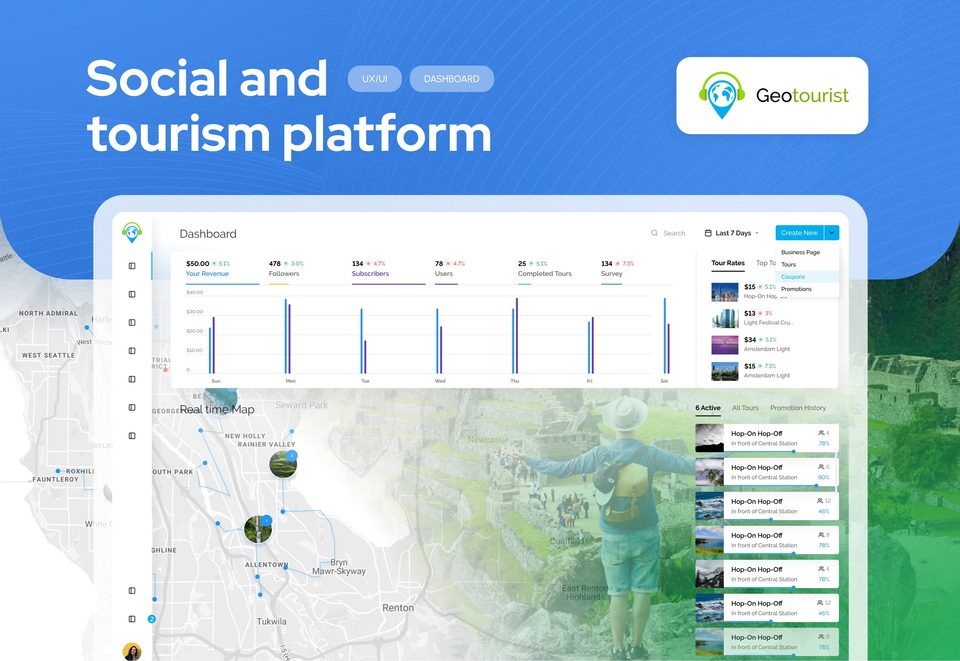
Build in more personization in your travel app design.
Don’t delay needed fixes and UX improvements to your application.
Organizing content and elements sensibly
A creative travel app design doesn’t necessarily have to value aesthetics over the basics. Every travel app UX design should accommodate its user’s sensibility. This means organizing the content within the app into logical groups of information or functionality that can be accessed more quickly and easily than, say by browsing through all available options individually.
To reiterate, ask yourself the most ridiculously obvious question on earth: “why should users download this app when they can simply Google everything?” before determining your app’s value.
Let’s take social media apps for instance. An app like Instagram is now designed to let users find and access eateries in a specific location – some of which are not even listed on Google, perhaps because the people running the place don’t know about Google listings but know about Instagram.
All you must do is type in a keyword or tag and locate the places targeting those tags on the map. This is much faster than scrolling down endlessly through posts or profiles to discover new places. This type of organization also gives people more time to spend on their favorite social network.
In the case of Geotourist, our team utilized familiar icons and intuitive navigation for the app’s users. This eliminated the need for demos or tutorials for using the app because everything was self-explanatory. As a result, tourists were able to download the app and derive immediate value from it.
Balancing the words with numbers in your travel mobile app design
Some of the biggest travel app design problems can be easily resolved. For instance, too many words are bound to confuse you, so we need to balance them using numbers that appeal to your rationale. Moreover, the value perceived in digits is always given more importance than if it is perceived in terms because the former allows you to quantify your returns.
For the Geotourist app, we used the dashboard to show our clients how much value their users were gaining from the app. A dashboard has a collection of information (mainly related to the multiple aspects of the app’s data) that allows users to view and interact with it.
The best way to do this is by using data and analytics. Analytics is used to measure and analyze data from a number of different sources, such as website traffic, app usage, and customer feedback. We organized the data regarding user behavior and engagement on Geotourist into meaningful datasets, allowing our client to see the real-time interaction on the app – from social media interactions to tourist reviews.
The purpose of this was to give the creators of Geotourist detailed insights into their users without making them create charts or reports to make sense of all the data generated by the app. The app automated the analytics for them.
Using the analytics from Geotourist, they can now see what’s working and what isn’t, so they can quickly adjust to keep their customers happy and coming back for more.
Keeping all elements interactive
When designing a travel app dashboard, you are not only responsible for the layout of the pages but you also have to consider how it all works together.
According to the latest transportation app UI/UX design best practices , an effective design can help increase engagement, retention, and conversion rates by increasing perceived value and brand awareness among users. This was evident in the Geotourist app because we religiously stuck to the design fundamentals – one of which was improving the responsiveness of the app.
Everything clicks! Our team designed the user interface of the Geotourist app in such a way that it gave users a lot of room and opportunities for engaging with the app. All of this happened because the high “clickability” encouraged users to explore the app and dig deeper to find out what else they could do with it.
User experience is an unavoidable part of any app. Since user experience heavily relies on the user interface, even a single element can affect your engagement rate. So, it is always wiser to work with a professional travel app design agency to build one for you. Get in touch with our team to discuss your needs.

Marketing Director - Senior Strategist
About Author
Marc caposino.
Marc has over 20 years of senior-level creative experience; developing countless digital products, mobile and Internet applications, marketing and outreach campaigns for numerous public and private agencies across California, Maryland, Virginia, and D.C. In 2017 Marc co-founded Fuselab Creative with the hopes of creating better user experiences online through human-centered design.

UI Design with Machine Learning in Mind
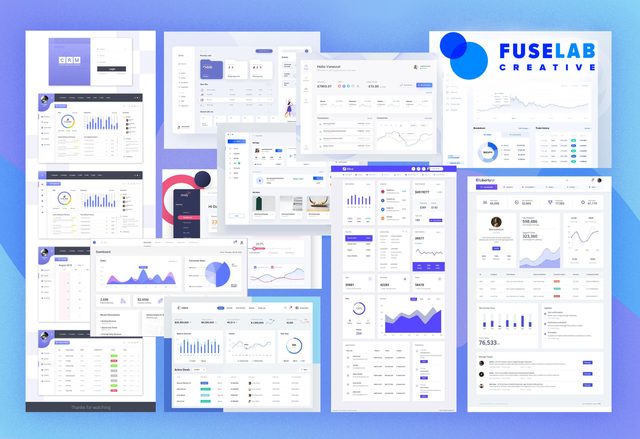
Dashboard Design Inspiration

Transportation App UI/UX Design Best Practices
Travel & Hospitality
Travel app development 101: your starter guide.
Last Updated: December 19, 2023

Table of Content
1. what is travel app development, 2. the market for travel apps today, 3. why travel mobile app development is a big business opportunity, 4. what are the ways travel apps make money, 5. types of travel apps being built today, 6. travel super app vs. dedicated app vs. segment app, 7. core features of travel app development to attract customers, 8. steps of travel app development: how to create a travel app, 9. development costs for a travel app.
Traveling used to be about maps, brochures, and guidebooks. But today, it's about swiping through your smartphone to explore the world. It's all thanks to the travel apps that have transformed the travel industry.
This has compelled several travel and hospitality businesses, like Booking.com, Expedia, and Trivago, to invest in travel app development, facilitate digital bookings, and build a travel solution that caters to travelers’ specific needs.
According to a Statista report, Booking.com recorded 80 million app downloads, while Airbnb had 52 million app downloads in the list of most downloaded travel apps worldwide.
This study explains how travel app development can be a profitable investment for startups and online travel agencies looking to tap into the tourism industry.
If the thought of building a travel app raises a multitude of questions, you're not alone. The journey can indeed seem like a maze, filled with uncertainties, complexities, and endless possibilities.
But worry not, because we're here to guide you through it all with our detailed travel app development guide.
In this guide, you will learn about travel app development, industry stats, monetization, app types, costs, and essential features. And when you're ready to create your custom travel app, Narola Infotech is your partner in success.
Sounds good? Keep on reading.
What is Travel App Development?
Travel app development refers to the process of creating mobile applications or software platforms specifically designed for travelers and tourists. These apps are developed to provide various features and functionalities that enhance the travel experience.
Travel apps can offer services such as booking accommodations, flights, and transportation, providing local recommendations, offering navigation and mapping services, and giving access to travel-related information like weather, language translations, and cultural insights.
Travel app development aims to make travel easier, more convenient, and enjoyable for users by integrating a range of travel-related services into a single, user-friendly application.
The Market for Travel Apps Today
In an era where travel is redefined by technology, the numbers paint a vivid picture of a thriving industry with no signs of slowing down.
- 84% of airlines worldwide expect to try AI technologies in the next three years.
- 26% of travel & hospitality companies worldwide are using chatbots.
- The most downloaded online travel agency app worldwide is booking.com
- 21% of global travelers have used travel agent apps since Covid-19.
- 30% is the average 90-day retention rate of hospitality & tourism apps worldwide
- 44% of candidates surveyed have used voice to search for some part of their trip
- 20% of travelers from the U.S. consider voice search to be a great influencer while traveling.
Although the number of new travel apps may be growing, so will the number of people who are willing to use them.
Why Travel Mobile App Development Is a Big Business Opportunity?
The travel mobile app development sector is a promising business opportunity because of the high demand, user experience benefits, revenue potential, global reach, and the valuable insights it can provide. Let’s understand this in detail.
Massive Market Demand
People love to travel, and they use mobile apps for everything from booking flights and hotels to finding local attractions and restaurants. This huge demand creates a substantial market for travel apps, offering plenty of room for new entrants to grab a piece of the pie.
Enhanced User Experience
Travel apps make the whole travel experience more convenient and enjoyable. With features like real-time flight updates, easy hotel bookings, and local guides, your app can help travelers plan and execute their trips with ease, ensuring happy customers and repeat business.
Monetization Opportunities
Travel apps provide multiple revenue streams. You can earn through booking commissions, in-app advertising, premium content, or even by offering personalized travel recommendations. This flexibility allows you to tailor your revenue model to suit your business goals.
Global Reach
With a travel app, you can tap into a global audience. Travelers come from all over the world, so if your app offers multiple languages and caters to various destinations, you can attract users from different countries, expanding your reach.
Data-Driven Insights
Travel apps can collect valuable data on user preferences, travel trends, and popular destinations. Analyzing this data can help you make informed decisions about app improvements and expansion, ensuring your app remains relevant and competitive.
This tells us, the travel app industry is full of potential, and with the right approach and a focus on user satisfaction, you can start your journey towards success, where every step you take leads upwards to growth and prosperity.
Moving on, let's talk about the most asked question.
What Are The Ways Travel Apps Make Money?

Following are the primary ways to turn your travel apps into powerful revenue sources.
In-App Purchases
Offer premium features or content for a fee within your app. This model suits apps with specialized services like guided tours.
Subscription Model
Charge users a recurring fee for access to exclusive content or benefits. Ideal for apps that continuously provide value, such as premium travel guides.
Affiliate Marketing
Promote products or services, and earn a commission on sales generated through your app.
Booking Commissions
Partner with hotels, airlines, or tour operators and earn a commission for bookings made through your app.
Data Monetization
Collect user data (with consent) and sell it to businesses for market research. Typically best for apps with a large user base
Sponsored Content
Partner with brands or destinations to create sponsored content or travel campaigns. Well-suited for apps with a substantial following and influence.
Types of Travel Apps Being Built Today

Now that you already know why to create a travel app and how travel apps make money, it’s time for real brainstorming and choosing the one unique travel app idea that will not only serve your audience but will also stand out on the market.
But to make your app truly successful, it's about understanding the pain points of your target audience, understanding how each caters to distinct traveler needs and resolves their pain points.
In this section, we'll explore the types of travel apps and shed light on the problems they solve, helping you create an app that resonates with your target audience.
Booking and Accommodation Apps
Pain Point: Booking Hassles
Travelers face the challenge of navigating through numerous websites and platforms to book flights, hotels, and accommodations, often resulting in confusion and time wastage.
App Goal: Booking and Accommodation Apps aim to streamline the booking process, presenting users with a convenient, one-stop platform where they can effortlessly book flights, hotels, vacation rentals, and other accommodations. This helps users save time and reduce the hassles associated with traditional booking methods.

Example: Trivago

Example: Airbnb
Travel Planning & Itinerary Apps
Pain Point: Overwhelm with Trip Planning
Travelers can become overwhelmed when planning trips, trying to organize multiple bookings and activities across various destinations, often leading to stress and disorganization.
App Goal: Travel Planning and Itinerary Apps provide a solution by assisting travelers in creating, organizing, and sharing their trip itineraries. This streamlines the planning process, reduces stress, and helps users efficiently manage their travel plans.

Example: Tripadvisor

Example: Kayak
Navigation & Transportation Apps
Pain Point: Navigation Challenges
Finding your way in unfamiliar places, accessing transportation schedules, and booking tickets can be a significant challenge for travelers, leading to delays and frustration.
App Goal: Navigation and Transportation Apps strive to ease navigation by offering real-time updates, transportation schedules, and ticket booking services for various modes of travel. The goal is to reduce travel time, enhance convenience, and provide travelers with the guidance they need.

Example: Google Maps

Example: Moovit
Local Discovery & Guide Apps
Pain Point: Difficulty in Local Exploration
Travelers often struggle to find the best local attractions, restaurants, and cultural experiences, missing out on the richness of their destination.
App Goal: Local Discovery and Guides Apps address this challenge by providing mobile guided tours, which provide personalized recommendations and insights, helping travelers explore local culture and attractions, and making their travel experience more enriching.

Example : GettinLocal
Infact, we've developed a local discovery app for one of our clients that's packed with the features they desired, and they absolutely love it. View Case Study
Language Translation & Communication Apps
Pain Point: Language Barriers
Language differences can hinder communication with locals, causing misunderstandings and challenges in foreign countries.
App Goal: Language Translation and Communication Apps aim to bridge these barriers by offering translation tools and communication features that help travelers communicate effectively, reducing language-related hurdles.

Example: Google Translate

Example: DeepL Translate
Travel super app vs. Dedicated app vs. Segment app
Let's now talk about the three distinct categories of travel apps: Travel Super Apps, Dedicated Apps, and Segment Apps.
Travel Super App
The Travel Super App is like an All-in-One Travel Companion for travelers. It combines a multitude of services under one roof, from booking flights and hotels to offering local guides, translation tools, and more. It's a one-stop shop for all your travel needs.
One big example of a Travel Super App is Goibibo .
Dedicated App
Dedicated Apps are specialists in their niche. They concentrate on a single aspect of travel, such as hotel bookings, flight reservations, or local experiences. These apps aim for excellence in their specialized area.
One big example of a dedicated app is Agoda .
Segment App
Segment Apps strike a balance by focusing on a specific travel segment, such as business travel, adventure travel, or luxury travel. They offer a combination of specialized features within a defined category.
One big example of a segment app is Nomadlist App .
Core Features of Travel App Development to Attract Customers
Basic features.
- Personalized Itineraries: Creating and managing travel plans, ensuring organized and stress-free trips.
- In-App Navigation: Real-time maps and directions, guiding users during travel within unfamiliar areas.
- Local Recommendations: Providing insights on local attractions, restaurants, and activities for an enriched experience.
- Translation Tools: Bridging language barriers with translation and communication features for seamless interactions.
- Weather Updates: Offering reliable weather forecasts for better packing and activity planning.
- Community Interaction: Allowing travelers to share experiences and gain insights from fellow explorers.
Advance Features
- Voice Recognition and Assistance : Implement voice-activated features for hands-free travel planning and navigation, making it easier for users on the go.
- Augmented Reality (AR) Travel Guides : Incorporate AR to provide users with interactive, real-time information about their surroundings, historical sites, and points of interest.
- Budget Tracking: Helping users manage expenses and stay within their financial plans while traveling.
- Gamification : Offering games, streaming content, and interactive features to alleviate travel boredom.
- Integration with Fitness Tracking Device: Incorporate the ability to sync with users' fitness trackers and wearables to encourage healthy travel. With the expertise of a professional travel app development company , you have the flexibility to customize your travel app with as many features as you desire, creating a tailor-made experience for your users.
Steps of Travel App Development: How to Create a Travel App?

Planning and Strategy
Start by brainstorming creative travel app ideas that address specific traveler pain points or needs. Explore and learn about the potential features related to booking, itinerary planning, navigation, or local recommendations.
Define a clear plan for your app. What are your goals? Who is your target audience? How will your app stand out? Determine what features your app will offer and create a strategy to achieve your objectives.
Design and Prototyping
This step in your travel app development process is the key to safeguarding your travel app's future.
Create the visual design of your app, including its layout, colors, and user interface. Develop prototypes or mockups to see how the app will function and look. This step helps in visualizing the user experience.
Development
The travel app development phase involves building the actual app. This includes coding, programming, and creating the technical infrastructure.
Ensure that your app works smoothly on various platforms and devices, such as iOS and Android, which is where the expertise of a travel app development company becomes invaluable.
Rigorously test your app for any bugs or issues. Check its performance, usability, and user experience. Make necessary improvements based on the testing results to ensure a high-quality app.
Testing during the development phase is critical to identify and rectify issues early, ensuring a more reliable and user-friendly app, and ultimately saving time and resources in the long run.
Release your app to the public. This step involves making it available for download or access through app stores and websites. Promote your travel & hospitality app to reach your target audience, using various marketing and promotional strategies.
Often overlooked is the importance of post-launch monitoring and ongoing support to address user concerns, improve app performance, and adapt to changing market trends, ensuring your app's long-term success.
User Feedback
Keep an ear to the ground – what your users say really matters. Use their comments and reviews to make your app better by fixing problems and adding the things they ask for. It's like tailoring your app to fit their needs, which keeps them happy and your app thriving.
Monetization Strategy
We've already covered this in the above sections. Decide how your app will make money. This could involve in-app advertising, in-app purchases, subscriptions, affiliate marketing, or other revenue models. Choose the revenue model that aligns with your app's value and user base.
Marketing and Growth
Continuously market your app to attract more users. Use a variety of marketing strategies, including social media, search engine optimization, and partnerships with influencers or travel-related websites. Aim to expand your user base over time.
Remember to keep an eye on what's working and what's not through analytics and what your users tell you. This way, you can make sure your app keeps growing strong. Travel portal development is also on the rise, making it a strong addition to your strategy for comprehensive travel coverage.
Maintenance
Regularly update and maintain your app. This includes fixing any bugs or issues that arise, adding new features, and keeping the app compatible with the latest operating systems and devices.
Invest in support and maintenance services to ensure a seamless user experience and keep users engaged. Plus, it shows that you're committed to delivering the best possible service to your users, building trust and loyalty.

Development Costs for a Travel App
After all the information you've gathered, you're probably curious about one big thing: How much does it cost to create a travel app ? Well, the answer isn't one-size-fits-all.
The cost depends on various factors, and different types of apps come with different price tags. So, let's explore what determines the cost of travel app development.
As you know, these factors cannot be the same for two projects, therefore providing the estimation of the cost is not feasible. You can schedule a consultation with us, share your requirements, and we will provide you with the cost estimation.
Conclusions? Don’t build another simple solution. Get creative but keep in mind your target audience and their needs.
When seeking inspiration for your travel app idea, it's wise to study your competitors. The fact that they've garnered a significant user base suggests they're doing something right. Simultaneously, identifying flaws in their apps can serve as valuable guidance, motivating you to develop a more competitive travel and hospitality solution that truly caters to user needs.
Want to partner with us?
With 18+ years of experience and 3000+ projects delivered, our team turns your ideas into solutions. Let's talk about your project.
Frequently Asked Questions (FAQ)
See the answers to some of our most commonly asked questions below., how much does it cost to develop a travel app, what are the benefits of integrating ai or machine learning into a travel app, what types of travel apps are there, and which one should i choose to develop, how can i monetize my travel app, launch your dream now, join the force of 1500+ satisfied narola client globally, get notified.
Subscribe & get notified for latest blogs & updates.

The goal setting mentor
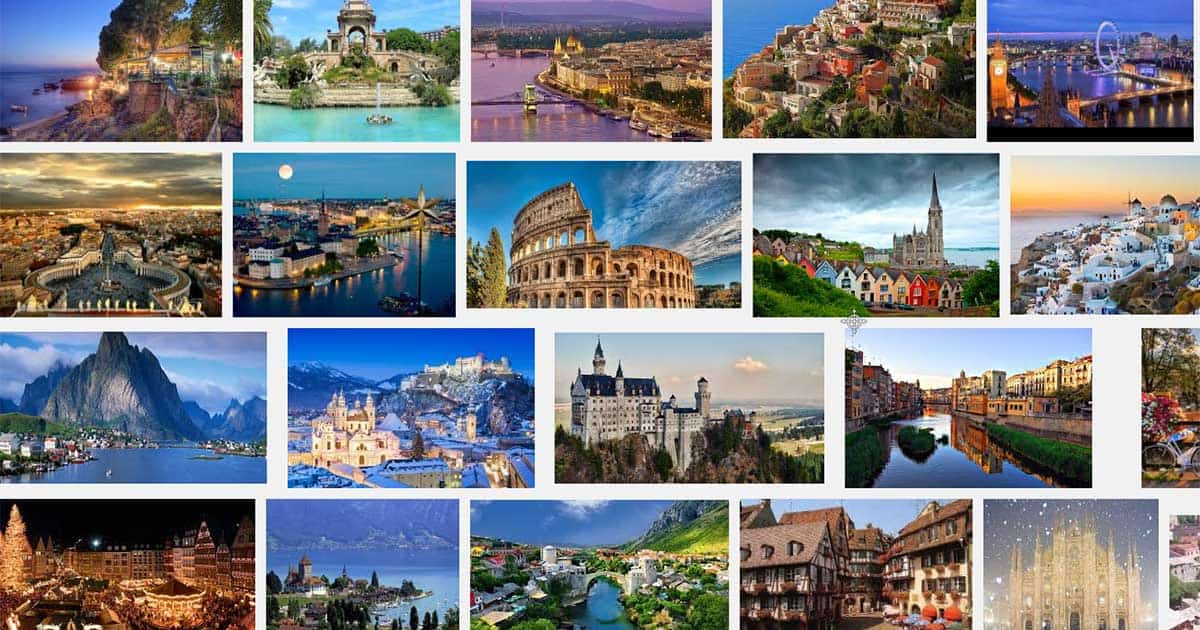
Travel goals: the simple 4 step method for achieving them. Plus 32 examples.
Travel goals are different than all other types of goals. They require a different system for setting and achieving them.
I love to travel, but if I don’t set travel goals I always end up on my couch at home.
So here is a simple system for setting travel goals which can help you visit the places you always dreamed of visiting.
The nice thing is that at this stage, you don’t have to worry if you have enough money or time. You just enjoy the enthusiasm of knowing that one day you will go there.
Here are the steps (warning: they are kinda fun)
Step1: Create a travel goals wishlist
First, you would like to create a wishlist . It’s like a list of your dream places to visit.
This is very similar to a “someday-maybe” places to visit list. You don’t have to set deadlines or make SMART travel goals (yet).
You just set an intention to visit this place someday.
You can constantly “refill” your travel goals wishlist when you encounter a place you may want to visit.
If you don’t have a wishlist, brainstorm based on continents. Think about travel goals for Europe, Asia, Africa, North America, South America, etc.
Then record the list in your favorite note taking app (like Evernote or OneNote) or in your Moleskine notebook.
2. Create a vision board for all places. This is how you do it with your computer
What the mind can conceive, it can achieve. So, you need to “feed your mind” with the images of the places you want to visit.
If you like the old fashion way, you just print out the places you want to visit, cut them and put them on a large sheet of paper.
To find images, you just search for the place in Google Images:
If you want to get only high-quality images, click on “Search tools” and choose Large size images.
Here is how you can create a digital travel goals vision board.
Second, set up a slideshow for this folder. Here is how you do it with Windows 10. Every OS has similar settings, no matter if it’s a Mac or Linux.
Third, when you happen to find a great picture, just put it in the folder. It will start to show automatically on your desktop.
Step 3: Create a separate bank account and put 3% of your income in your new travel goals account
There is a famous money managing system by Harv Eker, which is called “money jars system”.
The idea is to set a “jar” or nowadays a bank account 🙂 and put a certain amount there after you get paid.
It follows the rule “pay myself first” and you don’t wait until some money is left. You have to put money aside when you are paid (e.g. get salary) and live with the rest.
So, decide how much money you are going to set aside – it may be 1%, 3%, up to 10%. But you have to put this money in your bank account each month regularly no matter what.
It will seem like magic , but after just a few months or perhaps a year you will have a bank account with money for dream holidays you never dreamed you could afford to visit.
In this regard, don’t let your limiting beliefs stop you from traveling
The biggest obstacle from achieving the dream life you desire is … You!
We all have some limiting beliefs. I hope you are at least not in denial and say “I don’t have limiting beliefs”.
I’ve heard it all: I don’t have the time. I don’t have the money. I can’t travel with kids. I have someone I have to take care of and can’t leave them…
These are all excuses and I just showed you how to eliminate the biggest one – money. Deal with all of them in the same manner.
Step 4: Review your travel goals wishlist during the yearly goal setting process
No matter if you use the “Goal buddy” goal setting system or not, if you regularly set goals, you would have something like a “yearly goals review”.
Take out your wishlist and consider choosing one of the travel goals as a goal you would like to achieve during the next year.
You would need to make this goal a SMART goal. It’s not anymore a wish, it’s more concrete now.
Create projects that can help you achieve these goals
Break down the goal in detailed projects with exact action steps.
Here are just a few examples:
- Research time to visit / local places to visit
- Research and book hotels
- Research and buy tickets for travel
- Trip preparation
That’s it. Repeat year after year and check off your travel goals wishlist
By just doing this each year, step by step you can visit all the places you want to visit.
Need an example? Here is my list of 32 travel goals
I know people love examples, that’s why I will share my travel goals wishlist. Remember, this is my list. It will be completely different than yours.
Visit the “Lost City of the Incas” aka Machu Picchu
I don’t know why, but I am so attracted to this place. I have no idea why I want to visit Machu Picchu, but this one is on top of my list.
I am not a huge Gloria Estefan fan, but I often watch this video, because it has great pictures from Machu Pichu.
Explore Singapore and Thailand – accomplished
This one is accomplished. Me, my wife and two friends spent two weeks in Singapore, Phuket and Bangkok. It was amazing – very different culture.
Climb the highest building in the world – Burj al Arab in Dubai -accomplished
My education is in civil engineering and I am always interested in high buildings. What about the highest building in the world?
Here is a picture I took from the top of Burj al Arab in Dubai.
Visit the most beautiful beach in Greece – Porto Katsiki in Lefkada
Ok, I still can’t agree that someone will just label a single beach in Greece to be the “most beautiful”. There are so many great beaches in Greece.
But this beach in Lefkada is for sure one of the best beaches in Greece. I was there because my goal buddy Nikolay “forced” me to visit the beautiful island of Lefkada and I am happy he did.
Visit China
Great culture, great places to visit. Someday I will go there.
Thasos, Greece – accomplished
Maybe not on top of everybody’s list, but because of the location, which is near to where I live, I could visit this place.
Early in the mornings, while the kids were sleeping, my wife and I traveled around the island. Here’s a picture I took one morning.
Visit Madame Tussauds in London with my son – accomplished
I had a business trip to London and took my son with me to have what we call “dad & son time”.
He was just so impressed. This time together was priceless.
Explore Cappadocia by … balloon
Another very interesting place to visit.
Visit the beaches of Chalkidiki, Greece – accomplished
I love Chalkidiki. It has amazing beaches and very nice weather. I go there almost every year and can’t get enough of it.
It’s more or less a “recurring goal” for me…
Saint Petersburg
This is perhaps the most beautiful city in Russia. I will be there one day.
Snorkeling in Egypt – accomplished
I am not attracted to the pyramids, but the underwater beauty of Red sea is incomparable. I have visited Egypt 3 times and would like to go back again.
A lot of friends told me that Berlin is great. I will have to check it out.
Holiday in Antalya – accomplished
Just like Egypt, Antalya in Turkey is great for holidays. I was there and I had the feeling I was in paradise.
San Francisco
Looks like a place I want to visit someday.
Visit Paris – accomplished
Explore rome – accomplished.
Great city, amazing food. Here is a picture I took outside of St Peter’s Basilica.
I want to visit this place.
Prague at Christmas time – accomplished
I felt as if I was in a fairy tale. Prague, especially at Christmas time was great. The atmosphere is unbelievable.
Check out the city that never sleeps, New York
I’ve heard, listened to and read so much about this place, It would be a shame if it’s not on my list.
Istanbul – accomplished
The city is spread over two continents. It’s partially in Europe, partially in Asia.
It was a strange mix of cultures there.
Maybe not so far in the future…
I am somehow attracted to this place and I would like to explore it more.
Vienna at Christmas time
After promoting Prague at Christmas time to so many people, some of them recommended Vienna. It should be also great during this time of the year.
Italy is warm and their food and wine are great. Time to check out Venice.
Visit the Cologne cathedral – accomplished
Disney land.
Looks perfect for a family holiday. I still haven’t been there.
Gaudi’s work in Barcelona
Immediately after I visited Cologne, I knew one day I will visit Barcelona. I wanted to check the work of Gaudi.
It’s a city that one could easily fall in love with.
I love the beaches and the sea. Someday I have to check one of the most famous places on earth in this regard.
Beer fest at Munich – accomplished
Wow – what and experience. I am sorry I can’t find my pictures from it…
Walk trough Budapest
After visiting Prague, I wanted to visit similar cities and Budapest seems like a good choice.
Sicily, Italy
Looks like an interesting destination.
A friend recommended me this place and it looks enough exotic to be on my list.
Do you like this method?
Share it on Facebook, so more people can learn about it.
Subscribe to our Newsletter!
Get free updates and goal setting tips.
- ← Are you wasting your time not launching your ideas?
- 10 tips how to free your mind and be successful →
One thought on “ Travel goals: the simple 4 step method for achieving them. Plus 32 examples. ”
The Burj Khalfia, not the small ‘older’ hotel on the beach as Burj Al Arab. He says looking at the tall one whilst reading your stuff. Nice by the way, keep going. : )))))
Leave a Reply Cancel reply
Your email address will not be published. Required fields are marked *
This site uses Akismet to reduce spam. Learn how your comment data is processed .

Hey! Sign up for our newsletter and get The FREE Goal Setting Guide
We will send the PDF directly to your email inbox.
That Traveling Chick: Female Travel Blogger
Join our Travel Tidbits E-News
And get a FREE Travel Packing Checklist
Let’s Get Social
Achieving travel goals.
March 17, 2022 by Joslyn 26 Comments

Does the idea of planning travel have your head spinning. Read on to find out how to achieve your travel goals no matter how big or small. Maybe a staycation, or a road trip a couple states away. How about a cruise or a beach vacation ? Maybe a flight around the world? Whatever it may be you want to do, there is always a way to do it.
Let me show you it CAN still be possible to explore safely and affordably. And there are so many new online tools and resources to help you navigate the next era of tourism.
Disclosure – This post contains affiliate links that generate commission when clicked at no cost to you.
1. Set flexible and achievable travel goals
Did you know you are 42% more likely to achieve your goals by writing them down? This process can help you get clear on exactly what you want to accomplish and how to make it happen. Start by writing down a list of the destinations you are dreaming about in the travel goals section of the Budget Travel Starter Kit .
Consider your travel style and how long you would want to spend there e.g. one-week vacation in Mexico or a 6-month RV trip across the US? Calculate the approximate amount required for each trip and add it to the “amount needed” column.
Before completing the target date, research current travel restrictions and visa requirements (if you’re hoping to go abroad). For visas, Passport Index will provide an overview but ultimately check and apply directly with that country’s immigration
You can use this information to choose one realistic trip and target date based on your current income and circumstances (travel restrictions, vacation time, visas, distance, cost of flights, etc). It doesn’t mean you won’t eventually get to visit all your bucket list places but for now, focus on the most realistic travel goal.
2. Visualize your goal and the potential obstacles
Positive thinking can actually improve life satisfaction and outcomes according to scientific research . Here are activities to visualize your goals and reinforce your optimistic mindset.
- Create a vision or Pinterest board with images for your dream destination
- Update the wallpaper on your phone and computer with a picture from that place
- Read books and blogs about your dream destination to keep you motivated with saving
- Start saying ‘I’m going to…’ (your dream destination) rather than ‘I want to go’. This will build confidence it’s actually going to happen.
Once you’ve visualized yourself achieving your travel goals, it’s also important to consider what could get in the way. It may sound counterintuitive but NYU psychology professor, Gabriele Oettingen, says understanding the potential obstacles will help you find a way to adapt, reschedule, or move onto another goal.
The WOOP website provides a simple and free way to identify your inner obstacle and plan to overcome it. For example, this could be a plan to request holiday leave from your job, considering how much time off you have available and how much notice you need to give.
3. Create a budget to achieve your travel goal
Money is always a key factor in stopping people from traveling more. If money is an issue for you, there are two ways to beat it – decrease your costs and/or increase your income .
Either path that you choose, it’s still worthwhile to know exactly how much money you have first. Use the budget section of the Budget Travel Starter Kit to write all your incoming payments and outgoing expenses. If you’re not sure where all your money is going, try tracking your expenses for a week on a free app like Trabee Pocket.
Review your expenses and identify unnecessary costs you could cut back on (e.g. eating out, espresso coffee, beauty treatments, etc.) Ultimately, it’s your decision what you are willing to trade for the opportunity to fulfill your wanderlust.
Here are a couple tips to try:
- The 50/30/20 Financial Guideline by using 50% of income for mandatory expenses, 30% on optional expenses, and 20% on savings or paying down debt
- Reverse budgeting where you put money towards your goals first before your living expenses.
4. Set targets to pay off debt and save money to travel
We believe in financially-responsible travel, which means paying off high-interest debts (like credit cards) and creating an emergency fund before saving for a trip. It’s always a good idea to keep $1,000 or more aside for unexpected costs e.g. car repairs.
Looking at the expenses listed in your budget and the amount needed for your trip, calculate how long it will take after paying off debt and creating an emergency fund. Also, consider opening a flexible, interest-earning account that won’t lock you in for a long period.
- Checking account: for receiving income and making daily purchases
- Savings account: where I transfer the amount I want to save each month and keep my emergency funds
- Term deposit: interest-earning account for funds I won’t need to access for 3+ months.
Set target dates for each milestone e.g. pay off your credit card by the end of March, save $2,000 by mid-June, etc. It’s better to aim higher than lower – push yourself to reach your goals but don’t be too hard on yourself if you don’t make it each month. Schedule reminders in your calendar for when to make repayments, cancel direct debits, put money aside for the trip, and review your progress (e.g. monthly).
5. Consider how you can make extra income
If you can’t possibly decrease your expenses, then the other option is to consider how you can make more money – whether it’s a paid promotion, higher-paying job, or lucrative side hustle. Or you can reduce both your living costs and increase your income. I have multiple income streams with my blogging, VA services and selling misc items like clothing and unused household stuff online.
6. Review your progress and adjust your targets
Each month review your progress against the budget, goals, and target dates in the Budget Travel Starter Kit. If you come in short in some areas, consider whether you need to adjust your budget and then review next month. Repeat this process until you pay off high-interest debt, store away an emergency fund, and have the amount needed.
Designing – researching and trip planning for your travel goals
1. create a travel plan.
Whether you prefer to wing it or plan carefully, you can use the Budget Travel Starter Kit to record an outline of dates and important information. Travellerspoint is another free tool that allows you to build visual itineraries and maps – perfect for backpacking and road trips. Share it with travel buddies to add ideas and keep updating it as plans become more concrete.
2. Compare hotels and airlines for safety and cost
Planning a budget-friendly trip with cheap flights and accommodation has always been a challenge. Now we also have to worry about staying as safe as possible and adhering to all regulations. The Safe Travel Barometer can help make this easier by comparing safety protocols for travel companies like hotels, airlines, and airports.
Plus, we’ve put together two in-depth guides for you:
- What you need to know if you’re flying soon : 9 tips for safety and sanity
- 5 smart ways to find cheap accommodation (and travel safely)
3. Organize visas, medication, and travel insurance
By now, you’re probably already familiar with the visa and quarantine requirements (if any) of the place that you are visiting. However, it’s also worthwhile to check for any compulsory immunizations. If you take medication, make sure it can be taken into that country and whether you need a prescription to purchase more.
Travel insurance is more important than ever before. When making bookings with a credit card, see if it includes any type of insurance. If it doesn’t provide sufficient coverage, look for a travel insurance company that covers COVID-19 like SafetyWing .
4. Consider how you will access data and your funds abroad
Research your destination to see if WiFi will be available in public places and the cost for a local sim card. Whenever I travel to a new country, I purchase a sim card as soon as I arrive and this has been the cheapest and most convenient option. A quick Google search will reveal which is the best option in terms of connectivity and price.
Your existing phone company may provide international data access as part of your plan or for an extra cost. Read the terms and conditions to make sure you don’t exceed the limitations and end up with a nasty bill. And if you have a regular data plan – keep data roaming switched OFF as it can be crazy expensive!
In my experience the most cost-effective options for accessing cash abroad are:
- Withdrawing from an ATM
- Exchanging cash
Contact your banks to check if they have any partner banks in that country. For example, international banks like Citibank or HSBC have ATMs all around the world. If not, find out what the fees will be for withdrawing AND converting cash (some banks charge both). Weigh this up against the risks of carrying cash and exchanging money.
Personally, I use a Transferwise Borderless account and Mastercard debit card which lets me:
- Receive, hold, and withdraw cash in multiple currencies at rates much lower than traditional banks
- Freeze and unfreeze my card through an app on my phone, preventing unauthorized charges
- See a summary of transactions for each currency and overall.
Departing – getting organized and packing
1. choose your carry-on bag.
No matter what kind of trip you are taking, I guarantee you’ll only need 7-10 days’ worth of clothing. That’s because you can wash your clothes and mix-and-match pieces to keep them fresh. Unless you’re embarking on a cross-seasonal journey and I’ve had friends who’ve still achieved that with a carry-on.
Switching to a carry-on bag can make your trip cheaper and more comfortable by avoiding:
- Unnecessary weight to drag around
- Checked luggage fees
- Wait times at the luggage carousel
- Risk of your bag being lost or damaged by the airline
- Friends and family asking you to bring giant souvenirs home.
2. Purchase must-have travel accessories only
Keep your bag light by only purchasing the travel accessories that you actually need such as a travel scarf/sarong and wallet with a chain that attaches to your bag. Don’t forget your hygiene kit with essentials that can help you reduce your risk of getting sick or spreading it to others.
- Breathable, washable masks with two or more layers
- Hand sanitizer with at least 60% alcohol
- BPA-free water bottle for personal use
- Food storage containers and reusable ziplock bags
- Contactless credit or debit card .
If you are planning to clean your accommodation, see the CDC’s guidance on how to clean and disinfect (or refer to the advice from your local government advisory).

3. Make copies of all your travel documents
Set up electronic access to all your copies of important documents such as:
- Insurance certificate
- Visa approval
- Bank statement with available funds and account name.
Thanks to technology, you can easily share these with your family as well either by email, Dropbox, or Google Drive. However, as WiFi isn’t always a given – download to your phone and/or make physical copies to have on hand at immigration or in case of emergency.
4. Pack and then pack again with less
Use the packing list section of the Budget Travel Starter Kit to organize what you need to take. Before going on your trip, make a trial-run of packing your bag to make sure everything fits comfortably then remove anything unnecessary.
Doing it – traveling and keeping costs low
Congratulations! You made it. You are living out your travel dreams. Now the focus is on enjoying the adventure – without making any expensive mistakes. I recommend setting a daily budget and keeping track of your expenses on a free travel app like Trabee Pocket.
I’ve also included a few resources below to help keep your trip affordable, responsible, and sustainable.
- 15 ways to make friends while traveling without feeling awkward as f#ck
- 10 truths about backpacking in your 30s (and beyond) as a woman
- 12 smart ideas to save money on food while traveling and at home
- How to choose ethical animal tourism experiences .
Be sure to come back when you’re ready to start thinking about your next travel goal.
Originally written in 2017 and updated in 2021.
What are your travel goals? Tell us about it below!
And if you liked the post – share it with your friends on social media.
About Joslyn
Female Travel Blogger Sharing Travel Tips, Work and Travel Tips, Budget Travel Tips and general daily life from a travel chicks point of view!
Reader Interactions
Ania | Snow to Seas says
July 30, 2017 at 12:55 am
Really helpful and thorough post for anyone wanting their travel dreams to become a reality! There are so many valuable tips in here, like getting insurance, making sure you have access to your funds, and packing and repacking less (I am guilty of constantly overpacking). Thank you for putting this together!
Chantell Collins says
August 3, 2017 at 3:08 pm
Thanks Ania! That is such a lovely comment. I am passionate about helping other people to make their travel dreams a reality and love hearing that this information is helpful 🙂
Cheryll Young says
April 22, 2020 at 6:45 am
I have traveled a lot and could probably write a book on budget travel but I have trouble locating friends who are willing to stay in hostels or travel for months at a time. I’m 72 and still on the Go. I find your info accurate and encouraging for those who only dream about travel….thank you.
April 22, 2020 at 2:55 pm
Thank you, Cheryll! I know exactly what you mean about finding friends to travel with. That’s why I encourage dreamers not to wait for their friends and create step-by-step guides to help them travel more confidently. Your story is very inspiring – thank you for sharing 🙂
July 30, 2017 at 6:17 pm
Thank you for putting this together and keeping several types of travelers in mind. This is super useful and I’ll be sharing it with friends who don’t know how to set travel goals. 🙂
July 30, 2017 at 11:02 pm
Thanks Alex! I really wanted to write something useful that tied all aspects together but was easy to follow. I put a lot of my energy and knowledge from experience into this. Thank you so much for sharing!
Anne Slater-Brooks says
July 31, 2017 at 12:27 pm
Wow this is a really comprehensive resource for those wanting to travel who are on a budget. Thanks for sharing.
August 1, 2017 at 4:34 pm
Thanks Anne! I don’t think I realised how much I had to say until I started writing ha ha.
July 31, 2017 at 4:29 pm
This is really helpful Chantell! Excelent guide for anyone planning a trip
August 1, 2017 at 4:32 pm
Thanks Ivana! So happy to hear that you enjoyed it!
Patricia says
July 31, 2017 at 8:13 pm
These are super helpful tips! I particularly like the breakdowns on budgeting for the dream trip. Right now, we are pretty strapped for cash, so we are focusing on closer trips that we can handle, but it’s good plan for a bigger trip down the road. Travel insurance has become a very important aspect of longer travel — something that didn’t really seem to exist when I was a twenty-something backpacking in Europe. Now, it does seem like there are good options. I also hadn’t thought about registering my destination, but these days that looks like an excellent plan. Also, good to know about Citibank and fund access!
Thanks Patricia. I am so happy that you found some helpful tips in here. I understand the feeling of being strapped for cash, which is why I am always looking for ways to save money before and during my travels (and of course, sharing them on here!).
Sandy N Vyjay says
August 1, 2017 at 7:03 am
A very systematic and comprehensive approach to traveling. This becomes very important, especially when traveling with family and kids. Planning ensures that you have a smooth experience. The post points the direction towards the conversion of travel dreams to reality.
August 1, 2017 at 4:30 pm
Thanks Sandy and Vyjay! That’s definitely what I was aiming for – a step-by-step approach for those who are struggling to know where to start or for those who want to travel more. Thanks for the lovely comment :).
Laura Nalin says
August 1, 2017 at 4:52 am
These are all really great goals! I definitely think these tips are all doable. I definitely follow most of the suggestions you’ve provided – certainly the extra copies of my documents in Dropbox. I’m a bit confused about your brother’s experience with his debit card, though. I live in Vietnam and have had zero issues with my debit card while living here, as well as the three other times I’d visited prior. I do love that there are lots of ANZ ATMs around as you can take the most money out via those. How odd that his card didn’t work!
August 1, 2017 at 4:31 pm
Thanks Laura! It was a few years ago and he had a Suncorp debit card – which at the time could only be used in Australia. I am sure they have updated that now but still always better to check :).
Danielle Desir says
August 1, 2017 at 1:55 pm
A few years ago when I first started traveling I planned every detail out but now my style is more of a blend. I always book flights and lodging way in advance but it’s only a few weeks before a trip that I start planning an itinerary and things to do. A lot of it is trial and error to you find the right mix!
August 1, 2017 at 4:29 pm
Hey Danielle! I so agree. There have been many times where I have planned and booked ahead only to change my travel plans while on the road. That’s when I started using Booking.com because with many hotels and hostels you can get free cancellation. I have also been victim of not planning ahead and missing out on good deals or activities because they are booked up. Definitely is a balance somewhere in the middle 🙂
August 4, 2017 at 3:48 am
Great tips! Especially for non-experience travellers. Thanks for sharing <3
August 6, 2017 at 2:38 am
Thanks Sandy! I appreciate it 🙂
Jill at Reading the Book Travel says
November 10, 2018 at 6:53 pm
This is a really great, comprehensive guide to planning a trip which I’m sure will be very reassuring for newbie travellers. Your advice is spot-on!
November 11, 2018 at 5:32 am
Thanks Jill! I really appreciate your comment and feedback. I think it is a great guide to help people tick off their bucket list on a budget.
Nam Nguyen says
March 4, 2019 at 10:55 pm
Great stuff Chantell! Many thanks for sharing this information
March 4, 2019 at 11:52 pm
You are welcome Nam! Thanks for all your help with our visa applications 🙂
Daniella Chase says
June 3, 2019 at 5:42 am
Thank you, Chantell. I’m from Guyana, South America and I plan on backpacking my way around the continent a bit. I have backpacked outside my country before and I still find a lot of this information useful. I look forward to my trip and putting these tips to good use!
June 3, 2019 at 3:07 pm
Hey Daniella! Thanks for the feedback – knowing this information is helpful to you really makes my day! I hope you’ll join us in the Budget Travel Babes community where you can connect with lots of other female travelers and get more real-life budget advice. https://www.facebook.com/groups/budgettravelbabes/
Leave a Reply Cancel reply
Your email address will not be published. Required fields are marked *
Save my name, email, and website in this browser for the next time I comment.
Helping women all over the world learn about travel, earning money to travel and while traveling.
Join the Facebook group of over 19k women travelers and wanna-be travelers.

This website contains affiliate links. If you buy through them, we receive a small commission at no extra cost to you. As an Amazon Associate, I earn from qualifying purchases.
Privacy Policy and Disclosure
thattravelingchick
🌺 For the Wanderlust in Everyone ✈️ Travel Tips & Tricks 📍 Currently in: Michigan ✋🏼🇺🇸


- Services Custom Web Development Custom Mobile Development Application Maintenance Application Modernization Quality Assurance Custom API Development DevOps Services SaaS Development Data Processing Cross-Platform App IT Security Services Cloud Application Development Chatbot Development MVP Development
- Industries Logistics & Transportations Banking & Finance eCommerce & Retail E-learning & Education Travel & Hospitality Legal Healthcare Food & Beverage Agriculture Real Estate Sports Event Management Oil & Gas Insurance Construction Aviation Supply Chain Management Telecom Manufacturing Payment Processing Lending
- On-demand Developers Python Django Full-Stack React JS PHP Symfony Vue JS Angular JS iOS Swift Android Kotlin DevOps Flask Laravel Yii Zend
- Digital Marketing
- Case Studies
- On-demand Developers
- Custom Web Development
- Custom Mobile Development
- Application Maintenance
- Application Modernization
- Quality Assurance
- Custom API Development
- DevOps Services
- SaaS Development
- Data Processing
- Cross-Platform App
- IT Security Services
- Cloud Application Development
- Chatbot Development
- MVP Development
- Logistics & Transportations
- Banking & Finance
- eCommerce & Retail
- E-learning & Education
- Travel & Hospitality
- Food & Beverage
- Agriculture
- Real Estate
- Event Management
- Oil & Gas
- Construction
- Supply Chain Management
- Manufacturing
- Payment Processing
How to Build a Travel App

Companies with a mobile app for travelers are getting around 60% of orders via mobile devices. If you still haven’t, it is the right time to make your own travel app to follow this vital customer behavior pattern. Through the drastic decrease of demand for travel services, 2021 revealed a heavy uprise in all categories. Find out how to create a mobile app for travel with minimum investment and maximum outcome.
Travel Application Market Overview 2021
The travel industry is one of the most seriously affected by the COVID-19 pandemic. However, over the last year, travel companies have adapted to the current conditions.
Digitization, new approaches in arranging travel, and growing interest in local tourism partially compensated for the physical limitations. And people began traveling again. Sensor Tower Travel Apps 2021 report shows a significant increase in travel app downloads among U.S. users:

In Q2 2021, travel apps reached 85 million downloads, a 128% increase compared to Q2 2020. The chart above also shows a clear upward trend suggesting the demand will continue growing.
If you’ve decided to develop a travel app of your own, it would be helpful to review the top applications in the travel category over the last two years:

As you see, most of the leaders remain the same, yet their positions have changed in the list. KAYAK and Hotwire knocked off HotelTonight and Trivago.
Most of the app downloads belong to two top travel companies: Booking Holdings and Expedia Group. Yet, the leadership in 2021 belongs to the Hopper app, which doesn’t belong to any of these holdings.
The travel app market is actively evolving. So even if you are not targeting a leading position among the top players, developing a mobile application will be a big step to meet your customers’ expectations.
Would you like to outsource your travel app development? KeyUA is ready to help.
Why Do You Need To Build a Travel App?
Statista reports that online sales generate 65% of global revenue from travel and tourism. The recent research conducted by Expedia Group shows that now, more than ever, travelers are ready to try new experiences. In addition, 48% of customers are open to making bookings through companies they have never used before.
Imagine the opportunities for startups and young companies if almost half of the target audience is ready to test new providers. But, of course, it is not the only reason for travel application development. Other advantages include:
- Instant access to your products services: customers can purchase them 24/7 with no limitations to business hours, your office location, and travel agents’ availability.
- Pleasant user experience : apps are comfortable to research and plan trips, book tickets, find reviews, post feedback, etc. GPS, camera, and other smartphone hardware make it more handy and fun to do different travel-related things.
- Brand recognition : with a mobile app, you’re always close to your customer, right in their pocket. Using the app on the go, in transport, at work, anywhere, and anytime significantly increases brand recognition.
- Powerful marketing capabilities : a mobile app gives additional customer engagement and retention (push notifications, personalization, etc.).
- Analytics : mobile apps collect detailed info about every user. It helps understand your customer portrait and develop your brand and business according to the data-proven findings.
- Cost-effective customer care : in the app, users can do many things that previously required personal human assistance. This way, a company can significantly reduce costs for servicing its customers.
- Less paperwork : customer service and order processing automation allow the companies to go paperless. There is no need to print numerous travel brochures, invoices, and other documents.
Creating a travel app may help increase the customer base and grow your business. It is the type of investment that continuously brings a decent return.
Tips for Risk-Free Travel App Development
Launching a new software product is always a risk, especially in a travel business that is highly competitive and constantly changing. However, there are a few suggestions on how to build a travel app efficiently and where to start to lower potential risks and losses.
1. Understand Your Goals
Convert an abstract desire to have a mobile app into a more specific, detailed plan. You should clearly understand what goals you’d like to achieve within the future product. It will give you a better idea of necessary features, the scope of work, technologies, etc. In addition, it would be much easier to consult technical experts if you could clearly describe your expectations and requirements.
2. Customer Research
Investigate your customers’ needs and behavior. The success of the future application directly depends on how well it solves their problems. Therefore, analyze the most popular customers' requests, feedback, and pain points to find a suitable solution.
3. Competitor Research
Reviewing and testing your competitors' apps may show you their strong and weak sides and give you a better idea of how to stand out with your application. You can also check what users think about existing travel apps to evaluate the products from the consumer’s point of view.
4. Plan Your Monetization Strategy
Think about how you plan to monetize your travel application after the launch. Depending on the app type and your goals, different models can be applied. Most of them require certain technical adjustments during the development phase. It will take more time and money if you decide to edit a launched, working application.
5. Find a Team that Fits Your Budget
Select an outsourcing partner that satisfies your price & quality expectations. Sometimes choosing a contractor from another country can cut the expenses in half or more. For instance, mobile app developers and designers from Eastern Europe cost $20 - $50 per hour, while the same services in the USA may cost $80 - $150 per hour. Choose outsourcing teams that can speak your language, provide communication and reporting at a time that fits you, and follow your comfortable schedule.
6. Prioritize the Features
It is a regular practice to first launch a new application in an MVP (Minimum Viable Product) version. It contains just enough features to provide your services to early customers and collect feedback to understand if your product is worth further investment.
Think about what features your app cannot go without and implement them first. For instance, how to make a travel guide app with a minimum budget? Geolocation, traffic data, voice directions, route building features are must-haves.
Review options, a recommendation engine, and AI-chatbot support can be developed later. They enrich the user experience but are not essential to customers. Sort your priorities to rationalize the expenses.
7. Do Not Ignore Marketing
Creating an innovative, unique application with a great look and feel is nothing without proper promotion. People need to know about a new product to decide to try it.
So prepare a complex marketing strategy to promote the release of your travel application. Even well-established industry leaders with a strong reputation invest hundreds of millions of dollars in marketing to attract new users and strengthen their brand.
These tips may help you optimize your investments at the start and avoid more considerable expenses in the future.
Looking for mobile development engineers experienced in travel? Create your custom travel app with KeyUA.
Travel App Features
As of 2020, travel apps had 20% day one user retention, meaning that only 1 in 5 users continued using a travel app a day after installation. And only 3.6% of installs survive after 30 days of use.
So how to make a travel app that won’t be deleted? Providing a relevant set of features in a usable and safe manner is the key. Depending on the app type, the features may vary. Here are the most popular options and functionalities for a travel app.

1. Travel Planner
Travel apps now go beyond simply booking, and users want more. People spend a lot of time researching the destination and planning their vacation. A trip organizer is one of the most wanted options for travelers. It should allow users to search for destinations, available tickets and accommodation services in the chosen location, and possible transport routes. It would be great to be able to plan a trip to several different points to visit. The capabilities here are endless.
2. Booking Services
This is the primary feature for most travel applications. Tourists and local travelers need to book tours, hotels, hostels, apartments, tickets, cars, and other things to arrange their travel.
Providing such capabilities through the application, especially if combining a range of booking services in one application, is an excellent idea. It will save a lot of time for a customer to book everything they need in one place.
Make sure to create a travel app with flexible search and filtering options to let users find required listings as quickly as possible. Data accuracy is critical here: the availability dates and transport schedule should be updated in real-time, with no harm to the app performance.
3. Local Transport Services
It would be great if a customer that booked a tour from your company could also book a transfer from the airport or car services if necessary. Using fewer applications for all the required preparations is what any user would approve.
4. Navigation Services
Most online touristic agencies end up interacting with a customer right after the tour purchase is made. Assisting with navigation in an unknown city is an example of providing additional value for a customer. All tourists use navigation tools to help while traveling. So why wouldn’t you make it a part of your travel app? A great bonus will be the map download option to make it available in offline mode.
5. Travel Journal
It is a kind of a 'diary' feature to let users keep records and upload photos and videos while traveling. The ability to share the travel journal or its specific entries on social media is also a great plus.
6. Travel Review
Tourists spend a lot of time reading reviews from other tourists while planning their trips. Integrating the ability to post trip reviews in your application will help increase the time users spend in the app. In addition, searching reviews by target destination will help get more information about local infrastructure, exciting places to see, the best restaurants to go to, etc.
7. Weather Forecasts
Weather is one of the critical parameters of choosing the dates for vacation. It defines the destination, the plan for different entertainments, and finally the decision if a person will book a tour or not. So make the weather forecast always on hand.
8. Local Emergency Services
It would be great if your client could find necessary emergency details in your app, just in case they need quick local assistance. For example, knowing the addresses of local hospitals, police stations, an embassy, etc., can save a lot of nerves in an emergency.
9. In-App Translator
Integrate a translator into your application to help tourists communicate with locals during their vacations. It will positively affect the user experience. Using the phone camera and advanced technologies, create a text scanner for visual translation. Set up a voice translator to help users with local language pronunciation.
10. Integrations With Social Media
The ability to share listings or any other item from your application on users' social media will help them share their touristic activity with friends. At the same time, you will boost your brand awareness and attract new users to the app. Also, it would be helpful to provide the ability to sign up and log in via social media instead of filling in long and exhausting registration forms.
We’ve considered travel industry-specific features that most customers would like to use. There are also basic functionalities like secure authorization, user profile, online payments & checkout processing, multi-language support, etc. The whole set of features depends on your app type.
Travel App Types with Samples
If you need an application of a specific type, it would be helpful to check the available tools in that category and test their features in action. Here are the most popular types of travel apps with samples for your reference.
Travel Guide
This kind of app gives tourists access to local attractions, sights, restaurants, events, etc. So when you travel somewhere, you will be able to choose what to see and where to go with ease. Triposo is one such app.

Triposo also helps to build a route for a walking tour to visit all planned points. It works excellent for historic sites, yet lacks up-to-date information about restaurants and other services for some countries.
Booking App - Expedia
Booking tours, hotels, tickets, and other must-haves for travel is the most popular category in tourism app development. These applications are focused on presenting users with available offers and letting them book suitable ones in real-time.

One of the best products in this niche is Expedia . It offers booking transport tickets, rooms, and cars separately or creating a ready-made travel package. In addition, the app provides truly diversified choices for different budgets and comprehensive insurance. However, sometimes its customer service leaves much to be desired.
Navigation App - Maps.me

Maps.me is a mobile navigator that allows loading a map for the desired city, setting the route, and enjoying a walking journey. It is also suitable for bicycle routes. Offline mode is excellent, as a tourist doesn’t need an internet connection to run previously loaded maps. However, the path is updated a bit slower when running offline.
Test these apps to evaluate the look and feel of modern mobile solutions for tourists. Don’t try to replicate any of the existing solutions. Analyzing existing products helps to get insights for creating a solution better than existing ones.
How to Choose a Tech Stack for a Travel App?
First of all, you should define the suitable development approach, depending on your project complexity. Then, you have a few options to choose from:
- Using a travel app builder : online development tools allow creating simple mobile apps without coding skills. You open the website and assemble the future application like a puzzle. It costs much less than custom mobile travel app development but lacks customization capabilities and has limited features, performance, and corporate identity.
- Developing a hybrid mobile app : building a web app that looks and feels like a native one thanks to coding in the native app shell. This way, you can use one codebase for both iOS and Android app versions. While it takes less time and money for development, it has limitations in platform-specific capabilities, features slower performance, etc. The most popular frameworks for hybrid mobile development are React Native, Ionic, Xamarin, and NativeScript.
- Creating native mobile applications : building a separate mobile application for each platform. Popular programming languages for iOS native development are Swift and Objective-C. For Android, it’s Kotlin and Java. The main drawback of this approach is the cost. However, it is compensated by the highest potential in terms of functionality and performance.
Whatever approach you choose, hybrid or native mobile development, it is necessary to integrate APIs for certain features:
- Geolocation and map services: Google Maps
- Flight options, schedule, pricing: Skyscanner , Trawex , Travelopro APIs
- Hotel booking: Expedia Affiliate Network API , Zumata API , Airbnb API
- Payment gateways: PayPal , Stripe , Apple Pay , Android Pay APIs
- Social network integrations: Twitter , Instagram , Facebook SDKs
- Weather data: AccuWeather , OpenWeatherMap , Weather Underground APIs.
- Push-notifications: Firebase Cloud Messaging , Amazon SNS .
Choosing the right tech stack depends on your project requirements. Usually, the development team defines a suitable tech approach and tools after analyzing all specifications.
How Much Does It Cost to Develop a Travel App?
The total project cost again depends on the chosen approach and project complexity. If you decide to design native travel applications for iOS and Android, the MVP version's development cost may vary from $18,000 - to $42,000.

It is an average estimation for a mid-size and mid-complexity project, considering an average hourly rate for a development team of $45/hour (typical for Eastern Europe outsourcing providers). Get a more detailed look at how the travel app development cost is formed in our dedicated article.
Today none of the travel services can exist without a mobile user experience. Customers prefer researching and booking travel from their smartphones. Moreover, most of them look to use an app instead of a website.
Travel app development is the right strategic move to strengthen your business, engage existing customers, and attract new ones. The KeyUA team can help you reach all those goals by developing a suitable mobile solution. So let’s add the edge of mobility to your travel business.
Build your travel application with KeyUA!
Leave a comment

- Sales: [email protected]
- Jobs: [email protected]
- Web Development
- Mobile Development
- IT Security
- Banking & Finance
- E-Commerce & Retail
- Web App vs Website
- How to Build a GPS App
- How to Create a Dating App
- How to Make Your Own Video Chat App Like Zoom
- How to Develop a Classroom Scheduling Software
- In-House vs Outsourcing
- How to Start a Delivery Service
- How to Build a CRM System
- 70 Mobile App Ideas for Startups
- Top 10 Strongest SaaS Trends for 2020
This website uses Cookies for analytical purposes. Read more at Privacy Policy Page .

- EN - English
- PT - Portuguese
- ES - Spanish
- How it works
- Become a Host
- Download the app
Top Destinations
- United States
- United Kingdom
What type of experience are you looking for?
- Non-Profit School
- Permaculture project
- Eco Village
- Holistic Center
- Guest House
- How Worldpackers works

Learn from the most experienced travelers of the community
Traveling with worldpackers, planning and budgeting for travel, make a living while traveling as a lifestyle, travel with worldpackers.
- Using Worldpackers
- Work exchange
- Social impact
- Plan your trip
- Women traveling
- Budget travel
- Solo travel
- Language learning
- Travel tips
- Get inspired
- Digital nomads
- Travel jobs
- Personal development
- Responsible travel
- Connect with nature
Top destinations
- South America
- Central America
- North America
- More destinations
- WP Life WP Life
- Exclusive discounts Discounts
Travel goals: inspiring ideas and how to achieve them
Understand the power of setting travel goals, get inspired with bucket list ideas and learn the steps you need to take to achieve your goals and have amazing experiences.
Worldpackers Worldpackers
Jul 31, 2023
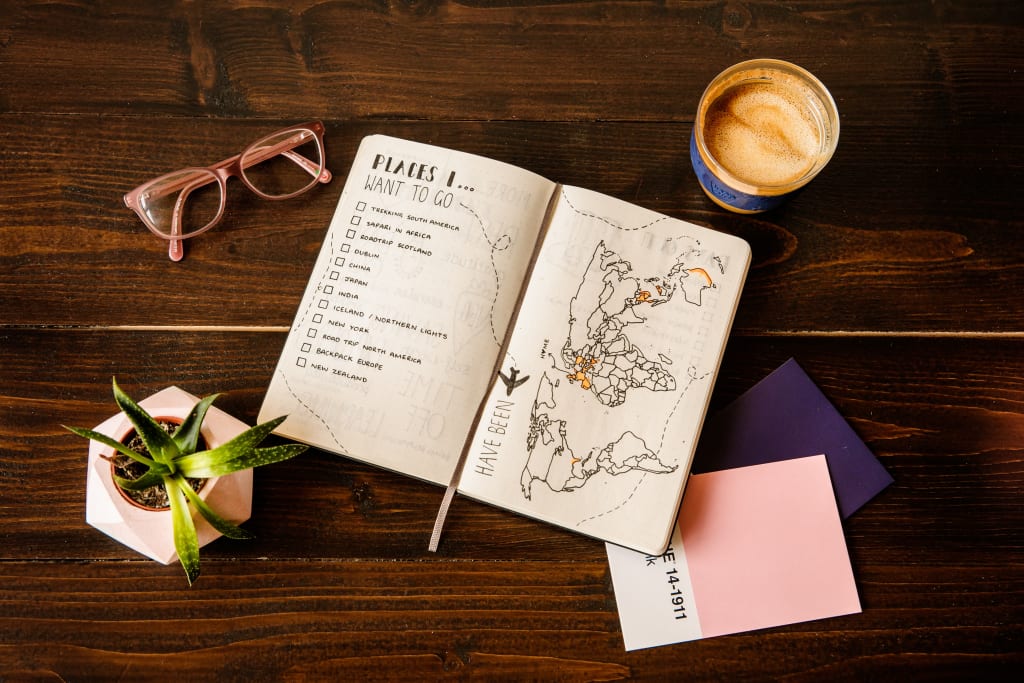
Setting travel goals is a powerful way to transform your wanderlust into tangible experiences. By creating a list of desired destinations and activities, you can turn your travel dreams into reality . In this blog post, we will delve into the benefits of setting such goals and how they can help shape unforgettable journeys.
We will provide inspiration for crafting your own unique travel goals list , featuring must-see destinations and off-the-beaten-path adventures. Additionally, we'll share valuable tips on how to set achievable targets.
Finally, discover how Worldpackers can serve as an essential resource in achieving your long-term objectives by connecting you with incredible opportunities across the globe with free accommodation. Whether it's scuba diving in exotic locations or experiencing once-in-a-lifetime cultural celebrations, this platform makes travel easier than ever before.

The power of setting travel goals
Traveling is amazing, but setting specific goals can make your trips even more meaningful. Envisioning your ideal getaways and activities can lead you on a voyage of self-exploration, growth, and remarkable experiences.
Setting travel goals not only adds purpose to your adventures but also gives you direction in planning your trips. It's easy to get overwhelmed by all the amazing places out there waiting to be explored. Having clear objectives helps narrow down the options while keeping you motivated throughout the entire process.
Create your travel bucket list
To get started on setting your travel goals, begin by creating a bucket list filled with experiences that excite and inspire you . This could include anything from visiting all seven continents to attending the world's most renowned festivals.
Remember that there's no one definitive answer; this is about building up a journey that truly reflects your identity. Your bucket list should be connected to your personal interests and passions.

Inspiring travel goals to pursue
For unforgettable experiences, choose travel goals that resonate with your passions and aspirations. Here are some inspiring travel goals to consider:
- Learn another language: Immerse yourself in a foreign culture by learning its language - it's one of the best ways to truly connect with locals and gain deeper insights into their way of life.
- Go on an epic road trip: Hit the open road and discover hidden gems along scenic routes like these iconic drives around the world.
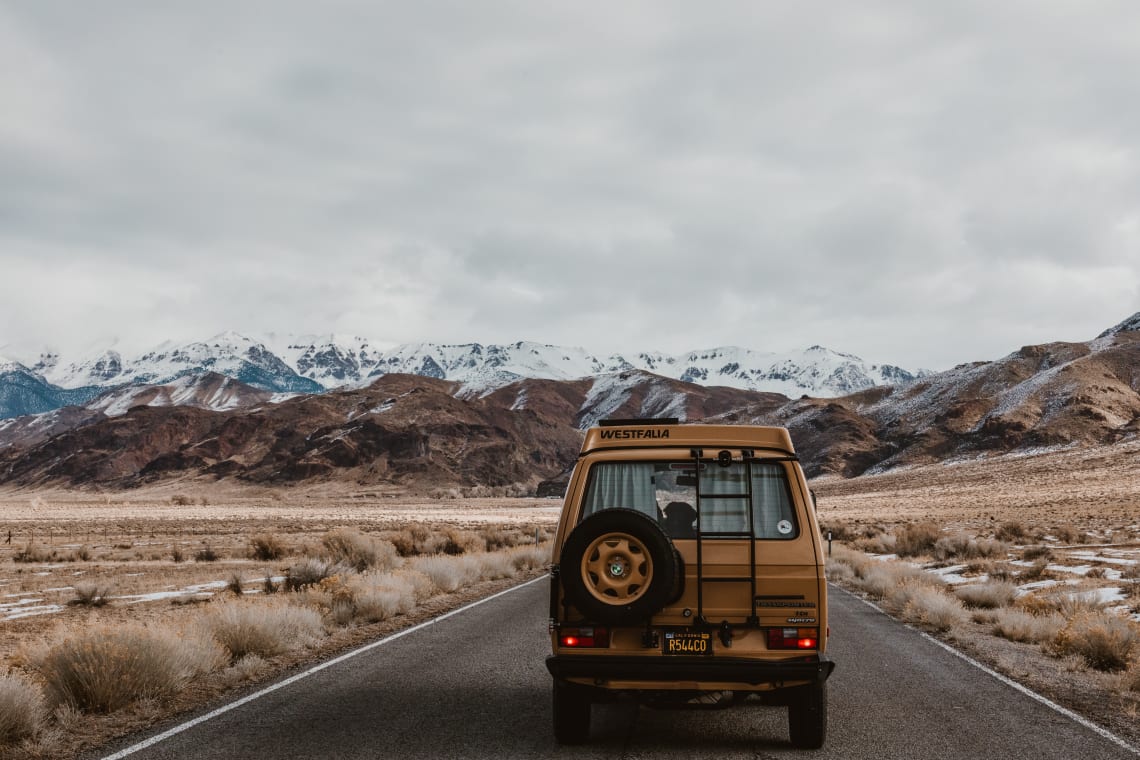
- Travel in a motorhome or campervan: Explore remote destinations at your own pace with flexibility and freedom.
- Volunteer abroad: Make a positive impact by volunteering in your own country or overseas through organizations like Worldpackers , a platform connecting travelers with unique work exchange opportunities.
- Learn to surf : Catch some waves and learn a new skill in destinations like Australia, Hawaii, or Costa Rica.
- Walk the Camino de Santiago: Experience a unique blend of history, culture, and spirituality on the ancient pilgrimage route across Spain and some neighboring countries.
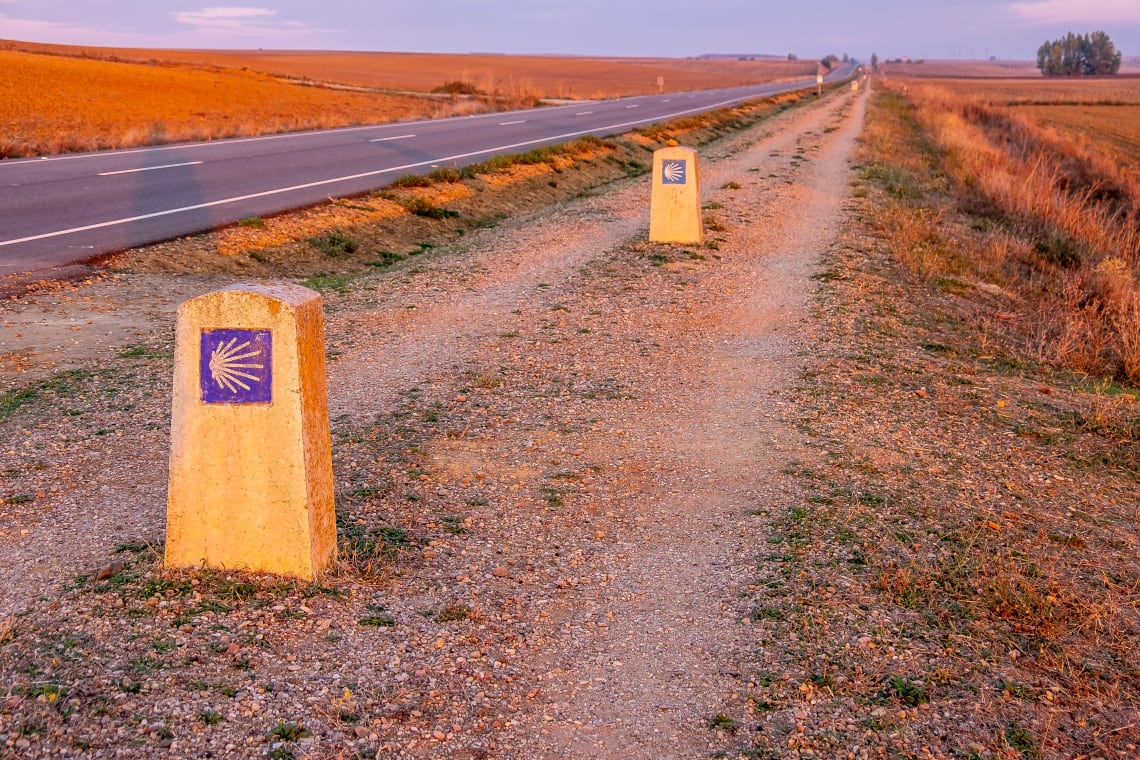
- See Antarctica: Embark on a once-in-a-lifetime adventure on an Antarctic expedition cruise to witness breathtaking landscapes and diverse wildlife.
- Visit all the UNESCO World Heritage Sites: Travel to iconic landmarks such as Machu Picchu, Angkor Wat, or Petra.
- Experience an epic train journey: Embark on unforgettable rail adventures like the Trans-Siberian Railway.
- See wildlife in their natural habitat: Experience awe-inspiring encounters with animals such as gorillas in Uganda or whales off Iceland's coast - witnessing these majestic creatures up close will leave lasting impressions.
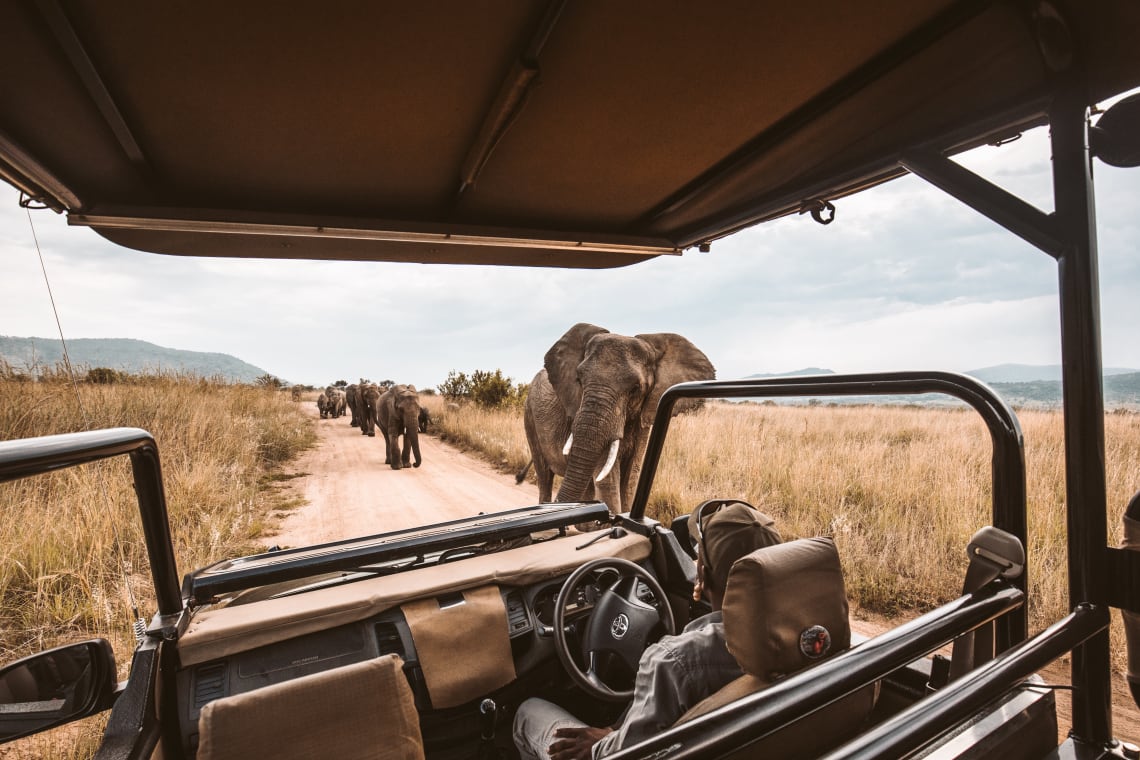
- Learn to cook other country's cuisine: Expand your culinary skills and taste authentic local dishes by taking cooking classes while traveling.
- Eat at a Michelin-starred restaurant: Savor world-class dining experiences at renowned establishments around the globe.
- Climb a famous mountain: Tackle challenging peaks like Kilimanjaro or trek to Everest Base Camp for unparalleled views and personal achievement.
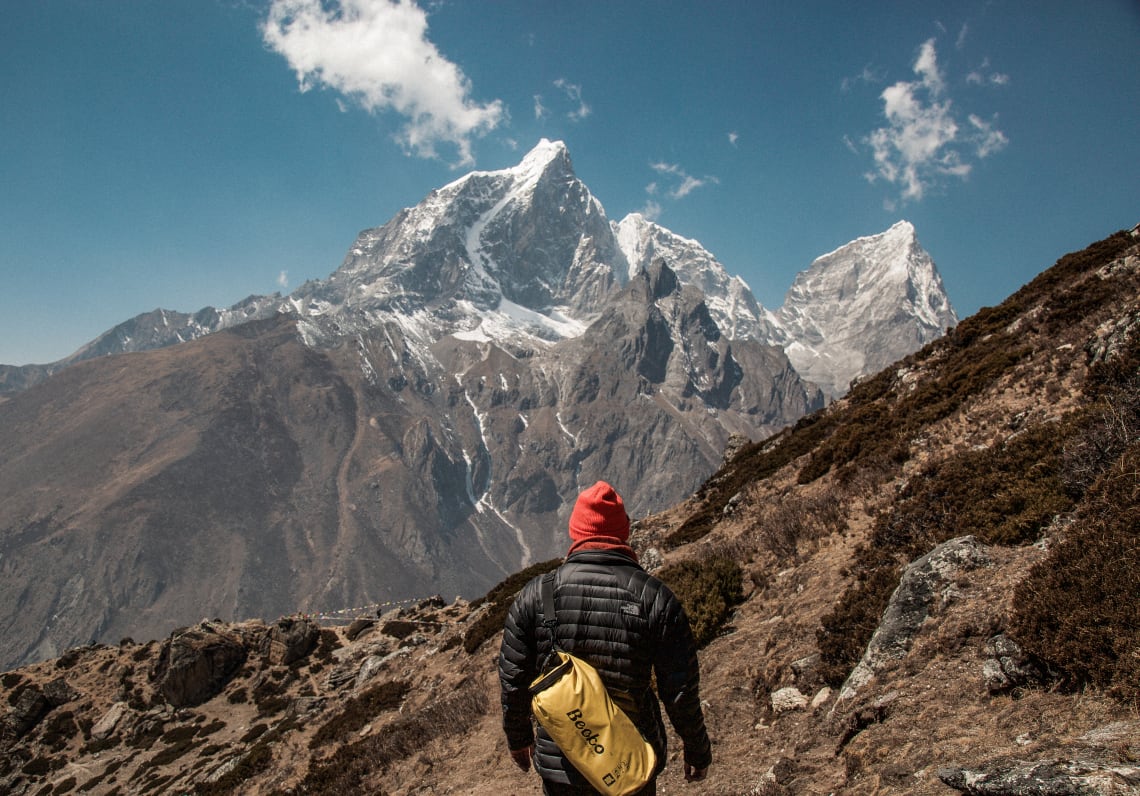
- Learn to scuba dive: Exploring the breathtaking underwater world, scuba diving offers a thrilling adventure filled with vibrant marine life and stunning coral reefs.
- See the World Cup: Immerse yourself in the electrifying atmosphere of the world's most celebrated sporting event.
- See the Northern Lights: Embark on a mesmerizing journey to witness nature's most awe-inspiring light show.
- Backpacking around Latin America, Asia, Europe, Oceania or Africa: embarking on a backpacking journey through these diverse continents offers an opportunity to immerse yourself in a tapestry of cultures, languages, and landscapes.
Tips for achieving your travel goals
Setting travel goals is essential to make your dreams a reality. However, achieving them requires dedication, planning, and perseverance . Here are some tips to help you accomplish your travel aspirations:
Research and plan
The first step in achieving any goal is thorough research and planning. Gather information about the destinations you want to visit , understand local customs and culture, identify must-see attractions or experiences, and figure out logistics like transportation options and visa requirements.
The internet offers a wealth of resources for travelers. Blogs from fellow travelers can provide valuable insights. You can also browse the articles published on the Worldpackers blog, written by many of our members from around the world.
Budget accordingly
Achieving your travel goals often comes with financial considerations. Start by creating a realistic budget that includes all expected expenses such as accommodation costs, food expenditures and transportation fees.
Additionally, consider ways to save money while traveling - this could involve staying at hostels instead of hotels or using public transport rather than taxis when possible.
If you want to save a lot of money and live transformative experiences, consider doing a work exchange with Worldpackers , a platform connecting travelers with unique volunteer opportunities in exchange for free accommodation around the world.
Moreover, look for opportunities to earn extra income before embarking on your trip; freelancing gigs or part-time jobs can help supplement savings dedicated specifically for travels.
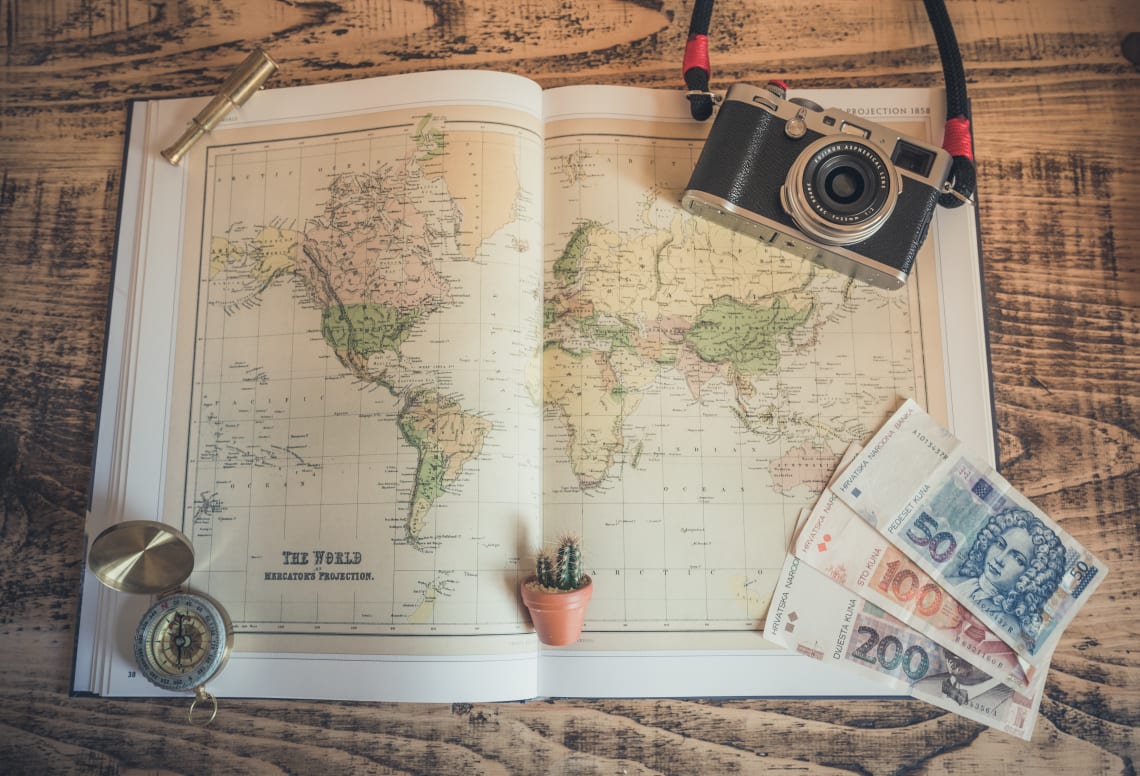
Ignore nay-sayers
In pursuit of our dreams, we often encounter people who doubt our abilities or question the feasibility of our goals. It's essential to stay focused on your objectives and not let negative opinions deter you from pursuing your passions.
Surround yourself with supportive individuals, join online travel communities, or connect with like-minded travelers on social media for encouragement and inspiration.
Stay flexible and open-minded
Achieving travel goals requires adaptability and an open mind. Be prepared for unexpected changes in plans , whether it's a sudden change in weather conditions or a last-minute opportunity to explore a new destination. Embrace these experiences as part of the adventure; they can lead to some of the most memorable moments during your travels.
Maintaining flexibility also means being willing to adjust your itinerary based on local recommendations - locals are often more knowledgeable about hidden gems than any guidebook could ever be.
Keep an open mind when trying new foods, participating in cultural activities, or engaging with people from different backgrounds; this will enrich your overall experience while traveling.
Track your progress
To keep yourself motivated towards achieving your travel goals, it's good to track progress along the way. Documenting milestones through journal entries , photographs, dedicated apps or social media updates can help remind you how far you've come since setting out on this journey.
In addition, celebrating small victories like mastering basic phrases in another language or successfully navigating public transportation systems abroad helps build confidence and momentum towards accomplishing bigger objectives down the line.

Achieving travel goals with Worldpackers
Ready to embark on an adventure of global exploration, gain new experiences, and make a meaningful contribution to the world? Volunteering with Worldpackers can both be a travel goal on itself and help you reach your other objectives while saving a lot of money. Take a look at some of its benefits:
- Free accommodation all around the world
Accommodation costs can be a hurdle for many travelers. Worldpackers offers an affordable solution by connecting you with hosts who provide free accommodation in exchange for your skills and time.
- Diverse range of experiences available
Worldpackers has something for everyone. From volunteering at wildlife sanctuaries and teaching English abroad to participating in permaculture projects and immersing yourself in local cultures through homestays - browse thousands of work exchange experiences available across more than 170 countries worldwide.
For example, you can help on a vineyard in Wildwood (USA), do some painting and decorating in sunny Puerto Vallarta (Mexico), learn about Swiss lifestyle near a beautiful lake , learn all about agroecology in Bahia (Brazil) , cook traditional Moroccan food and experience the Sahara desert , teach English in Vietnam and much more.
- Connection with local communities
Traveling is all about making links with individuals from diverse societies and customs. Worldpackers facilitates these connections by providing a platform for travelers to engage directly with local communities through work exchange experiences. Live and work alongside your hosts to gain valuable insights into their daily lives while helping them out.
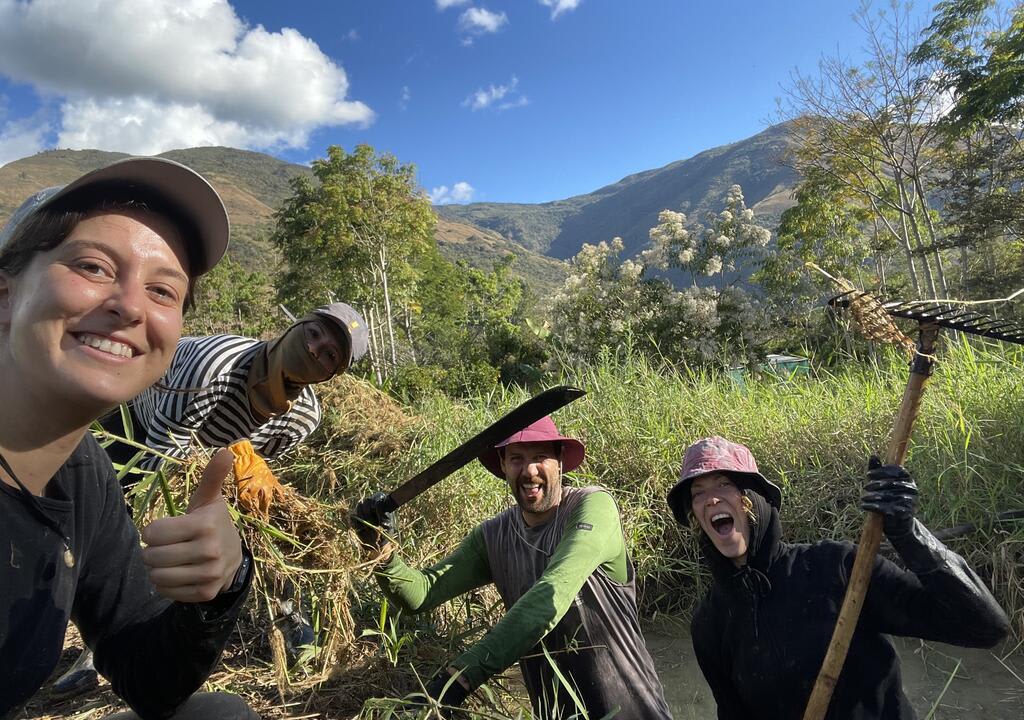
Tips for making the most out of your Worldpackers experience
- Create a compelling profile: Showcase your skills, interests, and previous travel and professional experiences on your profile.
- Research opportunities thoroughly: Read the description for each volunteer position and the reviews from other travelers who have participated in that same work exchange to understand if that opportunity matches your travel goals.
- Maintain open communication: Communicate openly with your host regarding any questions or concerns during the application process or throughout your stay.
Worldpackers offers an alternative approach to travel - one focused on personal growth, cultural exchange, and making lasting memories while giving back along the way.
FAQs in relation to travel goals
What are some examples of travel goals.
Travel goals can include visiting a set number of countries, immersing oneself in diverse cultures, learning new languages, volunteering abroad, or seeing wild animals in their natural habitats. Goals can also involve exploring natural wonders like mountains and beaches or attending popular festivals and events.
What are the benefits of traveling?
Traveling provides opportunities for personal growth, cultural immersion, adventure-seeking, relaxation, and escaping daily routines. It allows individuals to learn about different lifestyles and traditions, create unforgettable memories, and foster global connections.
How can you write effective travel goals?
Be specific about desired experiences, make them measurable by setting timeframes or milestones, ensure they're achievable within budget and schedule constraints, prioritize relevance to interests, and time-bound them with deadlines for completion.
What are some examples of SMART travel goals?
A SMART (Specific, Measurable, Achievable, Relevant & Time-bound) goal example could be: "Visit five European countries within three months while staying on a $50 per day budget."
This goal is clear in its purpose (visiting Europe), quantifiable (five countries), realistic (budget constraint), relevant to one's interest in Europe exploration, and time-sensitive (three-month deadline).

Let's go after those goals!
Wanderlust can be a powerful force that drives you to explore the world and step out of your comfort zone , so why not set some travel goals to make those dreams a reality? From backpacking through Europe to learning a new language in South America, the possibilities are endless. But don't forget: the journey towards achieving travel goals is just as important as the destination itself.
And if you still need some extra motivation, check out these bucket list travel destinations that will inspire you to pack your bags and hit the road:
- Top 10 bucket list destinations
- 13 Bucket list adventure ideas around the world
- Cool places to travel: 12 best destinations for your bucket list
Ready to get on the road? Embrace the transformative power of purposeful travel experiences and create your Worldpackers profile now!
Join the community!
Create a free Worldpackers account to discover volunteer experiences perfect for you and get access to exclusive travel discounts!
Worldpackers Editorial
Worldpackers
The safest community to travel, volunteer and make a positive impact in +140 countries.
Be part of the Worldpackers Community
Already have an account, are you a host, leave your comment here.
Write here your questions and greetings to the author
Jul 03, 2023
Jul 06, 2023
M momm Icy i byr rreef iri. Or re rrrrrn Bt e
Jul 08, 2023
UGANDA CAR RENTAL SERVICES. https://www.fkcarrentaluganda.com/car-news-tips/uganda-car-rental-services.html
Jul 26, 2023
More about this topic

How to get into mountaineering in 7 steps: the complete guide
Living on a boat: is this life for you?
Post-vacation depression: what is it and how to deal with it.
How do Worldpackers trips work?
As a member, you can contact as many hosts and travel safely as many times as you want.
Choose your plan to travel with Worldpackers as many times as you like.
Complete your profile, watch the video lessons in the Academy, and earn certificates to stand out to hosts.
Apply to as many positions as you like, and get in contact with our verified hosts.
If a host thinks you’re a good fit for their position, they’ll pre-approve you.
Get your documents and tickets ready for your volunteer trip.
Confirm your trip to enjoy all of the safety of Worldpackers.
Have a transformative experience and make a positive impact on the world.
If anything doesn’t go as planned with a host, count on the WP Safeguard and our highly responsive support team!
After volunteering, you and your host exchange reviews.
With positive reviews, you’ll stand out to hosts and get even more benefits.
Blog , Travel App
Travel App Development: Features, Monetization and More
- By Debangshu Chanda
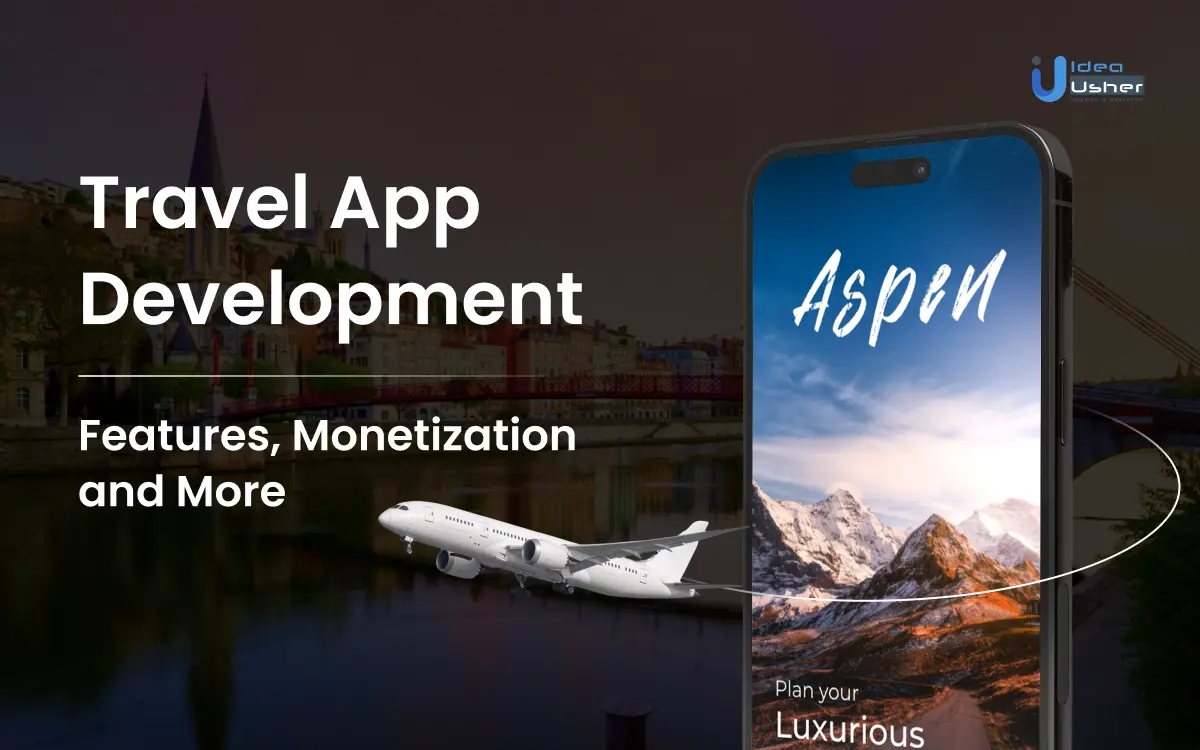
As the travel industry embraces digital innovation, the demand for user-friendly and feature-packed travel applications is growing. Whether you’re an established travel business or an entrepreneur interested in the travel-tech sector, this blog post is your guide to navigate the world of travel app development.
Join us as we explore the key features that make a great travel app, dive into creating a smooth user experience, and discover effective ways to make your travel app profitable. From engaging users to staying updated on industry trends, we’ve put together a comprehensive guide to empower you in building a successful travel app for your business.
What is a Travel App?
How a travel app works, key market takeaways, how to develop a travel app, must-have features that can make your travel app stand out, tech stacks to consider for developing an unique travel app , monetization opportunities for travel apps in usa, top 8 travel apps in usa that have done something unique .
A travel app can be a go-to digital travel companion for users, covering everything from planning entire trips to making post-trip memories. It helps users discover destinations, book flights, and accommodations, and create personalized itineraries.
During the trip, the app acts as a real-time navigator, offering offline maps, live updates on flights and local events, and language translation. It also connects users with fellow travelers, providing tips and recommendations.
A travel app is like a pocket-sized travel agent, simplifying the journey and making it more enjoyable. It’s a one-stop solution for all the travel needs, and staying informed on the go.
Users often see travel apps as seamless tools for booking dream vacations, but there’s a lot happening behind the scenes. Let’s take a simple journey through the key components that make our favorite travel app work.
1. APIs and Aggregators
Normally, airlines, hotels, and restaurants connect through APIs, like doorways to their offerings. Then aggregators simplify things by gathering choices from various vendors into one simple app.
2. The Search Engine
When users look for flights or hotels, smart algorithms have to step in. They filter through tons of data from APIs, considering preferences and real-time factors like deals and availability to show the best options.
3. Booking Engine and Payments
After users pick their trips, the booking engine checks with the chosen vendor’s API, confirms availability, and handles the reservation. After that, payment gateways, like Stripe or PayPal, smoothly manage the financial side for a secure checkout.
4. Itinerary and Profiles
The itinerary tools in travel apps help users organize bookings, see their trip plan, and share with friends. User profiles store preferences, making the app personalize suggestions based on unique styles.
5. Location Services
Location services and geolocation APIs use GPS data to pinpoint locations, suggest nearby spots, and guide with turn-by-turn navigation.
6. Push Notifications and Chatbots
Many travel apps also have push notification features. Flight delays? Local events? Users will be able to know it all. Some apps even have chatbots that offer real-time help, acting like a 24/7 travel assistant.
7. AI and Machine Learning
Travel apps are always learning. Various AI and machine learning algorithms in travel apps study user behavior and preferences. The result? Personalized suggestions, predictive searches, and even adjusted prices, making sure the app understands user needs and offers the best experiences.
With the travel app market witnessing an impressive 53.4% surge, raking in a staggering $556 billion last year according to BusinessofApps , the time is ripe for travel businesses to make their mark in the digital landscape . In a year where over 800 million users embraced travel apps, the shift in how people plan and engage with their journeys is undeniable.
For travel businesses eyeing app development, the recent industry trajectory offers some critical insights. Despite the pandemic-induced setbacks, the swift two-year recovery of the online travel booking sector underscores the enduring appeal and resilience of travel apps. Dominated by Booking Holdings and Expedia Group, which command 60% of travel bookings in key markets, this industry presents both challenges and unprecedented opportunities.
Source: BusinessofApps
The crux of success for aspiring travel app businesses lies in understanding that innovation is the key differentiator. While giants like Booking and Expedia maintain their stronghold, the disruption caused by Airbnb, securing the third spot with seven million short-term rentals, highlights the potential for groundbreaking ideas to reshape the market.
Critical to this era of travel app development success is the recognition that strategic acquisitions and diversified services play a pivotal role. As a travel business ventures into app development, integrating flights, car rentals, experiences, taxis, and cruises can position them not just as booking platforms but as comprehensive travel solution providers.
This transformative approach aims to replicate the holistic service model of pre-internet travel agencies. The goal is clear – becoming the ultimate one-stop destination for travelers, echoing the convenience of curated packaged holidays. The revenue model, reminiscent of traditional practices, involves earning commissions for each booking across various travel services.
Here’s a stepwise guide to develop an unique travel app for your business
1. Define Your Niche and Target Audience
Especially, in the travel app market, success lies in specificity. Choose a niche—whether it’s budget travel, luxury experiences, adventure trips, or catering to solo travelers. This focused approach helps tailor your app to meet the unique needs of a particular segment.
Target Audience:
Understanding your users is key. Dive deep into demographics, travel habits, and pain points. This knowledge becomes the foundation for tailoring features and crafting compelling value propositions that resonate with your audience.
2. Conceptualize Your App and Its Features
Core functionalities:.
Identify the essential features that form the backbone of your app. This includes functionalities like flight and hotel booking, itinerary planning, offline maps, translation tools, and local recommendations.
Unique Features:
Stand out with innovative features. Consider incorporating AI for personalized recommendations, augmented reality for interactive tours, virtual reality experiences, and elements of gamification. Additionally, establish a clear monetization strategy through in-app purchases, subscription models, commissions on bookings, or strategic partnerships.
3. Development Roadmap and Technical Stack
Native app vs. web app:.
Decide on the platform—native or web—based on factors like reach, development complexities, and user preferences. Understand the pros and cons of each to make an informed decision.
Programming Languages and Frameworks:
Select the right tools for the job. Flutter and React Native are excellent choices for cross-platform development, while using native languages for Android and iOS ensures optimized performance.
APIs and Integrations:
Leverage the power of third-party integrations. Integrate travel booking APIs, mapping APIs, payment gateways, and social media platforms to enhance the functionality and user experience of your app.
4. Design and User Interface (UI)
Intuitive navigation:.
Simplicity is paramount. Craft a user-friendly interface with intuitive navigation, providing quick and easy access to key features.
Offline Accessibility:
Acknowledge the realities of travel. Ensure that essential features are accessible even without an internet connection, catering to users in remote or low-connectivity areas.
Multilingual Support:
Embrace diversity with multilingual support. Localize your app to cater to a global audience, making it accessible and user-friendly for people worldwide.
5. Testing and Deployment
Thorough testing:.
Rigorously test your app across various devices and operating system versions. This ensures a smooth performance and a bug-free user experience.
App Store Optimization:
Optimize your app’s visibility in app stores. Pay attention to the title, description, keywords, and visuals to increase discoverability among potential users.
Marketing and Promotion:
Create a buzz around your app. Utilize social media platforms, run targeted advertisements, collaborate with influencers, and engage in partnerships with travel bloggers to promote your app effectively.
The travel app market in the USA can be competitive, so to make the app stand out, here’re some unique and innovative features to include in your travel app,
1. Hyper-Personalized Recommendations
Leverage ai & machine learning:.
Harness the power of artificial intelligence and machine learning to analyze user preferences, travel history, and real-time data. Provide personalized recommendations for hidden gems, unique experiences, and customized itineraries.
Go Beyond Destinations:
Recommend not only destinations but also activities, restaurants, local events, and hidden spots based on individual interests and preferences.
Integrate Social Media:
Analyze users’ social media profiles to offer travel inspiration. Suggest destinations, experiences, and even travel companions with similar interests.
2. Immersive Augmented Reality (AR) Experiences
Overlay virtual information:.
Enhance user engagement by overlaying virtual information on real-world sights. Provide historical context, cultural insights, and interactive overlays using AR.
AR-Powered Scavenger Hunts:
Gamify sightseeing with AR-powered scavenger hunts and city exploration games, encouraging users to explore popular locations more deeply.
Virtual Tours and Pre-Trip Visualization:
Offer AR-powered virtual tours of destinations, hotels, and attractions. Let users “try before they fly” by visualizing their trip in advance.

3. Seamless, AI-Powered Translation and Communication
Real-time voice and text translation:.
Break down language barriers with in-app translation tools that handle conversations, menus, and signs on the go.
Multilingual Chatbots and Virtual Assistants :
Provide 24/7 support, answer questions, and recommend local experiences in the user’s native language through AI-driven chatbots.
Offline Translation Capabilities:
Ensure uninterrupted communication even without internet access, empowering users to navigate foreign destinations confidently.
4. AI-Driven Itinerary Planning and Optimization
Smart itinerary builder:.
Suggest the most efficient and enjoyable travel routes based on user preferences, available time, budget, and real-time travel updates.
Optimize Itineraries in Real-Time:
Account for weather, traffic, and unforeseen delays by automatically adjusting plans and suggesting alternative options.
Integrate Local Transportation and Activities:
Recommend the best modes of transport (bikes, buses, walking) and suggest local experiences based on the user’s itinerary.
5. Gamification and Social Travel Sharing
Earn points and badges:.
Encourage exploration and engagement by awarding points for visiting landmarks, trying local food, or completing AR scavenger hunts.
Leaderboards and Social Sharing:
Allow users to compete with friends or fellow travelers, sharing their experiences and itineraries on social media platforms.
Interactive Travel Communities:
Create forums and chat groups within the app for users to connect, share tips, and recommend hidden gems.
6. Blockchain-Powered Security and Transparency
Secure booking and payment system:.
Utilize blockchain technology for tamper-proof travel document management and secure, decentralized booking platforms.
Transparent Pricing and Fee Disclosure:
Show all hidden fees and taxes upfront, building trust and empowering users to make informed decisions.
Automated Travel Insurance Options:
Integrate blockchain-based insurance models that automatically activate based on real-time flight delays or cancellations.
7. Contextual Awareness and Location-based Services
Push notifications based on user location:.
Provide relevant recommendations for nearby restaurants, attractions, or events based on real-time location data.
Also read, “ What are Push Notifications? A Complete Guide ”
Augmented Reality Navigation:
Overlay turn-by-turn directions and points of interest on live maps through AR, creating an immersive and intuitive navigation experience.
Emergency Assistance and Local SOS Features:
Integrate with local emergency services and safety hotlines, providing quick access to help in case of accidents or emergencies.
8. Eco-Conscious Travel Planning and Recommendations
Highlight sustainable travel options:.
Suggest eco-friendly hotels, transportation choices, and activities, catering to the growing demand for responsible tourism.
Carbon Footprint Calculator and Offsetting Options:
Estimate the carbon footprint of different travel plans and allow users to offset their emissions directly through the app.
9. Voice-Activated Control and Smart Wearable Integration
Hands-free travel experience :.
Allow users to book flights, check-in, or control itinerary functions using voice commands for a convenient and hands-free experience.
Seamless Integration with Smartwatches and Fitness Trackers :
Track steps, monitor health metrics during travel, and access app features directly from wearable devices.
Contextually Aware Voice Assistants:
Provide real-time information and recommendations based on the user’s location and travel progress through voice prompts.
10. Personalization through Multi-Sensory Experiences
Curated audio tours and playlists:.
Offer location-specific audio guides narrated by local experts or celebrities for an immersive storytelling experience.
Mood-Based Music Recommendations:
Suggest music playlists tailored to different travel moods or activities, enhancing the emotional connection to a destination.
Also read, “ How To Develop AI Music Generator like Musicfy ?”
Let’s go though the list of tech stacks, business should consider using for developing their dream travel app,
1. Front-End Excellence
Webassembly for performance and cross-platform compatibility.
Embrace WebAssembly for near-native performance and code sharing across web and mobile platforms. Ensure a cohesive user experience with rich interactive features.
Progressive Web Apps (PWAs) for Instant Engagement
Transform the app into a PWA for offline functionality, push notifications, and home screen installation. Enhance user engagement and accessibility, creating a more app-like experience within the browser.
Motion UI Libraries for Fluid Animations
Integrate libraries like Framer Motion or React Spring for captivating animations and micro-interactions. Delight users with smooth transitions, subtle visual cues, and satisfying feedback loops, elevating the overall experience.
2. Backend Orchestration with Serverless
Aws lambda & google cloud functions.
Scale seamlessly without managing servers. These serverless platforms handle backend tasks efficiently, ensuring real-time responsiveness and cost-efficiency.
Opt for GraphQL for a flexible query language. Empower users to tailor their travel experience by fetching only the data they need, from flight schedules to hidden gem recommendations.
3. AI & ML for Hyper-Personalization
Contextual ai with rasa.
Craft intuitive chatbots that understand user intent and respond with personalized recommendations. Imagine a chatbot suggesting hidden waterfalls after learning a user’s love for outdoor adventures.
Also read, “ AI Fitness Chatbot Development A Quick Guide ”
Generative AI for Dynamic Content
Use GPT-3 or similar models to personalize itineraries, generate trip descriptions, and even write custom guidebooks based on user preferences. Incorporate AI-powered storytelling for every step of the travel journey.
4. Geospatial Innovation
Mapbox gl js.
Enhance maps with 3D terrain, real-time traffic, and offline navigation. Provide users with stunning visuals, allowing them to virtually explore destinations before booking.
ARKit & ARCore
Overlay location-based information and experiences onto the real world. Envision AR arrows guiding users to hidden landmarks or virtual museum exhibits popping up on city streets.
5. Frictionless Payments & Security
Stripe radar for fraud prevention.
Block fraudulent transactions with AI-powered risk management. Ensure user and business safety with cutting-edge security solutions.
Digital Wallets & Tokenization
Offer seamless one-click payments with Apple Pay and Google Pay. Securely store user data with tokenization to minimize hacking risks.
6. Data-Driven Insights & Optimization
Bigquery & snowflake.
Analyze user behavior and travel trends at scale. Identify popular destinations, optimize booking flows, and personalize marketing campaigns with data-driven insights.
A/B Testing & Experimentation
Continuously improve the app with real-time A/B testing of features, layouts, and content. Watch user engagement and conversion rates skyrocket through data-driven iteration.
Here’s how businesses can monetize their travel apps in USA,
1. Hyper-Personalization
Ai-powered recommendations:.
Go beyond basic interests by leveraging AI to analyze user behavior, travel history, and real-time data. Provide personalized suggestions for flights, hotels, and experiences tailored to individual preferences, boosting user engagement and conversion rates.
Dynamic Pricing for App Features:
Offer personalized pricing for premium features such as airport lounge access, priority booking, or curated travel packages. By tailoring prices to individual preferences and budgets, you create a sense of value that caters to diverse user segments.
2. Subscription Models
Tiered subscriptions:.
Introduce a freemium model with basic features and paid tiers offering exclusive content, discounts, and priority customer support. This caters to various user needs, encouraging them to upgrade for additional benefits.
Location-Based Subscriptions:
Provide localized subscriptions focusing on specific cities or regions. Users subscribing to these plans receive curated recommendations, deals, and discounts relevant to their travel plans, offering a more personalized experience.
Gamified Subscriptions
Introduce different subscription tiers like “Nomad,” “Explorer,” and “Voyager,” each offering increasing travel benefits and exclusive challenges. Gamify the experience with badges, leaderboards, and virtual travel companions, encouraging user engagement and loyalty.
3. Experience-Driven Monetization
In-app bookings for activities and tours:.
Expand your service offerings by partnering with local providers. Enable users to book unique local experiences directly through the app, creating a comprehensive travel platform that meets all their needs.
Live Streaming and Virtual Tours:
Host live experiences within the app, such as cooking classes, cultural shows, or city tours. Charge users for access to these virtual events, generating revenue while enriching user experience and offering virtual travel options.
Also read, “ How to Make Interactive Live Streaming Platform Firesidechat ”
4. Data-Driven Partnerships
Travel data insights:.
Monetize anonymized user travel data by selling it to tourism boards, airlines, and hotels. These insights can be invaluable for marketing strategies and customer segmentation, providing a revenue stream without compromising user privacy.
Affiliate Marketing:
Forge partnerships with relevant brands and earn commissions on bookings made through the app. Opt for strategic affiliations that align with user preferences, enhancing their overall travel journey and generating additional income for your business.
5. Curated Itineraries
Craft unique subscription boxes for specific interests like foodie adventures, historical explorations, or off-the-beaten-path journeys. Each box includes pre-planned itineraries, local recommendations, and exclusive partner discounts, offering a complete and curated travel experience.
6. Personalized Travel Buddies
Develop subscription based AI travel companions that learn user preferences and curate personalized itineraries, restaurant suggestions, and hidden gems based on real-time data and local insights. Provide users with a personalized, tech-driven travel buddy for an enriched journey.
7. Experiential Perks
Partner with local businesses for exclusive subscription perks like cooking classes with renowned chefs, private vineyard tours, or backstage access at cultural events. Offer a taste of authentic local life beyond the typical tourist experience.
8. Skill-Building Adventures
Combine travel with skill development by offering subscriptions with language courses, photography workshops, or fitness retreats incorporated into unique travel itineraries. Users return home with new skills and unforgettable memories.
Here’s a list of top 10 unique travels apps businesses should keep an eye on,
1. Atlas Obscura
Atlas Obscura helps reveal hidden treasures like dinosaur footprints, deserted amusement parks, and quirky museums, inspiring unique adventures away from the usual tourist spots.
Revenue Potential: Their monetization relies on premium memberships, ad placements, and affiliate marketing. Based on their user base and engagement, potential annual revenue could range from $1 million to $5 million.
Detour offers GPS-guided tours with captivating voice-overs, music, and sound effects; it blends history, local legends, and fictional narratives for an immersive exploration.
Revenue Potential: This app charges for individual tours and offers subscription plans. User base and active downloads suggest potential revenue between $2 million and $10 million.
EatWith connects travelers with local hosts who open their homes for intimate dining experiences, it’s a delightful way to learn about culture through shared meals.
Revenue Potential: This app charges a commission on dining experiences and offers additional services like cooking classes. Their potential revenue could range from $5 million to $20 million.
4. We Ski & Snowboard Tracker
We Ski & Snowboard Tracker combines real-time snow conditions, resort information, and lift ticket deals for skiing, snowboarding, and other winter adventures.
Revenue Potential: Their main income comes from in-app purchases and partnerships with resorts. Considering winter sports enthusiasts, potential revenue could be between $1 million and $5 million.
5. Citymapper
Citymapper provides real-time public transportation information, walking and cycling routes, and live disruption alerts. It ensures efficient exploration while avoiding the stress of traffic.
Revenue Potential: This app relies on ad revenue and partnerships with public transportation agencies. Their extensive user base suggests potential revenue in the range of $10 million to $50 million.
Meetup helps users to find travel-related groups and events in your destination city. Share experiences, get local recommendations, and make new friends who share your wanderlust.
Revenue Potential: This app generates revenue through premium memberships and event ticketing. Their vast user base and global reach suggest potential revenue of $15 million to $75 million.
Cairn offers curated trail recommendations, offline maps with detailed terrain data, and expert-sourced safety tips, it ensures a confident hiking and camping experience.
Revenue Potential: This app’s monetization relies on subscriptions, in-app purchases for maps and resources, and partnerships with outdoor outfitters. Based on their niche audience, potential revenue could be between $500,000 and $2 million.
8. Solo Travel Tiger
Solo Travel Tiger connects solo travelers with like-minded companions for group activities, excursions, and social events, creating opportunities to build meaningful connections on the road.
Revenue Potential: This app charges commission on bookings for activities and tours, besides offering premium memberships. Considering their niche audience, potential revenue could be between $500,000 and $1 million.
The blog highlights the key aspects and considerations in creating successful applications for the travel industry. It begins by emphasizing the booming demand for travel apps, driven by the increasing reliance on smartphones for trip planning, navigation, and exploration. The article then explores essential features for a travel app, such as intuitive user interfaces, real-time updates, personalized recommendations, and seamless integration of travel-related services. Additionally, it addresses the importance of leveraging technologies like GPS, augmented reality, and machine learning to enhance user experiences and provide innovative solutions.
Are you ready to revolutionize the travel industry with a cutting-edge travel app? IdeaUsher is your ideal partner for all your Travel App Development needs. Whether you have a groundbreaking idea that needs shaping or an existing concept that requires refinement, we have the expertise to transform your vision into a fully functional and user-friendly app. From mobile app development to web app solutions, our team at IdeaUsher is committed to delivering high-quality, customized applications that meet the unique demands of the travel industry. With a focus on innovation, security, and user experience, we ensure that your travel app stands out in a competitive market. Contact us today, and let’s embark on a journey to bring your travel app idea to life!
Q1: How do tourism apps make money?
A1: Tourism apps employ diverse revenue streams to generate income, ranging from in-app advertisements and sponsored content to affiliate marketing partnerships with hotels, airlines, and tour operators. Many apps also offer premium features or subscription models, granting users access to exclusive content, advanced functionalities, or an ad-free experience for a fee. The flexibility in monetization strategies allows tourism apps to adapt to user preferences and industry trends, ensuring a sustainable revenue model.
Q2: What is the value proposition of travel apps?
A2: The value proposition of travel apps lies in their ability to streamline the entire travel experience for users. These apps offer a one-stop solution for trip planning, booking accommodations, finding attractions, navigating unfamiliar territories, and accessing real-time travel information. By providing convenience, personalization, and efficiency, travel apps enhance the overall travel journey, making them indispensable tools for modern travelers seeking seamless and stress-free adventures.
Q3: What are the objectives of a travel application?
A3: The primary objectives of travel applications include simplifying travel planning and execution, enhancing user experience, and providing valuable, up-to-date information. Travel apps aim to cater to the diverse needs of users, from itinerary management and navigation to discovery of local attractions and personalized recommendations. Building user engagement, fostering customer loyalty, and staying abreast of emerging travel trends are also key objectives, ensuring that the app remains relevant and competitive in the dynamic travel industry.
Q4: How do travel apps work?
A4: Travel apps operate by integrating a variety of features and technologies to serve the multifaceted needs of travelers. They leverage GPS for real-time navigation, provide booking platforms for flights and accommodations, and use algorithms for personalized recommendations. Social connectivity features enable users to share experiences and recommendations. Additionally, some apps incorporate augmented reality for enhanced exploration. The seamless synergy of these functionalities ensures that travel apps deliver a comprehensive and user-friendly platform, creating a valuable resource for individuals seeking a hassle-free and enjoyable travel experience.
Related posts:
- Travel App Development: Features, Tech Stack, and Development Cost
- Concierge App Development: Must Have Features And Development Steps
- Best Travel Apps 2021
- What is a Travel Dating App?- Here’s what you need to know
- Live Demo of Dreamland App – A multi user travel application
- AR Apps in Travel and Tourism: Everything You Need to Know
Powered by YARPP .
Hire the best developers
100% developer skill guarantee or your money back. Trusted by 500+ brands

Quick Links
- Become a Partner
- Get in Touch
- Privacy Policy
- Terms & Conditions
- Web Development
- App Development
- Game Development
- Blockchain Development
- Non Fungible Token
- Internet of Things
- Artificial Intelligence
- Project Management
- Digital Marketing
- SCF 98, Phase 11, Sector-67 Mohali, 160062
- 651 B Broad St, Middletown, 19709, county New Castle Delaware, USA
- [email protected]
- (+1) 628 432 4305
HR contact details
- +91-8930090960
- +91-93900 89678
Follow us on

Idea Usher is a pioneering IT company with a definite set of services and solutions. We aim at providing impeccable services to our clients and establishing a reliable relationship.
Our Partners
- (+1) 628-432-4305

Enter Your Info, And We Will Get In Touch

Congratulations on taking the first step towards taking your business to new heights!
We are ready to take you there. We will soon contact you for more details.

You're closer to success than you think!
Get the MASTER KEY to grow your website sales from scratch.
Are you ready to grow your business?
Hi 👋 Can I help you?

Digital Commerce

Digital Products

AI and Data Consulting

Travel App Development Guide: Cost, Benefits, Features Types of Travel App to Consider
Sector: Digital Product
Author: Abhishek Singh
Date Published: 12/21/2020

Types of Travel Management Software and Mobile Apps
- How to Develop a Travel Tech App Solution?
Essential Features in Travel Software Solution
Functionalities in travel tech app solution, benefits of travel industry software solution, total development cost of travel tech software solution, wrapping up.
With swift transformations in technology, the world is turning into a smaller place. Both local and global traveling management is getting much simpler than before.
So, are you precisely in the process of planning a travel app development project for your tour and travel business? The current time is crucial, impacted by the COVID-19 crisis and meanwhile, you must go mobile to enable a modern-day travel business.
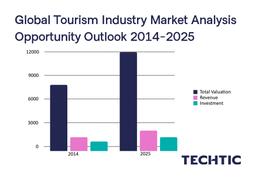
Even the global tourism industry is envisioned to reach out to USD 11,382 Billion (10.6% of GDP) with a USD 2,141 Billion visitor exports revenue upsurge and total projected investment of USD 1,336 Billion by 2025 and so the overall travel market recovery is on the cards.
Read More: Top Travel Trends for 2021 after Covid-19
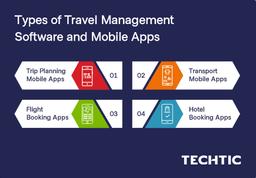
1. Trip Planning Mobile Apps
These categories of the app offer all travel features such as travel booking, taxi booking, hotel booking, itinerary planning, flight, train & bus bookings, and much more.
Examples: Expedia, MakeMyTrip, and Yatra.
2. Transport Mobile Apps
They assist users in finding information on nearby transportation routes. These applications utilize geolocation functionalities to track user location and offer the nearest transportation choices.
Examples : Uber, Lyft, Ola, and Taxify.
3. Flight Booking Apps
This application category assists traveler’s book flight tickets online, compares travel costs, and digitally pays for tickets with real-time information.
Examples: Kayak, Hopper, Skyscanner, and Kiwi.
4. Hotel Booking Apps
Accommodation applications enable users to view, book, and pay for rooms online. It has more functionality, including reviews, ratings, a digital check-in facility, and electronic keys.
Examples: Airbnb, Booking.com, Hostel World, and Oyo Rooms.
How to Develop a Travel Tech App Solution? [Complete Six-Step Guide]
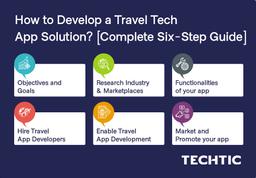
Step 1: Define the objectives and goals for your app
The initial stage is deciding on the category of application for traveling. If you desire it to be a profitable app for travel, you must define the core objectives and your app goals.
You may decide whether you want an application for hotel bookings, travel planning, tour guide app, an app for precise backpackers, transportation app, or any other category.
Planning to Redefine Travel Experiences? Curious About Our Expertise in Crafting Seamless Travel Apps?
Step 2: Researching the industry and marketplaces
One needs to do extensive industry and market research after deciding the app goals. Explore and discover the top traveling applications in your niche. Research their key features and functionality, what is exclusive about them, and what they have mislaid.
Even research the target audiences and customer responses towards them. This research will assist in getting the right perspective and how you can beat your competitors.
Step 3: Decide the functionalities of your app for travel
Decide on the app functionalities and features precisely essential to prove the best usages for your users. Doing this task will determine what your end users need and how you can influence them to your travel app.
Step 4: Hire Travel App and Software Developers
At this step, you can commence finding professionals and hire travel app developers . We would recommend hiring a mobile application development company to have the right, certified, and practiced resources.
A step further, they would have a dedicated team for your project, including project managers, mobile application developers, UX/UI designers, and testing professionals.
Step 5: Enable Travel App Development
After hiring the team, you require to discuss and explain your necessities to them. A skilled developer would understand even if your concept is not extremely clear. He might even propose some vital additions and alterations to your project.
Step 6: Market and Promote your app to travel
No matter how exclusive and exceptional it is, any application cannot thrive if you don’t market and promote it on suitable platforms. You can digitally market your app so that the target audience explores it and becomes aware of its features.
Read More: How AR is reshaping the Travel and Tourism industry?
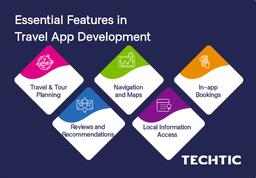
1. Travel & Tour Planning
This functionality of a trip planning application enables the users to plan their journey in an orderly style. The users can effortlessly search for a destination, facilitate trip schedules, gain knowledge from travel tips, gets details of travel activities, and book e-tickets.
2. Navigation and Maps
Travelers feel secure and safe with maps and navigations as they won’t get lost during their travel journey.
3. In-app Bookings
This functionality enables users to make bookings for flights, hotels, trains, and cabs on the go by a single application. This feature includes travel deals and offers, which will give your app an added benefit over others.
4. Reviews and Recommendations
Users look for consistency when booking a hotel room, transport, and other travel services online. Reviews and recommendations will assist them with it. You can’t build a travel guide application without this functionality.
5. Local Information Access
The users will love to try regional food, popular local markets, and watch local activities. Your application can provide information about all these activities and local emergency contacts should also be reachable in your mobile app.
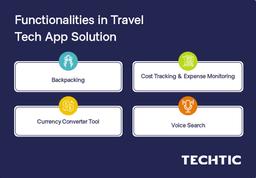
1. Backpacking
Backpacking functionality in travel apps is in drift these days, enabling travelers to access your app with cost-effective travel preferences, like reasonable accommodation and transport facilities. Your app with this feature can assist backpackers with low-cost stay, transport, a smart search of different local places, and local food items. This particular functionality also helps translate the regional languages and informing the backpackers about weather conditions.
2. Cost Tracking and Expense Monitoring
Most people find it complicated to monitor and track their expenses during a travel journey. Your application can work as an expense tracker app that assists them keeps tabs on their overall travel spending and compensations.
3. Currency Converter Tool
While traveling to other nations, travelers tend to make errors while making payments as they miscalculate or overrate the currency’s value. In such scenarios, a functional tool within your app converts currency on a real-time basis.
4. Voice Search
Around 55% to 65% of travelers are open to voice search. Why wouldn’t people be fond of merely telling Siri or Alexa to facilitate their online travel bookings?
1. Easy Accessibility
The mobile apps give immediate access to the users, while it is annoying calling numerous travel agents and explaining to them your travel requirements. With the help of travel apps, you can book tickets online in no time.
2. Effortless Maintenance
Mobile apps can be easily maintained and sustained when matched to manual travel bookings. A mobile app development company can track, support, and update all the data.
3. Advanced Customizations
With the alterations in technologies, the business also requires to transform some functionality in a mobile app. Thus, mobile apps are to be shaped-up to meet your customers’ diverse requirements and trends.
The total cost of developing a mobile travel app relies and depends on multiple factors, which you can explore below:
- Selected travel application development company
- The diverse platforms such as Android, iOS, or React Native
- The overall app size depending on the features and functionalities you require
- Number of professionals working on your mobile app development project
- Frequent maintenance, up-gradation, and scalability prospects of the project
By and large, the total cost of getting a travel app developed by a professional and proficient travel tech development company may range from $7,000 to $9,000 +, relying on the things referenced above.
As a leading Travel Tech Software Development company, we think that an inclusive digital transformation of travel firms is the primary trend for 2021 within the Covid-19 pandemic. Whether a travel organization or a Travel Tech App Development Company is involved with new business plans, everything is linked to personalization and customizations of travel apps. We are a top travel app development company , and you can effortlessly hire a travel software developer’s team through us.


How to Create a Successful Travel App: the Ultimate Guide to Travel App Development
Table of contents:, why should the businesses invest in travel app development.
- How Can AI Revolutionise Travel App Development?
- How To Build a Travel App? A. Define the type of travel app, target group & its pain points Trip Planning App Flight Booking App Transportation Booking App Accommodation Booking App Restaurant App Meal Ordering App Navigation App Banking App B. Research & idea validation C. Choose the monetisation model D. Features & Integrations – basic documentation E. Building the app with the right partner
Nowadays, people are more and more willing to explore various destinations. Younger generations, especially Generation Z, value the opportunity to experience new cultures, places, and people , so they are keen on travelling around the globe. This causes a huge space for businesses like yours to provide them with an app they need to make travels smooth and enriching.
In this article, I’ll discuss the future of the travel app market for the tourism industry and analyse how Artificial Intelligence may revolutionise this area (and what opportunities it brings to travel apps ). I’ll also describe step-by-step what the travel app development process looks like and review the most common travel app types.
The ultimate goal, however, is to inspire you to look for a unique approach tailored to the exact target app users’ needs.
In the era of constant Internet access, more and more individuals are taking charge of planning their own trips. Traditional travel agencies are no longer their primary choice, as modern travellers seek independence and control over their travel experiences and local attractions.
Furthermore, the rise of remote work has introduced new concepts like “workation”, which includes performing work remotely from anywhere in the world. Many individuals now aspire to become digital nomads, combining remote work with travel as they explore different locations.
Market size
The good news is, you don’t have to worry about the market space for your project. The growing preference for travel apps reflects the changing travel habits. People are becoming more open to using travel apps, leading to an increase in demand. According to Statista , the revenue in the travel app market is projected to increase by $731.4 million (+59.32 per cent ) between 2023 and 2027. In 2027, revenue is estimated to reach a new peak of $2 billion. Although the number of new travel apps may be growing, so will the number of people who are willing to use them.
New ways to explore the world
By creating a travel app, you can shape the future of travel experiences and make life easier for adventurers everywhere. Your travel app or mobile website can become an ultimate companion, helping people plan their trips, experience visited places in an unprecedented manner and share their experiences with family, friends and followers in a mere blink of an eye. Through your tourism app, you have the opportunity to revolutionise the way people discover and experience the world.
Imagine creating a personalised travel app guide that reveals hidden gems and off-the-beaten-path places that are often overlooked by tourists. By focusing on individuals who seek unconventional adventures and crave unique experiences, you can truly differentiate your app from other tourism apps available on the market. With travel apps, the possibilities are endless, as you have the power to introduce travellers to extraordinary and mind-blowing experiences while combining well-known processes with a unique approach. All in your own travel app. So, if you’re a business owner looking for an exciting and rewarding venture in technology, creating a travel app is a fantastic option.
Endless possibilities for your business development
Travel app development is also a great way to level up your business. It doesn’t matter if it is your first software project or if you already have a travel website. A mobile travel app will provide you with extensive analytical capabilities, allowing you to make informed and data-driven decisions.
Various monetisation possibilities
With your mobile travel app, you can contact users like never before, becoming their trusted travel companion and opening up new communication channels. All that will help you grow your business by diversifying the sources of revenue and monetization models. Imagine a situation in which a traveller is exploring a city, and suddenly a push notification from your travel mobile app appears on their phone. It is a personalised discount coupon for a partner local restaurant tailored to their food preferences.
Gaining brand ambassadors
The user, thanks to your app, has a chance to discover delicious dishes in local restaurants that they would otherwise miss. Therefore, your travel mobile app becomes so much more than just a tool – an interactive experience that enhances every step of users’ travel journeys. It provides users with valuable information and allows you to connect with them on a personal level. With every interaction between the brand and a user, you strengthen the bond between them, building trust and loyalty (which increases user retention). This is where user experience exceeds user expectations!
Are travel web portals outdated?
At this point, you might be wondering whether the days of traditional web portals available on a laptop or in a mobile browser are long gone. Well, they’re not.
Convenience
First of all, it’s about user experience. If your target group is more likely to use desktops or laptops than mobile devices (for example, when they are looking for flights or accommodation), an online booking portal might be a better option.
Money savings
Moreover, developing a mobile travel app is usually more expensive, especially when you need to cover both operating systems separately, Android and iOS (however, there are many cases in which you can build a cross-platform app efficiently and in a cost-effective manner, and you can learn more about them in Robert’s article). Travel websites more often require fewer resources for development and maintenance.
If you need both a web and mobile travel app, try to consider building a Progressive Web App that will give you the benefits of web and mobile apps at the same time (you can learn more about PWAs and when to build them in the article about Native and Cross-platforms ).
Security concerns
Another important reason why you might want to build a web app is user expectations and concerns. Nowadays, when every unknown app might be a concerned security threat, people are less willing to download mysterious apps but prefer to verify them first. The best way to decrease their scepticism is to provide them access via a web browser, and once you gain their trust, suggest downloading a mobile travel app as a portable companion.
Although many of the travel app ideas I present in this article refer to mobile devices and their possibilities, web portals are still popular. The most obvious examples of use are flight ticket search engines or insurance and travel agencies’ portals. Therefore, all my hints about how to develop a travel app that you find in this text refer to both web and mobile applications.
How C an AI Revolutionise Travel App Development?
In recent years, all travel apps have operated in a similar manner, using extensive databases to provide users with the best and most up-to-date options for flights, hotels, attractions etc. However, the rapid advancements in technology have caused the realisation that there’s room for improvement. Today, travel apps have embraced the power of Artificial Intelligence, taking their functionalities to the next level.
ChatGPT is currently used almost as a synonym for Artificial Intelligence. Integrated, i t can operate using internal company data or data input by the user. With this capability, if used in travel app development, it can help users accomplish various goals, such as finding routes or searching for affordable flights and luxurious hotels. Through interactive conversations, ChatGPT can serve as a personal travel guide accessible to users at any time through travel apps.
AI before ChatGPT
However, Artificial Intelligence is not limited to ChatGPT. There are thousands of algorithms that can analyse user actions and provide recommendations or suggest some solutions, even in cases where a specific request was not yet provided. Such solutions are common in the field of security and fintech, and I expect soon to be widely adopted in the travel field, too. By researching past users’ activities, preferences, purchases and itineraries, your travel app could , for example, recommend which plane ticket to purchase and how much it’s worth paying for, demonstrating its ability to learn from users’ behaviours.
The Future of AI in travel app development
Using Artificial Intelligence in mobile apps has great prospects. It has the potential to improve understanding of the users’ needs, personalise product offers, and automate numerous processes, opening up new opportunities in the widely-understood area of travelling companion apps. What is more, the extreme pace of language models and AI-based visual item development opens an unknown area of endless possibilities for new ideas and travel mobile app solutions.
Is AI-driven feature a must in travel apps?
In a world already dominated by ChatGPT, it’s easy to forget that AI-driven features are (and have been) quite common indeed. If you take a closer look, many solutions on the market are somehow enhanced with AI – they use recommendations, analyse user behaviour or recognise images. Those features are common in eCommerce, blogging, financial apps and even your phone if you have a facial recognition feature or Siri.
The current revolution is about understanding the language and generating outcomes in a human-like way – whether it’s written or constructed in verbal responses or images. Not only is it useful to converse with AI like with a real person but also to receive incredible amounts of help in various means. A good example is the fact that AI can summarize many dispersed texts that would be hard to obtain by yourself. It is also capable of highly clever interferences that many of us couldn’t comprehend or would need weeks to master. Nowadays, some of the core features of many AI solutions that one could integrate mobile apps with are modifying images, movies or audio files. All that opens new possibilities for your travel app.
Planning your travel app development, you should define whether you want to use some existing AI solutions or develop your own (e.g. custom recommendation system). Integrations are always less resource-consuming, which means that you can do it quicker and cheaper. If you don’t plan to operate on a large scale, using existing AI technologies shouldn’t exceed your costs significantly. I recommend starting with integrations if those are sufficient and allow you to fulfil your goals of creating a successful travel app. However, if your idea is based on a custom AI solution and you cannot avoid developing it, be prepared that the development costs of this travel app project will increase significantly.
However, the progress in technology and tech stack, in general, is huge, and there are no obstacles to implementing some of the existing solutions into your app. This is a current trend that almost every app is (or is to become soon) integrated with ChatGPT and can generate to-do lists, rewrite sentences or summarise some texts. Today, the case is not whether to use it but how to make the use case unique and worth paying for. Here’s the moment when creativity comes into play.
My ultimate goal for the next section of this article is not only to show you how to start building your travel app. I aim to inspire you to look for your own niche and innovative ideas for a few of the most common travel app types.
How To Build a Travel App?
I’ll share the secret about how to develop a successful travel app. It’s about a unique and valuable idea that suits the target audience perfectly , and having enough money to bring it to life.
The truth is that if you have unlimited funds, you can build almost everything. As I’ve told you already – everything is possible; impossible is just a matter of time.
However, if you’re like 99.9% of founders of such apps, you have a limited budget and cannot afford to build everything at once. Therefore, you might be forced to focus on the core features at the very beginning. It’s totally OK. This approach means that you’d be building something called a Minimum Viable Product .
Building an MVP means that you are aware the app won’t be perfect, might not be beautiful and might have some issues, but must-have features work flawlessly. This approach allows you to build and launch your travel app to the market as soon as possible to start earning money (or gaining an audience, whatever your primary goal is).
Now, I’ll guide you through the initial stages of the software development process – from idea to finding the right partner to go further with. If you want to learn more about the (travel) app development process itself, feel free to check my step-by-step guide on full-cycle development . However, building an MVP varies significantly on some points from a full-product development, so you might be willing to check also my article on the specifics of MVP development .
Let’s take a look at the initial phases in the process of building a travel app. To succeed, you need to go through a few steps:
- Define the type of your traveling app, target group and app’s goals (and compare your idea with competitive solutions on the market conducting competitor research)
- Verify your idea on the market
- Think about how to earn money on your travel app and build a business plan
- Define the core features and integrations you need
- Develop the app by yourself or choose the right development team who will guide you through the whole development process (preparing a scope, timeline and roadmap, development costs, app type, tech stack, designing, developing, testing, launching, maintaining and further improving the app and adding new features).
1. Define the type of travel app, target group & its pain points
Now that you already know the pros of travel app development, it’s time for real brainstorming and choosing the one unique idea that will not only serve your audience but will also stand out on the market.
To guide you through the entire process of building the perfect travel app, let’s put you in the position of someone who wants to organise a trip with the use of a mobile travel app. Depending on the target audience you want to reach, the user journey will vary. You need to keep that in mind and address different needs.
Travel app type & the audience
First, think about what kind of travel app you would like to build. The second step, tangled with the first one and needing to be reviewed simultaneously, is to decide what goals your end-users can fulfil using your travel app (or what problems and pain points it will solve). By exactly understanding your target audience’s needs and desires, you can tailor your app and its features to meet their expectations and stand out in the market.
Are you developing a flight booking app for budget-conscious international students? Or maybe you want to build a restaurant app for digital nomads? Or perhaps you want to create a travel app or a transport app for planning the whole trip for families with children? What about accommodation booking apps? There are tons of travel apps to choose from for one’s niche.
Competitor research
Then, check what competitive travel apps are already on the market to learn from them. By doing this, you can discover not only what travel app features are must-haves but also define the lacking ones and find some unmanaged niches that might be suitable for you.
Let’s take a look at travel app types and imagine what user stories might lie behind them depending on different target audiences. I’ll suggest to you what solutions are worthwhile to be checked and what app features might be considered innovative.
Trip planning app
A trip-planning app is like a friendly travel buddy that helps you organise and plan your trips. This app stores all trip details. It’s designed to make your journey smoother and more enjoyable – travel app features should reflect that.
It looks like in the future we will be reaching for travel planning apps even more often. In August 2022, Statista conducted research and asked people from all around the world about their plans for using travel tools in 2033. More than half of the respondents said they expected to use travel apps that offer everything needed to plan a trip!
However, to stand out in the market, you need to think about what specific group you are going to target and what unique features or approach you can offer to them.
Students driven by curiosity
For example, if you target students who aim to discover new places, you have to take into consideration that they may want to visit some places spontaneously. Then, the question would be: how a “trip-planning” app can help them not-to-plan their journey?
As an example, you could create a travel app that would allow them to track places they would like to visit and draw them a random one from them on demand (and within a defined budget). Or another idea – provide them with a handy companion that will notify them each time they are nearby some extraordinary places that match their preferences. This way you will enrich their travel itinerary with incredible local attractions.
Parents who need to have control over the situation
On the other hand, you should have a different approach when you conduct travel app development for parents. They would probably like to rest but at the same time provide their children with good memories from holidays abroad.
Your app could help them plan their holiday in advance, taking into consideration their children’s interests and preferences. They could select activities that adjust to their family’s unique interests, ensuring that everyone has a memorable time wherever they go. What about hiring a reliable babysitter and booking a table in a romantic restaurant right from your app? That’s something! You could also suggest car rentals that would suit their needs whether they’d need a bigger car or special seats.
At this point, feel free to check my article on trip-planning app development , where you will find an analysis of the two above-mentioned target groups (with relevant travel app ideas for each one of them), a comprehensive summary of potential travel-planning app features and hints on how to estimate the cost of building your trip planning app. Therefore, you can verify your initial budget assumptions and start looking for investors if needed.
Trip-planning apps – Market leaders
When looking for an idea to build a travel app, be sure to check your competitors. There must be something right about them and their mobile applications if they have so many users. At the same time, the deficiencies that you find in their apps can be a guide and inspiration for you on how to create a more competitive solution that better addresses the users’ needs.
For example, TripIT allows you to automatically create travel plans based on the emails you redirect to the application. Trava will build a logistically-optimised itinerary based on your preferences and those of your fellow travellers. Want to take a potluck? Try Roam Around to generate a plan. Sygic Travel , in turn, will tell you what to visit at your chosen location.
However, if you are curious about the world and want to discover unknown places along the way, check out Roadtrippers – it will suggest interesting locations on your route. And if you need to pack quickly, PackPoint will create a suitable checklist for you.
Check the article on trip-planning app development to discover more about each of those travel apps.
Looking for the unique value proposition
But should the existence of your competitors in the travel app market discourage you from creating your own app if you have an innovative idea? Certainly not!
However, provide your users with something extra that will convince them to try out your app. Below you’ll find some interesting features your travel planning app might have. For more, again, check the article on trip-planning app development.
- Dynamic itinerary feature – your app could create or modificate trip details according to changing local situations – weather conditions or social events.
- Discovering hidden paths – you could inform users through your travel mobile app about hidden locations, paths or gems based on their preferences and interests
- Cultural insight – use notifications to share insights on local specifics, history and traditions in your travel app
- Augmented reality (AR) – using AR, you can show people real scenes from the past as if they would be happening now or even offer a built-in real-time camera-based translator
- Social networking – social media in travel mobile apps might allow to seek fellow travellers, help users stay in touch with newly-met people (or even find out on a map who is nearby) or publish updates from the trip in the form of public posts or personal journals.
- Built-in wallet and payments – an in-app wallet could be used to add user’s card and let them pay this way or to put money on their account in the app and pay with it. It may also allow people to use a currency converter through in-app payment. In-app purchases are a great feature that can both attract users and push you in the direction of better monetization ways and local market cooperation.
- AI translator – can be integrated into a mobile travel app to provide your users with seamless language translation capabilities
You don’t need to implement all the possible features during your travel app development . It’s about uniqueness and idea, not bringing as many features as you can.
Flight Booking App
Imagine you’re planning your next adventure, and you need a reliable and user-friendly app to assist you in booking your flights. A flight booking app can be your ultimate travel companion, simplifying the process and ensuring a smooth journey. But it can also do much more. Let’s discuss the options for flight booking applications and what they can offer!
The target group
Try to think about organising and booking flights for a big family trip that involves, let’s say, more than 8 people, including grandparents and children. What would the user need in this case? I guess it would have been chaotic if each member of the family had to book the ticket, try to find seats next to the closest ones, look for important information by themselves and so on. I’d be scared that every one of them would end up on a different flight, or some would not board at all (sounds like the Home Alone movie scenario 🙂)!
Here’s a great business idea. What about making a travel mobile app that would allow one person to group all of the family members and take responsibility for the rest? What if every family member could create a profile with all the necessary information to buy tickets and depart (names, surnames, ID/passport numbers or even food allergies, illnesses or seat preferences)? What if they could create a private group chat to be up-to-date? So as you see, it’s necessary to dive deep and analyse the potential users’ behaviours first and define the target group. This is what the travel industry may be lacking right now!
Other flight booking solutions on the market
There are some interesting apps on the market that make flight booking more seamless. You can take a look at a search tool for independent travellers like Skyscanner , gain personalised recommendations using Kayak , predict hotel and flight prices with 95% accuracy up to 1 year in advance with Hopper or get flight recommendations with Expedia .
However, it’s no good in copying something that already exists on the market. Each of these travel apps has something special that makes them really outstanding and successful. To have the same results, you also have to come up with your perfectly targeted unique value proposition.
Look for the uniqueness
To make your app unique, try an innovative approach. During travel app development, you can consider building features like:
- Push notifications with relevant information about their flights (like the size and weight of the luggage and travel packages in their airline, departure updates), travel hints or market updates (e.g. price changes). You can also use it as a monetization model and offer clever and subtle notifications in the form of in-app advertising.
- Built-in car rental or taxi solution that will allow users to rent a car or call a taxi from the airport within the same travel app. You don’t need to develop this by yourself; just integrate it with some existing solutions. Consider going for in-app purchases – it may make the experience even better!
- Ticket and documentation storage will allow users to have all the information needed in one place – your successful travel app.
- A luggage tracker might track users’ luggage and send updates on the status and location of checked baggage.
- The carbon footprint calculator will calculate the environmental impact of the users’ flight, increasing their awareness. You could even offer users the possibility to choose the most “green” airline of them all!
Transportation Booking App
The travel industry is changing, and so is transportation – people are becoming more eco-aware, have different habits, and aim at being healthier and more active. At the same time, they might need to commute immediately and waiting for a car for 5 minutes feels like ages! In the era of aggression, they might also be concerned about their safety.
This is your landscape if you are thinking about building a transportation app. Creating an app like Uber can be a good business idea because the global taxi app projected value for 2026 is $150 billion, 50% more than it was projected for 2023. However, you have strong competition – Uber, iTaxi and Bolt are just a few providers of similar apps.
The good news is that transportation is a broad term and offers more than just ordering a taxi. It can include cars, public transport, planes, bikes, scooters and so on. So depending on your target group, the transportation app idea can slightly differ.
So, how to succeed in such a competitive landscape?
No matter what kind of app you are about to build, you need to understand your target audience, investigate what pain points they have and create solutions for them. This is what all of those successful apps offer – solving a specific problem . This is also why the travellers rely on them so much.
While creating a solution for solo travellers who want to meet new people while travelling, you could think about a carpooling app like BlaBlaCar. The whole idea is based on gathering people, heading in the same direction and travelling there together. Another option for this group would be a bus ticket booking app like FlixBus . It could allow travellers to buy bus tickets at affordable prices to another city or country.
But if you build an app for a group of women who want their vacation to be more luxurious, convenient and safe, you need to think about something else, like a taxi booking app . The convenience of ordering a cab with a few taps on your smartphone will always win over hailing. Or you can think about creating a car rental app for them, like EconomyBookings or easyCar .
Another option would be to make a scooter or bike-renting app that would target athletic and eco-conscious users who value staying active during their trips. What if you reach those tourists with a bike-renting app like Lime ? Such solutions are usually local, which means they do not cover the whole territory but just a part of it. Therefore, you might have some space for building your own scooter-sharing app like this in your area.
As you can see, understanding your target group is essential for creating a tailored travel app. Then, by gaining deep insights into your users’ preferences and challenges, you can go a step further and offer something unique that will make people choose your app over your competitors.
Looking for unique features…
This level of understanding enables you to design outstanding features and functionalities, making your app stand out in the market. Below, you’ll find examples of unique features you might incorporate into your transport app.
- AI ride booking might book rides, tickets or other modes of transport for users with prepared itineraries without a request and make modifications when needed
- Location sharing allows users to send their current location through a travel mobile app to friends and family, protecting them in case of emergency
- Emergency buttons will increase safety, allowing users to quickly ask for help and send their current location to emergency services if needed
- Integration with fitness tracking devices allows tracking the endured distance and calories burnt (on a bicycle, for example)
- Gamification (rankings, badges, competitions) will engage users and motivate them to compete with each other
- GPS function with hidden paths will allow drivers to follow the road but, at the same time, spontaneously make a decision about exploring off-the-beaten paths
- Bill split feature might allow each of the passengers to pay for their own ticket even if only one person makes the booking with the use of an in-app payment option
Accommodation Booking App
Accommodation booking apps revolutionised the way people search for and reserve accommodations for their trips. No more making calls with hosts or searching through countless websites. Nowadays, with just a few taps on our smartphones, we can access a vast array of accommodation options provided by small businesses and hotel owners, ranging from small shared rooms to luxurious hotels and unique glamping experiences. Using an app also guarantees that the room or apartment awaits us, and we won’t be tricked.
These days, booking accommodations online is easy and convenient, as travellers are provided with detailed descriptions, high-quality photos, and honest reviews. No surprise, we prefer booking online because, as Tripadvisor’s report states , 96% of users think that reading reviews is important for their booking process.
Currently, the most popular accommodation booking apps are Airbnb (allowing tourists to book spare rooms or apartments) and Booking.com – which, According to Business of Apps , is responsible for 25% of hotel booking worldwide!
I know this can be demotivating as you don’t know how to even compete with big apps like these. But everyone has to start somewhere.
Target group
Imagine Sarah – a passionate traveller who loves immersing herself in new destinations and experiencing different cultures. As a nature lover and adventurer, she seeks out unique and eco-friendly accommodations during her trips. However, finding the perfect place that aligns with her preferences and budget can be a challenge…
That’s where you can make an accommodation booking app that will come in handy. By understanding the needs and desires of travellers like her, you will be able to add outstanding features and make your accommodation booking app successful on the market.
The main idea behind the app
Think about features like:
- Virtual tours of selected places (VR) will make it easier to immerse in a place and feel its vibes
- Sustainable travel badges will promote eco-friendly accommodations, allowing users to make responsible travel decisions
- Cultural events and festivals notifications will provide users with information about upcoming cultural events, festivals, and celebrations nearby their chosen accommodations
- AI chat function will enable users to ask questions about their chosen destination and get a response immediately
- Social features could allow users to meet like-minded travellers, make chat groups, and book places together (for example, shared rooms or hostels)
Restaurant App
Perhaps you are surprised that restaurant and meal-ordering apps are included in the article about travel apps. But have you ever heard of gastro tourism ? Drinking an espresso in an Italian cafe, eating a croissant under the Eiffel Tower, or dumplings in a Polish restaurant just feels different than consuming it at your own house, right? It’s all about experiencing the food culture in a particular country.
How to create a restaurant app?
With just a few taps on our smartphones, we can access a wide range of restaurant choices, from local cafes to renowned bars. Restaurant apps have made it easy and convenient for travellers to explore diverse cuisines and gain bonuses for that!
If you’re still not sure whether a restaurant app would be suitable for your business, let me introduce you to the popular case of the Starbucks app .
Starbucks’ Case
Starbucks’ mobile app uses machine learning to offer tailored product recommendations to customers based on their purchase history. This data-driven AI algorithm considers customer preferences and behaviours to drive personalised suggestions. But why does Starbucks care so much about all that? As the company claims , “digitally engaged customers purchase 2 to 3 times as many products as those that are not digitally engaged”.
Customers can use your restaurant app for many different reasons. According to Statista , people use the Starbucks app mainly to pay for their orders in-store, to order ahead or to review the menu. But your app can go even further and enhance the gastro tourism experience. It could inform users about testing sessions, cooking classes or other events that happen at your restaurant.
So as you see, having your own restaurant app will allow you to connect with customers (with loyalty programs), offer them variable options (like food delivery or takeout) and reach new ones (who may want to check the menu first or look for some unique gastro experience).
What could be unique in your restaurant app?
Talking about the uniqueness of your app, consider adding…
- Interactive virtual tours that will allow users to immerse in your restaurant and choose their preferable table even before arriving there
- Custom alerts that can work based on location tracking and send tailored notifications when users are close to the restaurant or notify users about crowded hours and recommend quieter ones (based on user data and possibly social media)
- The AI advisor could suggest meals tailored to your users’ dietary preferences, such as calories, macronutrients or allergies
- Cultural etiquette tips could provide users travelling across a new country with information about local customs, etiquette, and appropriate behaviour to interact respectfully with locals
- Local marketplace feature could connect restaurants with local artists, producers, or markets and allow users not only to order a delicious meal but also to buy unique local products or souvenirs. Perhaps you could also offer a currency converter to make the experience in your travel app even better?
- Cooking tips and recipes could be an additional value and allow you to engage your cuisine lovers long-term even if they are not in your location anymore
Meal Ordering App like Uber Eats
What about making your own meal-ordering app? The pandemic has caused a significant surge in the need for food delivery services similar to Uber Eats. Most of us probably have used food delivery apps’ services at least once in a lifetime. They save our time, making it easy to eat a delicious meal from the comfort of our own house.
How does it work?
Instead of focusing on one restaurant, you could connect many of them and allow customers to choose. Usually, it works like that: users browse digital menus on their smartphones, place orders, and make payments through the app. The chosen restaurant receives the order details and prepares it for delivery or pickup. Then, the delivery person brings the order to the specified location, and the user can track their progress on the map.
But to make your food ordering app stand out on the market, you need to have an extraordinary approach – not to create the same app as UberEats . What about building a meal-ordering app for travellers who prefer spending their time exploring new places rather than cooking? Or going for offline access?
Looking for uniqueness
To make such apps unique, one could add some gamification. What about creating a “roulette” feature for those struggling with their food choices? If they are unable to decide what to order, they could input their food preferences, allergies and budget and then leave the decision of choosing a specific restaurant to the app. The same could apply to meals, drinks or maybe even locations! They could take a spontaneous trip to the closest city to just explore the neighbourhood while enjoying a delicious meal. This is how you mix the travelling app with food while creating an engaging experience for your users. And perhaps this could revolutionize tourism app development!
Looking for unique features? Think about:
- Food roulette that will help indecisive users choose a meal (gamification feature)
- Location tracking will allow users to see available restaurants in the selected area and notify them when they are nearby their favourite restaurant
- Social features could allow searching for other users’ recommendations
- A real-time currency calculator could help users understand the prices in local currency
Navigation App
The days when we needed to rely on paper maps are behind us. Navigation apps have become our helpful guides, showing us the way in unfamiliar places. They use geolocation to give us directions from one location to another, suggesting the shortest route and how long it will take using different transportation options. That’s why there is no surprise that, according to Google , 77% of smartphone users regularly rely on navigation apps while travelling.
The navigation market is growing rapidly, with expected annual growth of 10.54% until 2027, reaching a market volume of $2.01 billion. What does it mean for you as an entrepreneur? There’s still a place on the market to create a navigation app like Google Maps (but of course, remember to make it outstanding on the market!).
The Waze case
While Google Maps is undoubtedly one of the most popular navigation apps, it’s natural to wonder if there’s still room for your own navigation solution. Surprisingly, there are always opportunities to introduce unique features and launch your own product.
Imagine driving and being willing to enjoy your favourite music or podcast, only to be constantly interrupted by GPS notifications. Fortunately, Waze has recognized this issue and found a solution. In addition to providing directions, Waze offers an outstanding feature that allows for seamless streaming of music and podcasts. This simple but creative functionality minimises disruptions caused by GPS notifications while driving. It’s evident that the creators of Waze thoroughly researched the market, identified existing deficiencies, and filled the gap with their innovative app idea. So you need to do the same to come up with something great.
Inspiring ideas for GPS-based apps
Moreover, your unique feature should be adapted to your target group’s needs. Imagine creating a navigation app for young travellers who want to experience unforgettable moments and discover hidden locations off the beaten path. If you don’t want to build another similar navigation app, you can offer them out-of-the-box solutions.
You could highlight lesser-known attractions, local places, and unconventional points on the map. What about sharing mountain trails, available parking spots or swimming pools? Could you imagine a travel app where users could take part in building the locations base, adding their favourite places and sharing with others?
Other unique navigation apps ideas can be:
- Augmented reality navigation could blend the real world with the digital one providing users with additional information about locations they are in
- Intelligent route planning using AI will help users to choose or optimise routes based on their preferences and real-time updates
- Hidden paths , bike roads, and mountain trails suggestions can help explore off-the-beaten paths, making the trip much more fun for users
- Parking spots notifications can notify users about available parking spots at their destination, making the trip less stressful
- Gamification will entertain and engage users by allowing them to gain rewards for challenges and achievements
- The carbon footprint calculator will inform users about their environmental impact and provide tips on how to reduce it
Conclusions? Don’t build another simple solution. Get creative but keep in mind your target audience and their needs.
Banking app
Customers are seeking fast and multifunctional remote services to manage personal finances when they travel. In recent years, the concept of FinTech has become increasingly popular, competing with traditional methods of providing financial services via the Internet. Adapting to customers’ needs, neo-banks like Revolut or Chime took the lead in the market.
Revolut case
Let’s have a closer look at Revolut. What makes Revolut so unique? It provides a range of affordable options that enable users to have an entirely digital account with a debit card. You can easily handle your finances globally, create an account in a few minutes, exchange currencies, and eliminate charges. With time, Revolut still adds new features like peer-to-peer immediate transactions, budgeting, spilling bills and more!
So as you see, this journey never stops, and there’s always room for improvements, even for the top banking apps like Revolut. But the goal is not to make another Revolut app but rather do the research, draw conclusions, and fill the market gap as Revolut did.
The audience
So imagine Michael, a 35-year-old digital nomad who often changes places and is willing to experience new cultures. While he loves travelling, he hates exchanging currencies every time he goes abroad and wasting a lot of money on bank commissions.
If you build a digital wallet and give Michael the opportunity to connect his digital wallet with his trip planning app (or simply to input his next destination), the app could send him advice that would make his trips more affordable. For example, it could offer him tips on how to save money in the chosen country, what currency people use there and what prices to expect at his next destination. Moreover, knowing his next location, your app could use the power of AI and send Michael notifications every time it is a good moment for currency exchange. It could be helpful as he could save some money.
With your digital wallet app, you could empower users like Michael to navigate their finances with confidence and ease. By combining technology, educational resources, and integration in your payment app, you have the chance to make a name for yourself in the tech industry!
How to become unique?
You can incorporate some interesting features to your payment app like:
- Intelligent budget tracking will prepare a personal financial plan for the holiday based on the destination and goals provided by the user
- Location tracking will notify users about the nearest ATM of a specific bank where employees use their preferred languages
- A knowledge base with financial tips will acknowledge users about prices in the location they’re going, provide some tips on where to shop and local financial specifics
- AI-based currency converter that will exchange money when it’s the best opportunity for that to always meet the set about of money in the wallet
2. Research & idea validation
When you have your idea defined – you know what you want to build, for whom and why – it’s time to verify the concept of your own travel app . Before diving into app development, conduct detailed research to ensure your app idea has market potential. Explore existing competitors (I suggested some of the above, so you can take it as a starting point, but feel free to explore more in-depth articles about each of those travel app types) and identify their strengths and weaknesses. Offering unique features or addressing gaps in competitors’ offerings can help your app gain a competitive edge.
Non-development MVP
Consider creating a Minimum Viable Product (MVP) at the initial stage of development. However, treat MVP as a tool for idea verification rather than building the app itself (check my article describing the MVP approach for more details). At this stage, the MVP should focus on the core functionality of your travel app and be used to gather user feedback. This can be done through a short video explaining the core feature, a landing page with an invitation to early access or a simplified but clickable prototype of your app (that’s the closest to the real app and the more expensive of the mentioned examples).
Do not plan to build the app just yet, but verify the core idea and assumptions to decide whether it’s worth it to do that.
Reasons for testing the idea
Starting with a well-defined MVP, you have an opportunity to validate your concept, incorporate user feedback, and iterate on future improvements without spending much money on fancy designs or unnecessary features. As you gather interest and feedback from your initial user base, you can gradually expand and improve the app. Remember, building a successful app is a journey that requires patience.
3. Choose the Monetisation Model
Let’s say you’ve already decided on the type of travel app you want to build. You understand your customers’ problems and have ideas on how to solve them. You also know that your travel app is highly desired and will definitely succeed in the market.
Now, it’s essential to determine the revenue generation method for your app, also known as the business model. Based on your understanding of the target market, you can offer a free app supported by advertisements, a merchant option, a commission fee model, a premium version or many more. It is crucial to tailor the pricing model and rates to make sure end-users can afford to use your app. If the solution is unaffordable for them, you may not generate any revenue.
So let’s discuss the options you have.
Earn money from companies
First of all, you might not want to charge users, but other companies that promote their products and services in your app. Let’s take a look at how to proceed with that.
In-app advertising
Advertising is a method that works well for any type of application and allows you to monetise the app quite quickly. However, be careful with ads because too much advertising can affect user experience in a negative way. Try to choose ads that can be useful to the users of your travel app: for example, if you have a flight booking app, adverts with travel backpacks can turn out to be useful to your users.
In your travel app, users can also search through many pre-defined listings looking for the perfect match to what they need (hotel, flight, attractions, etc.). If your app has many active users, companies might pay a small commission for getting listed. This model is beneficial for both sides: as the app earns profits by collecting fees from numerous listings, hotels or hosts benefit from a consistent stream of customers.
Commission Fees
When your app gathers companies that offer their services to end-users (flights, accommodation, tickets or anything you can imagine), you can offer them paid packages they need to buy to be present in your app, charge a steady fee for each reservation or a percentage from the revenue generated thanks to your travel app.
Marchant Model
Merchant model means you book the services like hotel rooms, bus tickets or guided tours in advance. You then resell them to users at a higher price and make a profit (the margin is only up to you, but remember to adjust it to your users’ capabilities). By buying services wholesale, you have the chance to get a lower price from service providers than they would normally offer to individual clients.
Earn money from users
Especially when you start, you don’t want to discourage people with high fees. However, there are some options that you might want to check.
Lifetime Package
The user can purchase access to the full version of the application for a one-time fee at the beginning. This gives the user permanent access to all functions and capabilities of the application.
A lifetime subscription is especially beneficial for startups as they can collect money for further development. As those lifetime prices as usually much lower than regular prices, users are more willing to pay once (especially when they had a chance to test the app before) than spend much more money on further cycle subscriptions.
Free version with limitations
A free version of the application is possible but with some functional limitations. Thus, users can use the basic features of the app for free, but to access the advanced features, they need to purchase the full version or modules.
Free forever
Sometimes you might want to offer your users an always-free app and raise money on companies that offer their services in-app. That’s a good way to go!
Subscription model
It’s probably the most common monetisation model. Users can choose a monthly or yearly subscription, which gives them unlimited access to the services of your travel app for a certain period of time.
Payment for features/modules
The possibility of purchasing individual functions or app modules means that users can only purchase the items they are interested in instead of purchasing the entire app. For example, they can purchase a travel guide module or an in-app translation module.
Service fees
Service fees mean paying for the use of certain services or features in the travel app. For example, a user can pay a certain amount (e.g. $5) to plan one trip or use advanced travel planning tools.
Be aware of the amount of work you need to perform to prepare for a successful launch of your app, including choosing the right monetisation model. You can learn more about how to successfully launch your app in our article about the go-to-market strategy.
4. Features & Integrations – basic documentation
Once you understand your target audience’s needs, you can prioritise and incorporate features to your roadmap that address their pain points. Invest in features that will be genuinely useful and add value to your users’ travel experiences. From weather forecasts and push notifications to translation services and currency converters, the possibilities are vast. Consider using technologies like Artificial Intelligence, Machine Learning, Augmented Reality or Virtual Tours to deliver unique and exceptional experiences that set your app apart from the competition.
When you develop a travel app, consider integrating it with additional services such as hotel, flight, or transportation booking systems. Seamless integration is crucial for ensuring smooth operations and providing up-to-date information to users. You can also build these systems from scratch but keep in mind that it can be a more costly solution and not necessarily recommended during the MVP stage.
Now that you know what and for whom you want to build a travel app, you have to write it down. The documentation will allow you to get a quote and a scope of work from your app development company. Written requirements are also usually more specific, so the estimated cost can be more reliable. Additionally, writing down the requirements allows you to collect comparable offers from the market and analyse them.
5. Building the app with the right partner
Finding the right technology partners with relevant expertise in travel app development is crucial to ensure the success of your project. They can provide guidance throughout the software development process, assist with decision-making, and help you achieve your goals.
In-house team, freelancer or software-house?
Let’s explore the various options available to you. You have the choice of building an in-house development team (which may be costly), hiring freelancers or collaborating with a software development company. If you’re unsure where to start, partnering with a travel app development company can be beneficial as they can handle the analysis, provide professional insights and will likely be familiar with the best tech stack for your project.
I recommend selecting a company that has the required tech stack and can take care of your project from the minimum viable product (MVP) phase. For example, they can help you save costs initially by having developers who can create eye-catching features without the need for a designer.
If you’re unsure about which option is best for your project, you can find articles on our blog that discuss outsourcing software projects for startups and provide comparisons between in-house teams, freelancers, and software development companies.
Where to look for a software developer
During your exploration of outsourcing possibilities, you may come across terms such as onshore, offshore, and nearshore outsourcing. They all vary based on the geographical locations of you and your subcontractor, offering different benefits depending on the circumstances. If you are searching for the best solution, read our guide, in which we provide valuable insights on which outsourcing model you should choose .
After conducting thorough research, you can actively search for a travel app development company in a specific location. You can use some popular platforms like Clutch, UpWork, or GoodFirms, but be suspicious if you’re googling. You can learn more about where to look for a developer on our blog.
The pros and challenges of outsourcing
It is crucial to make a wise choice when selecting your outsourcing partner. Outsourcing can be highly advantageous for businesses, offering access to skilled programmers with fresh perspectives at a reasonable cost. But be aware that outsourcing also comes with risks and challenges, such as potential language barriers or developers lacking specific technical knowledge (you can read more about the pros and challenges of outsourcing in Mike’s article ). That’s why conducting thorough research is essential.
Additionally, choosing the right pricing model, such as the popular and flexible Time & Material pricing model, is important as it impacts the entire development process. Our article on software development billing models provides detailed information and comparisons. I also explained why the fixed-price contract is rather a pitfall than an effective solution for your business .
Summing up, reading our article on the Software Development Life Cycle can provide you with valuable insights into the entire development process, from planning to deployment and maintenance. I recommend you checked the article on MVP development specifics . It’s essential to gather information, make informed decisions, and choose the right partners to ensure the success of your travel app project.
With your MVP in place, you have something to show to investors or people who might fund your project through crowdfunding platforms. This makes it more likely for you to secure the essential resources required for further travel app development. To learn more about getting funds for your app, I suggest reading Kuba’s article. It talks about different fundraising strategies you can employ.
Remember, your travel app has the power to inspire, empower, and transform how people explore the world. There are a lot of possibilities to build: a trip planning app, a booking app (accommodation, flight, tickets, etc.), car renting and many more. It all starts with coming up with a business idea and understanding your target audience. Then, you can test your idea by creating a simplified version of your travel app to see if people like it.
Think about a solid business plan and business model, decide on how to make money and plan your budget. It’s important to consider different ways to generate income, like in-app purchases, advertising, or offering subscriptions.
Before starting a cooperation with the tech partner, make sure they are experienced professionals and can help you with your travel app development. Look for teams that have worked on similar projects and have expertise in the tech stack you need.
If you’re looking for an exciting and rewarding venture in technology, creating a travel app is a fantastic option. Your app can simplify travel planning, spark people’s imaginations, and become an essential tool for travellers everywhere.
And if you have any questions or don’t know where to start – I encourage you to contact me personally by email or LinkedIn . As a project manager with experience in the travel industry, I’ll gladly advise you on how to start this journey!

Gabriela Jarzębska
Gabriela is a lead project manager and keeps in mind that the crucial thing in project management is always seeing the business objectives. She takes care of clients' business outcomes, and that's why clients usually give her a lot of independence.
As a web developer, she understands teammates, which is an asset in project management. UX designer background is handy when clients ask her for advice or consult their app ideas. Having this knowledge, she can address their confusedness or curiosity.
Data analysis and research have no secrets from her as she's a physicist. She knows how to discover data patterns and dependencies, which brings additional value to her everyday work.
Hit enter to search or ESC to close
- [email protected]
Home » Your Ultimate Guide to Cutting-Edge Travel App Features
Your Ultimate Guide to Cutting-Edge Travel App Features
- by Rohit Grover
- | August 5, 2023
Embark on a journey into the world of travel app development , where intriguing tales await your travel business. Picture this: an ardent globetrotter planning a sun-kissed escape to Hawaii during the vibrant summer season.
Travel enthusiasts like him are immersed in crafting their perfect itineraries, from passport renewals to seamless baggage handling, and expedited services are highly sought after.
Preparation is key for your travel business’s success, regardless of the season, as you strive to offer tourists the ultimate travel experience. Many travel business owners grapple with catering to seasonal tourists and accommodating guests on year-round business trips.
Managing this influx of tourist requests can be daunting. However, the emergence of mobile technology has proven to be a game-changer.
Some visionary travel business owners have already invested in travel mobile app development and have witnessed remarkable transformations.
The potential for travel app development spans various sectors, including travel agencies, tourist transportation, destination apps, event businesses, local or sightseeing operations, and more.
But simply approaching a travel app development company isn’t the ultimate solution. As a serious business owner, you must contemplate the essential features that your travel app must possess. Imagine you are creating a travel guide app.
How would you proceed? A quick Google search might flood you with hundreds of suggestions, advice, and companies vying for attention.
Yet, amidst this vast sea of information, you seek the quintessential must-have travel app features that will set your travel app apart. With that goal in mind, we’ve curated an exclusive list of travel app features to ensure your travel app shines brightly amidst the crowd.
Different Types of Travel Apps
In the landscape of travel app development, a diverse array of travel apps has emerged, each catering to travelers’ specific needs and desires worldwide. These innovative applications have revolutionized how people plan, experience, and document their journeys.
Before exploring the must-have travel booking app features. Let’s delve deeper into some of the most prominent types:
1. Travel Planning Apps
These indispensable tools have become a traveler’s best friend when it comes to meticulously planning every detail of their journey. Travel planning apps offer a seamless and efficient way to research and organize travel arrangements.
From finding the best flight deals and accommodations to creating personalized itineraries and setting timely reminders, these apps streamline the pre-trip preparations and ensure a smooth and organized travel experience. Users can compare prices, read reviews, and make informed decisions to optimize their travel plans.
2. Booking and Reservation Apps
Seamlessly integrated with the latest technology and extensive travel databases, booking and reservation apps have transformed how travelers secure their travel arrangements. These apps cover flights, hotels, rental cars, and other essential services.
With user-friendly interfaces and secure payment gateways, travelers can effortlessly book and manage their reservations. Real-time availability updates ensure that users can make quick decisions, especially during peak travel seasons.
3. Local Guide Apps
Local guide apps are invaluable for travelers seeking authentic experiences beyond mainstream tourist spots. These apps curate local recommendations, providing insider tips on the best restaurants, hidden attractions, and unique activities.
By connecting travelers with the local community, these apps enable visitors to fully immerse themselves in their destination’s culture and essence.
4. Currency Converter Apps
Traveling to foreign lands involves dealing with various currencies, which can be confusing. Currency converter apps give travelers up-to-date exchange rates, making currency conversions quick and straightforward.
This ensures that travelers can manage their finances effectively, make informed spending decisions, and avoid unnecessary currency exchange fees.
5. Transportation Apps
Navigating local transportation systems can be a challenging aspect of travel, especially in unfamiliar cities. Transportation apps come to the rescue by providing comprehensive information about public transit options, including schedules, routes, and real-time updates.
Travelers can easily find the most efficient and cost-effective ways to get around, ensuring a hassle-free commuting experience.
- An Extensive Guide To Travel App Development
- Key Mobile App Statistics For 2024
- Top Must-Have Taxi App Features
What are the Must-Have Travel App Features?
Amidst the flourishing on-demand travel apps like Airbnb, the travel app development industry is witnessing a renewed sense of optimism! Undoubtedly, the travel and tourism sector represents a vast and thriving market, and travel mobile app developers have barely scratched the surface of its potential.
However, what seems to elude many companies is the crucial question of what travel app features are essential to make it stand out among its competitors.
Now, let’s set aside all preconceptions and delve into the key elements that can elevate your travel app to unparalleled heights, making it the ultimate choice in town!
1. Travel Itinerary Generator
One of the most sought-after features of travel apps among travel enthusiasts and tourists is the Travel Itinerary Generator. This functionality’s ability to create a comprehensive travel plan automatically, simply by having users input their desired locations. A powerful itinerary generator goes beyond that, allowing users to add existing tourist attractions or even custom landmarks to craft a personalized trip plan.
Implementing such complex algorithms can be challenging, but it is undoubtedly a crucial element for ensuring the success of your travel app. To make your app stand out and cater to the needs of your users, it is imperative to have your travel app developers work diligently on perfecting this feature.
2. Hotel Bookings
Seamless hotel bookings play a vital role in the realm of travel app development. Finding suitable accommodations becomes a top priority once travelers arrive at their chosen destination.
A well-crafted travel app integrates GPS-based location services, allowing users to quickly access a wide range of nearby hotels, guesthouses, and resorts.
With an intuitive interface, travelers can effortlessly explore numerous lodging options tailored to their preferences and budget. Whether they seek a cozy retreat for a leisurely escape or convenient accommodations for a business trip, the app’s hotel booking feature ensures a smooth and delightful experience, making every journey of your users truly memorable.
3. Flights Bookings
Flight reservations are a crucial aspect of travel planning, and a comprehensive travel app must address this need seamlessly.
Travelers can effortlessly explore various flight options from leading airlines by providing real-time flight data and a user-friendly interface. The app’s advanced technology will allow users to compare prices, select convenient flight timings, and easily secure preferred seats.
Whether it’s a domestic or international journey, this travel app feature will ensure that travelers can efficiently plan their air travel without the usual stress and complexity of flight bookings. With this intuitive feature, your users can soar high and confidently embark on their travel adventures, knowing that their flight reservations are well taken care of.
4. Geo-Tracking Services
The ultimate goal in travel app development is striking gold through the seamless integration of GPS-based location services. Upon arriving at a new destination, the first thing on every tourist’s mind is finding a suitable hotel, cafe, or nearby local attraction.
A top-notch travel app should efficiently obtain a GPS lock, track the user’s location, and swiftly fetch relevant results. This capability allows users to search for a wide array of nearby services, elevating their overall travel experience significantly.
5. Weather or Climate Forecasting
Often, tourists book flights hastily without considering the potential ramifications of unexpected climate changes during their journeys. To avert such calamities, mobile app development companies must prioritize the integration of real-time climate forecasting.
This essential travel app feature keeps travelers informed of upcoming weather predictions while creating their travel itinerary, ensuring they can plan and prepare accordingly for any atmospheric changes.
6. In-App Language Translator
A challenging yet immensely valuable feature to implement, the In-App Language Translator can be a game-changer for your travel app. Travelers frequently encounter language barriers in foreign regions, leading to difficulties in communication. To address this, apps like Google Translate and iTranslate come to the rescue, offering functions such as visual text translation, real-time voice interpretation, and written text translation.
By prioritizing the integration of this feature, travel app development companies can set their app apart from the competition, providing users with an exceptional and unique linguistic experience.
7. Currency Converter
Considering a tourist’s perspective, imagine being on a trip and needing to exchange currencies. The convenience of accessing currency exchange rates directly within the travel app cannot be underestimated.
To cater to this essential requirement, travel app developers should meticulously track current and past variations in currency rates, seamlessly integrating a reliable and user-friendly Currency Converter into their app.
8. World Clock Time Converter
Traveling across different time zones often leads to confusion in tracking exact changes in clock times. To alleviate this predicament for tourists, a simple yet indispensable feature to include in a travel app is the World Clock Time Converter. By providing users with an all-in-one solution for time zone adjustments, you can save them from the hassle of downloading separate clock apps.
9. Location-Based Emergency Services
Emergencies can arise unexpectedly, regardless of the specific time or location. Ensuring travelers’ safety and well-being is paramount, which is why every travel app development initiative must incorporate an emergency phone number and services feed based on the user’s current location.
This proactive approach ensures that travelers can readily access crucial assistance whenever needed. This is indeed one of the most prominent travel app features .
10. Uber-Like App Service Integration
Transportation plays a pivotal role in any trip, whether it’s from the airport to the hotel or to a tourist attraction. The integration of an Uber-like cab service within your travel app is essential to provide users with a seamless and reliable means of getting around during their journeys.
11. Social Dining
Modern travelers often seek authentic experiences rather than typical hotel stays and restaurant dining. A fascinating and increasingly popular concept is Social Dining, where travelers can enjoy meals in a local chef’s house while immersing themselves in tales of the land.
Leveraging this unique feature of the travel app can elevate your travel app’s appeal, enticing users with an unparalleled and captivating dining experience.
12. Washroom Finder
A common inconvenience thousands of tourists face is struggling to find a washroom or restroom while on the road. By including a Washroom Finder within your travel app or website, you offer users a crucial and highly appreciated feature that eliminates discomfort during their journeys.
13. Integrated Social Feed/Messaging Service
Effective social media integration forms a major part of travel app development. Real-time social feeds, such as Twitter and Facebook, enable tourists to interact with friends and followers, sharing snapshots, experiences, and locations throughout their journey, fostering a sense of connection and community.
14. Trip Reviews from Other Travelers
Empowering tourists to review and share their experiences with fellow travelers adds immense value to your travel app. This feature creates awareness and helps improve the services of hotels, cafes, and other businesses.
By incorporating this functionality directly into your app, you eliminate the need for users to download additional apps, making your travel app an all-in-one resource for an enriched travel experience.
Netweb Tech: The Best Travel App Development Company
After having a clear understanding of the must-have travel app features , not giving you the navigation to a perfect travel app development company would be unjust. Therefore-
Introducing Netweb Tech , the unrivaled leader in travel app development. With a team of highly skilled professionals and years of industry experience, Netweb Tech is the go-to choice for crafting exceptional travel apps. Our commitment to tailored solutions ensures that every client’s unique requirements are met with precision and innovation.
From cutting-edge features like itinerary generators, geo-tracking services, and in-app language translators to an advanced technology stack, we excel in delivering user-centric and feature-rich travel apps.
Timely delivery and competitive pricing further solidify us as the best in the business. Focusing on customer satisfaction and a passion for excellence, our services continue redefining the travel app development landscape, making us your ideal partner for turning your travel app dreams into reality.
- August 5, 2023
- Rohit Grover is Director at Netweb Tech, a leading web and mobile app development company based out of India. Rohit specialises in the field of development and has great knack for building sustainable and successful mobile applications for brands across different industries.
Table of Content
Create a top-notch Contact Us page
Check out the ultimate Contact Us page checklist today so you can create a successful page for your customers.
Read More Blog

Laravel Performance Optimization Tips 2024

Build Marketplace Platform: An Overview About Online Marketplace

13 Best Mobile App Development Platforms To Check In 2024
We build digital products that helps you unlock opportunities and embrace innovation., the ultimate checklist to choose the best mobile app development partner.

Fill in the form and let us know how we can help?
D 185 Phase, 8-B, Plot, Industrial Area, Sahibzada Ajit Singh Nagar, Punjab
DISTT Shopping Complex, SCO 88, 3rd FLOOR, Ranjit Avenue, Amritsar, Punjab
Mr. Naseem Zia – Sales Person 17B, Lomond Way, Seville Grove, WA-6112
Subscribe Us
Join our newsletter, email address:, phone number:, follow us on:, development services, on-demand apps, quick links, © copyright netweb technologies 2024. all rights reserved., let's discuss your project, unlock success by choosing the right mobile app development partner, the ultimate checklist to help you research, analyze, and hire the best mobile app development company that suits your project needs..

30 essential travel apps every traveler needs before their next trip

When it comes to planning and taking a vacation, travelers rely on their phones now more than ever.
Travel apps are a source of inspiration and are extremely useful for booking and managing logistics — even making restaurant reservations or finding a great fitness class wherever in the world you're flying next.
From apps that help with everything from day-of hotel bookings and last-minute flight changes to those that serve as guidebooks and foreign-language dictionaries, travel is infinitely easier thanks to technology.
Apps can help you navigate a new city, make currency conversions, pack a perfect suitcase and even provide on-the-ground local expertise. Whatever you need when you hit the road, there's an app for that.
We've rounded up the most-loved apps here at TPG. Some may be obvious, and others more obscure, but either way, get ready to download.
Best apps for researching and booking trips
In addition to the apps for the airlines you fly most frequently and your favorite hotel brands, these apps can help you save money on flights and accommodations.
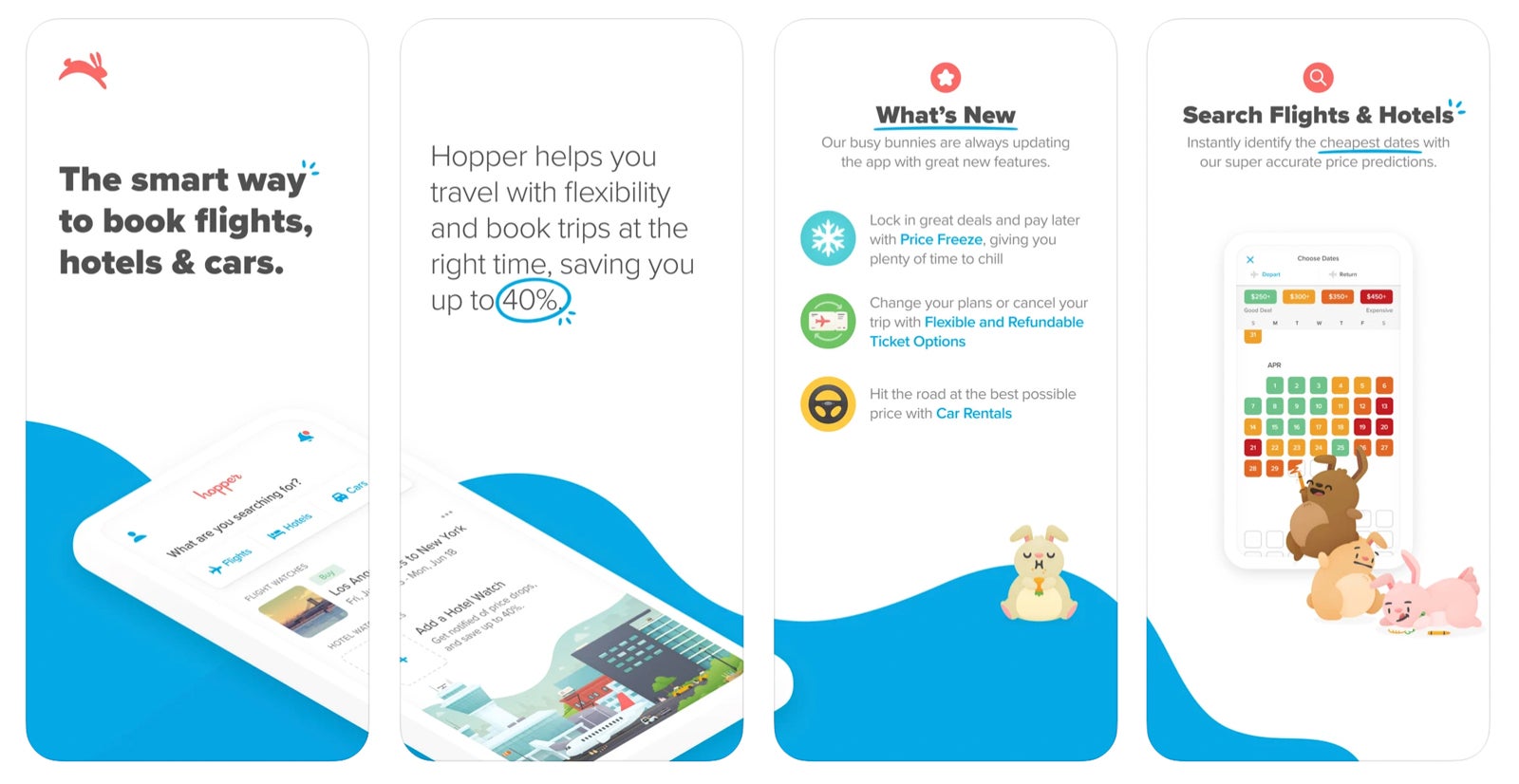
Hopper has changed in recent years from just offering a price prediction tool for flights to being a true online travel agency. The app helps travelers find the cheapest flights, hotels and rental cars.
Of course, Hopper also still offers its signature price prediction technology to help you plan out when to book, as well as travel protection options and a price freeze to help you lock in the lowest possible price on hotels and flights.
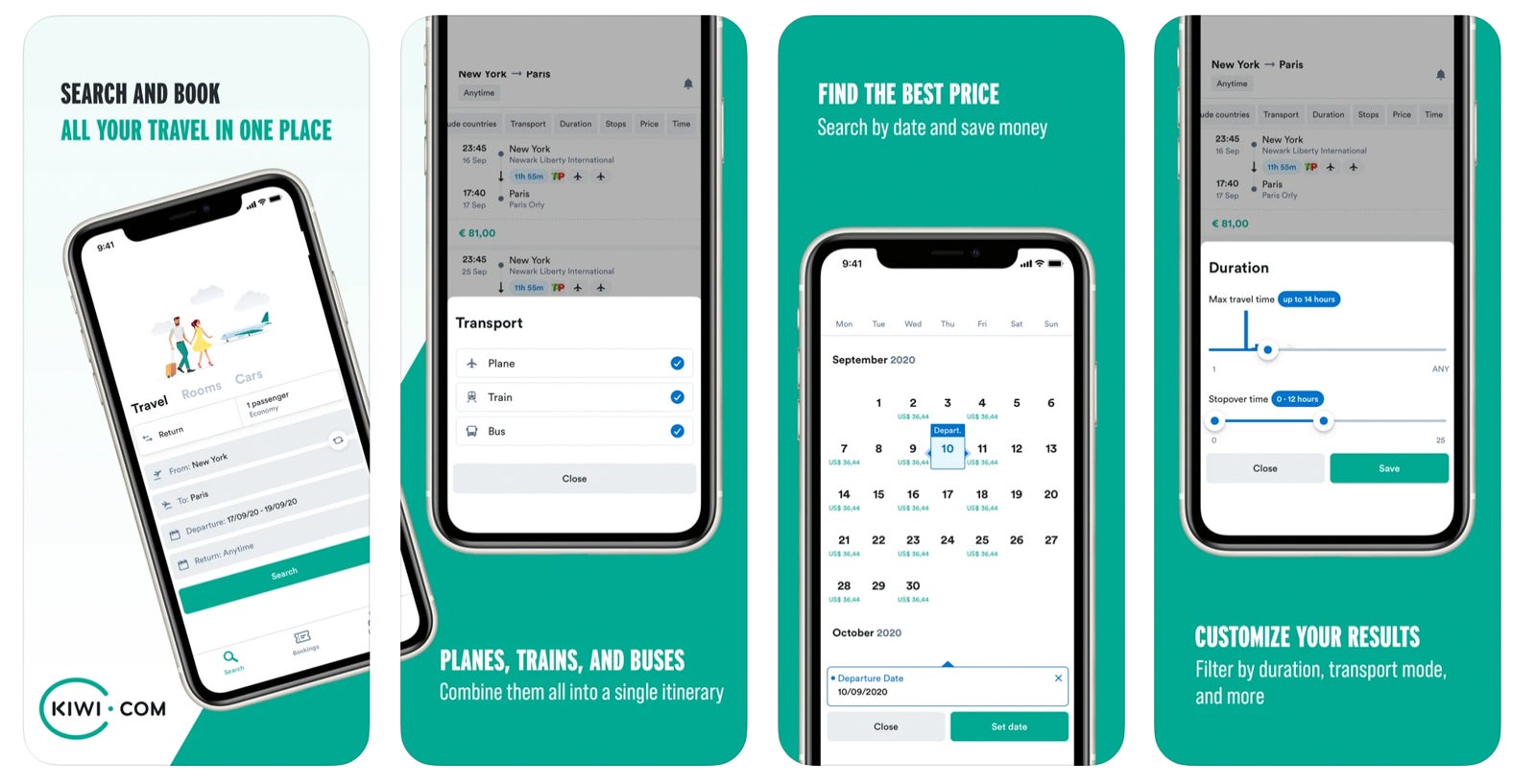
Kiwi is used mainly to book flights, but it also helps you book hotels (using its partnership with Booking.com) and car rentals (using its partnership with RentalCars.com).
Some of the app's most interesting features include the "Deals" section, which pulls in discounted flights, and the "Travel hacks" section, which includes options for hidden city ticketing, throwaway ticketing (making one-way flights more affordable) and free price alerts.
Hotel Tonight
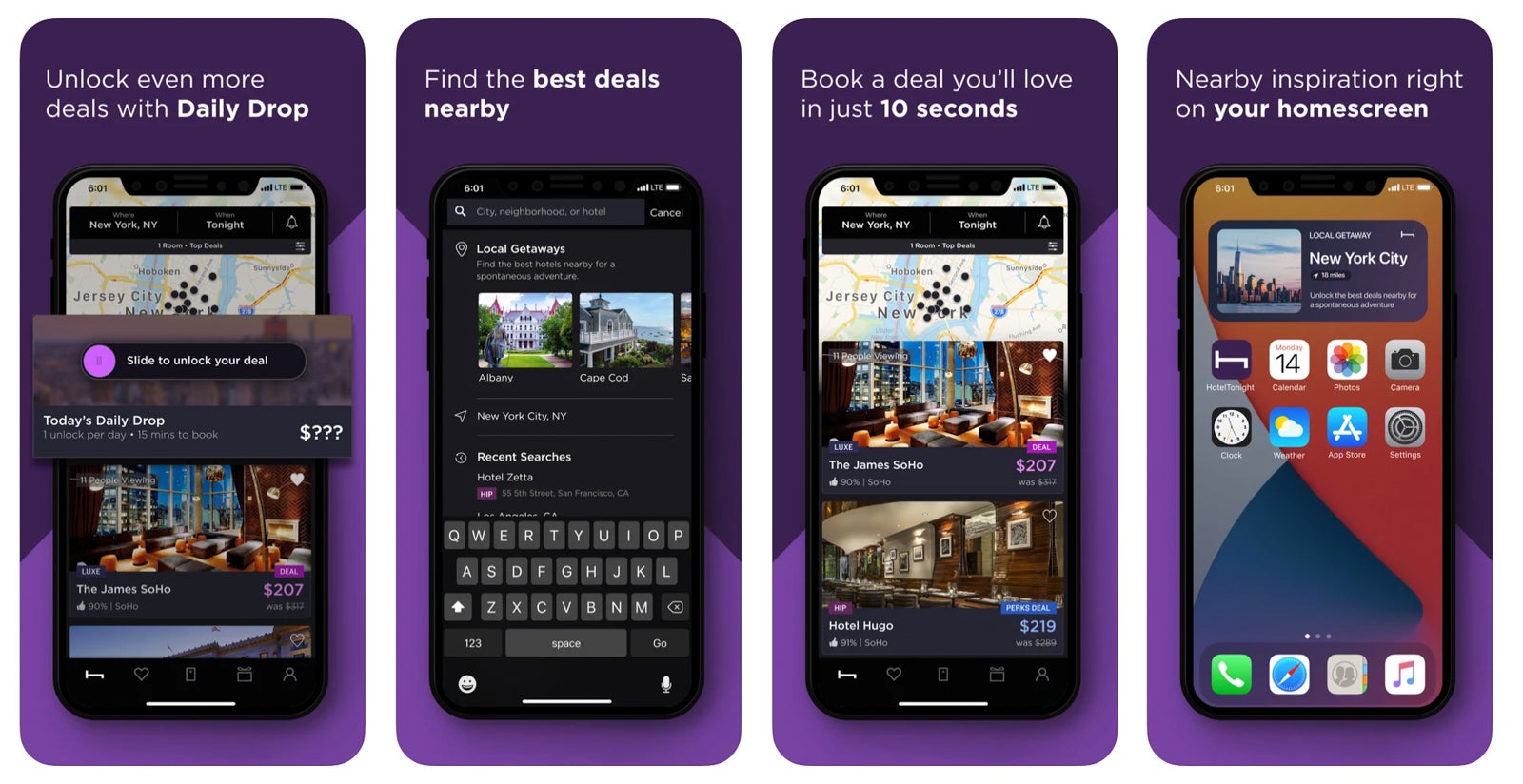
A dream for last-minute travelers, Hotel Tonight ( now owned by Airbnb ) lets you book stays for the same evening up to a few months in advance in thousands of cities worldwide. Available hotel rooms are categorized into sections like basic, luxe, hip, charming and solid, so you can select what works for your vibe. Take advantage of the daily drop feature, where you swipe to find a personalized deal with a special price only valid for 15 minutes after unlocked.
At TPG, we love a good loyalty program, and HT Perks, the app's nine-level reward program, is extensive. Not unlike a video game, you "level up" by reaching specific spending thresholds on the app, and you'll gain access to perks like discounts, VIP customer support and credits. Also, your levels never expire, so you can only continue to move up.
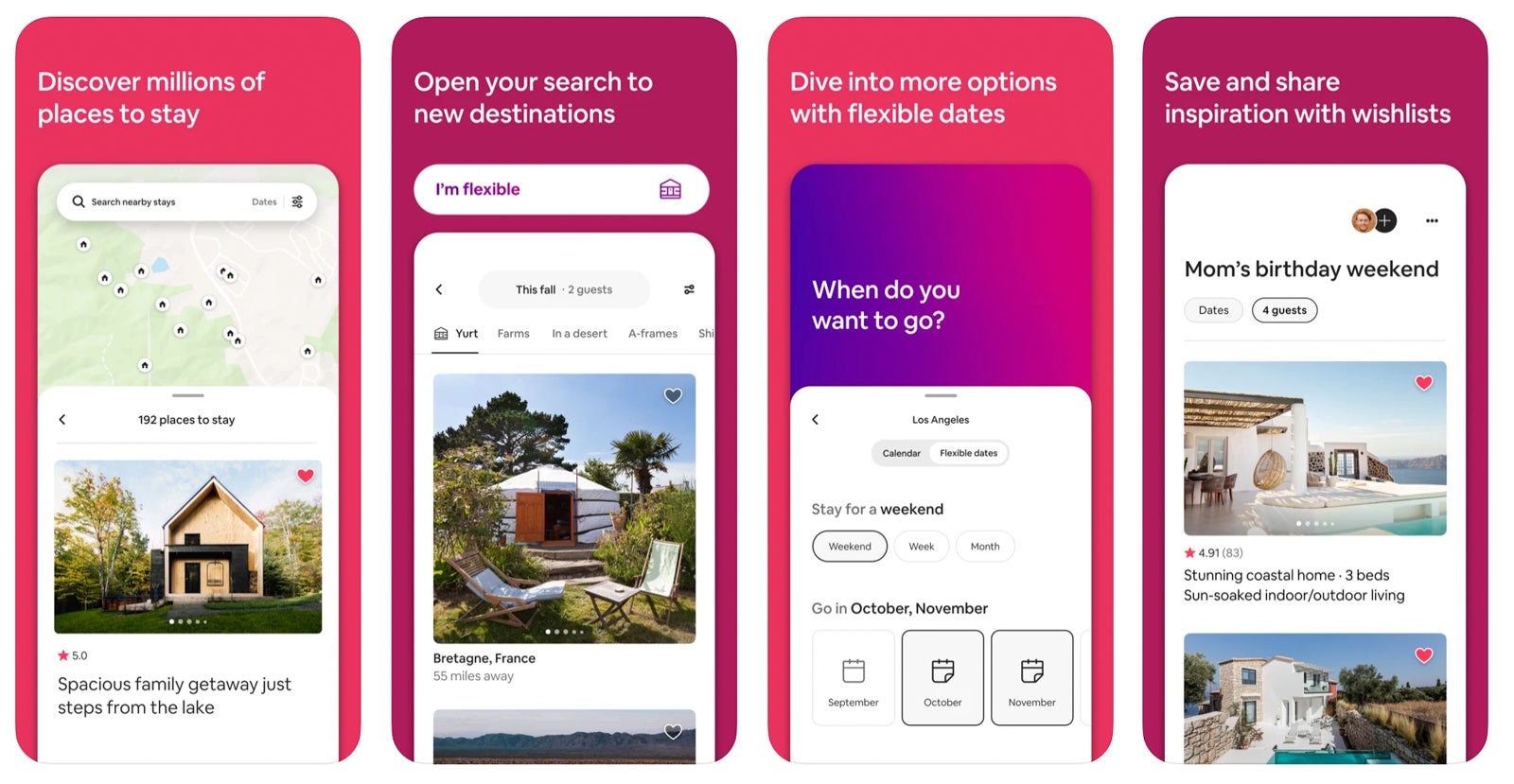
To book home rentals instead of hotels, use the Airbnb app. After entering your destination and dates, you can filter results based on the home type, price, requisite amenities and more. If you find something you like, you can book directly through the app.
The app is ideal for managing your trips while on the road — you can access all your bookings under the "Trips" tab, where you can view your reservation (and the address or directions), contact the host or change your reservation. Once you have a booking, you can also explore and book local experiences in your destination, such as wine tastings, kayak tours, hikes, shows and concerts.
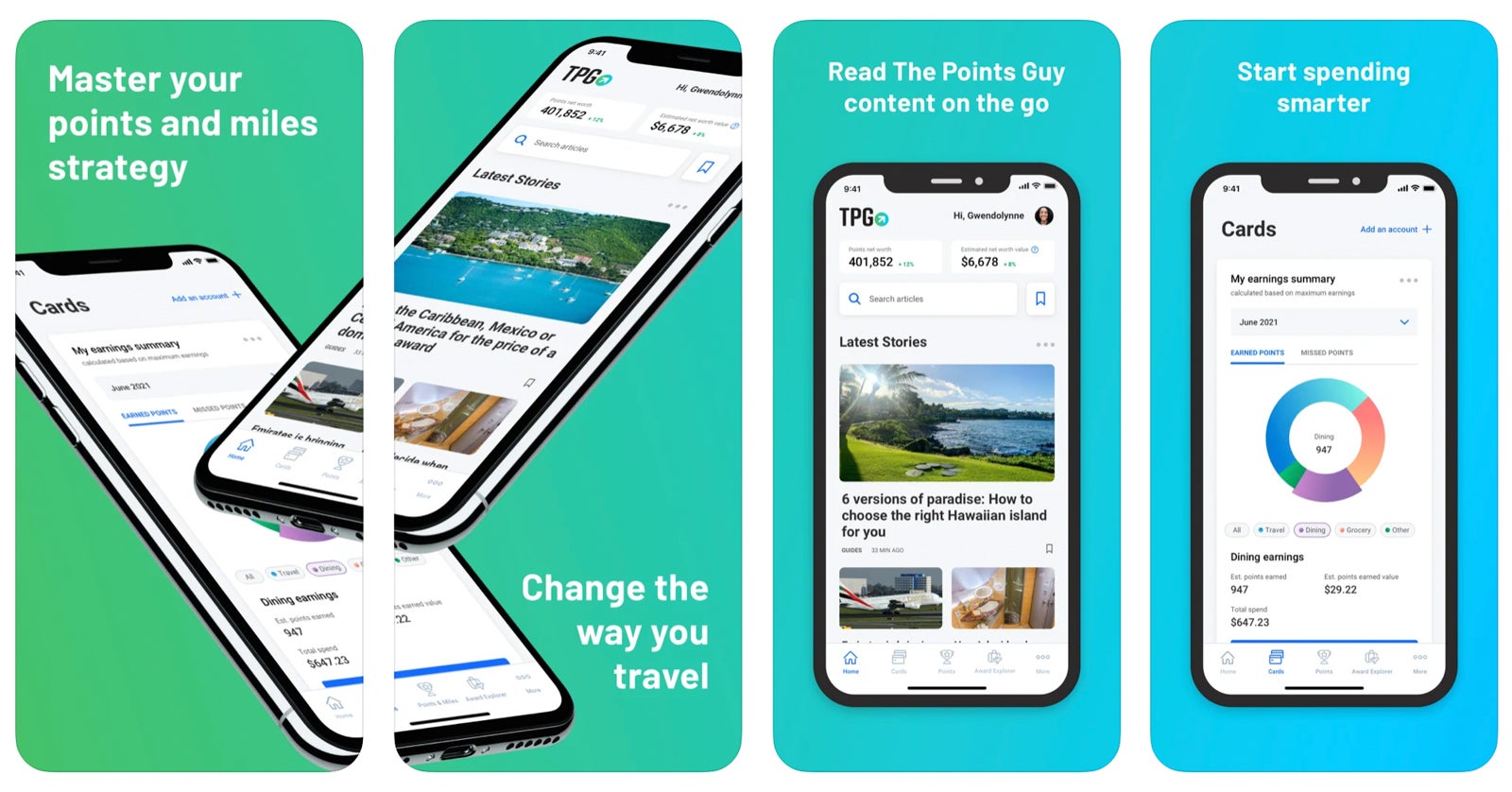
We can't talk about travel apps without mentioning the TPG App. Use it to track your credit card, airline and hotel points balances; earn points and miles efficiently through using the right credit card ; and research how many points or miles you'll need to book your dream getaway. You can even curate your own news feed so you see the news and advice that matters most to you first.
The TPG App is available for download on iOS . Android users can join the waitlist here .
Related: The TPG App has arrived — here's why you should download it now
Best apps for organizing a trip
From keeping all your documents in order to perfectly packing your suitcase without forgetting a thing, these are the best apps for organizing travel plans.
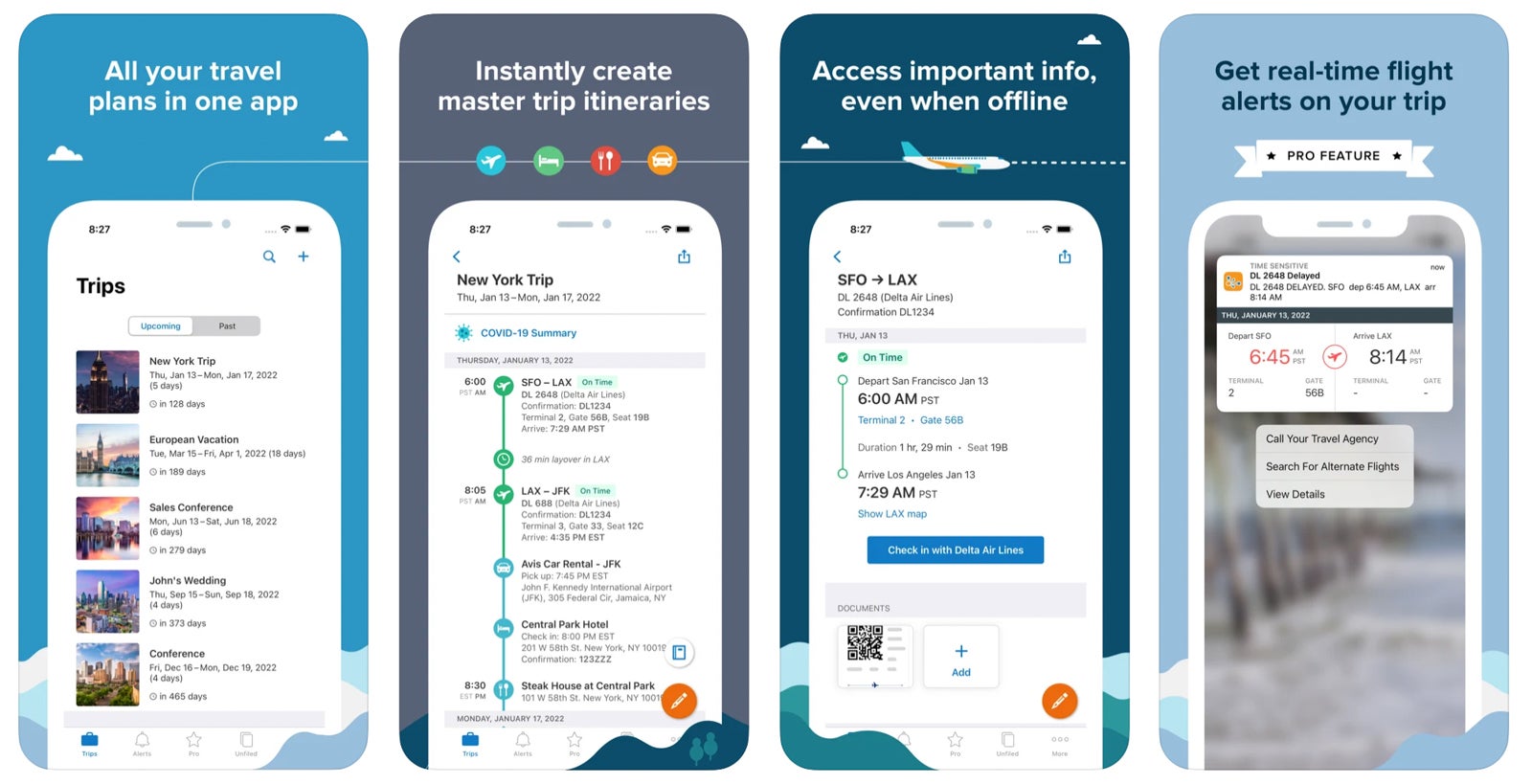
TripIt declutters your itineraries and documents by keeping them organized in one place. You can set your reservations to automatically send to TripIt, which lets you view travel confirmations, flight itineraries, tickets, hotel and Airbnb booking information, rental car reservations, ferry tickets and driving directions without ever leaving the app.
TripIt also makes it simple to share your trip plans with whoever picks you up from the airport or train station or anyone else who may need to coordinate with you. TripIt Pro subscriptions cost $49 per year and include extras like real-time flight alerts, security wait times, baggage claim information and updates on your loyalty reward programs.
Roadtrippers
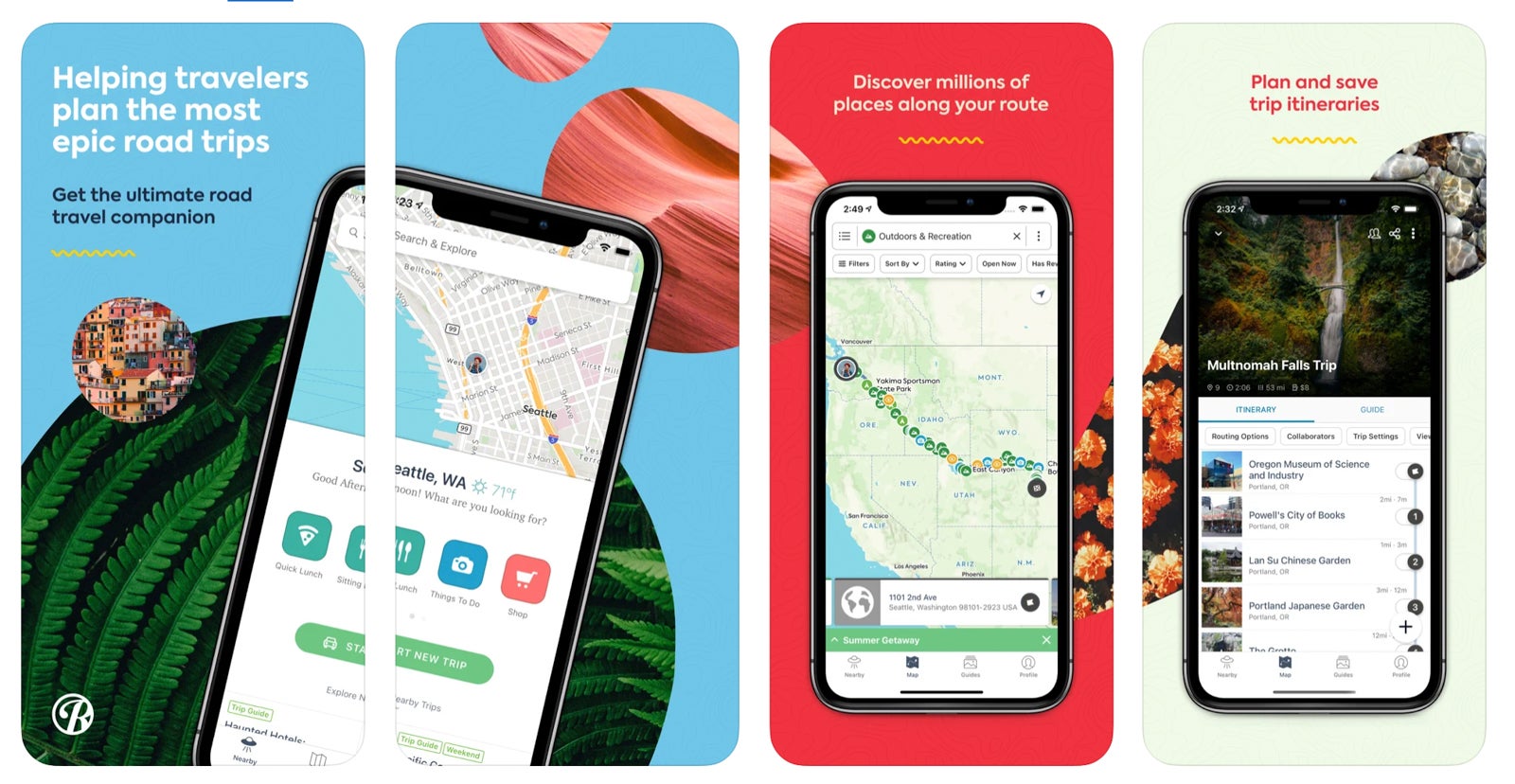
Perfect for organizing that epic road trip you've always wanted to take, Roadtrippers plans out your driving route and lets you book hotels and activities along the way. The app is especially useful for finding interesting and off-the-beaten-path roadside attractions, cool restaurants and can't-miss landmarks you can bookmark.
A Roadtrippers Premium membership includes offline maps, live traffic information, overnight RV parking and more for $59.99 per year. For those looking to only venture on a few road trips per year, the app also offers a Pro ($49.99 per year) and Basic ($35.99 per year) membership.
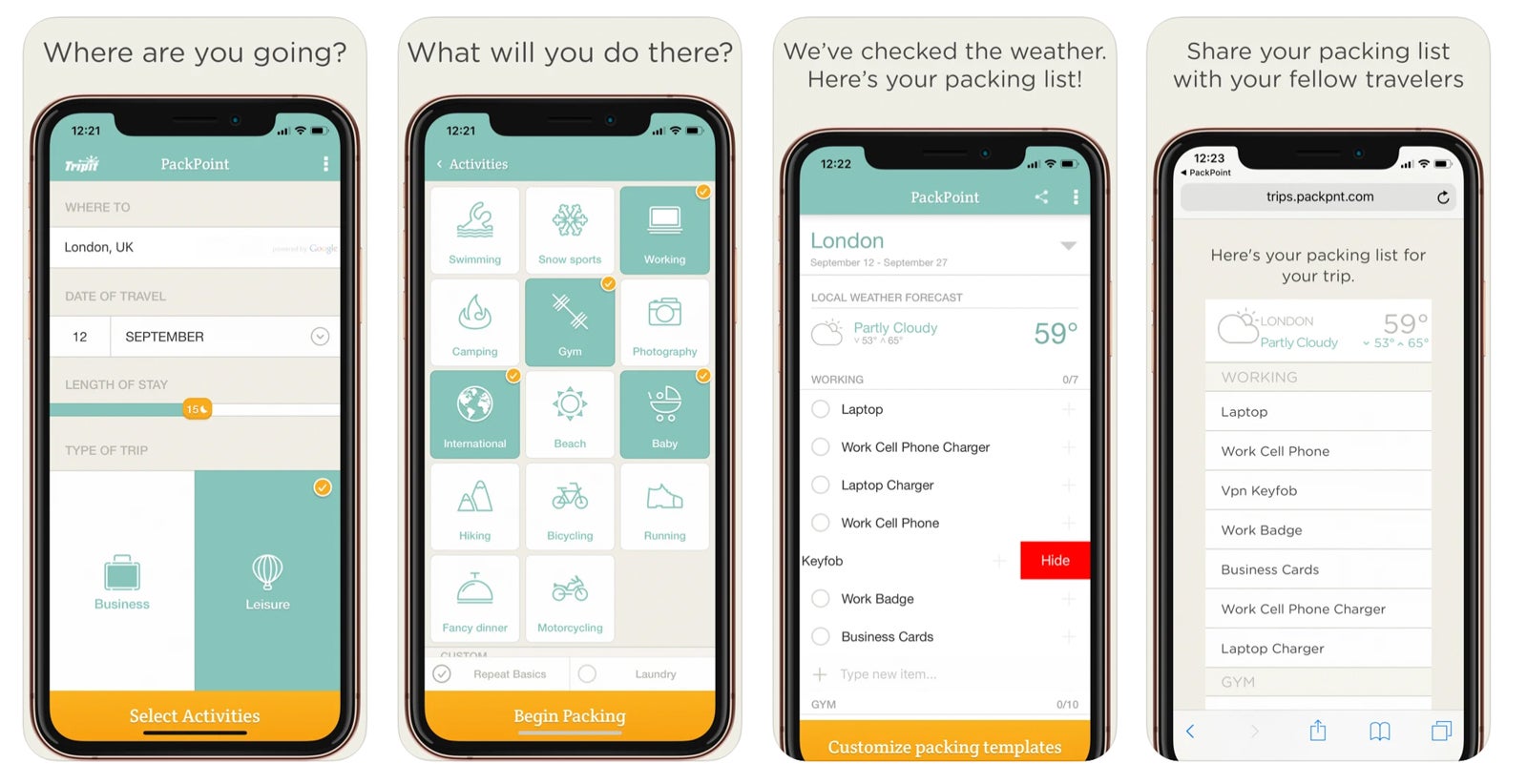
PackPoint takes all the stress out of packing . The app shows you what to bring based on the length of your trip, the weather in your destination and any activities you're planning along the way. If you have access to laundry facilities at your destination, PackPoint even allows you to account for washing your clothes and wearing them multiple times.
Just download and install the app, type in the city you're visiting and plug in your travel details. So, stop waiting until the day before your trip — or the hours before you have to leave for the airport — and start packing now.
Best apps for navigating the airport and flights
Track flights, navigate airports and find airport lounges with these apps.
LoungeBuddy
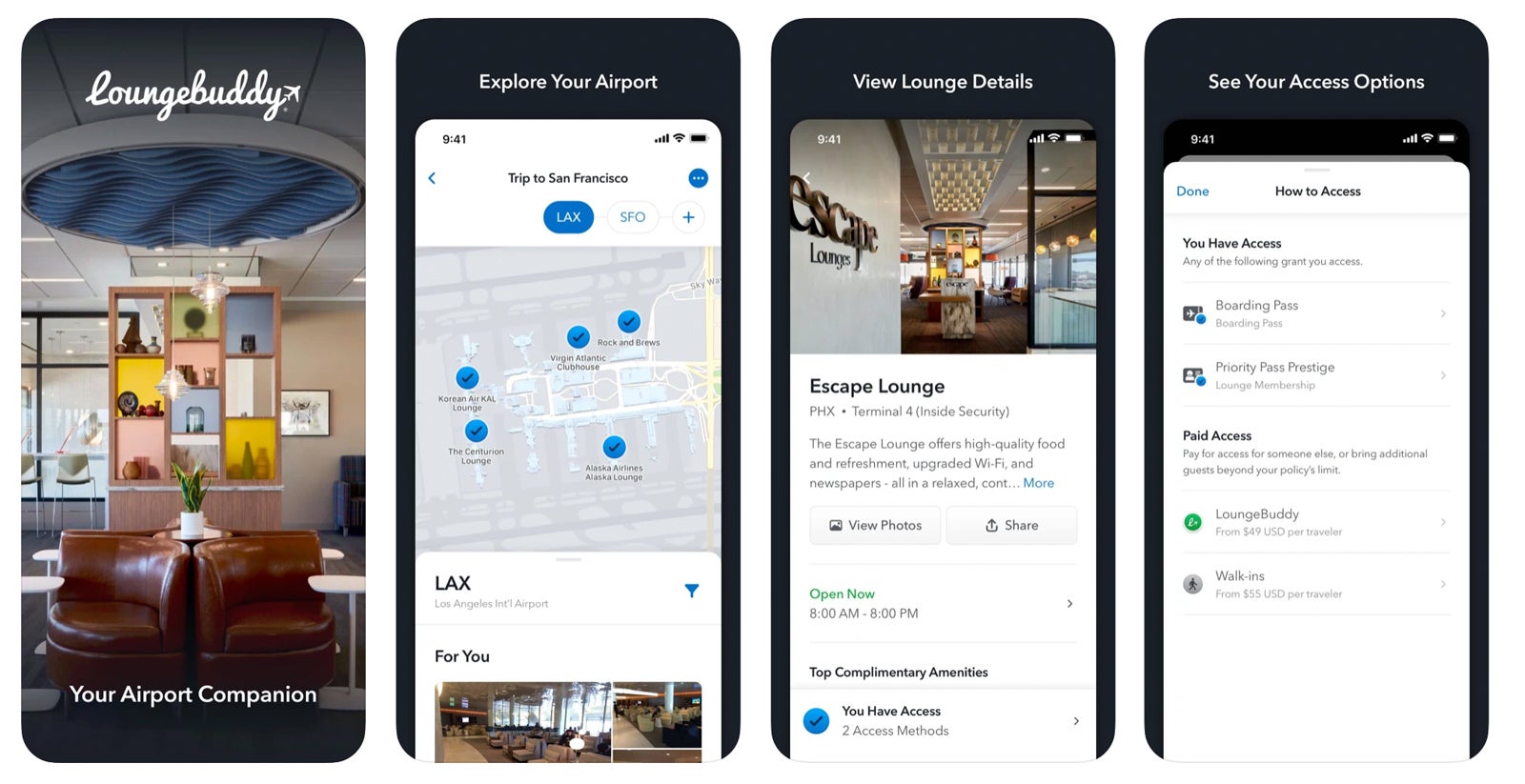
LoungeBuddy offers access to premium airport lounges around the world, regardless of the airline or class you're flying. When you create a trip in the app and type in the credit cards you currently hold, it will tell you which lounges you have access to based on the airports you'll be transiting through and how to purchase access if you don't already have it.
You can purchase access on the day you're traveling or up to two months in advance if you're the plan-ahead type. If you prefer to search by lounge or lounge program, the app will tell you exactly what is needed to use them.
Priority Pass
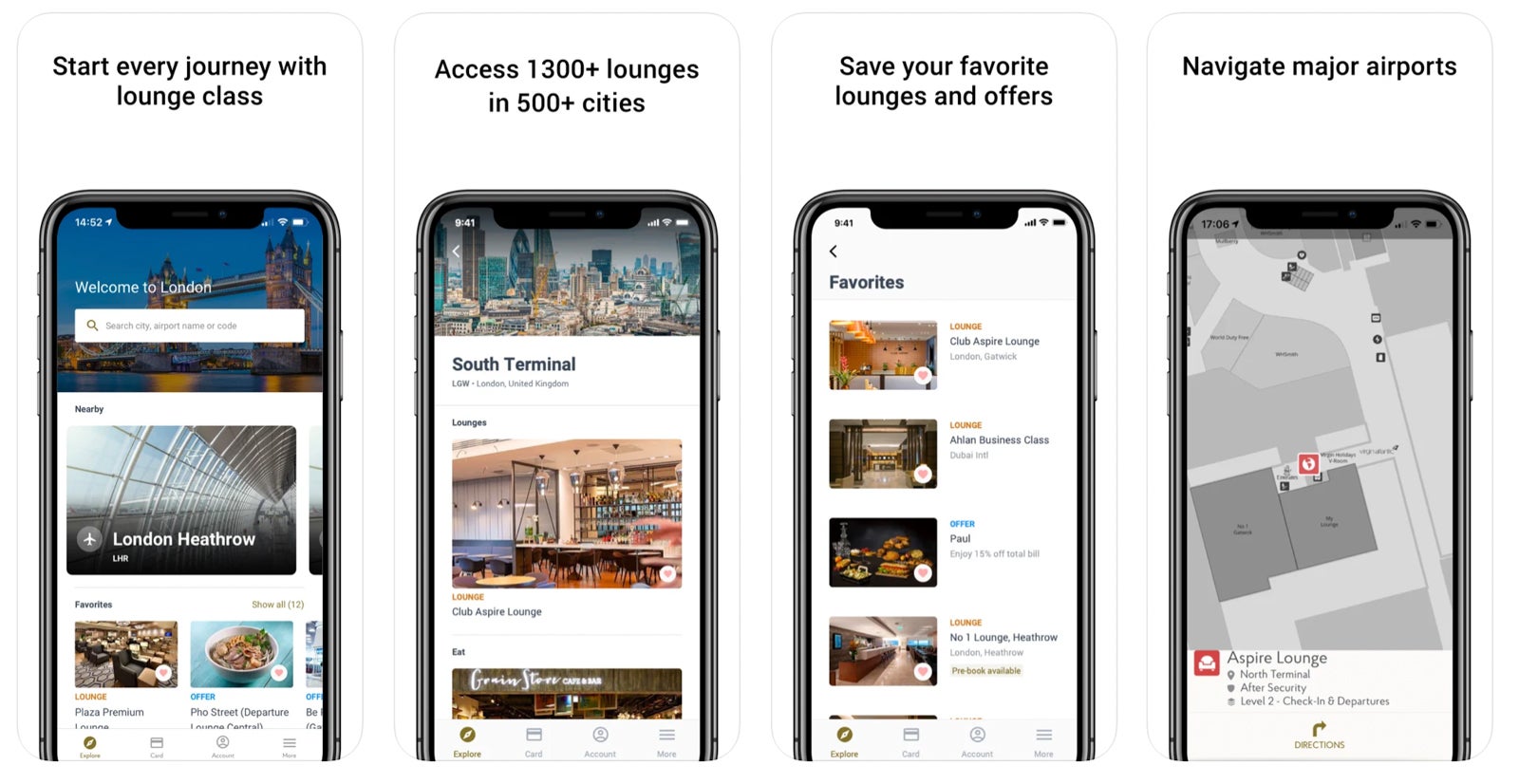
Priority Pass offers access to more than 1,300 lounges worldwide and provides meal vouchers at select airport restaurants across the world for an annual fee starting at $99.
Several cards, including The Platinum Card® from American Express , the Capital One Venture X Rewards Credit Card and the Chase Sapphire Reserve , offer Priority Pass memberships for all cardholders (enrollment required). Otherwise, you'll have to pay an annual fee to be a member and, depending on your membership tier, a fee to enter each lounge on top of the annual fee.
To use the Priority Pass app, enter the name or code of the airport you're in, and Priority Pass will pull up the lounges or restaurants that you have access to, including photos, hours, amenities and specific location information. For more information on the Priority Pass Program and how to gain lounge access, click here . Enrollment is required for select benefits.
Related: The best credit cards for Priority Pass lounge access
FlightAware
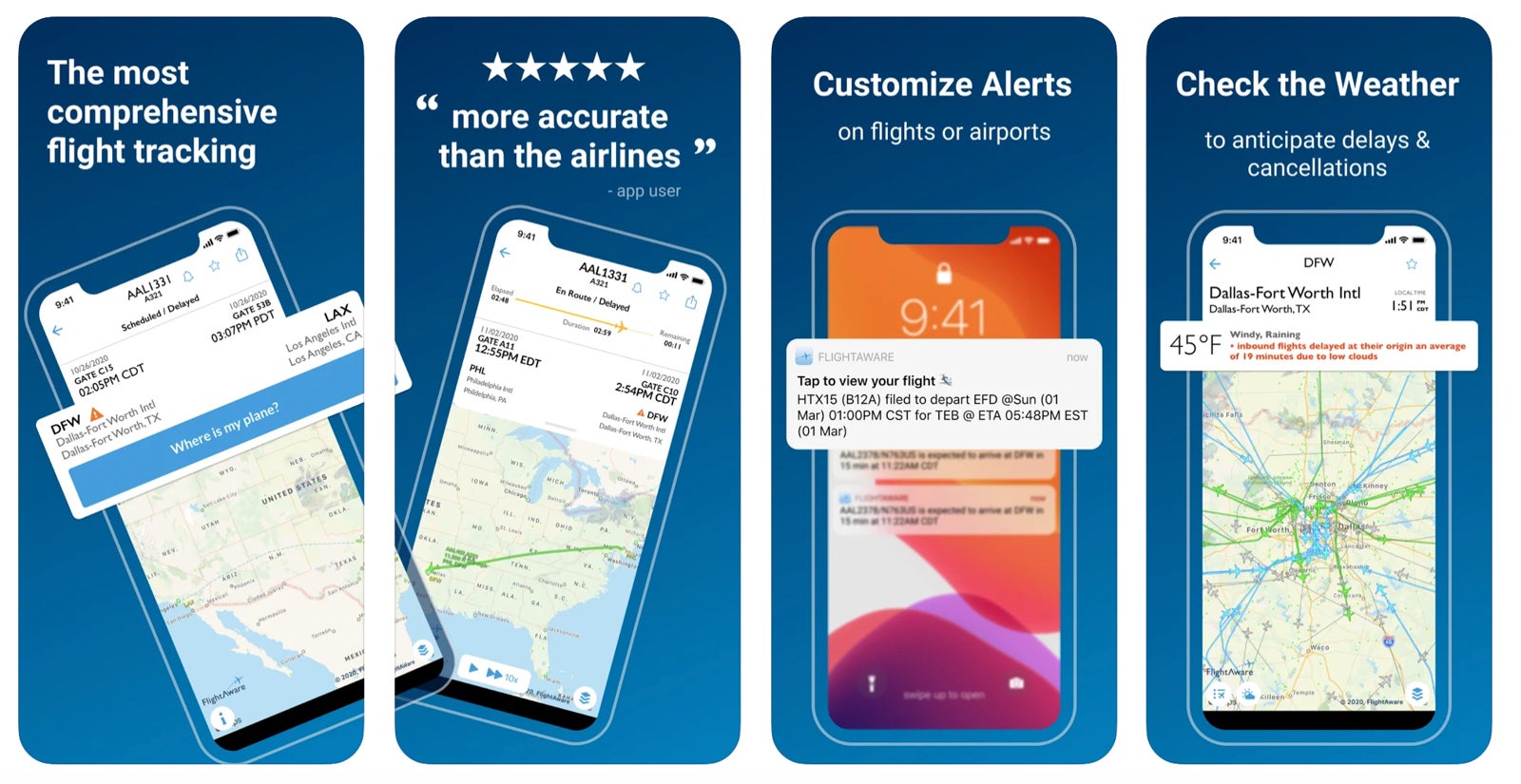
The FlightAware app allows you to track flights online, see a live map of a flight and check on delays, cancellations and gate changes. This app is especially helpful if you have a tight connection or want to track your flight.
It's also useful when picking up friends and family at the airport, as you can track their flight and see updated landing times or delays. AvGeeks will enjoy digging into flight statistics, flight maps and community aviation discussions on the app.
Best apps to use during your flight
Timeshifter.
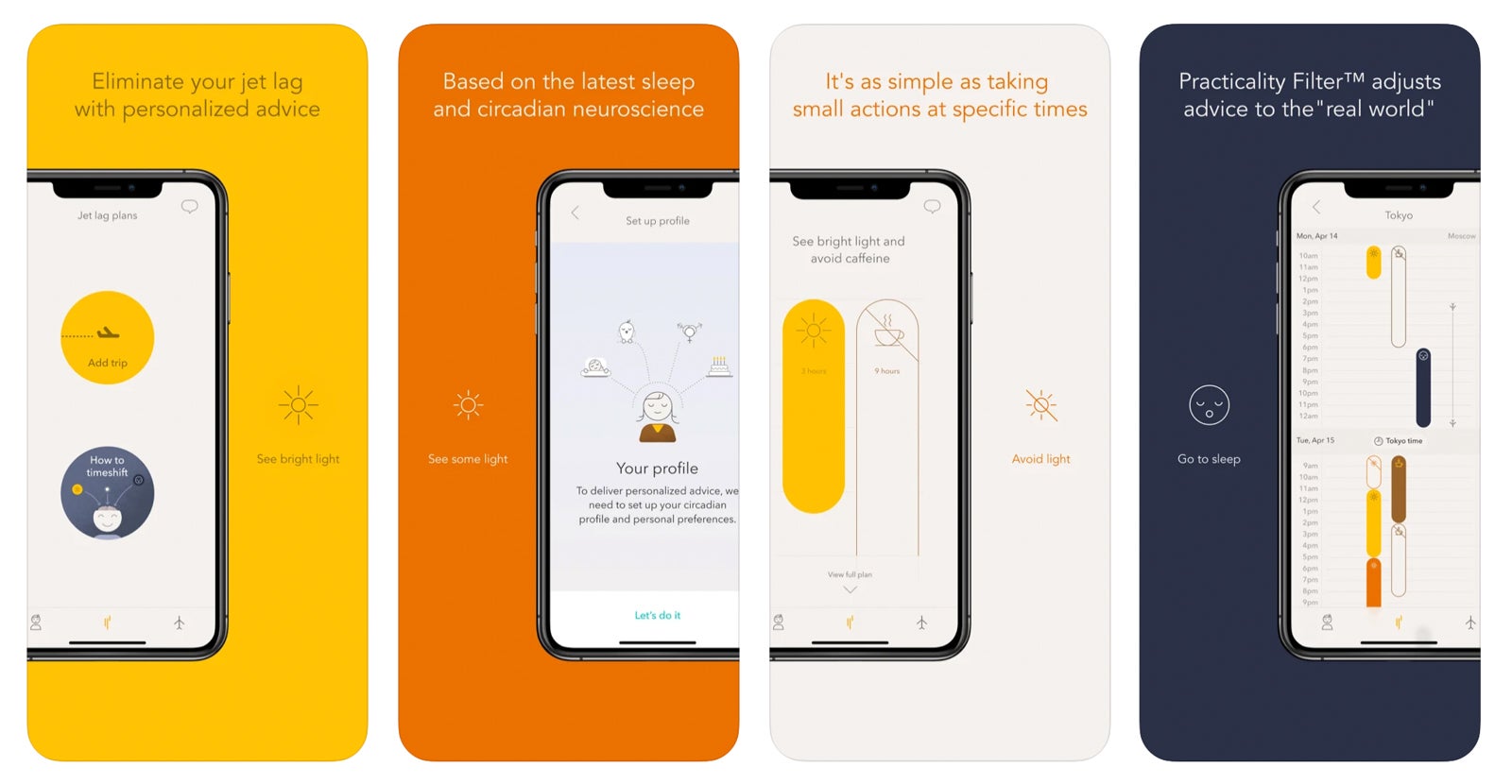
What better way to cure jet lag than with an app? Timeshifter actually helps you avoid jet lag long before your flight takes off and also offers inflight and post-flight suggestions. The app relies on neuroscience research about sleep and circadian rhythms to provide personalized recommendations, taking into consideration your age, gender and normal sleep patterns — as well as specifics about your trip and travel plans. Timeshifter maps out when you should avoid or seek light, take a nap or try to stay awake. It even tells you if you should consider supplementing with melatonin or caffeine.
Your first jet lag plan is free, then $9.99 per plan, or you can enjoy unlimited plans for a year for $24.99.
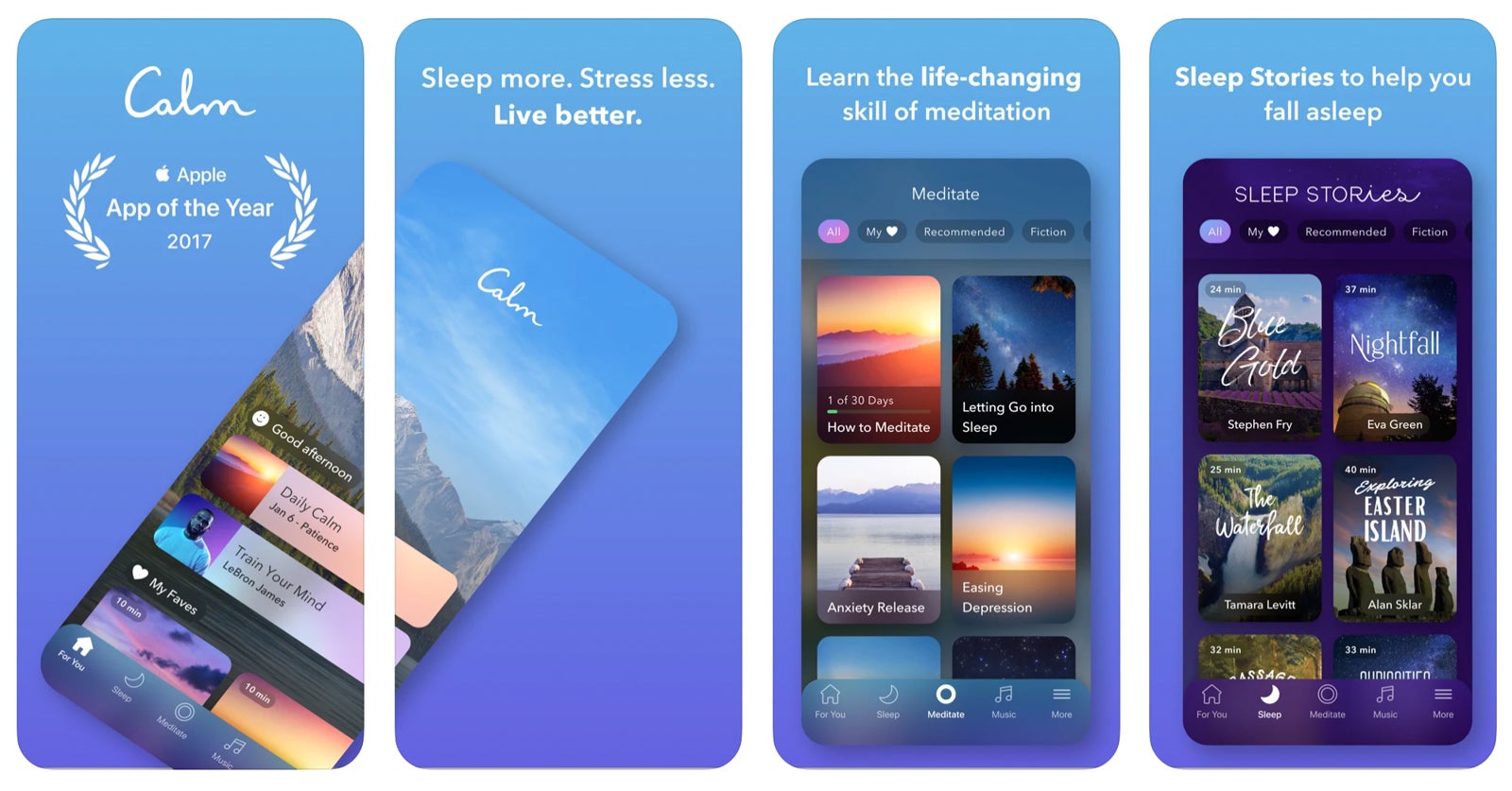
Flying can cause anxiety — or provide a welcome relief from constant contact with our digital devices. Either way, use travel as an opportunity to relax, meditate or listen to soothing sounds that will lull you to sleep or a deep, relaxed state. Or, perhaps, you'll simply find it helps pass the time during a long flight.
Calm offers meditations on topics such as self-awareness, calming anxiety, breathing, lowering stress levels and happiness, among others. The app also has music options for focusing, relaxing and sleeping, as well as stories for adults and content for kids.
A limited selection of meditations and music is available for free (which you can download to use when you're offline or in flight). The premium version of the app costs $14.99 per month or $69.99 annually.
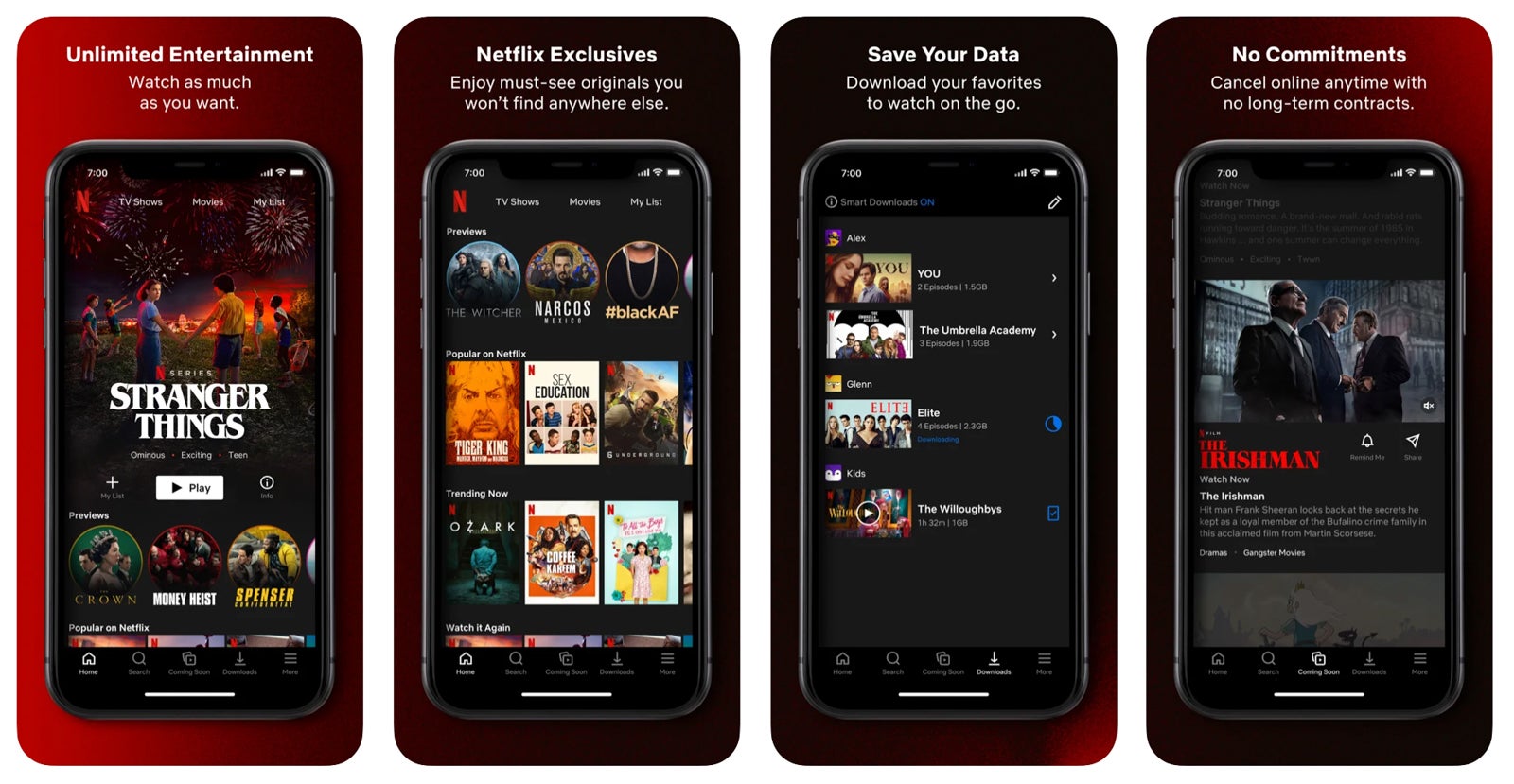
OK, so Netflix isn't really a travel app, but it can be a lifesaver during a long flight on an aircraft without seatback inflight entertainment or at the airport during an unexpected flight delay or boring layover. If you have a Netflix account, the app allows you to download your favorite shows onto your device to watch offline.
Just make sure to download your shows while connected to Wi-Fi before flying and check them again preflight to make sure they haven't expired (you can usually renew any expired downloads, but you must be connected to Wi-Fi or data to do so). Monthly prices vary depending on the plan.
Another app that's not really a travel app, Spotify can still be incredibly useful during tedious travel moments — just pop in those noise-canceling headphones and listen to your favorite music, meditations, podcasts and more.
The app's Premium plans (prices vary) allow you to download all your content offline on your phone, so you'll have it during long flights or when you don't have data or Wi-Fi access. Whether you want to take a morning jog in Bali to your favorite tunes or pass the time with a podcast on the metro in Barcelona, Spotify has it all.
Best apps to use in your destination
From exchanging money and sightseeing to communicating and knowing all the local tips and tricks, you don't want to land in a foreign city for the first time without these key apps.
XE Currency Converter
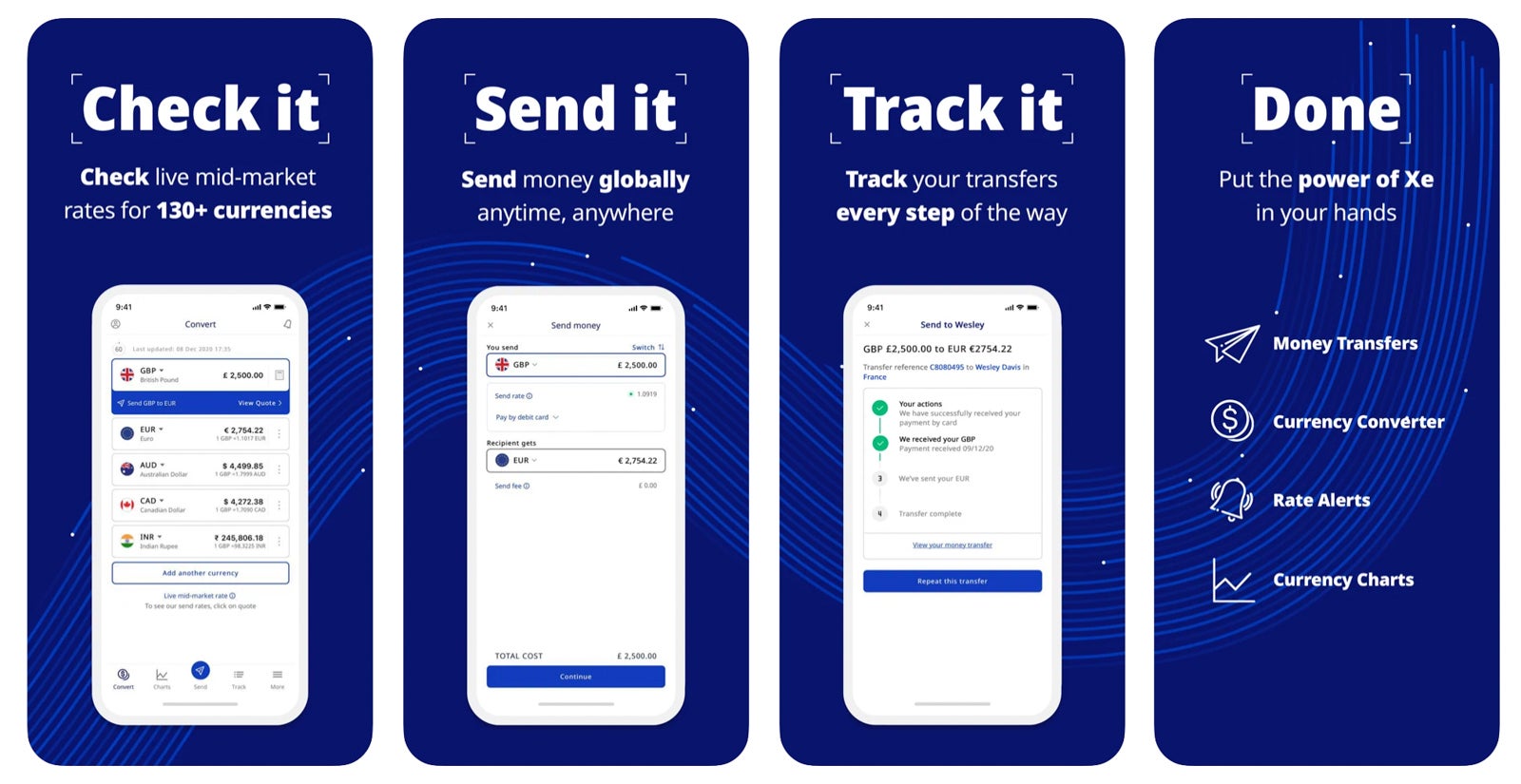
The XE Currency Converter app quickly provides live, up-to-the-minute currency rates, then allows you to store and view them even when you're offline. You'll never need to wonder if you're really getting a good deal in another country if you have this app.
Google Translate
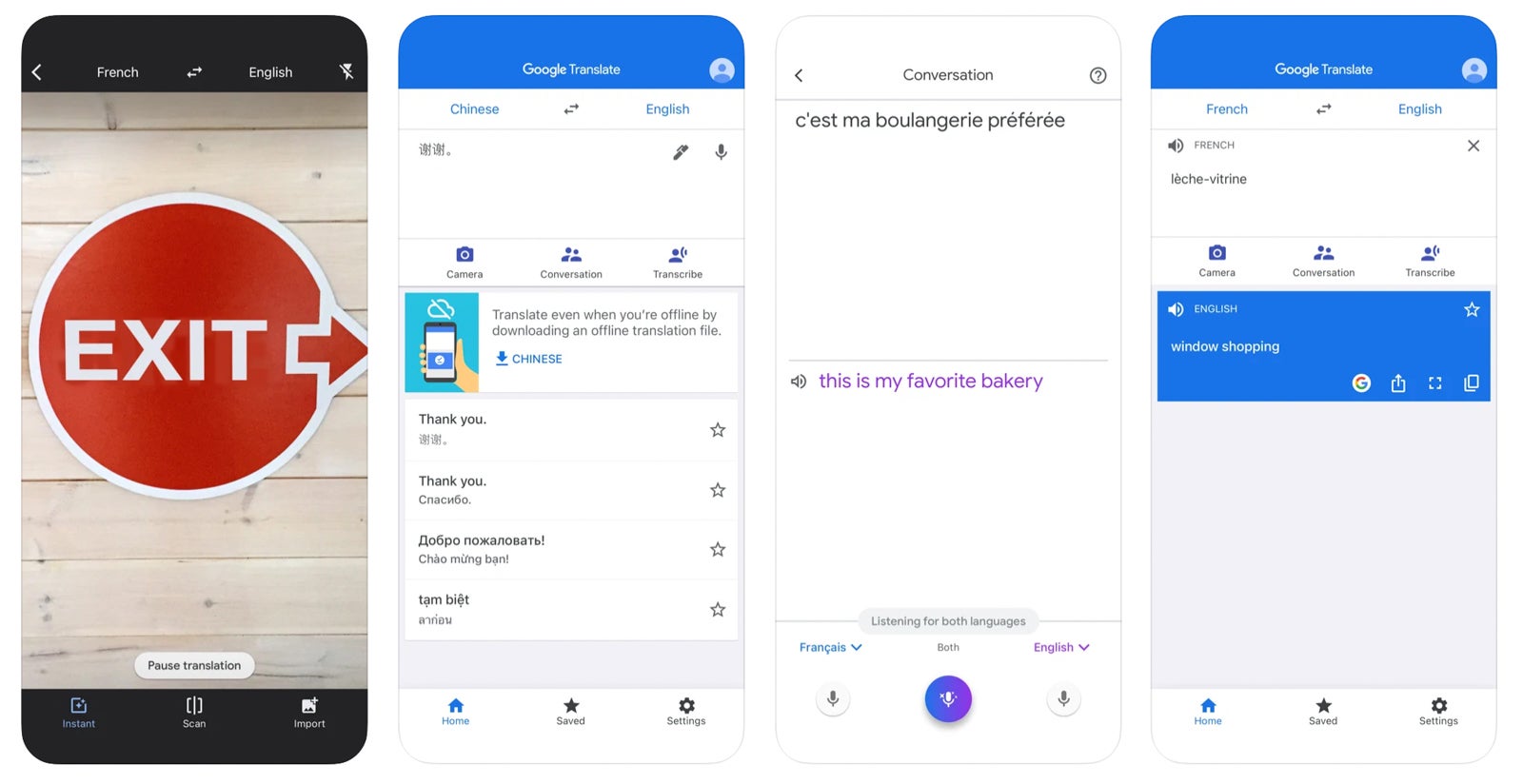
Google Translate is a translation app that allows you to do it all — translate into more than 100 languages by typing, access 59 languages offline, translate via photo, translate bilingual conversations and even use the handwriting tool to translate.
The app is simple to use, too, with icons at the top you can click on to draw, take a photo, speak or type.
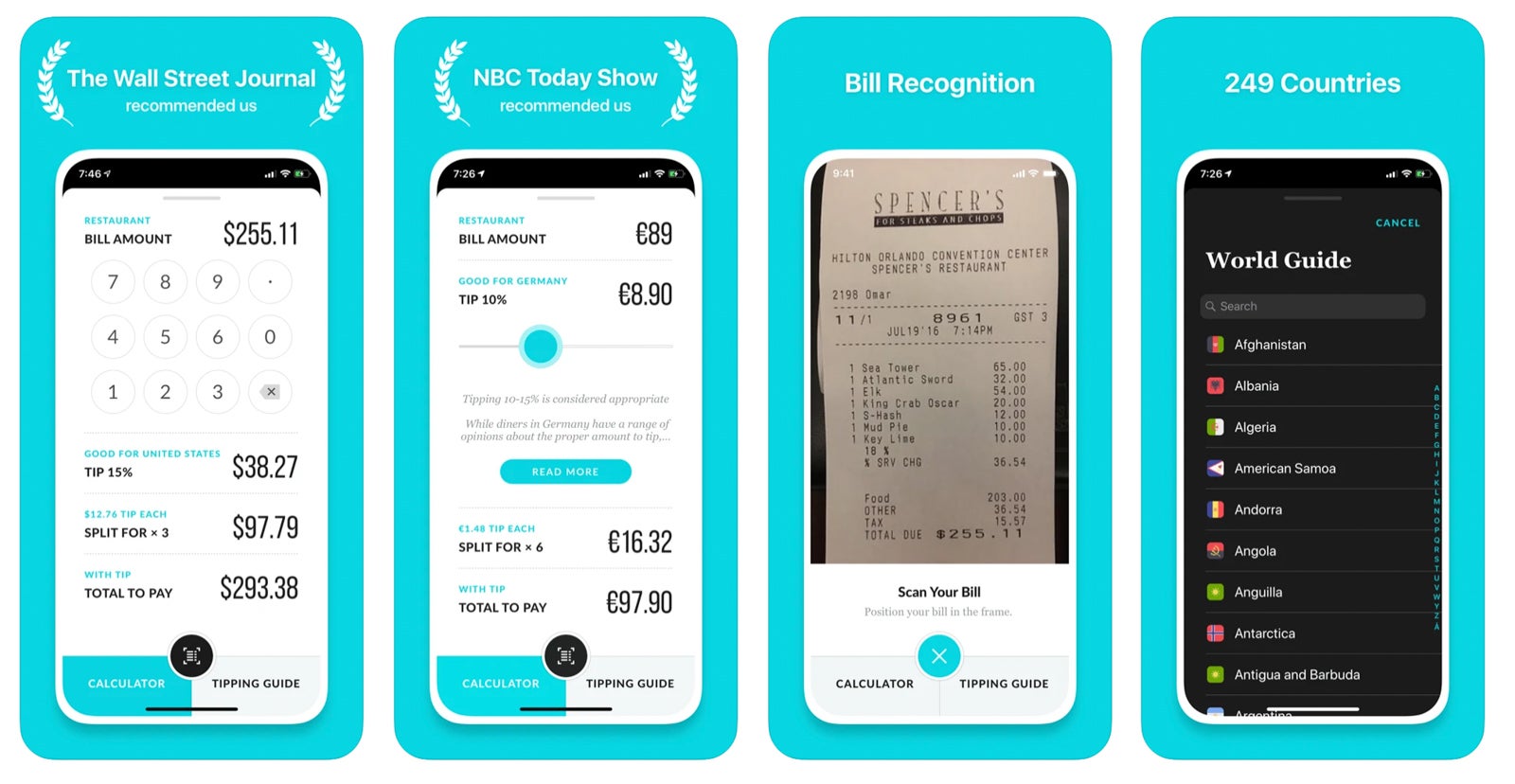
Not quite sure how much to tip when traveling internationally? GlobeTips will advise you on how to tip appropriately in more than 200 countries. It also offers a tip calculator for easy math. Globe also has apps for currency conversion, unit conversion and more that may be useful for travelers.
Related: The ultimate guide to tipping while traveling
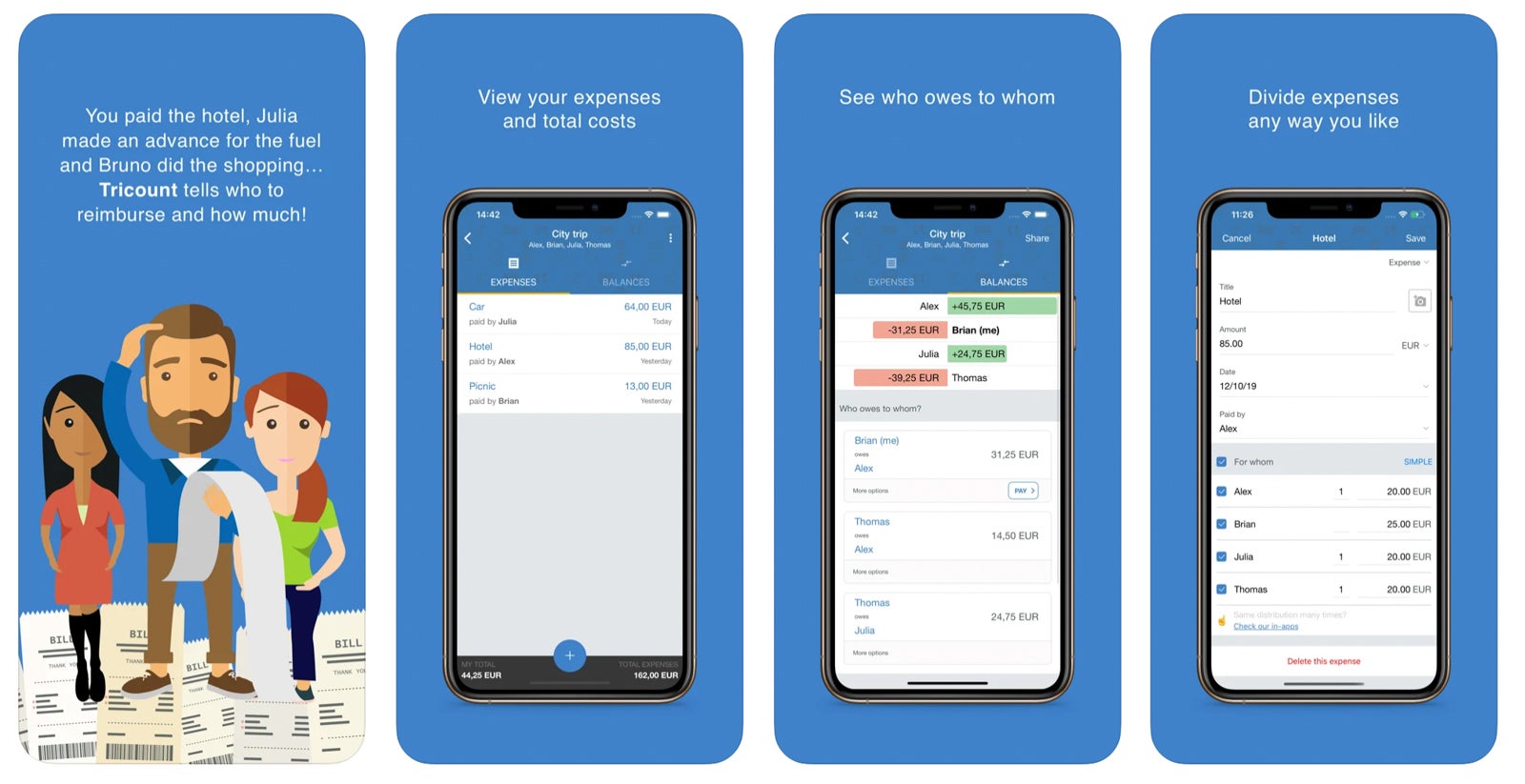
For travelers globe-trotting with friends and family members or simply splitting the cost between groups, Tricount calculates shared costs and splits bills so you don't have to think twice about who owes what. Just enter your trip and currency and invite your travel mates to join your trip.
Each time someone pays for something, you enter the amount in Tricount, and the app splits everything up. You can also snap and store photos of receipts in the app. At the end of your trip, it will show the balances of who owes who what, making it easy to settle up.
Metric Conversions
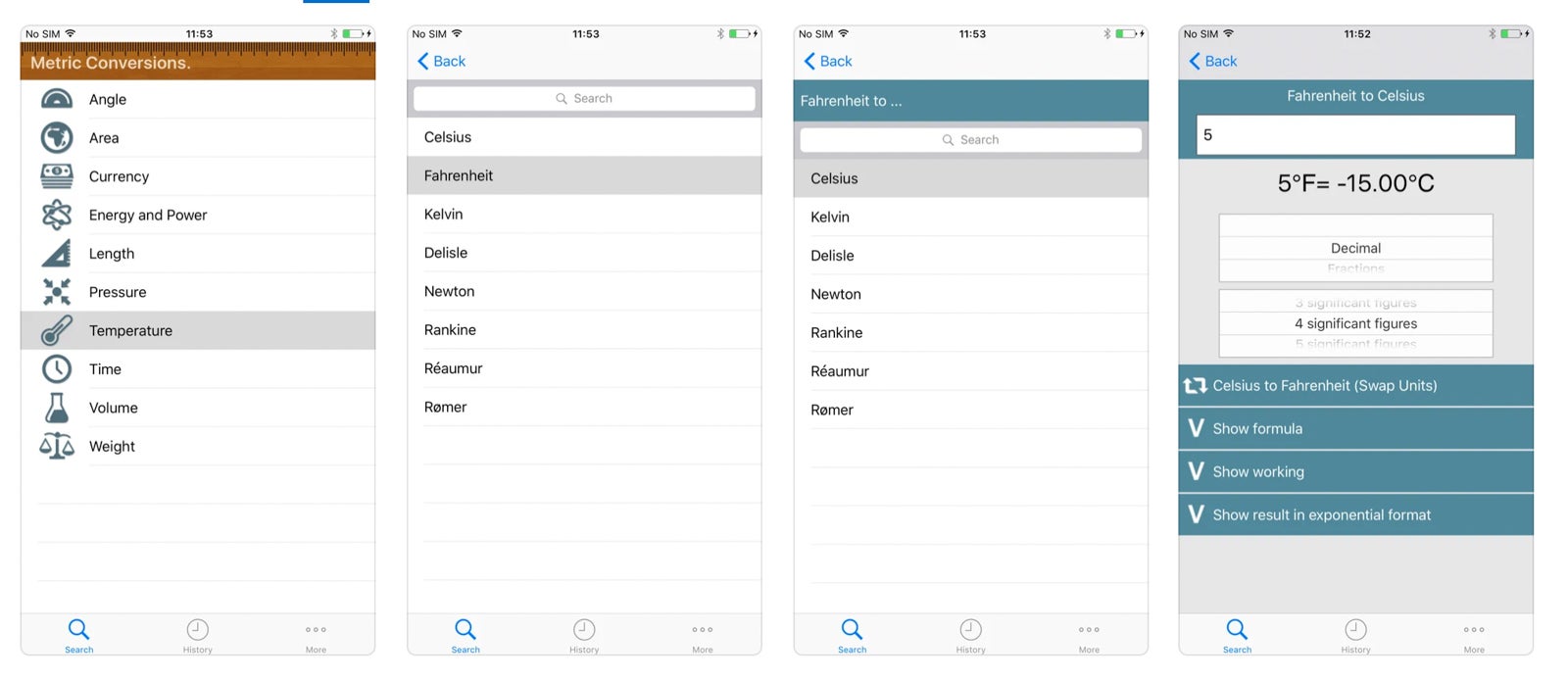
Never be baffled by Celsius temperatures or suitcase weight in kilograms again with the Metric Conversions app . Whether you're measuring flour to cook at your Airbnb, figuring out distances for your Europe road trip or deciding whether to take a sweatshirt with you during your walking tour of the Great Wall of China, this app has you covered with easy conversions in volume, weight, temperature, area and more.
Google Maps
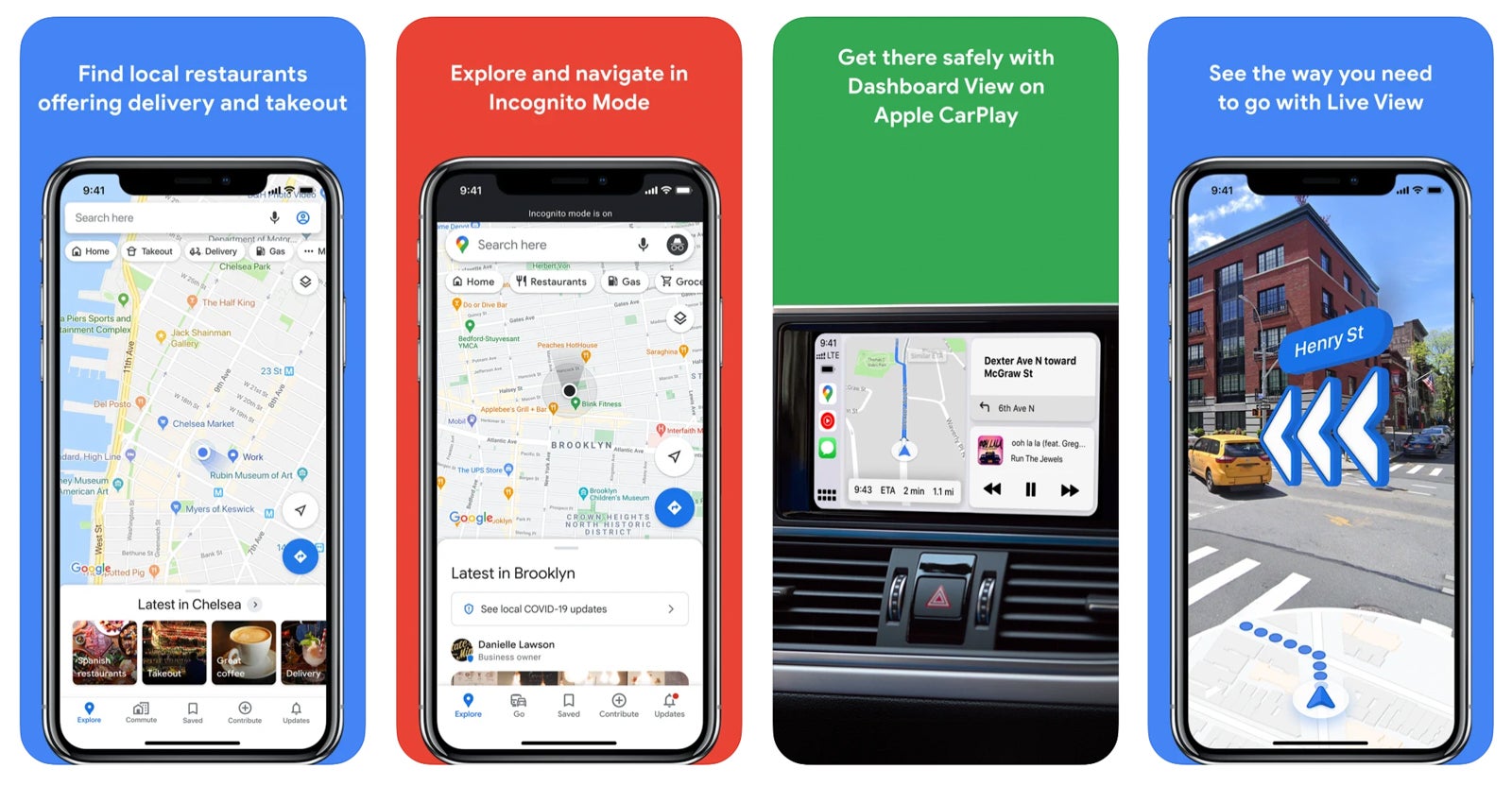
Google Maps is essential when visiting a new city (or even for getting around your hometown). You can map locations, get directions (walking, driving, public transportation, ride-hailing services and beyond) and see how crowded your subway will be in select cities .
You can make restaurant reservations, save your favorite spots and read and write reviews of attractions, eateries, shops and more. Make sure to download specific city or area maps ahead of time for offline access if you know you'll be without internet at your destination. For obvious reasons, the app works best when your GPS is turned on.
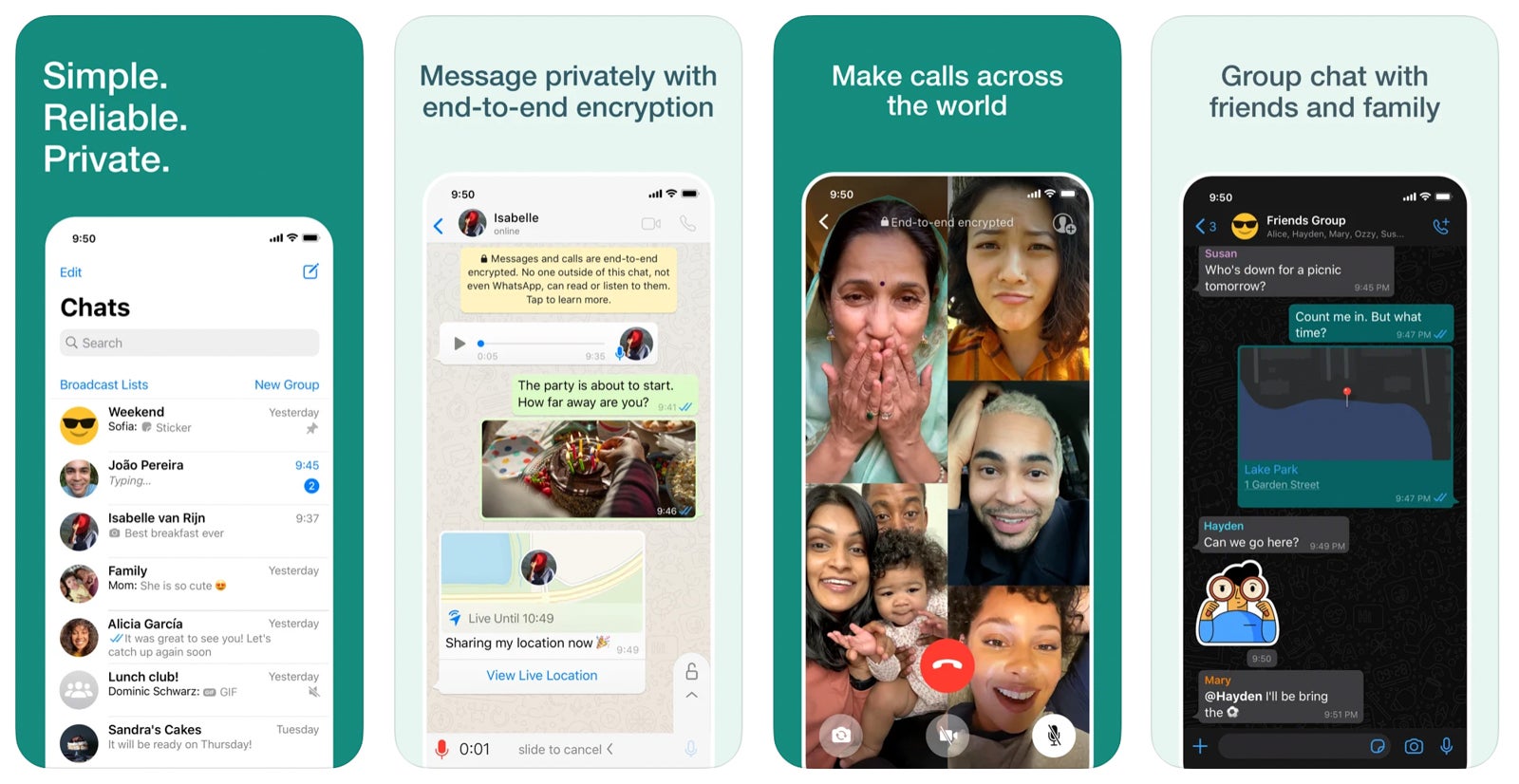
WhatsApp is a handy messaging service for travelers abroad as it uses an internet connection to avoid SMS fees.
It works like most other messaging apps: You start by creating an account, then add your friends and family members to contact and voila! You're able to call, video chat and send messages, images, voice memos, gifs and files just as you would in, say, iMessage (but with Android users too). You can also download WhatsApp on your Windows or Mac computer.
Best apps for planning activities
Traveling is about more than just getting from point A to point B. If you're looking for activities to add to your itinerary, check out these apps.
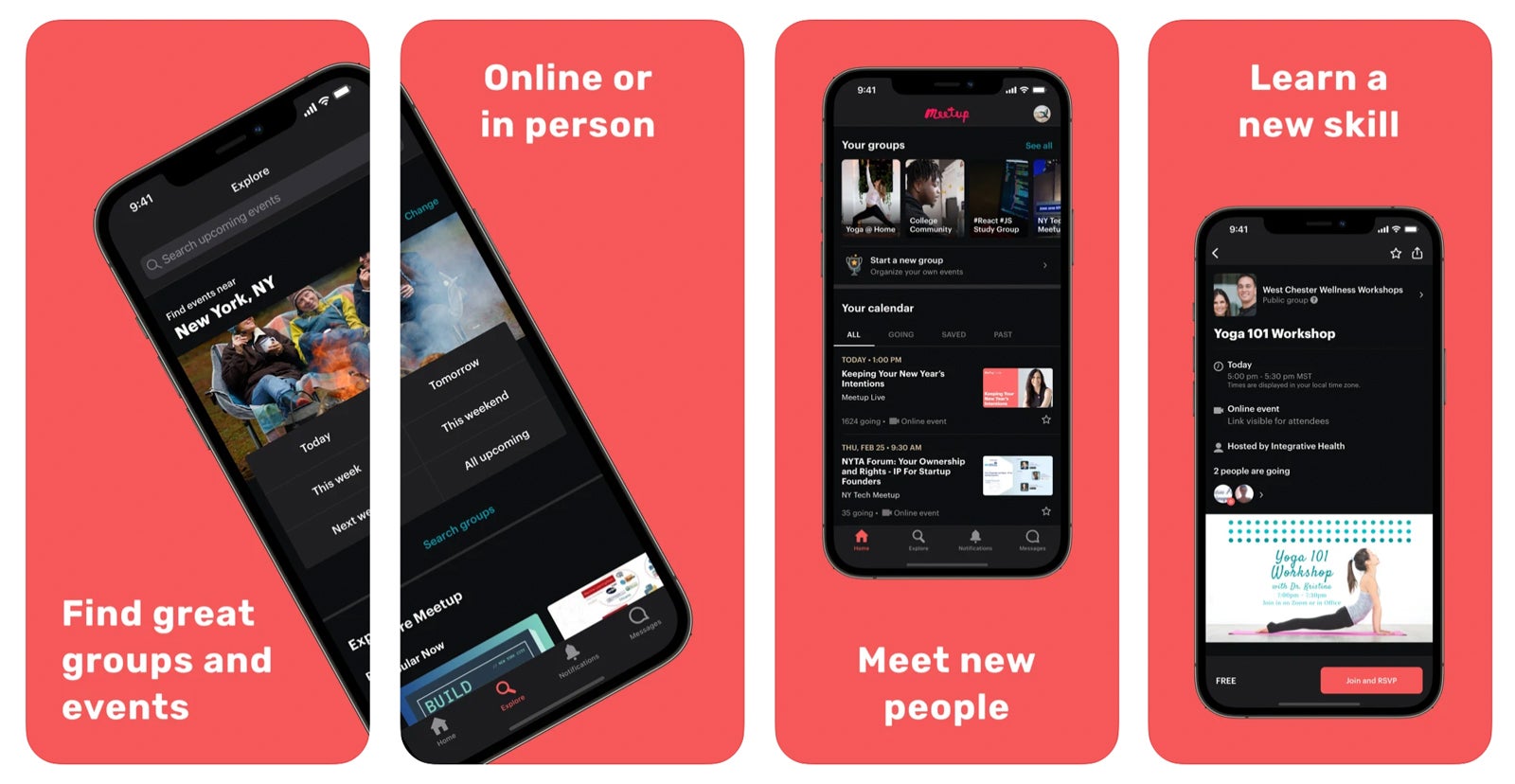
Meetup is an app designed for interacting with locals and other travelers who have mutual interests or shared hobbies. Whether you're traveling or at home, take what you love and do more of it with Meetup.
The app shows you groups that are formed around particular interests in your city, including yoga, photography, cooking, wine tasting, hiking, cinema and other activities. You can join groups to get updates on particular events you may want to participate in. The app can even help with networking, as there are many groups dedicated to business and technology. You might even be able to join a coworking group. Travelers with kids can participate in family-friendly meetups, and it's a great way for solo travelers to make friends and connect with others.
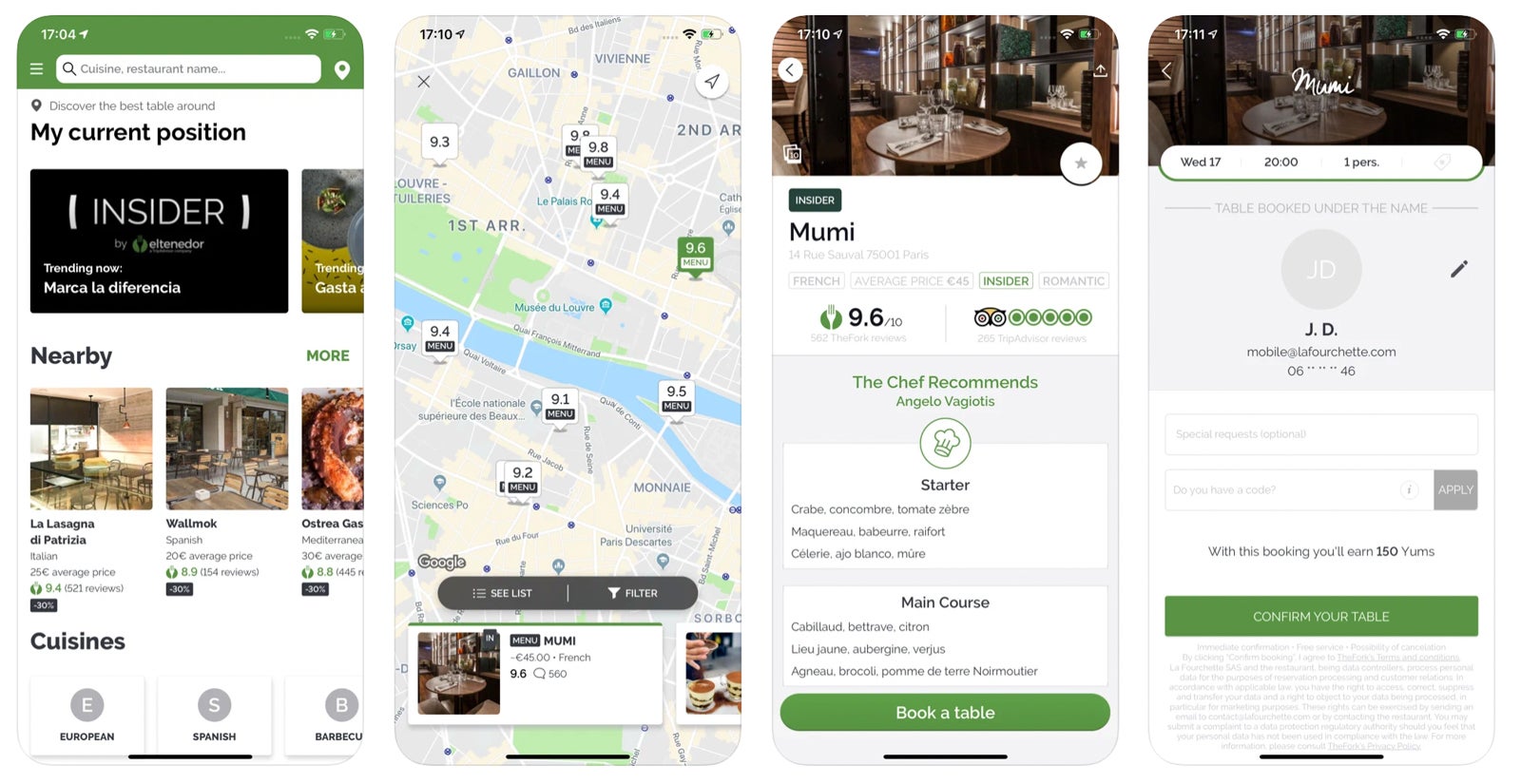
TheFork is one of the most useful resources for making restaurant reservations in Europe. Similar to OpenTable or Resy, the app lets you browse different restaurants by category and make reservations. TheFork features more than 60,000 restaurants in cities like London, Madrid and Geneva, as well as spots outside of Europe like Sydney, Australia.
The biggest perk is that many restaurant reservations come with discounts — in some cases, you can get up to 50% off your meal just by reserving a table through TheFork. Since we here at TPG are always down for earning rewards, make sure to monitor your YUMS — TheFork's reward system. You'll earn YUMS with each reservation, and when you hit 1,000, you receive a discount on your bill. Foodie travelers should also consider downloading these apps , too.
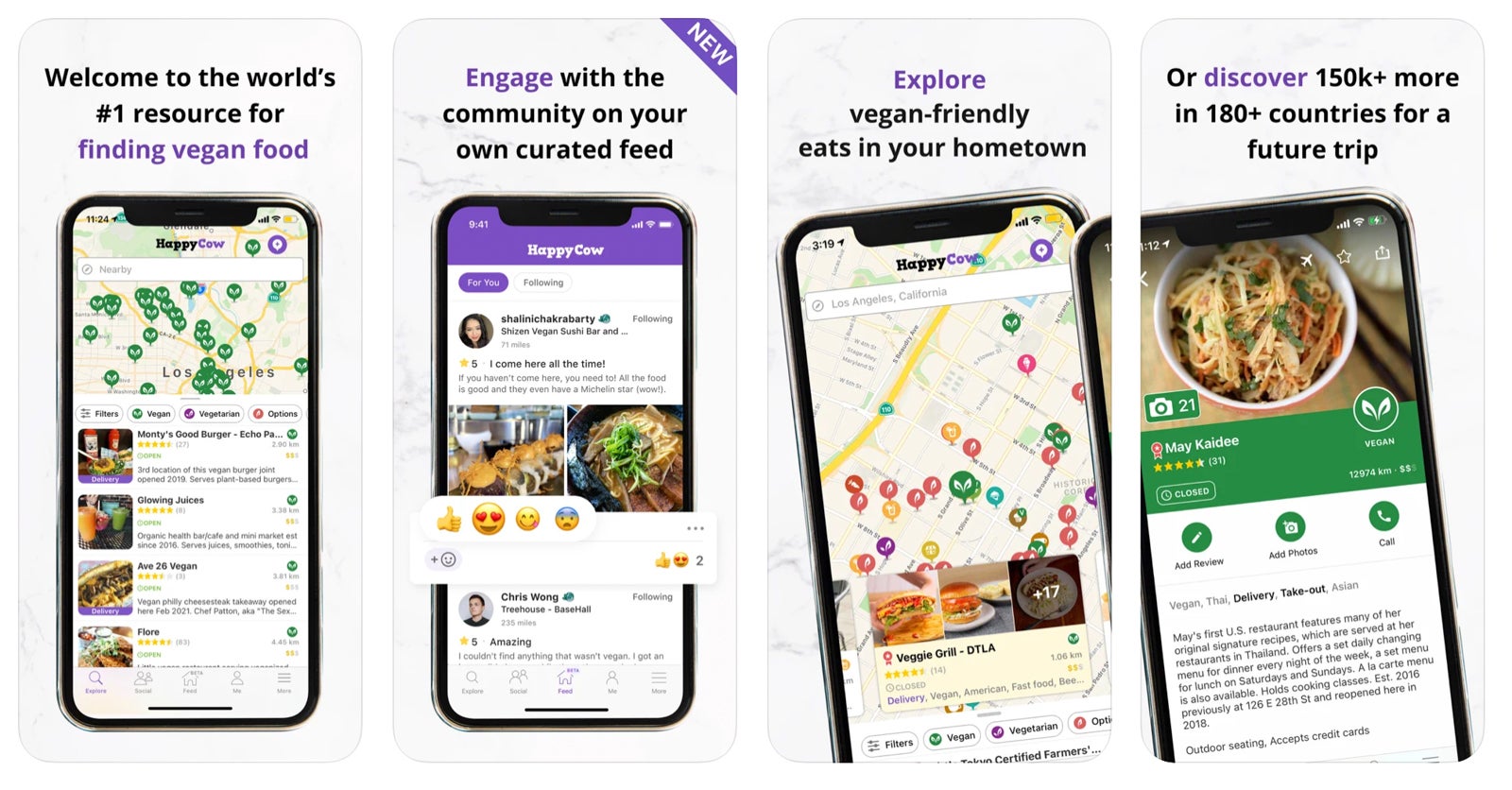
Happy Cow helps vegan and vegetarian eaters locate more than 180,000 restaurants, coffee shops, bakeries, farmers markets and grocery stores in over 180 countries around the world. The app allows you to filter by not only vegan and vegetarian but also gluten-free and cuisine types. You can also read reviews and get recipes on the app as well.
The app does cost $3.99, but it's a one-time expense.
TripAdvisor
Besides reading reviews of restaurants, hotels and attractions, you can book almost anything on TripAdvisor, from vacation rentals and restaurant reservations to tours and tickets.
The app has grown to include almost all things travel, allowing you to search by destination or interest (like the outdoors, food and drink, family or by the water, for example), which can give you inspiration for a trip or help you get your activities, meals and accommodations organized before traveling or on the fly.
With over 400,000 curated trails, AllTrails can help you find the hike or walk perfect for you and your group. It's not just mountain trails — AllTrails offers city walks, too, like easy meanders through the Marais district in Paris or peaceful strolls through Bangkok's Lumpini Park in Thailand.
See photos, updated weather predictions and key information about each route and connect with other travelers through reviews and forums. Access to AllTrails+ is $35.99 per year, which offers perks like offline maps and wrong turn alerts.
Best apps for staying safe
Use these apps to stay safe when traveling.
Smart Traveler
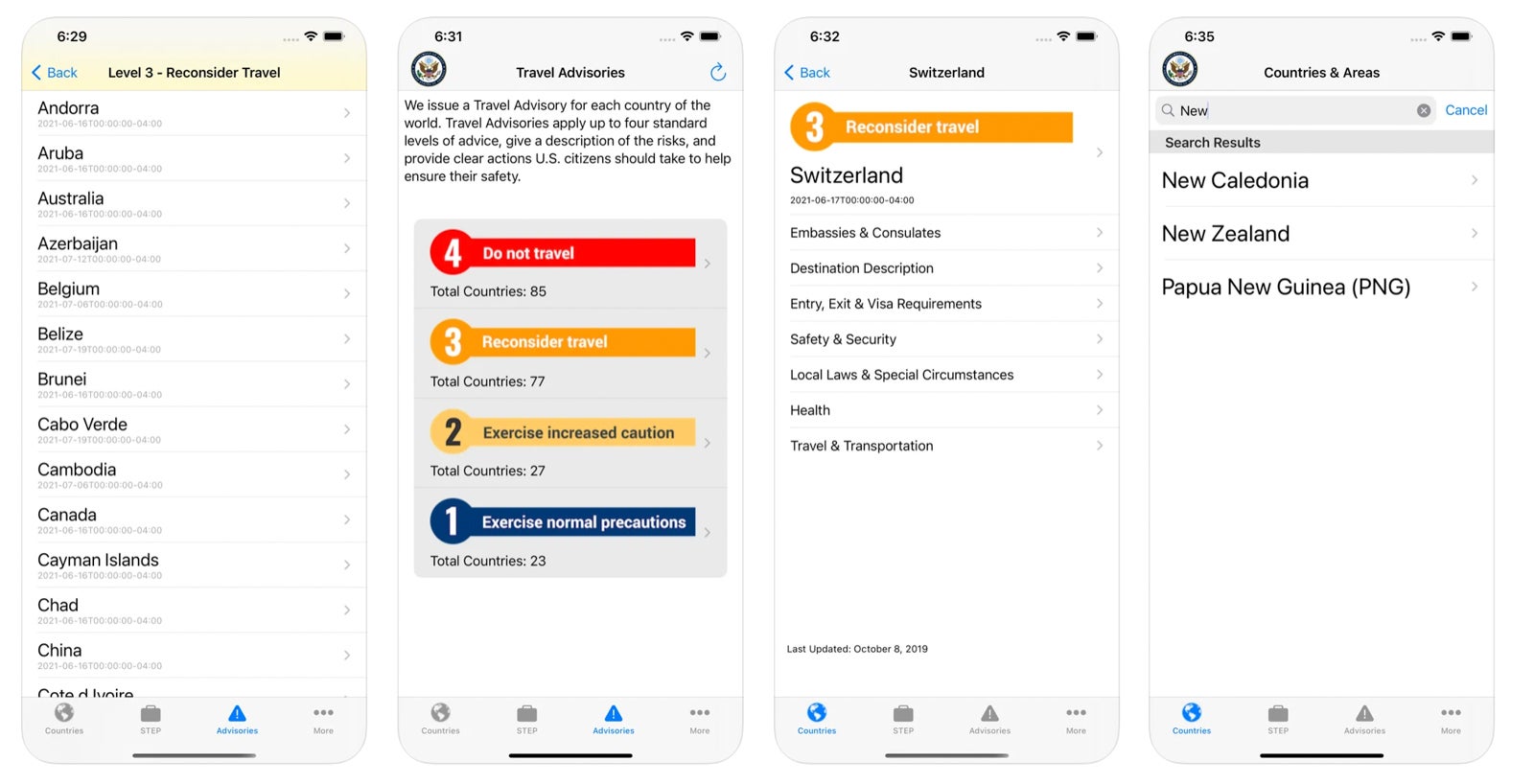
Smart Traveler is a free service that offers tips and information specifically for U.S. travelers. You can see what visas and vaccines you'll need before traveling and where to find help if you need it during your trip.
Register your trip on the app, which gives your information to local embassies and consulates in your destination. If there's any kind of disaster or tragedy, the local embassy can contact you to see if you need help.
TripWhistle
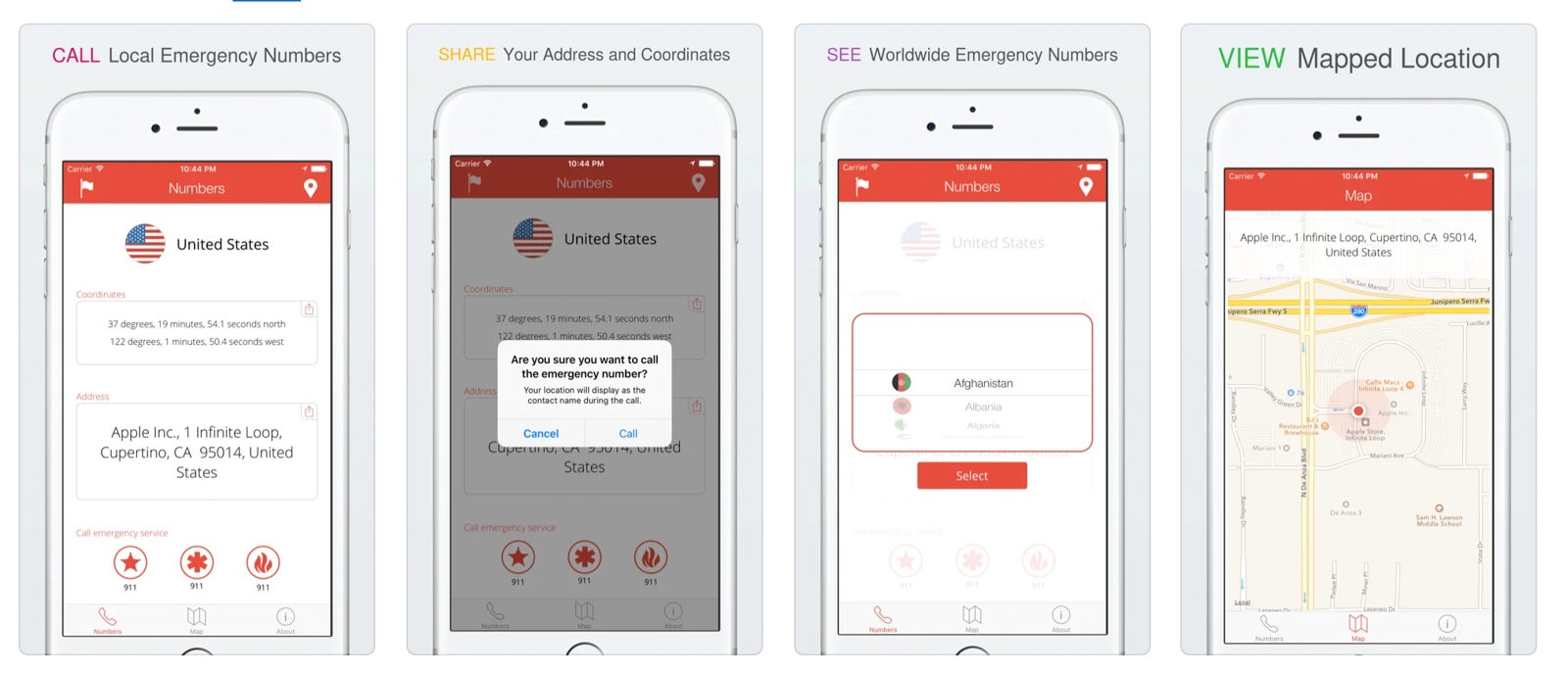
Another app dedicated to keeping you safe, TripWhistle maps your location and allows you to easily text or send your GPS coordinates or location. It also provides emergency numbers for firefighters, medical personnel and police in nearly 200 countries. After all, 911 is only for U.S.-based emergencies: Each country has its own specific emergency number.
Yes, Uber (or any local ride-hailing service app) is convenient, but it may also keep you safe. Using this app when traveling means you'll never get stuck wandering around in an unfamiliar area late at night or have to deal with unscrupulous taxi drivers trying to scam you. Uber also has in-app safety features such as an emergency assistance button which will allow you to call local emergency services right in the app.
The Occasional Nomads
Dreams. Goals. Plans. Retirement. Travel. Life.
Creating SMART Travel Goals

Both Brett and I have always been big fans of setting goals and then working to achieve them, whether that’s downsizing or moving to Hawai’i or saving for travel.
We create our goals using the SMART criteria, and it’s worked especially well for travel planning. The SMART acronym stands for S pecific, M easurable, A chievable, R ealistic and T ime-bound. Long before we ever travel, Brett and I sit down, talk about what we want to do, what we can afford, and then make our travel goal the SMART way. We’ve been using this method for many years, and it’s led us to success over and over again, no matter what we want to achieve.
Here’s how we use the SMART criteria when creating a travel goal:
- Specific: Being specific means knowing exactly what we want to do. Instead of saying We want to travel or We’d like to visit xxx , both of which are vague, we spell out exactly where we want to go, when we want to go, and who will be going. We want to visit Japan with our daughter for a week in March during her spring break is very specific while We’d like to go to Japan is not . The first example has a where, when and who will be traveling, while the second example is just an idea.
- Measurable: This means creating a precise way to quantify our goal. A travel goal contains both time- and money-related aspects, and both require some research. Instead of We want to stay 10 days and spend less than $10,000, a measurable goal is We want to spend 10 days and nine nights. We want to pay less than $700 each for airline tickets, no more than $xxx for lodging and our total budget can be no more than $8,000 (or whatever we decide our top limit is) . The top limit of our budget is the number we will be working toward, and the time aspect is making sure we can take vacation at that time or that there’s nothing else that might make it difficult to travel.
- Achievable: The travel goal needs to be what we know we can attain and complete in a specific amount of time . Giving ourselves a goal of saving $8,000 in a year for our trip is not achievable if we know that will be impossible, or that we’ll need to raid our savings or use credit cards or borrow money (and we don’t want to do those things). A specific SMART goal would be: We need to save $8,000 in the next 12 months (~$670/month) in order to make this trip during spring break. We’ll set up a monthly savings allotment, save all our refunds and gifts, save all change and $1 bills, and find other ways to save as much as possible. If we are sure we can achieve our goal, then we go for it; otherwise, we start over or reset our parameters with what we know we can achieve.
- Realistic: This part of the goal is tied very closely to achievable, and allows us to visualize the results of our efforts. Besides just getting to our destination and knowing where we’ll stay, we also need to think about what we can afford or will have time to do when we’re at our destination. Realistic means that while we may dream of flying first class or staying at the Four Seasons, there’s no point in doing so if it will consume all or most of our budget, and not allow us to do anything else at our destination. However, if flying first class and staying at the Four Seasons is our dream, then we’ll have to reset our original time parameters or figure out a way to earn or save more within our original time constraints.
- Time-bound: We make sure we have a timeline for achievement. Setting a SMART goal for travel not only requires that we set the actual date for travel that we work toward, but that we also research and set specific time-goals along the way. So, while we’ve figured out that we can save $8000 in a year to cover all our expenses, we also need to know time-sensitive issues that will arise while we’re saving. For example, We will need to have $2500 of our $8000 by such-and-such date to purchase airfare and reserve our lodging (because we don’t want to leave these until the last minute). Besides air fare and lodging, our trip may also involve several other time-related issues that arise before actually traveling, things like booking tours, or getting restaurant reservations, so those may need specific time deadlines as well. Once again, research is our friend.
Because Brett and I can’t just whip our checkbook and cover any trip whenever we feel like it, using the SMART criteria has meant we’ve been able to make most of our travel dreams a reality without using credit cards or dipping into our regular savings, or putting ourselves into debt. Setting up a SMART goal can take a little more time, but almost always ups the chances for success.
Published by Laura & Brett
Slow traveling the world with a sense of adventure! View all posts by Laura & Brett
2 thoughts on “ Creating SMART Travel Goals ”
And what you do is SMART! I am like that too. I like to plan ahead and be very specific about what I want to do. Now this post inspired me to write a post about my upcoming trip to the US. Thank You!
I remember what a revelation it was to learn about SMART goal setting – it came up in a college course I took. I had always bee goal-oriented, but this framework helped me learn how to do it better, and be more successful in reaching my goals.
I will be looking for your post!
Comments are closed.

- Already have a WordPress.com account? Log in now.
- Subscribe Subscribed
- Copy shortlink
- Report this content
- View post in Reader
- Manage subscriptions
- Collapse this bar

Passing Thru Travel
Green Globetrotting – 12 Must-Have Sustainable Travel Apps for Conscious Adventurers
Posted: February 28, 2024 | Last updated: February 28, 2024

In a world increasingly aware of its environmental footprint, sustainable travel is not just a trend but a necessity. As eco-conscious travelers, you have the power to make a positive impact on the planet while exploring it. This guide delves into a selection of innovative, sustainable travel apps essential for the modern, environmentally-minded wanderer. From carbon footprint trackers to eco-friendly accommodation finders, these apps are your digital companions in making travel choices that align with your green ethos.

1. Good on You
Good on You is an indispensable tool for fashion-conscious travelers prioritizing sustainability. This app offers comprehensive ethical ratings for over 2,000 fashion brands, focusing on their impact on the environment, labor rights, and animal welfare.
Whether you need a new backpack for hiking or a comfortable pair of shoes for city walks, Good on You helps you make informed choices that align with your eco-friendly ethos.
The app also features tips on sustainable fashion. It highlights ethical brands, making it easier for you to find stylish and responsible attire. It’s a great way to ensure your travel wardrobe doesn’t come at the cost of the environment.
Insider’s Tip: Use the app to discover local, sustainable brands in your travel destination, supporting local businesses and reducing your carbon footprint.
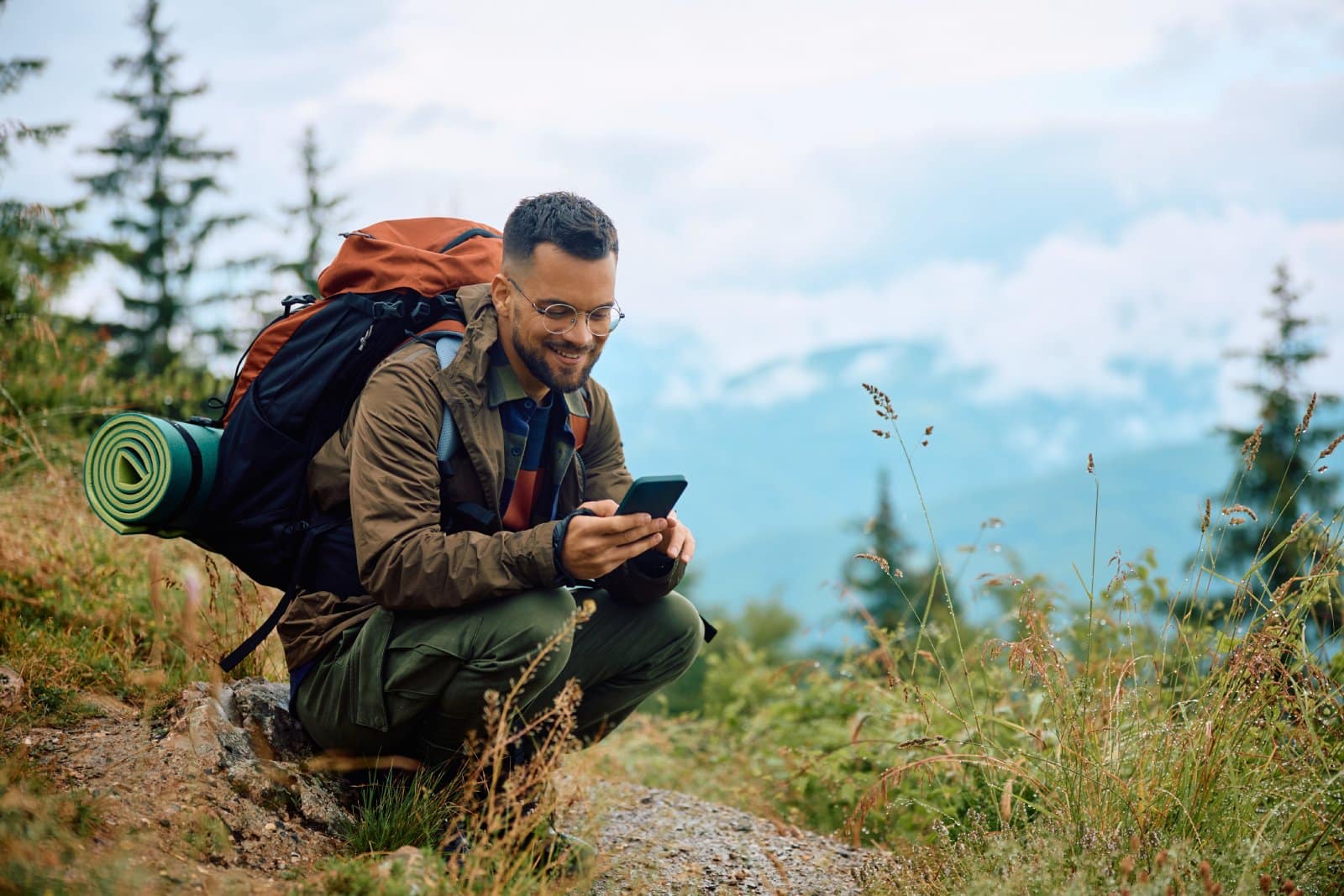
2. Eco Companion
Eco Companion transforms how you plan your trips, focusing on eco-tourism and sustainable accommodations. This app curates a selection of the world’s most environmentally responsible eco-tours and lodgings, emphasizing wildlife and conservation experiences. It offers an in-depth look into each option’s sustainability efforts, from energy efficiency to community engagement.
This ensures that your travel choices minimize negative environmental impact and actively contribute to conservation and local well-being. With Eco Companion, you’re not just traveling but making a difference.
Insider’s Tip: Look for experiences that include interaction with local conservation experts to better understand the area’s ecological initiatives.
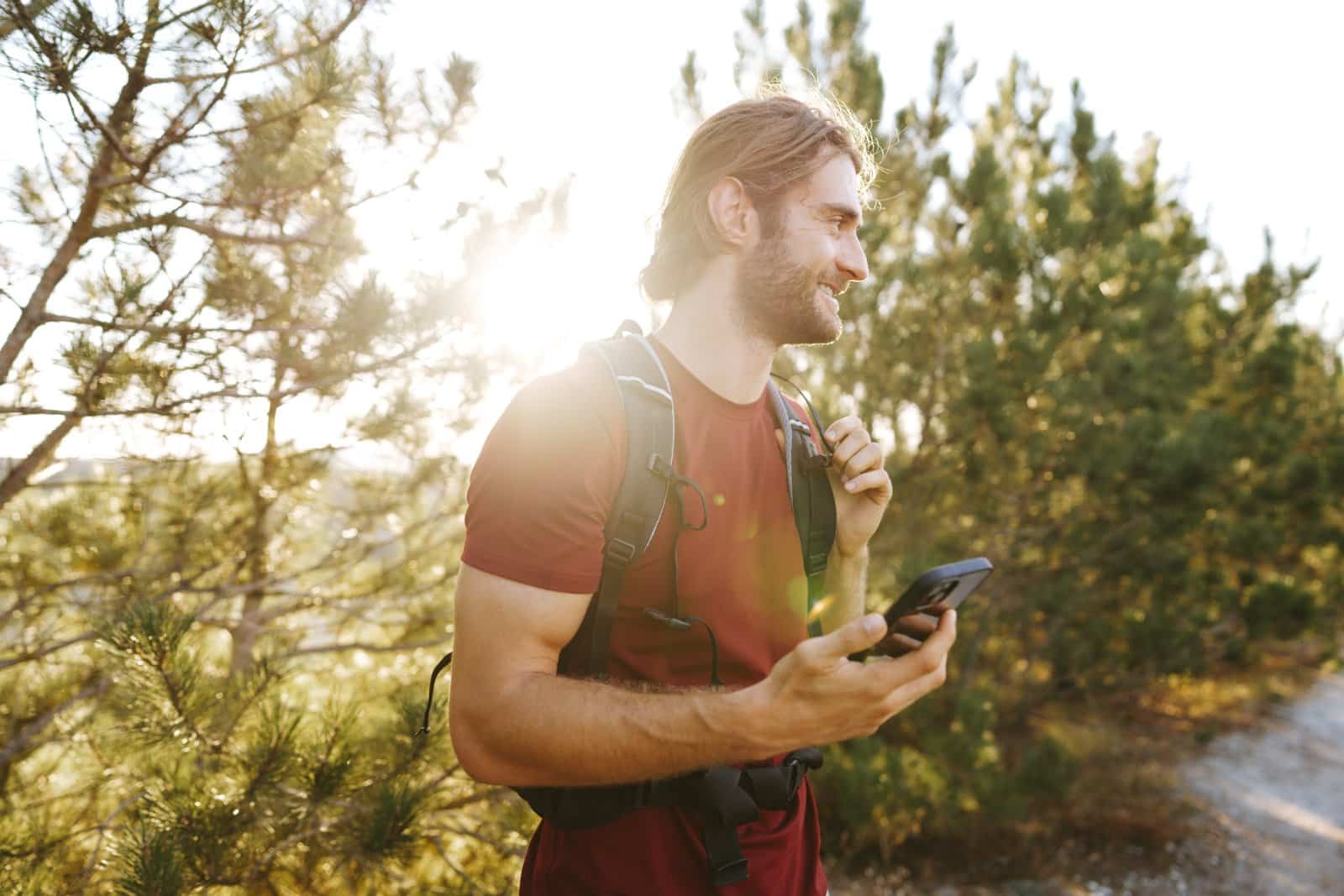
3. Green Globe
Green Globe is your digital guide for finding sustainable travel options worldwide. This app lists hotels, attractions, and even conference centers that adhere to rigorous sustainability criteria. Each listing includes detailed sustainability profiles and reports, making choosing accommodations and activities that meet your green standards easy.
Whether you’re looking for a sustainable city hotel or an eco-friendly beach resort, Green Globe helps you make travel choices that are responsible, ethical, and environmentally sound.
Insider’s Tip: Use the app’s map feature to find certified sustainable stays near your destination, ensuring convenience without compromising your green standards.

Almond is an app for the environmentally conscious traveler looking to understand and mitigate their carbon footprint. This innovative app lets you scan product barcodes to reveal their carbon footprint, suggesting more sustainable alternatives.
It also rewards your eco-friendly choices with “conscious coins,” which can be used for future sustainable purchases or donated to environmental causes. Almond is a tool that empowers you to make travel choices that are better for the planet, from the food you eat to the products you use.
Insider’s Tip: Use Almond to scan food and drink products while traveling, helping you make more eco-friendly choices.
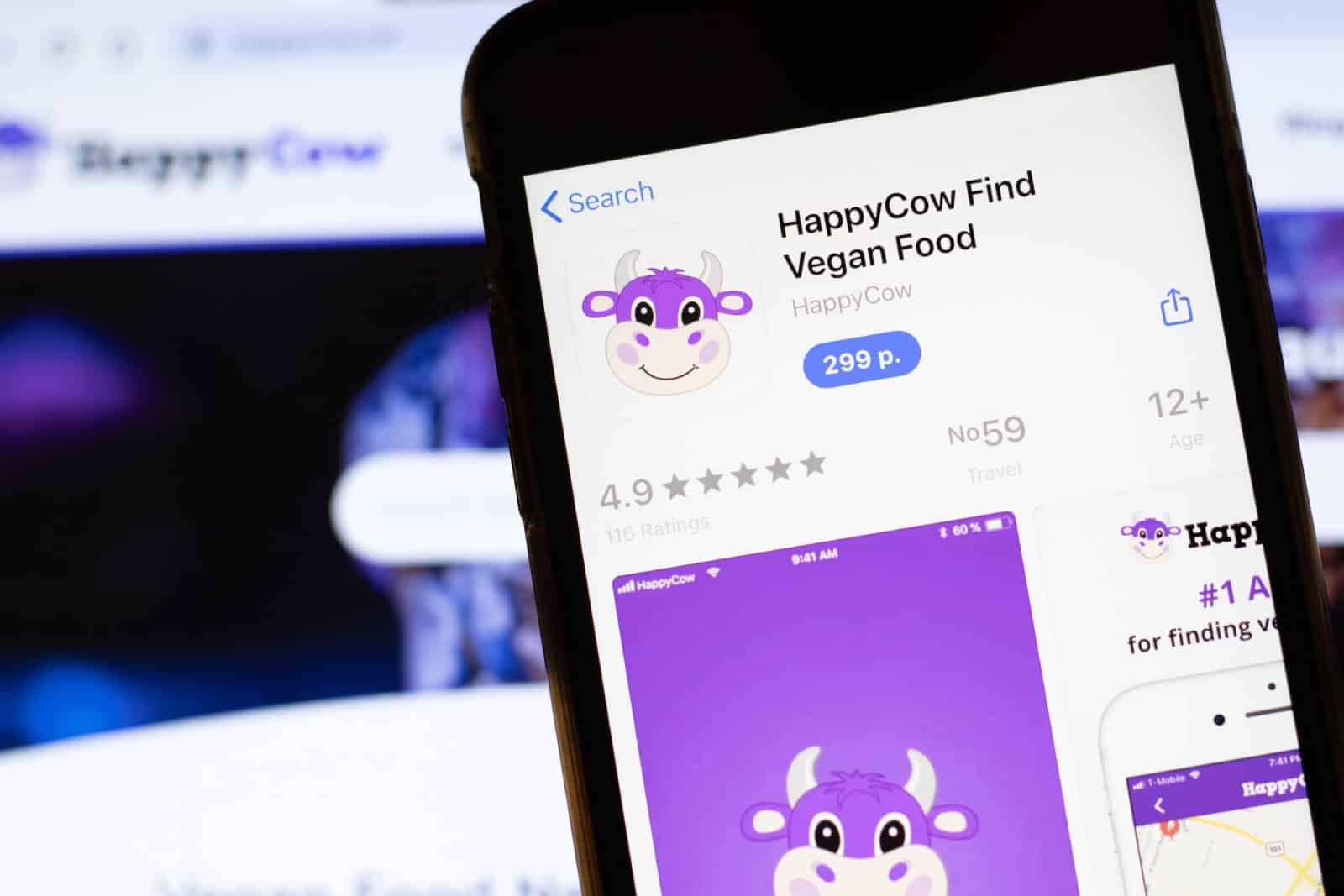
5. HappyCow
HappyCow is a lifesaver for vegan and vegetarian travelers, offering a worldwide comprehensive directory of plant-based dining options. Adopting a plant-based diet significantly reduces your environmental impact, and HappyCow makes it convenient, even in unfamiliar places.
With its extensive database of vegan, vegetarian, and veg-friendly restaurants, complete with user reviews and ratings, finding sustainable and delicious dining options has never been easier.
Insider’s Tip: Use HappyCow’s trip planning feature to create a list of must-visit eateries in your destination.
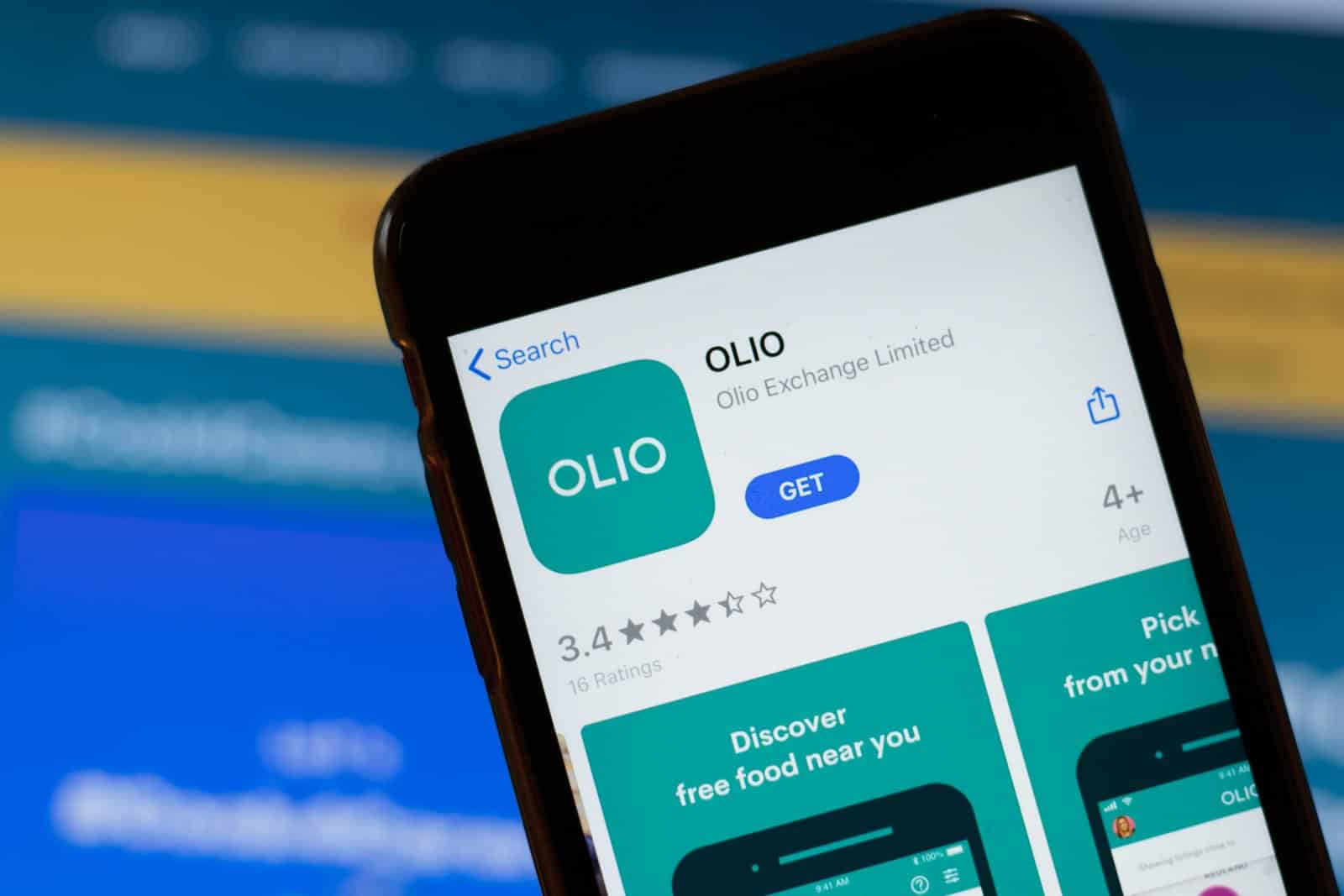
OLIO connects you with local communities to share surplus food, reducing waste and fostering a sense of connection. This app is perfect for travelers who want to minimize food waste while traveling.
Whether staying in self-catering accommodations or simply having excess food, OLIO allows you to share it with others rather than letting it go to waste. It’s a great way to experience local cuisine, meet locals, and contribute positively to the community you’re visiting.
Insider’s Tip: If staying in a self-catering accommodation, use OLIO to source local ingredients and reduce food waste during your stay.
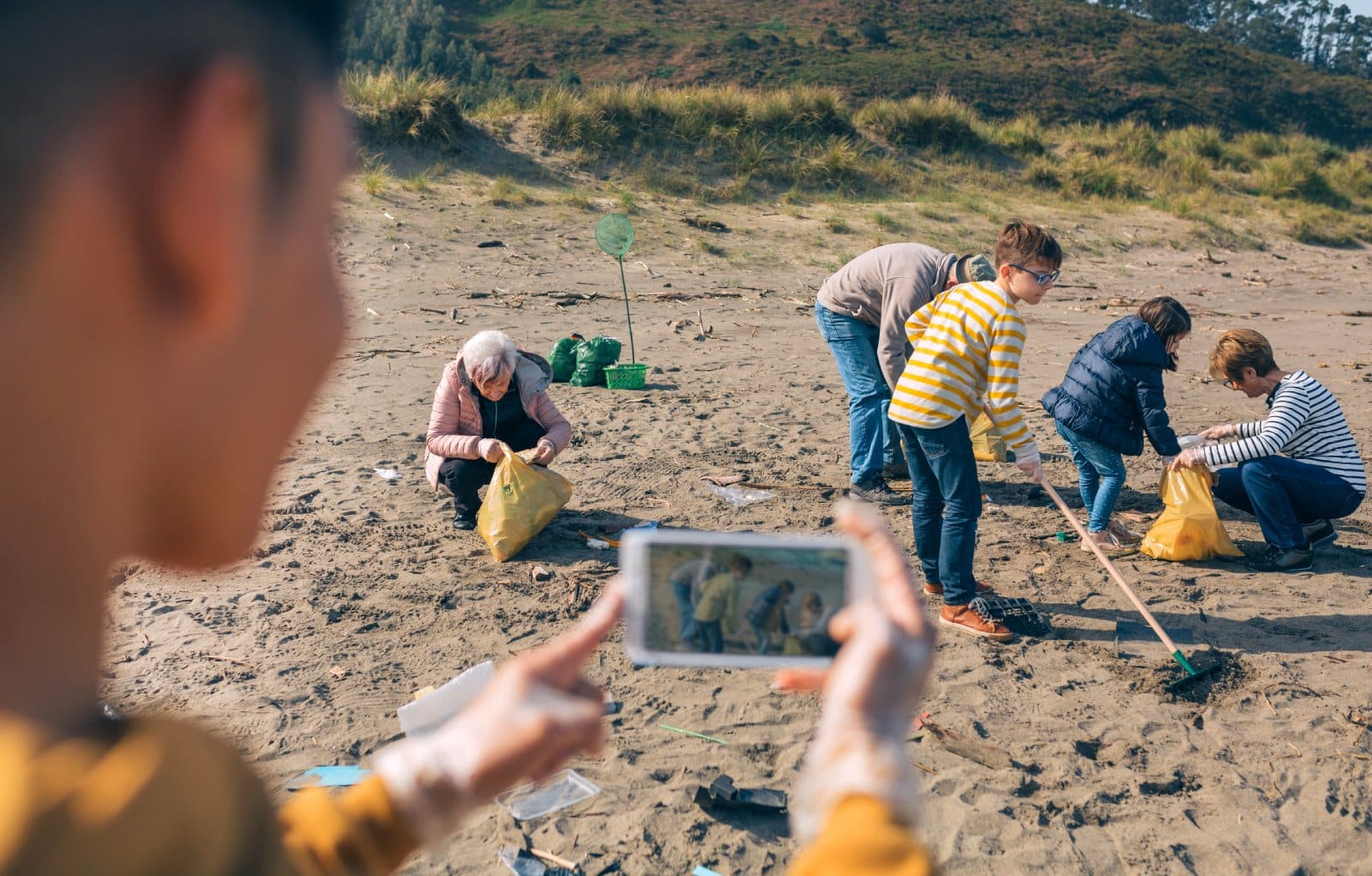
7. Litterati
Litterati is an app that tackles global littering in a creative and community-driven way. As a traveler, you can contribute to keeping the destinations you visit clean and pristine by using the app to photograph, tag, and dispose of litter.
It turns environmental responsibility into a fun and engaging activity, allowing you to be part of a global effort to clean up our planet. This app helps improve the places you visit and fosters a sense of global community and shared responsibility for our environment.
Insider’s Tip: Join or organize a litter clean-up in your travel destination through the app, making a tangible difference in the local environment.
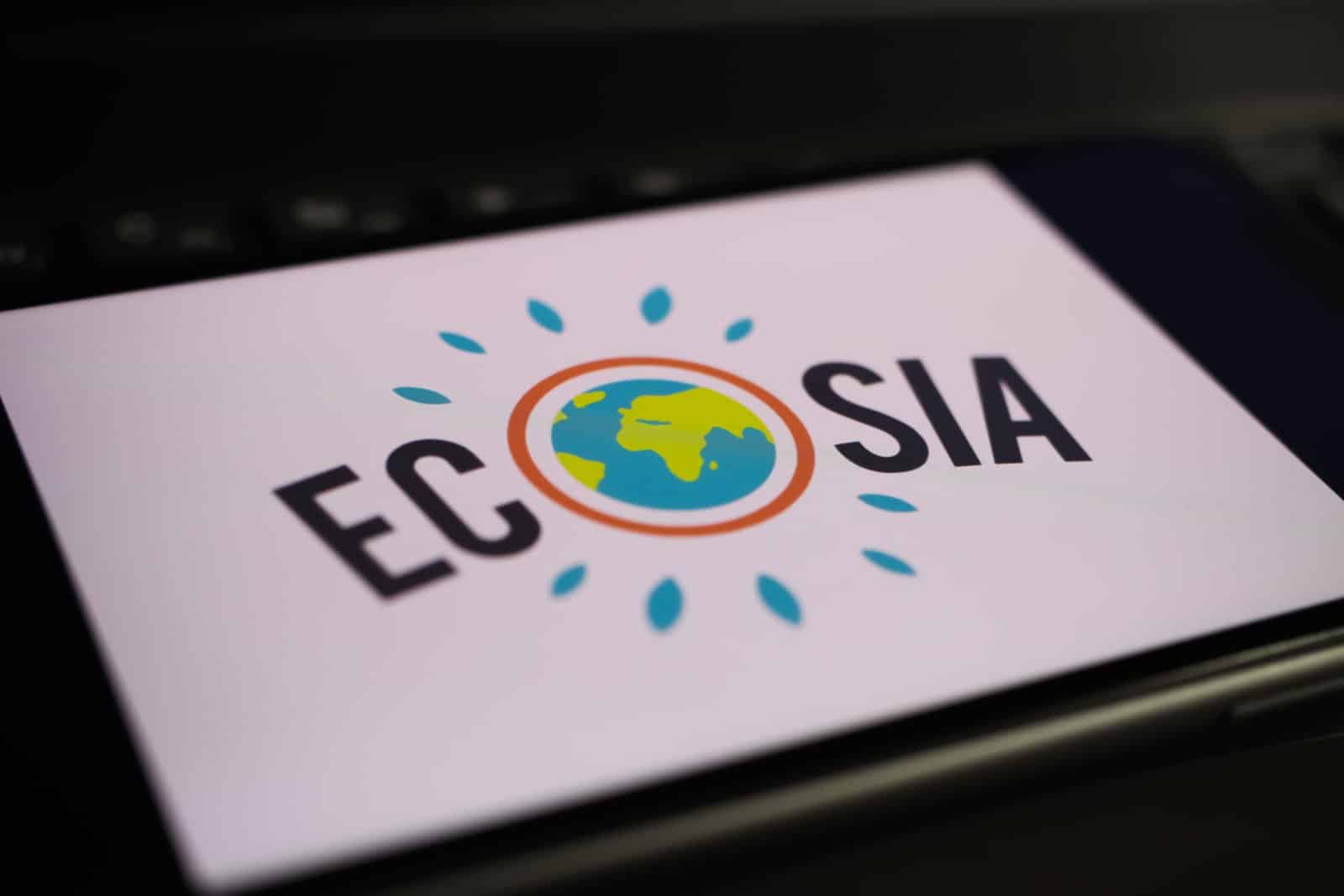
8. Ecosia Travel
Ecosia Travel extends the tree-planting mission of the Ecosia search engine to your hotel bookings. Most of the commission is directed towards global reforestation projects when you use this platform to book your stay. It’s an effortless yet impactful way to ensure that your travel accommodations contribute to crucial environmental efforts.
By choosing Ecosia Travel, your journey supports the planting of trees around the world, aiding in carbon absorption and ecosystem restoration.
Insider’s Tip: Use Ecosia as your primary search engine while planning your trip to maximize your contribution to their tree-planting initiative.
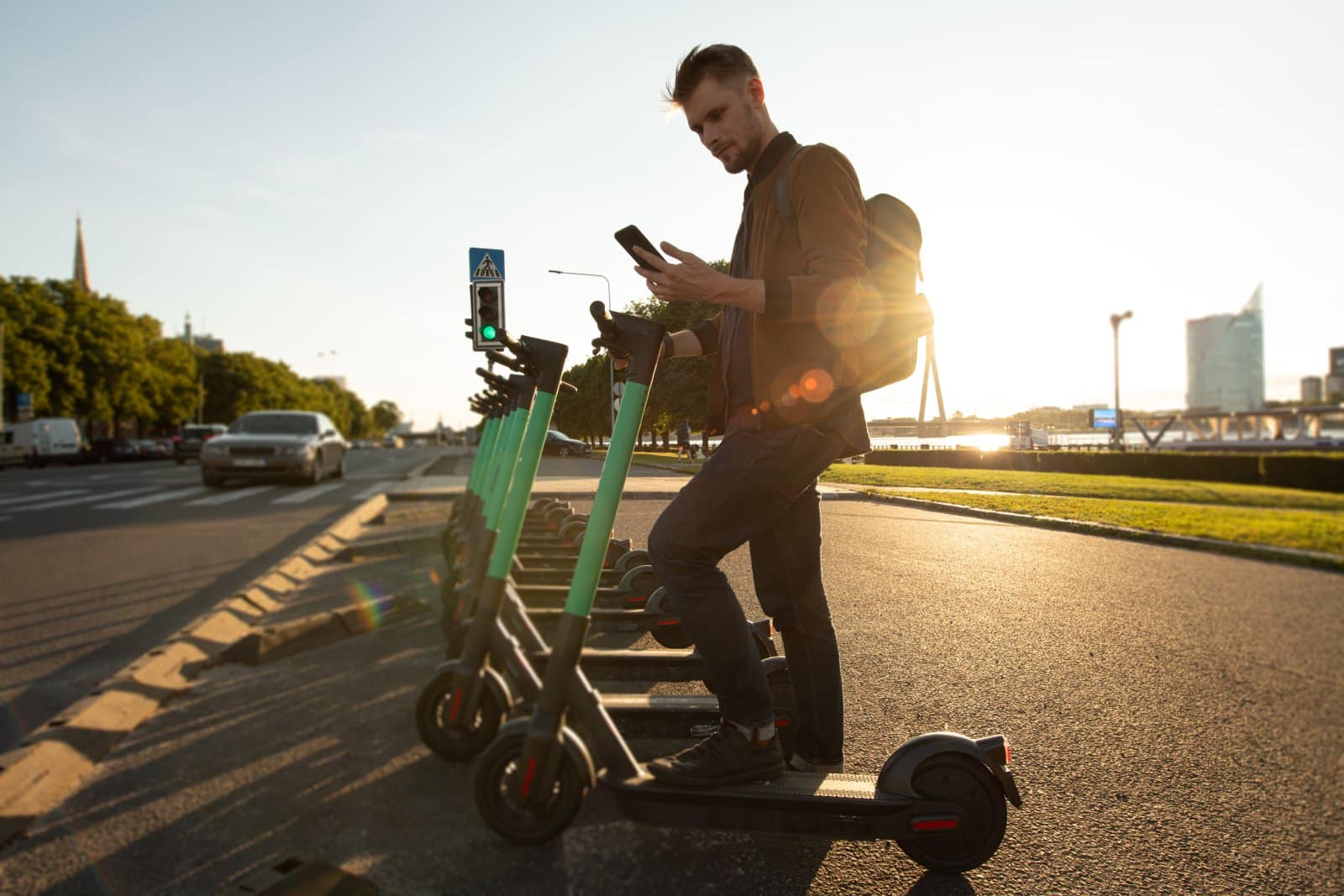
9. MyClimate
MyClimate is a comprehensive app for calculating and offsetting your carbon footprint. This tool allows you to measure the environmental impact of your flights, car travel, and daily activities. MyClimate offers a transparent and effective way to mitigate your travel impact by providing options to contribute to climate protection projects.
It’s an essential app for those committed to responsible travel, ensuring that your adventures don’t come at the planet’s expense.
Insider’s Tip: Regularly track your carbon footprint during your trip to stay conscious of your environmental impact and offset accordingly.
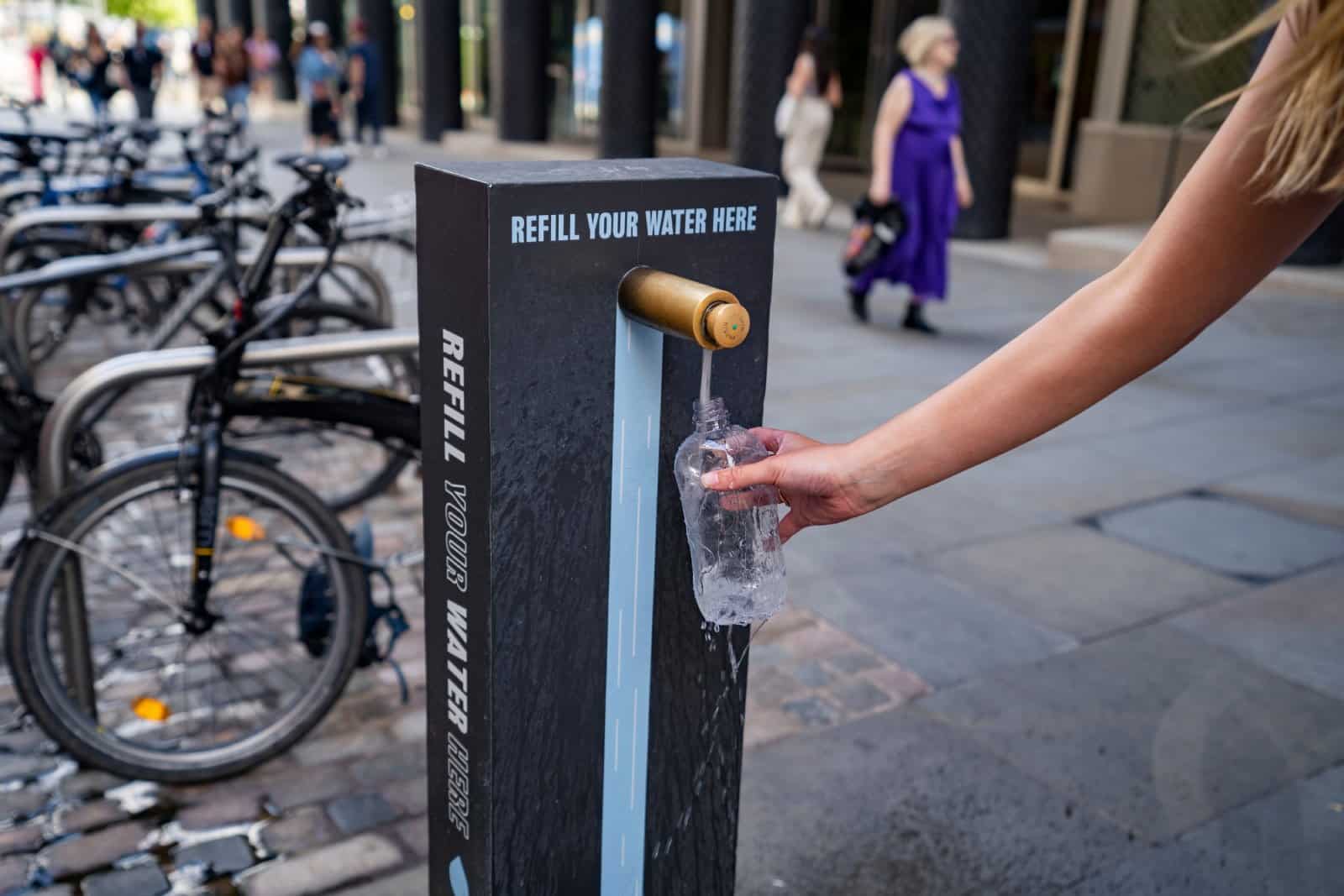
10. Water-Refill Stations
The Water-Refill Stations app is a game-changer for reducing single-use plastic during your travels. It helps you locate nearby water refill stations, allowing you to refill your reusable bottle easily.
This is particularly useful in destinations where tap water isn’t potable. By using this app, you contribute to lessening plastic pollution and promoting a culture of sustainability in the places you visit.
Insider’s Tip: Carry a collapsible water bottle to save space in your luggage and refill it at these stations.
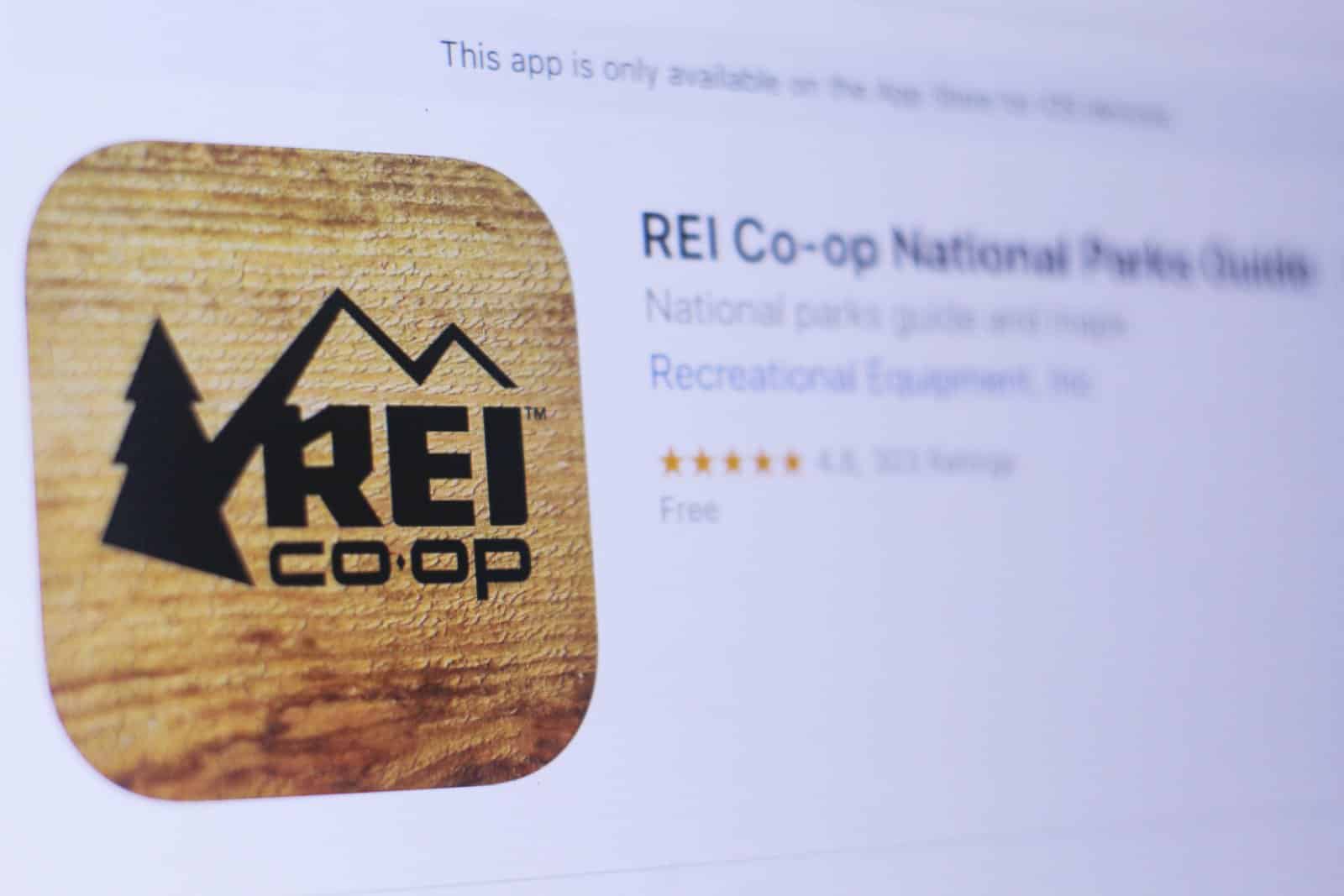
11. REI Co-op National Parks Guide
The REI Co-op National Parks Guide is an indispensable tool for the eco-conscious explorer venturing into the U.S. national parks. This comprehensive app offers detailed maps, trail information, and sustainability tips for visiting these natural wonders.
It ensures that your natural adventures are respectful and informed, helping you enjoy the parks responsibly while minimizing your environmental impact.
Insider’s Tip: Utilize the app’s offline feature to access park information without needing mobile data or Wi-Fi. 12.

JouleBug is an interactive app that makes sustainable living fun and engaging, even when you’re traveling. It turns eco-friendly actions into a game where you can earn badges and compete with friends for being the most environmentally conscious.
The app includes challenges for energy conservation, waste reduction, and sustainable habits, perfect for travelers who want to maintain their green lifestyle. JouleBug also offers tips and how-to videos, making it easier to adopt sustainable practices in your daily routine, no matter where you are in the world.
Insider’s Tip: Participate in community challenges on JouleBug to connect with other eco-conscious travelers and locals, sharing tips and experiences.
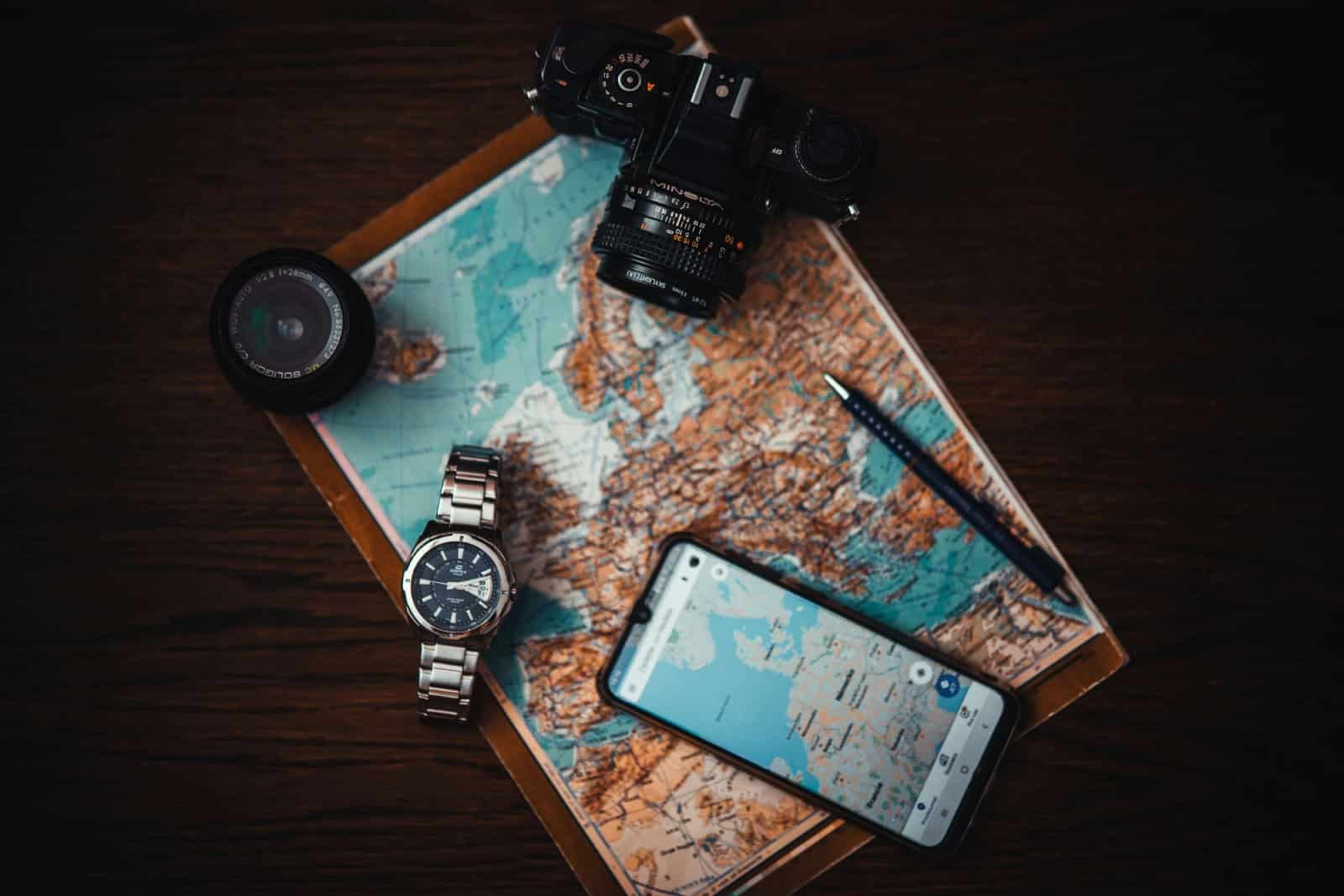
The Bottom Line
As an eco-conscious traveler, these sustainable travel apps are your allies in making responsible choices. They empower you to make a positive impact through ethical fashion choices with Good on You, eco-friendly accommodation bookings with Ecosia Travel, or contributing to local communities with OLIO.
Remember, sustainable travel is about more than just seeing the world; it’s about leaving it better than you found it. Let these apps guide you towards a more conscious and responsible way of exploring, ensuring that your adventures today contribute to a greener and more sustainable world tomorrow.
More Articles Like This…
Barcelona: Discover the Top 10 Beach Clubs
2024 Global City Travel Guide – Your Passport to the World’s Top Destination Cities
Exploring Khao Yai 2024 – A Hidden Gem of Thailand
The post Green Globetrotting – 12 Must-Have Sustainable Travel Apps for Conscious Adventurers republished on Passing Thru with permission from The Green Voyage .
Featured Image Credit: Shutterstock / GaudiLab.
For transparency, this content was partly developed with AI assistance and carefully curated by an experienced editor to be informative and ensure accuracy.
More for You
Realistic prospect projections for Ravens at positions of need
25 movies that will really mess with your head
Fairy Tail: 100 Years Quest Releases First In-Anime Character Artwork
New Motorola Edge teased for April 16 announcement — what's a smARTphone?
17 Recipes with Out-of-This-World Flavors!
2025 Toyota 4Runner Is Finally Here and Appears Worth the Wait
$90,000 colleges, the toolbelt generation, and why high schools need a three-track system
Robert Pattinson Confronts Robert Pattinson as Bong Joon Ho Debuts Wacky, Bold ‘Mickey 17' Trailer at CinemaCon
My Hero Academia: Every Character That Surpassed All Might
Urgent Warning Issued After 60-Foot Crack Found in Dam
Need a Pick Me Up? Try These 8 Foods That Serve As Happiness Boosters
An Air Purifier That Leads to a ‘Noticeable Decrease’ in Allergy Symptoms Is Only $30 for Prime Members Today
Titans go OT, WR in Mel Kiper's latest mock draft
Dove pledges to never represent ‘real bodies’ with AI in advertising
'We wanted to stay there forever': This Oklahoma family was awarded $2.9M in lawsuit against turnpike authority — here's how to fight eminent domain
Here's What Happens When You Keep a Car For Over a Decade
Ripley: a 'scintillating and noirish' adaptation
5 Whole Foods Brand Products Worth Buying
15 NFL Draft predictions 15 days out from the draft
4 Things You Should Never Cook in Cast Iron
TARC On-Demand 4+
Rideco inc., designed for ipad, screenshots, description.
Ride TARC on your schedule! TARC On-Demand is a 6-month on-demand pilot ride-share service for New Albany and Jeffersontown brought to you by TARC. Use this app to plan your trip, select your choice of travel, and pay all from your mobile device. Connect with TARC’s fixed route bus service, or travel to and from anywhere within the designated zone. Once you book a ride, you’ll receive a time of arrival and your pickup location. Your ride-share vehicle will be marked with TARC On-Demand branding to guarantee a safe, convenient, and affordable ride to your destination. Get moving with a new ride-share service from the Transit Authority of River City.
Version 3.17.4
We’ve made improvements and squashed some bugs.
App Privacy
The developer, RideCo Inc. , indicated that the app’s privacy practices may include handling of data as described below. For more information, see the developer’s privacy policy .
Data Used to Track You
The following data may be used to track you across apps and websites owned by other companies:
- Identifiers
Data Linked to You
The following data may be collected and linked to your identity:
- Financial Info
- Contact Info
- Diagnostics
Privacy practices may vary, for example, based on the features you use or your age. Learn More
Information
- App Support
- Privacy Policy
More By This Developer
Metro Micro
Iris - A Ride KC Partner
OmniRide On-Demand
WeRIDE Micro
RTC-OnDemand
You Might Also Like
Nomadic Tribe
French-English Learning App
Learn Scottish For Beginners
Moon Scooters
- Latest Latest
- The West The West
- Sports Sports
- Opinion Opinion
- Magazine Magazine
Use these digital tools to ease your travel stress
Be an airport insider with these hi-tech offerings that will get you to your final destination in no time and with less stress.
By Amy Iverson
Air travel is a key part of many vacations, but the lines, delays and crowds can make it less than perfect.
The good news is that technology is available to ease your journey.
A simple text prompt, Google search or phone app can help you avoid the problems that cause many common difficulties.
Check flight status with your phone
This first text tip is the simplest, yet the most mind-blowing. Anyone using an iPhone can easily find out flight information by tapping on a flight number in Messages.
That’s right, there’s no need to open an airline’s app, just text yourself the airline name plus the word “flight” and the flight number. Then tap on that number to see flight information at a glance.
When you click, a map pops up showing where the plane is in real time. You can see whether the flight is on time, its arrival gate and how to get to baggage claim.
This smartphone trick is especially helpful when you need to stay in touch with your ride home from the airport. Whether your family member is doing you a solid, or a ride-sharing driver is headed your way, texting the flight number is a simple way to get them all the information they need.
This flight tracking service works for iOS, even if the text is coming from an Android phone. But the feature does not work if an Android phone is the receiver.
Use AI to create travel plans
In the past, I’ve relied on Frommers or Fodors to give me an initial itinerary for any location I plan to visit. Now, artificial intelligence can help me plan upcoming trips.
To use this travel tip, turn on Google’s generative AI capabilities in Search Labs by clicking on the lab beaker in the upper left-hand corner of the Google app’s homepage. Then, ask something like, “plan a two-day trip to Boston” to get a specific itinerary, including where to visit and eat, as well as hotel and flight recommendations.
The AI-generated schedule will be a jumping off point that you can fine-tune the schedule with your own ideas.
I tried something similar on Chat GPT and was underwhelmed with its specificity. Google’s AI did a much better job at giving me a fairly robust travel plan.
Using PreCheck and Global Entry
For years, I’ve been pushing the advantages of TSA PreCheck for anyone who flies more than a few times per year.
After you enroll, you get to use a shorter security line and don’t need to remove shoes or belts. You can also leave your laptop inside your bag.
The online application process takes five minutes. After you complete the form, you’ll need to appear in person for about 10 minutes at one of their sites.
And now, those with digital driver’s license IDs are getting even more perks at airport security. Chicago O’Hare and Los Angeles International are no longer asking to see a driver’s license for travelers who have both TSA PreCheck and a digital driver’s license. You get your face scanned, but since it compares that photo with your digital ID, you don’t need to show or insert a physical driver’s license anywhere.
If you fly internationally four or more times each year, you may want to opt for Global Entry , which grants expedited customs screening for travelers returning to the U.S.
TSA PreCheck comes as part of Global Entry, which costs $100 right now for five years (that price goes up to $120 in October). Some credit cards and frequent flyer programs will reimburse these fees.
But if you don’t go for Global Entry, be aware of this little-known app that could save you time at customs. The Mobile Passport Control app has you submit a photo, customs declaration and passport to streamline your return to the U.S. at some airports.
Create a profile with your passport, then once you land in the US, take a selfie, complete some questions and bring your passport to a Customs and Border Patrol officer. You can add up to 12 profiles on the app for family members.
China’s Outbound Tourism is Changing, Female Travelers Are Leading the Way
Peden Doma Bhutia , Skift
April 10th, 2024 at 8:01 AM EDT
The evolving demographics of Chinese outbound travel shows a jump in younger female travelers. This shift will have important implications for how businesses approach their marketing strategies and the kind of products on offer.
Peden Doma Bhutia
A notable demographic shift, particularly among young upwardly mobile women, is driving the recent travel rebound in China . These travelers are researching and booking trips online, often spontaneously.
According to the most recent travel sentiment survey conducted by China Trading Desk, 62% of outbound travelers were female. Among them, almost 40% fell within the ages of 18 to 24, and a little over 27% were 25 to 29-year-olds.
According to China’s Ministry of Culture and Tourism, there were 3.6 million outbound trips taken during the Chinese New Year (from February 10-17).
Skift earlier cited a Dragon Trail research that expects China’s outbound tourism to reach 80% of pre-pandemic levels by 2024 end.
The five-day Labor Day holiday that begins from May 1 and the summer travel season are expected to further drive outbound tourism.
Women Power Drives Travel
Subramania Bhatt, founder and CEO of China Trading Desk, emphasized the emergence of a new cohort of digitally-savvy travelers seeking culturally enriching experiences. He highlighted that this demographic is predominantly young, female, and educated, with many opting for solo trips.
“These travelers exhibit a strong interest in independent travel, nature activities, and cultural experiences,” Bhatt told Skift.
He emphasized the need for travel businesses and destinations to better cater to these travelers by prioritizing safety, wellness, and support services.
Businesses should focus on promoting shopping and luxury experiences, along with unique local activities that appeal to the interests of young Chinese women travelers, he said.
Regarding travel preferences, the survey revealed that shopping ranked among the top five consumption items for outbound travel along with accommodation, air tickets and food. Over a quarter of travelers said they research shopping activities before purchasing air tickets, with this percentage rising to just under 70% among those aged 18 to 29.
Challenges of U.S. Travel
Analyzing destination popularity among Chinese travelers, Singapore maintains its lead position, followed by Thailand and South Korea.
During the first quarter of 2024, China contributed the highest number of visitor arrivals to Singapore, with nearly 724,000 entries. This marked a 481% year-on-year jump, reaching 75% of the visitor arrivals in 2019 for the same period.
In February, Singapore and China implemented a 30-day visa-free travel arrangement . Also, from March 1, Thailand and China entered into a mutual visa exemption agreement .
However, travel to the United States from China remains subdued . Bhatt predicts that Chinese travel to the U.S. may start to recover by the fourth quarter of 2024 or early 2025, barring any additional constraints.
“A variety of challenges, notably stringent visa regulations, geopolitical strains, and advisories from the Chinese government are holding back U.S. travel,” he said.
Recent incidents of professionals and students experiencing entry denials or interrogations upon arrival in the U.S. have led to official warnings about potential travel disruptions or cancellations, he said.
“Given the ongoing geopolitical complexities and the U.S. elections in November, prospects for immediate improvement in U.S.-China travel dynamics appear limited,” Bhatt said.
The survey listed government travel restrictions among the top factors influencing travel decisions.
Apps to Plan, Research and Pay
Chinese travelers are also booking trips faster and using digital platforms more. This suggests a trend towards spontaneity and flexibility driven by their digital skills, according to the survey.
They use popular travel apps like CTrip and Qunar, as well as social media platforms like Douyin and Xiaohongshu (China’s Instagram), to get information and plan trips. These platforms are also often used for organizing shopping excursions.
Bhatt stresses the importance of digital tools in travel and shopping, noting how they shape travel plans.
Friend recommendations strongly influence hotel bookings, followed by digital ads, highlighting the importance of social networks and targeted marketing in the hospitality industry.
For improving shopping experiences, travelers, especially those aged between 18 and 29 prefer using digital wallets and mobile payments. Alipay is the top payment method for outbound travel, with WeChat Pay also widely used among Chinese travelers.
The Daily Newsletter
Our daily coverage of the global travel industry. Written by editors and analysts from across Skift’s brands.
Have a confidential tip for Skift? Get in touch
Tags: alipay , asia monthly , china , china outbound , ctrip , digital payments , politics , singapore , social media , survey , visa waiver , wechat pay , women travelers
Photo credit: Chinese female travelers exhibit a strong interest in independent travel, nature activities, and cultural experiences. Kuan Fang / Unsplash
2044 solar eclipse path: See where in US totality hits in next eclipse
Compared to this year's eclipse, with a path of totality that will cross over 13 states, the 2044 total solar eclipse won't have as quite as broad of a reach. here's what to know:.

Millions of Americans are by now eagerly awaiting the next total solar eclipse , which is only hours away from passing over a large swath of the continent .
But when the celestial event comes and goes, the awe-inspiring impression it leaves on skygazers may leave them with one question: "When can we see that again?"
Unfortunately, we'll have to wait awhile – this sort of spectacular astral phenomenon doesn't happen very often . Here's what we know about the next total solar eclipse that will cross over the contiguous U.S.
Solar eclipse glasses: What to know about glasses, safe viewing before the solar eclipse
When will the next total solar eclipse happen in the U.S?
Only seven years have passed since Americans had the opportunity to view a total solar eclipse, a relatively rare celestial event in which the moon appears to us here on Earth to completely block the sun.
The resulting fleeting moments of darkness can last for minutes or just mere seconds and is known as " totality ," whereby the sun's outermost layer known as the corona makes a rare appearance.
Today's total solar eclipse , the first in North America since 2017, will travel over portions of northern Mexico, thousands of miles of the U.S. and the maritime provinces of Canada, according to NASA . According to astronomers, this eclipse will be brighter, will last longer and will be visible to more people than the last one in North America.
It's also the last one for 20 years in the United States.
After Monday, the next total solar eclipse viewable from the lower 48 states will be on Aug. 23, 2044.
2044 total solar eclipse path of totality
Compared to this year's eclipse, with a path of totality that will cross over 13 states, the 2044 total solar eclipse won't have as quite as broad of a reach .
The Planetary Society, a nonprofit involved in research, public outreach and political space advocacy, says that during the 2044 eclipse, the path of totality will only touch three states.
The eclipse will begin in Greenland, sweep through Canada and end around sunset in Montana, North Dakota and South Dakota.
It's not too early to start thinking about where you want to witness it. According to whenisthenexteclipse.com , Americans may want to make sure their passports up to date.
The place to be will likely be Banff National Park in Alberta and Jasper National Park , with Calgary and Edmonton also within the path of totality.
What to know about the 2033 eclipse in Alaska
Outside of the "lower 48," Alaska is set to experience a total solar eclipse much sooner.
On March 30, 2033, a total solar eclipse will occur in Russia and cross over Alaska, according to nationaleclipse.com . The maximum duration of totality for this eclipse will be 2 minutes and 37 seconds.
Contributing: Mary Walrath-Holdridge and Gabe Hauari
Eric Lagatta covers breaking and trending news for USA TODAY. Reach him at [email protected]

IMAGES
VIDEO
COMMENTS
Improve your onboarding process. Make sure new users quickly see the value in your app. Walk them through key features and set them up for success. Offer incentives for loyalty. Provide special perks, rewards, or subscription discounts for users who have stuck with your app for 6-12 months. Analyze usage data.
Cost of a Travel App Development. Building a travel application for two platforms (iOS and Android apps) may cost about $103,600. It's an APPROXIMATE number based on $50/h rate (Eastern Europe, Ukraine). The exact number fully depends on your needs and expected functionality.
The goal of a travel tool is to convert users to complete the target action - to book a room, purchase a ticket, rent a car, etc. Personalization can help to achieve this goal. Many mobile travel apps have access to big data, that helps to customize the user experience.
If it brings users back to it as intended, it is a good app. It is that simple. Your travel app design template must be developed with only one key goal in mind: make it reusable. If your travel app dashboard isn't experiencing consistency in user behavior, you need to rethink your template and possibly recreate one from scratch.
Travel apps provide multiple revenue streams. You can earn through booking commissions, in-app advertising, premium content, or even by offering personalized travel recommendations. This flexibility allows you to tailor your revenue model to suit your business goals. Global Reach. With a travel app, you can tap into a global audience.
Step1: Create a travel goals wishlist. First, you would like to create a wishlist. It's like a list of your dream places to visit. This is very similar to a "someday-maybe" places to visit list. You don't have to set deadlines or make SMART travel goals (yet). You just set an intention to visit this place someday.
Achieve your bucket list together! Track your life goals, plan your next trip, mark visited countries and connect with friends. ∆ Accomplish your goals. Short and long-term goals will help you work towards something and boost motivation. Track your progress by adding tasks, organise goals in lists. Or visualize with stories and images to ...
About this app. Achieve your bucket list together! Track your life goals, plan your next trip, mark visited countries and connect with friends. Short and long-term goals will help you work towards something and boost motivation. Track your progress by adding tasks, organise goals in lists. Or visualize with stories and images to create your own ...
2. Visualize your goal and the potential obstacles. Positive thinking can actually improve life satisfaction and outcomes according to scientific research. Here are activities to visualize your goals and reinforce your optimistic mindset. Create a vision or Pinterest board with images for your dream destination.
However, there are a few suggestions on how to build a travel app efficiently and where to start to lower potential risks and losses. 1. Understand Your Goals. Convert an abstract desire to have a mobile app into a more specific, detailed plan.
The goal was to assess the overall usability of the app and identify areas for improvements that could facilitate the completion of the tasks. The participants were given the same tasks done on the first round of testing and given a new task of requesting a new quote from their personal travel expert.
Achieve your bucket list life and travel goals together. Plan your next trip, mark visited countries and connect with friends. ∆ Dream it. Plan it. Do it. Stay focused on the things you want to do before you die with our simple and beautiful app. Set goals, plan trips and make new unforgettable mem…
8min. Plan your trip. Get inspired. Setting travel goals is a powerful way to transform your wanderlust into tangible experiences. By creating a list of desired destinations and activities, you can turn your travel dreams into reality. In this blog post, we will delve into the benefits of setting such goals and how they can help shape ...
The goal to create a simple solution that provides a tailored travel experience was met. Working on Travel Bud helped my UX process skills grow significantly. From user research and defining an MVP.
Let's take a simple journey through the key components that make our favorite travel app work. 1. APIs and Aggregators. Normally, airlines, hotels, and restaurants connect through APIs, like doorways to their offerings. Then aggregators simplify things by gathering choices from various vendors into one simple app. 2.
These categories of the app offer all travel features such as travel booking, taxi booking, hotel booking, itinerary planning, flight, train & bus bookings, and much more. Examples: Expedia, MakeMyTrip, and Yatra. 2. Transport Mobile Apps. They assist users in finding information on nearby transportation routes.
To succeed, you need to go through a few steps: Define the type of your traveling app, target group and app's goals (and compare your idea with competitive solutions on the market conducting competitor research) Verify your idea on the market. Think about how to earn money on your travel app and build a business plan.
Directions and Transport. 1. Citymapper. Best for: The public transport traveller. Citymapper is the perfect all-rounder for anyone trying to get from A to B. The app covers everything, from ...
1. Travel Itinerary Generator. One of the most sought-after features of travel apps among travel enthusiasts and tourists is the Travel Itinerary Generator. This functionality's ability to create a comprehensive travel plan automatically, simply by having users input their desired locations.
ITUNES. Hopper has changed in recent years from just offering a price prediction tool for flights to being a true online travel agency. The app helps travelers find the cheapest flights, hotels and rental cars. Of course, Hopper also still offers its signature price prediction technology to help you plan out when to book, as well as travel ...
The entire process of designing a Travel app. The travel agency mobile application we designed aimed to simplify and automate the booking process for travelers, providing them with a stress-free travel experience. Our goal was to create an app that would allow users to easily choose their desired destination and have everything else, such as ...
Budgeting apps that make travel easy. Travel budgeting apps take a few different forms. Some programs operate best as a method to track your spending, offering interfaces that show snapshots of your goals compared to your real-time costs. For others, the prime feature is splitting or dividing expenses across a group of friends.
A specific SMART goal would be: We need to save $8,000 in the next 12 months (~$670/month) in order to make this trip during spring break. We'll set up a monthly savings allotment, save all our refunds and gifts, save all change and $1 bills, and find other ways to save as much as possible.
Green Globe is your digital guide for finding sustainable travel options worldwide. This app lists hotels, attractions, and even conference centers that adhere to rigorous sustainability criteria.
Google Maps can also help you plan a route with multiple stops, add starred and flagged places your network recommends and use AI to help with travel searches. Google Maps can help you find your ...
TARC On-Demand is a 6-month on-demand pilot ride-share service for New Albany and Jeffersontown brought to you by TARC. Use this app to plan your trip, select your choice of travel, and pay all from your mobile device. Connect with TARC's fixed route bus service, or travel to and from anywhere within the designated zone.
Air travel is a key part of many vacations, but the lines, delays and crowds can make it less than perfect. The good news is that technology is available to ease your journey. A simple text prompt, Google search or phone app can help you avoid the problems that cause many common difficulties. Check flight status with your phone
1:07. WASHINGTON — The keel of the stricken commercial vessel Dali rests in sediment at the bottom of Baltimore Harbor, weighed down by a portion of the Francis Scott Key Bridge that it toppled ...
According to the most recent travel sentiment survey conducted by China Trading Desk, 62% of outbound travelers were female. Among them, almost 40% fell within the ages of 18 to 24, and a little ...
The Planetary Society, a nonprofit involved in research, public outreach and political space advocacy, says that during the 2044 eclipse, the path of totality will only touch three states. The ...